
Annapurna Full Circuit Trek - 17 Days

- Duration 17 Days
- Destination Nepal
- Trip Grade Challenging
- Starts at Kathmandu
- Ends at Kathmandu
- Meals Breakfast, Lunch, and Dinner During Trek
- Accommodation Tea House or Lodge During Trek
- Max. Altitude Thorong La Pass (5416 Meters)
- Activity Trekking
- Group Type Any
- Group Size 1 to 10
- Best Season Spring and Autumn
- One of the top hiking routes in the world is the Annapurna Full Circuit Trek.
- On the way, pass through two beautiful river valleys: the Marshyangdi River Valley and the Kali Gandaki River Valley.
- You may explore the numerous features of the Himalayas by hiking through oak, rhododendron, and rice field forests.
- Embark on the Throng La Pass challenge, a fantastic and remarkable trekking accomplishment.
- Enjoy the stunning vista of the Annapurna massif, Dhaulagiri, and Lamjung Himal ranges
- A brief tour of the biggest monastery in the Manang area, Barge Monastery
- One of the most revered temples for both Hindus and Buddhists is the Muktinath Temple.
- Visit the 108 stone faucets at the Muktinath Temple, which is revered by both Hindus and Buddhists.
- Tatopani's natural thermal springs are a great location to unwind after a long day.
- Immerse yourself in the indigenous Himalayan culture and way of life.
- Drive through communities populated by several ethnic groups to get a sense of the lively local culture.
- Enjoy the stunning view from Poonhill, then have a wonderful day in the stunning Pokhara valley.
The Annapurna Full Circuit Trek is a breathtaking journey through the heart of the Himalayas in Nepal. The trek takes you around the Annapurna massif, offering incredible views of some of the world's highest peaks, including Annapurna South, Annapurna I, and Dhaulagiri. The trek is considered one of the most challenging and rewarding treks in the region and is a must-do for any serious trekker.
One of the highlights of the trek is the Thorong La Pass, which is the highest point on the trek at 5,416 meters. The pass is challenging and strenuous, but the views from the top are well worth the effort. From the pass, you can see the entire Annapurna range, as well as the Kali Gandaki valley and the Dhaulagiri massif. The Annapurna Full Circuit Trek is also known for its diverse culture and friendly local people. Along the way, you will pass through traditional villages and meet the locals, who are always happy to share their culture and stories with trekkers. There are many guesthouses and teahouses along the trail where you can rest, eat, and spend the night.
The Annapurna Full Circuit Trek takes around two to three weeks to complete, depending on your pace and the number of rest days you take. The best time to go is from September to November and March to May, as the weather is the most stable during these months. The trek can be challenging, but with proper planning and preparation, it is accessible to most people with a good level of fitness.
17 Days Annapurna Full Circuit Trek Itinerary begins with an early-morning bus journey from Kathmandu to Bhulbule, followed by a shared jeep ride to Dharapani while taking in the sights of lovely villages, terraced fields, and mountain regions. From Dharapani to Chame, the Annapurna Full Circuit Trekking officially begins. After spending the night in Chame, you will go to Upper Pisang, where you can see stunning views of Lamjung Himal, Annapurna II, and Annapurna III. From Upper Pisang to Manang, you will travel while taking in the spectacular high peaks, such as Gangapurna, Tilicho, and Pisang Peak, and Tibetan-style villages. After acclimatizing at Manang for a day, you will travel to Ledar the next day.
You will continue your Full Annapurna Circuit Trek to Thorang Phedi the next morning after waking up in Ledar. You could hike to Thorang High Camp for the night if the weather is appropriate. You will climb a steep incline from Thorang Phedi to Thorong La Pass. Crossing Thorong La Pass you will head to Muktinath, which is a Hindu and Buddhist holy site. After a night in Muktinath, you will trek to Tukuche via Jomsom, a bustling market in this region. The next day your journey will head toward Ghasa and then Tatapani, natural hot springs that are perfect for relaxation and also believed to heal diseases. From Tatopani, your Full Circuit Annapurna Trek route will lead you to Ghorepani, which is mostly populated by Gurung people. Next morning you will head toward Tikhedhunga after enjoying beautiful views from Poonhill. You will do your final trek from Tikhedhunga to Nayapul then you will take a private vehicle to Pokhara. From Pokhara, you will take a tourist bus to Kathmandu, which will conclude your Annapurna Complete Circuit Trek .
We at Green Valley Nepal Treks and Research Hub are pleased to present our well-planned Annapurna Full Circuit Trek Detailed Itinerary , which will give you the experience of a lifetime. Booking is now available for 2024 and 2025. Based on your time, budget, and endurance, we are willing to modify this package to meet your requirements. For more questions regarding the Annapurna Full Circuit Trekking Package Cost , please don't hesitate to contact us.
Benefits of Annapurna Full Circuit Trek Booking with us
- International Airport Pickup And Drop Services
- Green Valley Nepal Trek Duffle Bag and T-Shirt as a souvenir
- Map of Annapurna Full Circuit Trek
- An Oximeter to Check Blood Oxygen Saturation Levels.
- Medical Kits - Which May Be Necessary In Certain Cases.
- Free Excess Luggage Storing At Green Valley Nepal Store During The Trek
- Arrangement of sleeping bags and down jackets if required
What You Can Expect from Annapurna Full Circuit Trek?
The Annapurna Full Circuit Trek is a challenging and rewarding trek that takes you around the Annapurna massif in Nepal. Here are some of the things you can expect from the trek:
- Stunning mountain views: The trek offers incredible views of some of the world's highest peaks, including Annapurna South, Annapurna I, and Dhaulagiri. The trail also offers panoramic views of the Annapurna massif, Kali Gandaki Valley, and Dhaulagiri massif.
- Diverse landscapes: The trek takes you through a variety of landscapes, including lush forests, terraced fields, rugged mountains, and barren landscapes.
- Thorong La Pass: The trek's highest point is the Thorong La Pass, which is 5,416 meters high. The pass is challenging and strenuous, but the views from the top are well worth the effort.
- Cultural experience: The trek takes you through traditional villages and you will have the opportunity to meet the locals, who are always happy to share their culture and stories with trekkers.
- Guesthouses and teahouses: There are many guesthouses and teahouses along the trail where you can rest, eat, and spend the night, making it a comfortable and accessible trek.
- Trekking duration: The trek takes around two to three weeks to complete, depending on your pace and the number of rest days you take.
- Difficulty: The trek can be challenging, but with proper planning and preparation, it is accessible to most people with a good level of fitness.
Is Annapurna Full Circuit Trek Suitable For You?
The Annapurna Full Circuit Trek is a challenging trek that takes you around the Annapurna massif in Nepal. It is considered one of the most challenging and rewarding treks in the region, but it is also suitable for many people with a good level of fitness. To determine if the Annapurna Full Circuit Trek is suitable for you, consider the following factors:
- Physical fitness: The trek involves long days of hiking at a high altitude and can be physically demanding. It is recommended that you have a good level of fitness and are comfortable with long days of hiking. It's advisable to train for the trek by doing regular hikes and exercises that improve your endurance, strength, and cardiovascular fitness.
- Altitude: The trek takes you to altitudes as high as 5,416 meters, so you should be aware of the risks associated with high-altitude trekking and be prepared to take necessary precautions. It's important to acclimatize well before going for the trek.
- Time: The trek takes around two to three weeks to complete, depending on your pace and the number of rest days you take. Make sure you have enough time to complete the trek.
- Interest: The trek offers stunning mountain views, diverse landscapes, and cultural experiences, but it is also a physically demanding trek. Make sure you are interested in the trek and are willing to put in the effort to complete it.
Preparation for Annapurna Full Circuit Trek
Preparation for the Annapurna Full Circuit Trek includes both physical and mental preparation.
- Physical preparation includes increasing your cardiovascular endurance through activities such as hiking, running, cycling, and swimming. It is also important to strengthen your leg muscles, as the trek involves a lot of uphill and downhill hiking. Additionally, it is essential to acclimatize yourself to the altitude, as the trek reaches elevations of up to 5,416 meters (17,769 feet).
- Mental preparation includes familiarizing yourself with the trek route and itinerary, as well as researching the culture and customs of the local people. It is also important to be prepared for the challenges of high-altitude trekking, such as altitude sickness.
- You should also carry the appropriate gear and clothing, such as a good pair of hiking boots, a waterproof jacket, warm clothing, and a first aid kit. It's always good to be prepared and hire a guide or porter, or join a group of trekkers.
- Make sure you have all the necessary permits and documents, and it's also good to be familiar with the emergency evacuation plan.
Annapurna Full Circuit Trek Cost For 2024 And 2025
Our Annapurna Full Circuit Trek Package Costs range between US$ 900 - US$ 995 per person. Please follow the table below for the group price details:
Note: If you want to discuss more Annapurna Full Circuit Trek Itinerary and Cost , feel free to Contact or WhatsApp us. We are available 24x7 for you.
Day 1: Arrival in Kathmandu (1400m)
You will be met by our airport representative at Tribhuwan International Airport. He will transport you to the hotel in a special tourist vehicle and help you check-in. After a long travel, relax with a nap. To get your first sights of Kathmandu city, explore some of the lovely spots outside of your lodging. In the evening, you will meet your guide for a briefing on the Annapurna Full Circuit Trek Itinerary . The guide will provide you with any equipment that is lacking as well as information on the trek.
- 3 Stars Hotel in Thamel
Day 2: Drive from Kathmandu (1400m) to Dharapani (1860m)
A regular bus that departs early in the morning will take you from Kathmandu to Bhulbhule via Besisahar. Your journey to Dharapani, your final stop for the day, will next be made in a shared jeep. With its breathtaking waterfalls, snow-capped mountains, and several suspension bridges, the experience of Annapurna Full Circuit Trekking will astound you. Before reaching Dharapani, you will travel beside the Marsayangdi River via charming rural villages like Ngadi, Bahundanda, Syange, Jagat, Chamje, and Tal. Visitors should register their IDs and hiking permits at the Dharapani police checkpoint.
- Tea House or Lodge
- Breakfast, Lunch, and Dinner
- 8 to 9 Hours
- 234 Kilometers
Day 3: Trek from Dharapani (1860m) to Chame (2610m)
You will travel through the alpine country today, where the temperature will decline. One gets to the Tibetan settlements of Bagarchhap and Danakyu after trekking through the woodlands. Along with pine forests, farms, and vistas of the Lamjung and Annapurna II peaks, you will witness the apple-growing region. After passing through the lovely towns of Timang, Thanchowk, and Koto, where the Naar-Phu road connects the Full Annapurna Circuit Trek Route , you will eventually arrive at Chame. The village's main entrance is framed by a sizable mani wall with prayer wheels. The district seat of Manang, Chame, offers a wide range of amenities, including lodging, Internet cafés, outdoor equipment stores, banks, and communication and medical centers.
- 5 to 6 Hours
- 15.5 Kilometers
Day 4: Trek from Chame (2610m) to Upper Pisang (3300m)
The Chame route winds through stunning pine and rhododendron woods in a small, steep valley. The Full Annapurna Circuit Trekking Route ascends after a suspension bridge over the Marshyangdi River and provides stunning views of mountainous terrain, including the face of Pangdi Danda and Swargadwari Danda. You will pass through the villages of Talekhu and Bhratang and arrive at Dhikur Pokhari if you keep going. Annapurna II, Pisang Peak, Chulu Peak, and Tilicho Peak, among many more peaks, can be viewed from Dhikur Pokhari. After that, you will go toward Upper Pisang by crossing a suspension bridge over a river. Upper Pisang offers stunning views of the Annapurna Range's Kuntu Danda, Longyo Danda, and Pisang Peak.
- 13.5 Kilometers
Day 5: Trek from Upper Pisang (3300m) to Manang (3540m)
You will take the toughest path, which includes multiple steep ascents and twists, starting from Upper Pisang. You can experience breathtaking views of the Lamjung Himal (6,983m), Annapurna II (7,937m), Annapurna IV (7,525m), Gandarbha Chuli (6,250m), Annapurna III (7555m), Gangapurna (7,544m), Glacier Dome (7,193m), and Khangsar Kan while trekking on the upper paths of Upper Pisang through Ghyaru and Ngawal (6,091m). You will notice that the air gets colder, dryer, and harsher as the Annapurna Complete Circuit Trek Route ascend.
You will get the chance to learn about Buddhist culture as you go through the Tibetan settlements along this trail. On the route to Manang, it passes through the endearing village of Munchi and the inconspicuous hamlet of Braga. You will eventually arrive at Manang market after passing through a number of monasteries. Along the way, you will notice that the road is lined with Buddhist temples. One of the largest settlements in Manang, which is situated along the Annapurna Full Circuit Trekking route.
- 7 to 8 Hours
- 17.2 Kilometers
Day 6: Acclimatization at Manang (3540m)
Before continuing to Tilicho Lake, this is a rest day as per Annapurna Full Circuit Trek Itinerary . Make the most of your time by taking a little stroll to acclimate yourself by visiting Gangapurna Lake and the neighborhood. The scenery is stunning, despite the route of this tourist attraction is a little challenging and littered with tiny pebbles. The serene Gangapurna Lake receives its water from melting glaciers while being surrounded by gleaming mountains and rugged hills. Glacial Dom, Khangsar Kang, Mt. Gangapurna, and Annapurna can all be seen from the lake. Also popular among hikers are side trips to the beautiful Ice Lake and Base Camp.
Day 7: Trek from Manang (3540m) to Ledar (4200m)
Your Annapurna Full Circuit Trekking Route will ascend to the settlement of Tengi from Manang village, crosses a spring, and then continues to ascend out of the Marshyangdi Valley before turning northwest and ascending the Jarsang Khola valley. The path proceeds northward through this valley, slowly gaining altitude as it passes through a few meadows and a juniper tree scrub. The little settlement of Ghusang, which consists of a collection of mud-roofed structures, is located close to where the route continues to travel. The trail passes through yak and horse grazing meadows known as Yak Kharka. The path crosses a historic old Mani wall in a peaceful meadow after passing a small river on a wooden bridge, and it eventually reaches to the lovely hamlet of Ledar.
- 3 to 4 Hours
- 9.1 Kilometers
Day 8: Trek from Ledar (4200m) to Thorung Phedi (4525m)
You will walk to Thorung High Camp, also known as Thorung Phedi, today. Depending on your physical condition and the weather, it will take 4 to 5 hours to reach Thorung Phedi or Thorung High Camp. In these higher locations, the difficulty level and frequently severe winds are impacted by the higher altitude. Snow on the Complete Annapurna Circuit Trek Route can make it take considerably longer. Following your guide, go gently and carefully.
You may observe herds of Yaks and blue sheep grazing on the other side of the river, across from the course. In Thorung Phedi, there aren't many tea places. Unlike the lush lowlands you crossed on the way up during the first part of the hike, the deserted, rocky environment is unearthly and quite different. Trekking to the High Camp will make the next day's trip simpler if you are not exhausted and eager to go further.
- 4 to 5 Hours
- 7.3 Kilometers
Day 9: Trek from Thorang Phedi (4550m) to Muktinath (3760m)
The journey you will do today is one of the toughest in the whole Annapurna Full Circuit Trek Itinerary . You may reach the 5416-meter Thorung La Pass by way of Thorung Phedi or Thorung High Camp. Thorung La Pass offers a distant view of the Annapurna Range, Thorong Peak, Dhaulagiri Range, Nilgiri, and other mountains. You will wander down to Muktinath after savoring the splendor and snapping a few pictures.
There is only downhill travel between Thorung La Pass to Muktinath. In addition to being a Buddhist temple, Muktinath is the second-largest Hindu temple. The Muktinath shrine receives a high number of Hindu pilgrims. In Muktinath, there are two small ponds and 108 water taps. A holy natural gas flame sparkles behind a grill just above the spring at Dhola Mebar Gompa, or the Jwalamai (goddess of fire) temple, a little distance away via a group of Chorten.
- 15.6 Kilometers
Day 10: Trek from Muktinath (3760m) to Tukuche (2590m)
Today's Annapurna Full Circuit Trekking route will leave from Muktinath once breakfast is over. As you descend, you will pass through several charming villages, including Jharkot, Kagbeni, and Ekle Bhatti. The journey to Jomsom is considerably less difficult than the previous one because the majority of the roads are downhill. The last few sections of the route are a little more challenging due to steep inclines.
You must ascend the mountains that lead to the Kali Gandaki River and a windswept valley in order to reach Jomsom. Jomsom, which serves as the district's administrative hub for the Mustang area, is home to the Thakali people and the traditional salt dealers. Jomsom offers a clear view of Tilicho Peak, Nilgiri, and Dhaulagiri. From Jomsom, you will continue your trek via Syang, and Marpha to finally reach Tukuche.
- 28.1 Kilometers
Day 11: Trek from Tukuche (2590m) to Ghasa (2010m)
Your Full Annapurna Circuit Trek route will depart for Ghasa today after breakfast in Tukuche. As you travel from Tukuche to Lete, you will pass through the picturesque towns of Kobang, Larjung, Kokhethanti, and Kalopani. You may enjoy a stunning view of Dhaulagiri and Annapurna from Lete. The Kaligandaki River will be followed on the trip from Lete until you reach Ghasa. You will spend the night at Ghasa.
- 20 Kilometers
Day 12: Trek from Ghasa (2010m) to Tatopani (1190m)
As the Annapurna Full Circuit Trekking Route descends from Ghasa to lower heights, subtropical flora becomes more noticeable. Rupse Chahara (a waterfall) is located along this road, and if you continue down the east bank from Kopchepani, you'll arrive at Narchyang Besi, which has a power plant that provides the community with electricity. You will pass via the villages of Dana, Duwarikhola Gaon, Guithe, and Jalthale on your way to Tatopani, your final stop for the day. There are hot springs in Tatopani where you may have a revitalizing soak.
- 14.2 Kilometers
Day 13: Trek from Tatopani (1190m) to Ghorepani (2880m)
After enjoying a sumptuous breakfast in Tatopani, you will set off on your Annapurna Full Circuit Trek route from the highway. You will pass through picturesque villages with terraced and sloping farmlands, such Ghara, Shikha, and Phalate. Throughout the trek, you may see how villagers live. Ghorepani is reached after a hard climb largely along stone-paved routes. A variety of vibrant plants can be seen along the way, and as you climb, you can see more and more majestic mountain peaks. The next morning, additional beauty can be seen at Poon Hill.
- 15.7 Kilometers
Day 14: Trek from Ghorepani (2880m) to Tikhedhunga (1540m)
For the Poon Hill excursion, you must get up early. The most breathtaking panoramic views of the Himalayas are provided by Poon Hill, which is located 3210 meters above sea level. The golden summits come to life with the dawn's first light. Following an hour of taking in the breathtaking scenery, you will return to Ghorepani for a delicious supper before continuing the Annapurna Full Circuit Trek in the direction of Tikhedhunga. To ultimately get to Tikhedhunga, your final stop for the day, you will walk through rhododendron woods, passing through magnificent towns like Nangethanti, Banthanti, and Ulleri, a sizable Magar hamlet.
- Breakfast, Lunch and Dinner
- 6 to 7 Hours
- 12.9 Kilometers
Day 15: Trek from Tikhedhunga (1540m) to Nayapul (1070m) then Drive to Pokhara (822m)
You will begin your Full Annapurna Circuit Trek from Tikhedhunga to Nayapul today after breakfast. To ultimately reach Nayapul, you will stroll through picturesque towns like Hile, Sudame, and Birethanti. Following Bhurungdi Khola from Sudame to Birethanti and then Modi Khola to Nayapul is your hiking route. You will take a private vehicle from Nayapul to Pokhara. You will have free time in Pokhara to spend any way you choose. You may go shopping, explore the area around your hotel, or perhaps rent a boat and cruise Phewa Lake.
- Breakfast and Lunch
- 9.2 Kilometers
Day 16: Drive from Pokhara (822m) to Kathmandu (1400m)
This will be the last day of your Annapurna Full Circuit Trek Itinerary which involves trekking. After a sumptuous breakfast in Pokhara, you will board a tourist bus for Kathmandu. The travel time to the Kathmandu Valley will be between 7 and 8 hours. From the bus's windows, you can take in the breathtaking scenery as you journey. Once in Kathmandu, our driver will assist you in getting to your accommodation. We will celebrate the successful conclusion of your trekking with an incredible farewell dinner in the evening.
- 205 Kilometers
Day 17: Final Departure
A drop from the hotel to the airport 3 hours before the scheduled time of the flight is arranged in a private tourist vehicle. You can also opt for another program with us and elongate your stay.
Our team guides, porters and accompanying staff are locals with a broad knowledge about each and every location that we travel through.
- Airport Pick up and drop off service by Private Coach.
- 2 night's accommodation with breakfast at Standard Hotel in Kathmandu
- 1 night's accommodation with breakfast at Standard Hotel in Pokhara
- Three-time food in a day (breakfast, lunch, and dinner) with Tea and coffee during the trek
- Accommodation during the trek (Best Available Tea House)
- Bus ticket to Besishar and tourist bus ticket to Kathmandu from Pokhara
- Annapurna conservation permits and TIMS Permits
- Staffs insurance, well-paid salary, equipment, food and accommodation
- Rescue Arrangements off course not the rescue bills
- Trekking gear duffel bag for your trekking stuff
- Sleeping Bag (refundable)
- Medical Kit Bag on every trip
- First Aid and Eco trained English Speaking professionals’ guide
- Tourist service charge, Vat
- One map of Annapurna Trek for the group
- International airfare, Nepal Travel insurance and Nepal Visa Fee (You may easily issue Nepal visa on your travel).
- Meals whilst in Kathmandu and Pokhara
- Porter to carry your luggage during the trek. If you would like to take a porter, you could add it to our add-on option while you are doing the booking process.Items of a personal nature such as alcoholic drinks, cold drinks, laundry, Tips
- Expenses occurred due to unavoidable Events i.e. road wrecks, flight delays, etc
- Tips for guide and porter (expected at the end of the trek )
Begin an extraordinary adventure with Green Valley Nepal Treks, where our decades of expertise in Annapurna Region Trekking have paved the way for unforgettable experiences. As we continue to redefine what it means to explore, we're excited to offer a range of exclusive add-ons that will elevate your Annapurna Full Circuit Trek, transforming it into a journey like no other.
- Porter Services at USD 320: Let our professional porters take care of your gear, allowing you to fully immerse yourself in the awe-inspiring Annapurna Full Circuit Trek. Each porter can assist two trekkers, with a maximum load of 25 kg.
- Extra Night Accommodation in Kathmandu at USD 40: Enjoy an additional night in Kathmandu with a double room that includes breakfast. Perfect for those arriving before the trek starts or staying beyond the trip’s end date.
- Extra Night Accommodation in Pokhara at USD 30: Extend your stay in Pokhara with an extra night in a double room, complete with breakfast, ideal for those wishing to unwind after the trek.
Steps to Enhance Your Annapurna Full Circuit Trek with Add-Ons
- Step 1: Select your preferred departure date
- Step 2: Enter the number of travelers
- Step 3: Click the 'Book Now' or 'Add to Cart' button
- Step 4: Choose the add-ons that best fit your adventure
- Step 5: Finalize your payment
- We have daily departures for this trip from March to May and from mid-September to mid-December . You can type in the number of passengers to book a reservation and select a date that is convenient for you. Due to group size, we never cancel a trip once you've made a reservation . If you would rather join the group, we will add more travelers on the selected date. You can let us know once you make a reservation or earlier.
- If you want to cancel the trip for any reason, you can let us know at least 30 days in advance. We will refund your deposit . If you want to cancel the trip within a 30-day period, we will keep your deposit until you find out the next schedule.
Annapurna Full Circuit Trek Best Time, Season, Months
The best season for the Annapurna Full Circuit Trek is during the months of September to November and March to May. During these months, the weather is generally clear and dry, providing the best conditions for trekking. The temperature is also relatively mild, making it comfortable for hiking.
- September to November is the autumn season, and the monsoon has just ended, so the trails are less muddy and the views are spectacular. The rhododendron forest, which lines the trail, is in full bloom during this period.
- March to May is the spring season, and the weather is also clear, but the temperature can be warmer during the day. This season is considered the second-best time to trek.
It's important to note that the Annapurna region can be unpredictable and can experience unforeseeable weather conditions, such as heavy rain or snowfall, even during the best seasons. So, it's always best to be prepared and have a contingency plan.
Food or Meal Availability on Annapurna Full Circuit Trek
During the Annapurna Full Circuit Trek , we will serve 15 breakfasts, 14 lunches, and 14 dinners. Typically, lunch is offered throughout the day at the finest lunch location, and dinner and breakfast are served at the same lodge where you spend the night. Tea houses serve basic lunches during the whole hiking day. Traditional Nepalese foods, Tibetan, Indian, and the continental fare will be the most often found cuisines on the menu.
The tea houses or lodges are the main places to get meals like pasta, noodles, a range of fresh soups, handmade bread items, different dishes with rice, lentils, and curries, spaghetti, pizza, egg items, rolls, Mo: Mo (dumplings), homemade pancakes, bread and chapatti, and items of potatoes. Most establishments have meat on hand. All of the meat is sent from Pokhara or Kathmandu, so it is not fresh and is not healthy for your health. Therefore, we advise avoiding eating any meat products.
Before you go on your walk, you must prepare the meals that your agency is giving. Desserts, beverages, snacks, water, and special menu items are frequently excluded from the pricing. Additionally, it is advised to include iodine water purification pills or other alternatives on the hike to clean drinking water. Water that has been boiled, filtered, or packaged is provided for an additional fee.
Accommodation Facility on Annapurna Full Circuit Trek
You will stay in conventional teahouses or lodges throughout your 17-day Annapurna Full Circuit Trek . Facilities at the teahouse in Annapurna are not very opulent. The services offered are basic and seem to be a method of surviving. Other than a furnished wooden bed, luxury items are uncommon in Teahouse. Although this does not spark the interest of hikers, they also permit you to bring a pillow, mattress, and blanket. Due to the chilly terrain, each teahouse offers guests a hot shower heated by an electric or solar heater. Even fewer of these teahouses provide full-day access to hot and cold baths in their en suite facilities.
To make up for it, the teahouse accommodations are family-friendly, unlike any other business in the vicinity. Stunning Annapurna views are provided without charge despite the modest amenities. The trekkers who have gathered inside the teahouse are all telling stories about their own journeys, which is lovely. The serene environment of Annapurna is provided by its distance from the city's bustle. For breathtaking vistas, amazing convenience, and a fair price, Annapurna teahouse accommodation is the ideal choice. It will be challenging to get a location in Annapurna during the busy season, so make sure to plan early.
Annapurna Full Circuit Trek Difficulty
The Annapurna Full Circuit Trek is considered a moderate to challenging trek, depending on your level of fitness and experience. The trek covers a distance of approximately 230km and takes around 12-20 days to complete, depending on the itinerary. The trek involves several strenuous uphill and downhill hikes, reaching a maximum altitude of 5,416 meters (17,769 feet) at Thorong La Pass.
The first half of the Annapurna Full Circuit Trek is relatively easy, as the trail follows the Marsyangdi River, passing through lush green forests and terraced fields. However, as the trek progresses, the trail becomes steeper and more challenging, with several steep ascents and descents. The last few days of the trek, particularly the ascent to Thorong La Pass and the descent from the pass, are considered the most challenging. Additionally, the high altitude of the trek can also pose a challenge, as the risk of altitude sickness increases at elevations above 3,000 meters (9,842 feet). It's important to properly acclimatize and to be aware of the symptoms of altitude sickness.
Overall, the Annapurna Full Circuit Trek is a physically and mentally demanding trek, requiring a good level of fitness, proper planning, and proper gear. However, the stunning views of the Annapurna mountain range, the diverse culture of the local people, and the sense of accomplishment upon completion make it a rewarding experience.
The Necessity of Travel Insurance during Annapurna Full Circuit Trek
Travel insurance is highly recommended for the Annapurna Full Circuit Trek , as it can provide coverage for unexpected medical expenses, emergency evacuation, trip cancellation, and lost or stolen personal items. The Annapurna region is remote and mountainous, making access to medical facilities limited. In case of an emergency, the cost of evacuation by helicopter can be very high. Having travel insurance can provide peace of mind, knowing that you will be covered in case of an unexpected medical emergency.
Additionally, the Annapurna Full Circuit Trek is a strenuous trek that takes place in a remote and rugged environment, where the risk of accidents and injuries is higher than in a more developed area. Travel insurance can provide coverage for accidents and injuries, such as a broken bone or sprained ankle, which could occur during the trek. Travel insurance can also provide coverage for trip cancellation or interruption due to unforeseen circumstances such as natural disasters, illness, or death of a close family member.
It is important to note that many trekking agencies and tour operators require proof of travel insurance before starting the trek, so it's best to have it before you go. Make sure to read the terms and conditions of the policy carefully, and to understand what it covers and what it doesn't.
Altitude Sickness and Remedies during Annapurna Full Circuit Trek
Altitude sickness, also known as acute mountain sickness (AMS), is a condition that can occur when ascending to high altitudes, such as on the Annapurna Full Circuit Trek , where the maximum elevation is 5,416 meters (17,769 feet) at Thorong La Pass. Symptoms of altitude sickness include headache, fatigue, nausea, vomiting, shortness of breath, and insomnia. In severe cases, it can lead to fluid accumulation in the lungs or brain, which can be life-threatening.
The best way to prevent altitude sickness is to properly acclimatize by ascending gradually and allowing enough time for your body to adjust to the change in altitude. This can be done by following a gradual ascent schedule, taking rest days, avoiding alcohol, and sleeping at a high altitude on the first day. If you begin to feel symptoms of altitude sickness, it's important to descend to a lower altitude as soon as possible. Medications such as acetazolamide and ibuprofen can also be used to help alleviate symptoms, but it's always best to consult with a doctor or trek leader before taking any medication during your trek.
It's also important to stay well-hydrated, as dehydration can worsen symptoms of altitude sickness. It's also important to monitor your symptoms and if they worsen, descend to a lower altitude. It's always best to be prepared and take precautionary measures, such as carrying a portable oxygen cylinder, if you have a history of altitude sickness or other medical conditions that can be exacerbated by altitude. It's also good to hire a guide or porter or join a group of trekkers.
Annapurna Full Circuit Trek Packing List, Gears, Equipment
Here is a general packing list for the Annapurna Full Circuit Trek :
- Hiking boots: A sturdy pair of hiking boots with good ankle support is essential.
- Sleeping bag: A good quality down sleeping bag with a rating of -10 to -15 degrees Celsius is recommended.
- Backpack: A backpack with a capacity of 60-70 liters is ideal for carrying all of your gear.
- Waterproof jacket and pants: To protect you from rain and snow.
- Warm clothing: A down jacket, thermal layers, fleece, and a warm hat and gloves.
- Headlamp: Essential for trekking in the early morning or late evening.
- First aid kit: Including basic medical supplies, such as bandages, painkillers, and anti-inflammatory medications.
- Sunscreen and sunglasses: To protect your skin and eyes from the sun's harmful UV rays.
- Water bottles or hydration system: To stay hydrated during the trek.
- Trekking poles: To aid in balance and support on steep and uneven terrain.
- Personal hygiene items: Including wet wipes, hand sanitizer, and toilet paper.
It's important to note that this is a general list and you should adjust it according to your own needs and preferences. Recommended Packing List for Nepal Trekking
Annapurna Full Circuit Trek Guide and Safety Major
A guide is not mandatory but highly recommended when undertaking the Annapurna Full Circuit Trek . A guide can provide valuable information about the route, local culture, and customs, as well as help with language barriers. They can also help with the logistics of the trek, such as arranging accommodation and transportation. Additionally, a guide can provide valuable insight into the current trail conditions, and weather forecast, and help plan an appropriate itinerary. They can also provide first aid and advice if you experience altitude sickness or other health issues.
A guide can also help with safety measures. The Annapurna Full Circuit Trek takes place in a remote and rugged environment, and a guide can provide valuable knowledge and experience in navigating the trail, identifying potential hazards, and providing guidance on how to avoid them. They can also provide basic safety instructions such as how to cross a suspension bridge and how to use the equipment properly.
A guide can also help in case of emergency, such as arranging emergency evacuation if required. They can also assist you in case of an accident or injury, providing first aid and contacting the rescue team if necessary. It's also good to be familiar with the emergency evacuation plan and know the location of the nearest medical facility, and have a means of communication with your guide or trek leader.
Annapurna Full Circuit Trek Booking Procedure
Government-approved trek and tour operator company, Green Valley Nepal Treks has been offering these services for over ten years in Nepal. Both the Nepal Mountaineering Association (NMA) and the Trekking Agency Association of Nepal (TAAN) recognize us as members. As a result, you can confidently reserve Annapurna Full Circuit Trek Package . To reserve this trip, we need a deposit equal to 10% of the total cost. Within a week of making your reservation, please email us copies of essential papers you may have, such as your passport, passport-size photos, travel insurance, and arrival and departure flight information. You may make a payment on our website via bank transfer, western union, or online. You have three payment options when you land in Nepal: cash, bank transfer, and credit card. For your convenience, we will also email you payment information, including the method of payment and the total amount.
Unforgettable Annapurna Full Circuit Trek
It has been an amazing and unforgettable Annapurna Full Circuit Trek for us. This would not be possible without the care and concern of Green Valley. Right from the start when we first contacted Arjun, he was responsive and always try his best to cater to what we needed. Once we arrived in Kathmandu, everything is taken care of from the pick-up to the trek itself. Special thanks to our guides Keshar and porter Bipan who have since become like our own family. Keshar is kind and always there to take care of us. When there’s a rocky path, he’s there to hold my hand to ensure my safety. When my hands are freezing cold, he will try to warm them up. Our porter Bipan is superhuman! He will always come back to where we are after he arrives at the destination so he can also tell us to carry our day pack after he unloads our big duffel bags. I think I have never experienced such service and kindness from any company. In conclusion, I highly recommend Green Valley for its professionalism and top-notch service, and will definitely engage them again when I am back.
Annapurna Full Circuit Trekking with Knowledgeable Guides
Had an awesome time, Green Valley Nepal Treks organized everything for us making it all incredibly easy. Very good prices and an enjoyable experience. Our guide Krishna was excellent, very friendly, and knowledgeable about the Annapurna Full Circuit Trekking. Would definitely recommend the experience, especially with Krishna as a guide.
Q1. Do I need permits required for Annapurna Full Circuit Trek?
Yes, you definitely require trekking permits and they are:
- TIMS (Trekkers Information Management System)
- ACAP (Annapurna Conservation Area Permit)
You may rely on Green Valley Nepal Treks to assist you with all the documentation required to obtain these permits.
Q2. Is Customize available for Annapurna Full Circuit Trek package?
According to your budget, available time, and degree of fitness, we are willing to modify this package. Green Valley Nepal Treks has a track record of planning client-specific treks that meet their needs.
Q3. Is it possible to do Annapurna Full Circuit Trek without Guide?
In the Annapurna area, hiking alone is dangerous. If you get lost or interpret the path incorrectly, there is no one to follow you the entire way. Hikers who are trekking alone face more dangers. As a result, be sure to get a qualified trek guide who can accompany you on the route.
Q4. Can I get safe drinking water during Annapurna Full Circuit Trek?
Yes, you can drink water from a bottle, purified drinking water, or tap water. We advise you to purchase purified refill water from your tea house lodge. Depending on where you are, each refueling may only cost you a little fee. The price rises as you ascend in height.
Q5. How to prevent altitude sickness during Annapurna Full Circuit Trek?
Here are a few tips from our experienced guides to avoid altitude sickness;
- Slow ascend with proper rest and acclimatization
- Drink enough water to get hydrated
- Consume enough balanced diet food
- Avoid alcohol, cigarettes, tobacco during the trek
- Get prepared physically and mentally for the trek
Q6. Can I charge my electronic gadgets during Annapurna Full Circuit Trek?
Yes, all guesthouses and lodges will have charging stations, however occasionally there may be load-shedding issues, so it's best to have a power bank or extra batteries.
Q7. Where to store my extra luggage before going on Annapurna Full Circuit Trek?
You can store your extra luggage in your hotel or you can store safely in our office.
Q8. Is Wi-Fi facility available on Annapurna Full Circuit Trek?
Yes, trekkers will get Wi-Fi at several guesthouses for a nominal fee. In lower hills, it could function properly, but in the mountains, the connection might not be reliable, making it difficult for hikers to use the internet anytime they need to.
Q9. Is it necessary to purchase travel insurance for Annapurna Full Circuit Trek?
Yes, it is highly recommended that you have travel insurance when participating in the Annapurna Circuit with Tilicho and Poonhill Trek. The trek takes place in a remote region with limited access to medical facilities, so it is important to have insurance in case of an emergency. Additionally, the trek involves some challenging conditions and there is always a risk of accidents or illnesses, so it's a good idea to have insurance to protect yourself financially.
Q10. Which season is best for Annapurna Full Circuit Trek?
You must make reservations for this walk in the spring (March, April, and May) and autumn seasons (September, October, and November) in order to complete this trek without extra trouble such as snow and slippery road. These months include bright skies, a variety of flowers in bloom, and lush rainforest. If you are lucky, you could come across a variety of wild animals.

Annapurna Base Camp Trek - 14 Days

Annapurna Base Camp Trek from Pokhara - 6 Days

Annapurna Circuit Trek - 12 Days
Ask a question.
Allow our experts to help you plan one of the most memorable vacations based on your interests. With their in-depth knowledge and expertise of the Himalayas, craft the journey of your dreams taking into account your preferred location, time frame, and budget. For a beautiful vacation on top of the globe, contact us.
We use cookies to ensure that we give you the best experience on our website.
Himalayan Odyssey Nepal Trek
Best Himalayan Trekking Agency | 2024/25
Registration No: [74407/067/068]
Write a review on [Tripadvisor]
Feel free to reach out to us at your convenience.
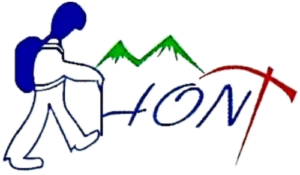
Annapurna Circuit Trek
Annapurna circuit trek | 2024.

- Trip Duration: 12 Days
- Altitude: 5,416 m / 17,769 ft
- Best time: Feb-May, Sep-Dec
- Grade: Challenging
- Trek Type: Tea House
- Meals: Included
- Accommodation: Hotel & Tea House
- Group Size: Min. 2 pax
Overview of the Annapurna Circuit Trek
The Annapurna Circuit Trek presents a remarkable and incomparable experience for all trekkers seeking a professional adventure. Spanning across four districts, namely Lamjung, Myagdi, Manang, and Mustang, and covering a vast distance of 160–230 kilometers, this trek provides the opportunity to explore the diverse natural vegetation, cultural beliefs, landscapes, altitude, trail, pristine little settlements, culturally affluent tribal groups, and religious sects of the region.
Commencing from Jagat, the journey gains altitude and provides a transformed landscape and vegetation that convert into rugged alpine terrain. The highlight of this trek is crossing one of the highest navigable passes in the world, Thorong La (5,416 m), which offers splendid and breathtaking views of the snow-capped Himalayas that exceed expectations.
Highlights of the Annapurna Circuit Trek
The Annapurna Circuit Trek is one of the most classic and oldest treks in Nepal.
Thorang La Pass is one of the world’s highest navigable passes (5,416 m).
Glorious lakes, stunning glaciers, the deepest gorge, and incredible waterfalls.
Majestic views of Mt. Annapurna, Thorung Peak, Nilgiri, Chulu, Tukuche Peak, Dhaulagiri, Lamjung Himal, and Annapurna.
Explore the diverse natural vegetation, landscape, altitude, trail, and pristine little settlements.
Observe cultural beliefs, culturally affluent tribal groups, and religious sects in the region.
Outline Itinerary of the Annapurna Circuit Trek
KTM ) Arrival in Kathmandu city, transfer to the hotel
Day 01 ) Drive to Jagat via Besisahar (1,300 m) (8/9 hours)
Day 02 ) Trek to Dharapani (1,860 m) (5/6 hours)
Day 03 ) Trek to Chame (2,620 m) (6/7 hours)
Day 04 ) Trek to Pisang (3,200 m) (6/7 hours)
Day 05 ) Trek to Manang (3,540 m) (5/6 hours)
Day 06 ) Acclimatization Day
Day 07 ) Trek to Yak Kharka (4,018 m) (6/7 hours)
Day 08 ) Trek to Thorong Phedi (4,560 m) (5/6 hours)
Day 09 ) Trek to Muktinath (3,767 m) via Thorang-La Pass (5,416 m) (7/8 hours)
Day 10 ) Drive to Jomsom (2,710 m) (1 hour)
Day 11 ) Drive/flight to Pokhara
Day 12 ) Drive/flight back to Kathmandu
KTM ) Departure to your home
Not satisfied with this itinerary?
Annapurna Circuit Trek: Detailed Itinerary
Ktm) arrival in kathmandu city, transfer to your hotel.
- Meal: Breakfast
- Accommodation: Hotel
- Altitude: 1,400 m | 4,593 ft
Upon arrival at Tribhuvan International Airport in Kathmandu, you will be warmly greeted by a representative from the Himalayan Odyssey Nepal Trek. They will then escort you to your hotel. We wish you a comfortable and enjoyable stay at your hotel.
Day 01) Drive to Jagat from Kathmandu via Besisahar (1,300 m) (8/9 hours)
- Meals: Breakfast, Lunch, Dinner
- Accommodation: Lodge
- Altitude: 1,300 m, Jagat
- Distance: 211 Km | 131 Miles
We embark on a journey from Kathmandu to Besisahar via tourist bus with scheduled stops for breakfast and lunch. Our route takes us through the stunning Trishuli River valley before arriving in Besisahar. From there, we progress towards Jagat by Jeep, along the majestic Marshyangdi River, passing through charming villages, verdant paddy fields, and lush forests until our arrival in Jagat. An overnight stay at the lodge would be arranged at Jagat.
Day 02) Trek to Dharapani (1,860 m) (5/6 hours)
- Altitude: 1,860 m, Dharapani
We are traversing a rugged path adjacent to the Marsyangdi River, observing breathtaking cascades, verdant fauna, and wildlife. The trail ascends towards a hamlet known as Tal. Continuing further up the valley, we ascend by means of stone steps until we arrive at Dharapani. We are lodging here for the night.
Day 03) Trek to Chame (2,620 m) (6/7 hours)
- Altitude: 2,670 m, Chame
The path ascends along the Marsyangdi River, amidst trees such as pine and fir. Spectacular views of Annapurna II (7,937 m), Mt. Manaslu (8,156 m), and other peaks can be admired before reaching Chame. We’ll be spending the night at the lodge.
Day 04) Trek to Pisang (3,200 m) (6/7 hours)
- Altitude: 3,200 m, Pisang
Following breakfast, we will embark on the Marsyangdi Trail towards Bharatang. Annapurna II (7,937m) will be closely observed along the way. We will then ascend a steep hill and behold a plethora of oak, fir, pine, hemlock, and maple trees. The Pangida Danda will provide us with a magnificent view. Subsequently, we will cross a suspension bridge, ascend slightly, and then descend to the valley floor. Dry, grazing land be seen as we reach Dhukure Pokhari. After roughly half an hour’s walking, we will reach Pisang where we will stay overnight at the lodge.
Day 05) Trek to Manang (3,540 m) (5/6 hours)
- Altitude: 3,540 m, Manang
Our day will commence with a stroll on a path that hardly experiences any precipitation and offers stunning landscapes. There are two routes leading to Mungi that we may take. The tougher route, laced with exquisite stone houses surrounded by wheat, barley, buckwheat, potatoes, and beans, passes through the beautiful Ghyaru village. Following that, we will progress towards Ngawal, a hamlet with a gompa and prehistoric juniper trees. Later, we will travel down a trail that runs to Mungji and intersects the other route. Eventually, we will arrive at the renowned village of Manang, where you may delight in the picturesque Annapurna mountain range. You will be lodging overnight at the accommodation establishment.
Day 06) Acclimatization Day at Manang village
Today is designated as the acclimatization day for our body to adjust to gaining altitude and avoiding any form of high-altitude sickness. Our itinerary includes a higher-elevation hike either to the ridge near the Gangapurna glacier or a walk up to the cave above Manang village. During the acclimatization day, we will also take time to visit the native people in the village, gaining insight into their lifestyle and culture. Overnight stay will be at the lodge.
Day 07) Trek to Yak Kharka (4,018 m) (6/7 hours)
- Altitude: 4,018m, Yak Kharka
Commencing the trek with an ascent to Tenghi, the last permanent settlement below the pass, we shall proceed upwards until we reach Gunsang, and then turn towards Jharsang Khola Valley. The trail steadily leads us through scrub juniper and alpine grass, ultimately reaching Yak Kharka. Accommodation for the night shall be at the lodge.
Day 08) Trek to Thorong Phedi (4,560 m) (5/6 hours)
- Altitude: 4,560 m, Thorong Phedi
After consuming breakfast, we proceed towards Thorong Phedi. We walk for approximately one hour and arrive at Churi Leder. We then descend to the river and use the wooden bridge to cross it. The trail subsequently becomes challenging as one climbs upstream of Jharsang Khola on the ridge of the cliff and ultimately arrives at Thorong Phedi. We spend the night at the lodge.
Day 09) Trek to Muktinath (3,767 m) via Thorang-La Pass (5,416 m) (7/8 hours)
- Altitude: 3,767 m, Muktinath
Today, we shall embark on a journey to reach the highest point of the Annapurna Circuit trek. We will depart towards Thorong-La Pass (5,416 m) early in the morning, commencing the ascent. The trail is steep and narrow, but with diligence, we shall ascend for approximately four to five hours, culminating at the summit at 5,416 m. From the top, we shall revel in the breathtaking beauty of magnificent mountain ranges such as Annapurna and Dhaulagiri. The summit also boasts some chortens and colorful flags, symbolizing our triumphant hiking success. Upon taking memorable photos and adoring the unspoiled wilderness, we shall trek downhill through the rocky terrain before meandering through verdant fields that lead us to a sanctuary called Muktinath. We shall spend the night at the lodge in cozy comfort.
Day 10) Drive to Jomsom (2,710 m | 1 hour)
- Altitude: Jomsom, 2,710 m
Upon our arrival in Jomsom, we will proceed directly to our lodgings, where we will take a moment to refresh ourselves before embarking on a leisurely exploration of the local area. We may visit museums, apple orchards, or other points of interest in the city. Finally, we will retire to our overnight accommodations.
Day 11) Flight to Pokhara (822 m) (20 minutes)
- Altitude: 2,874 m, Ghorepani
Today, we will be taking a morning flight from Jomsom to Pokhara. This flight is renowned for its picturesque journey between two stunning mountains and offers a breathtaking view of the area. Upon arrival in Pokhara, there are numerous activities to engage in, including shopping, boating, engaging in the nightlife, or simply unwinding.
[Note:] In view of the unpredictable weather in Jomsom, it may become necessary to commute to Pokhara via jeep, rather than by flight. Should this occur, we kindly ask for your patience and understanding as alternative transportation options are arranged.
Day 12) Drive/flight back to Kathmandu
Ktm) departure to your home.
- Airport pickup and drop-off for arrival and departure
- A total of two nights’ accommodation in Kathmandu (Bed and breakfast) after the arrival and after the trek
- Annapurna Conservation Area Permit (ACAP) fee
- Trekkers Information Management System (TIMS) card fee
- All government, local taxes, and official expenses
- A government-licensed, experienced trek leader (guide), an assistant trekking guide for 8 or more trekkers, and porters to help trekkers with luggage ( *1 porter for two trekkers; the maximum luggage limit per trekker is 14 kg. )
- Guides and porters costs, which include meals, insurance, salary, lodging, transportation, and other necessary equipment
- One-night accommodation in Pokhara (Bed and breakfast) after the trek
- Kathmandu to Besisahar tourist bus fare
- Private transportation: *Besisahar – Jagat *Muktinath – Jomsom
- Domestic flight *Jomsom-Pokhara [ flight worth USD 160 per person ] *Pokhara-Kathmandu [ flight worth USD 105 per person ]
- All accommodations during the trek
- Three meals a day (Breakfast, Lunch, and Dinner) during the trek
- Arranging rescue operations in cases of complicated health conditions (funded by travel insurance)
- International flight airfare
- On Arrival Visa Fee at Entry Points: [15 days: USD 30, 30 days: USD 50, 90 days: 125 USD]
- Extra nights’ accommodation and meals in Kathmandu and Pokhara due to early arrival, late departure, or an early return from the trek
- Lunch and dinner in Pokhara
- Personal expenses (shopping, snacks, bottled water or boiled water, hot (tea, coffee) and cold drinks, hot shower, alcohol, Wi-Fi, telephone call, battery recharge fee, extra porters, etc.)
- Personal clothing and gear
- Tips for guides and porters
- Additional costs due to delays caused by circumstances outside company control like landslides, weather conditions, itinerary modifications due to safety concerns, illness, changes in government policies, strikes, etc.
Client Inquiry Form
[natural habitats of the annapurna region].
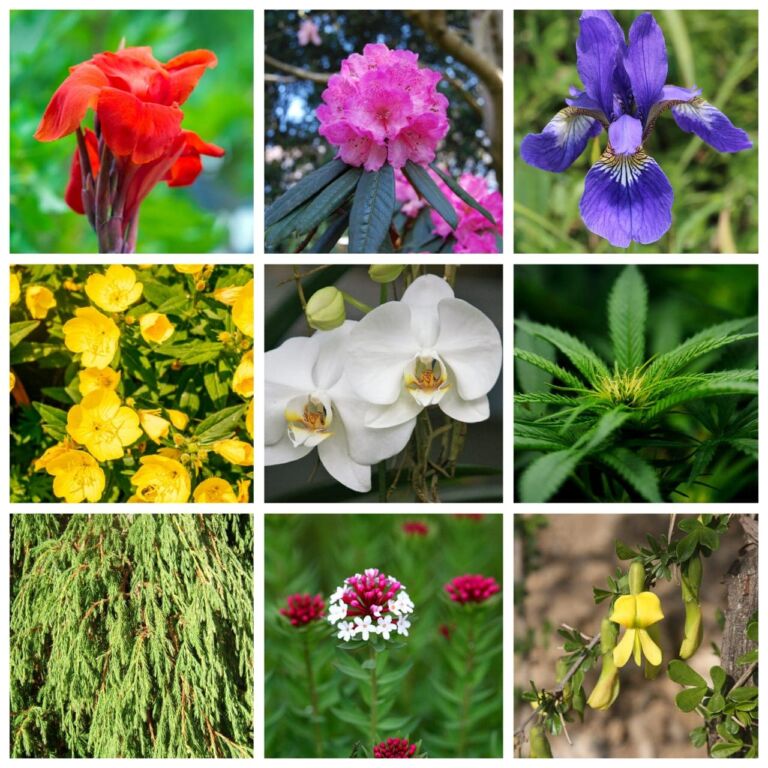
Flora found in the Annapurna region
Row 01: Canna lily, Rhododendron, Iris Row 02: Yellow primrose, White orchid, Marijuana Row 03: Juniper bush, Stellara, Caragana brevispina

Fauna found in the Annapurna region
Row 01: Bharal (Blue sheep), Snow leopard, Himalayan wolf Row 02: Gray langur, Leopard, Jungle cat Row 03: Red fox, Himalayan marmot, Red giant flying squirrel
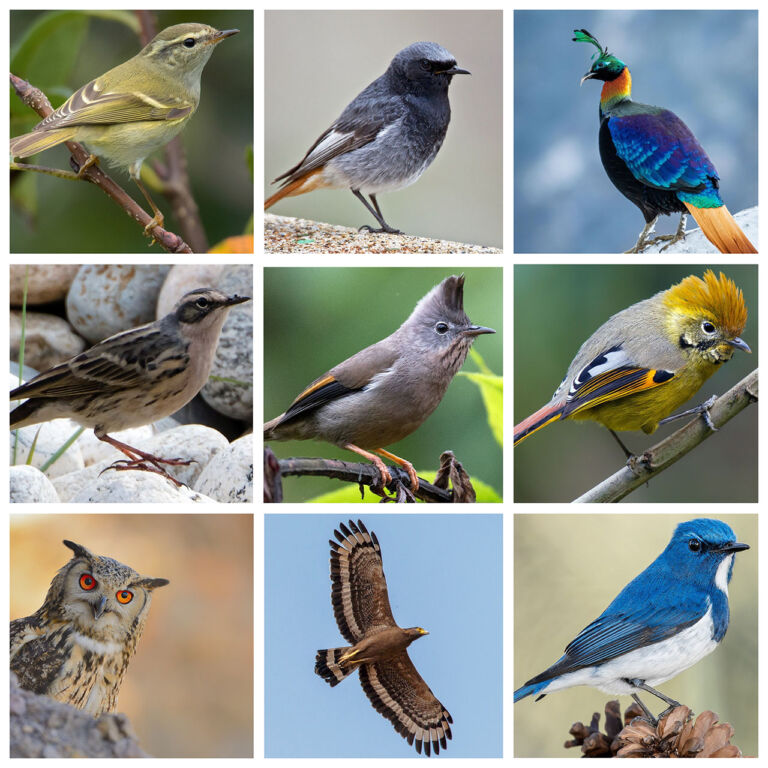
Birds found in the Annapurna region
Row 01: Hume's leaf warbler, Black redstart, Impeyan pheasant Row 02: Rosy pipit, Stripe-throated yuhina, Chestnut-tailed minla Row 03: Rock eagle owl, Crested serpent eagle, Ultramarine flycatcher
Travel Information
All trekkers must provide a copy of their comprehensive travel insurance policy certificate to the Himalayan Odyssey Nepal Trek before starting the trek.
[Note:] The policy must cover medical and emergency repatriation, including helicopter rescue and evacuation expenses at high altitudes.
Trekking permit requirements Two permits are required for the Annapurna Circuit Trek : 1) a TIMS (Trekkers Information Management System) card 2) an entry permit for the Annapurna Conservation Area Project permit
Permit Cost * Annapurna Conservation Area Project permit : NPR 3000
The level of difficulty for the Annapurna Circuit Trek is challenging (grade IV). One commences the Thorong La Pass Trek at an altitude of around 1,000 meters above sea level and ascends to as high as 5,416 meters at Thorong La Pass. This height is considerable. There is a possibility of experiencing altitude sickness.
During the trek, potable water is conveniently accessible. Kindly bring a reusable water bottle for refilling at every lodge. For your safety, it is advisable to carry purifying tablets to ensure the water is safe to drink.
If you experience symptoms of high-altitude sickness, it is recommended that you immediately return to a lower altitude. You may find more information on altitude sickness on our website’s dedicated Altitude Sickness page.
Cellular networks are available on the trekking trails of the Upper Mustang trek, though occasional areas may have limited or no reception.
The standard length of the Annapurna Circuit Trek is approximately 160-260 kilometers. The duration of the trek can vary between 10 to 21 days, depending on your itinerary or the starting and ending points.
Trekking Map of Annapurna Circuit Trek: 12-Days Itinerary

Duration: 10 Days

Duration: 11 Days
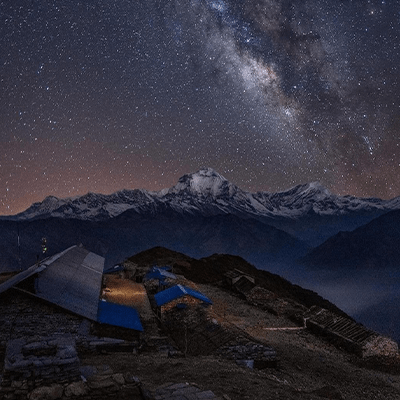
Duration: 9 Days
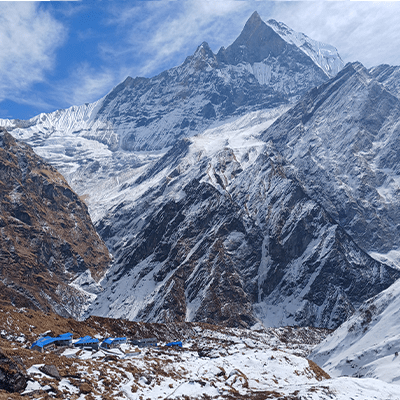
Duration: 7 Days
- BACKPACKERS WANDERLUST - AN AWARD WINNING TRAVEL BLOG
- Work With Me | Backpackers Wanderlust

- DISCLOSURE & PRIVACY POLICY
- United States
- Cook Islands
- New Caledonia
- New Zealand
- Accommodation Goals
- Budget And Cost Of Travel
- Foodie Goals
- Packing & Planning
- Travel Inspiration
- Volunteering Abroad
- Working & Studying Abroad
- Other Travel Tips
Nepal , Asia
Annapurna circuit itinerary: all you need to know about the best trek in nepal.
Find out about my 2 week Annapurna Circuit itinerary. Learn about everything you need to know such as permits, what to pack, accommodation, transportation to and from the trail, as well as so much more important information.
If you are planning to hike the Annapurna Circuit this hiking guide is a must-read!
One of the top treks in the world is the Annapurna Circuit in Nepal. In this guide, you will find everything you need to know from an Annapurna Circuit itinerary to what to pack and permits you may need.
Hiking through the Annapurna Himalayas you will get some of the best views and memories to last a lifetime. Though the conditions here can be intense. This is certainly a hike you need to prepare for otherwise you could find yourself in grave danger.
Luckily, if you are reading this you must be on the right page. So, let’s get into it a little further and find out the best Annapurna Circuit Itinerary, my experience and everything else you need and will want to know. Here is the link to a helpful PDF guide which I highly recommended downloading offline for use while trekking the Annapurna Circuit:
Annapurna Circuit Itinerary: Important Hiking Information
- Annapurna Circuit Permits
Should You Do A Guided Tour
- Accommodation on the Annapurna Circuit
- Food on the Annapurna Circuit
- Annapurna Circuit Packing Tips
- Shopping for Hiking Gear in Kathmandu

Permits and Regulations
Before you even think about starting the Annapurna Circuit you are first going to need to correct permits. This includes the TIMS card and ACAP.
The TIMS card stands for the trekker’s information management systems and costs 2000 NRs per person. You can purchase one at the TIMS Counter at the Tourist Service Center in Bhrikutimandap, Kathmandu . They are open from 10 am to 5 pm, 7 days a week.
The ACAP stands for the Annapurna Conservation Area Permit. This allows you to enter the Annapurna Area and will need to be shown at many of the checkpoints along the trail. It costs 3000 NRs per person and can be collected at the same place as your TIMS card.

Taking a guided trek of the Annapurna Circuit is also a popular thing to do. When hiking you will find both travelers doing it themselves, whereas others have hired a guide.
The positive of booking a guided tour is that they will arrange everything for you. This can save a lot of hassle especially when it comes to organizing permits. They will also be able to sort out accommodation, and transportation, and of course safely guide you around the circuit.
You will definitely want to make sure you research and book with a reputable company, as this can truly make or break your experience. Make sure you check out reviews and what other travelers have to say about their experience. You will find a variety of companies out there, though a popular local tour agency with positive reviews is Nepal Hiking Team who offer an all inclusive Annapurna Circuit guided trek package for under $1300.00
Accommodation On The Annapurna Circuit
When you are in the middle of nowhere, in the middle of your Annapurna Circuit itinerary you would probably expect cold rooms, no electricity, and no running water.
Though, honestly, the quality of accommodation on the Annapurna Circuit is thoroughly impressive. Especially at higher elevations where you know, someone would have had to carry each piece of furniture up these difficult paths.
In all, honestly, one of the worse places we stayed on the trail was our first guesthouse in Bahunbunda. With no outlets in rooms, basic amenities, pay to use WiFi and no hot water I only thought the rooms must get worse from there as we are still fairly close to civilization.
Though, I was pleasantly surprised the following day when we arrived at our guesthouse to find power in the room, free WiFi and a free hot shower. It was the best welcome ever after a long day of trekking.
The rooms on the trail are basic, though as long as there is a semi-comfortable bed that is all you will really need. The majority of your time will be spent in the common room at the guesthouse and if it is cold they should light a fire.
It is about a 50/50 bet whether you will have an attached bathroom to the room, though these might cost an extra fee. Not once did we come across a heater in the room so make sure to bring some warm nontrekking clothes to sleep in.
The majority of nights on the trail we spent at free guesthouses. We trekked in May which is considered the shoulder season.
So, if you are going trekking in the high season you may need up paying a small fee for the room. It really all depends on supply and demand.

Food On The Annapurna Circuit
Now do not expect to come across any restaurants on the Annapurna Circuit . Though you will find plenty of homely guesthouses with lovely locals more than happy to serve you.
Whether you are wanting to stop in for lunch or just a simple cup of tea, they break up a busy day of hiking perfectly.
At these guesthouses, you will find a mixture of Nepali and Western Cuisine. Just don’t expect it to taste like home or something like a meal from a big city cafe.
You will find plenty of chow mein served on menus as well as my breakfast favorite, Tibetan bread. There are also items like pizza, pasta, and hamburgers, but don’t expect great things from them.
No doubt the number one food item when trekking the Annapurna Circuit is dal baht. The slogan ’24 24-hour power’ is commonly associated with the meal and it is always consumed by the porters to give them plenty of energy.
So, it is a plate with an assortment of lentil curry, rice, curried potatoes, and pickled vegetables. Also, the best thing about this dish is that there are free top-ups on your plate. The guesthouse owner will keep coming over and topping up your plate until you request no more.
You are expected to eat dinner and breakfast at the guesthouse which you stay at. However, if you decide not to, you will likely be requested to pay more for the night.
At the majority of guesthouses, we only ever paid for dinner and breakfast, not for the accommodation itself. This is how the locals make their money and if the menu looks a bit ‘pricey’, remember that you are sleeping there for free!

Packing Tips For The Annapurna Circuit
I was greatly unsure whether or not to purchase hiking boots or do it in my sneakers. Though after speaking with Shona she said the sneakers would be fine and I trusted her advice. The terrain there is not overly difficult.
Although you will want something you can comfortably wear all day. Just be aware of snow levels as you do not want to be walking around in nonwaterproof shoes in ankle deep snow. Surprisingly, one guy on our trek was 55+ years of age and was doing it in a pair of sandals.
We had no problem not bringing with us a pillow or sleeping bag. There were always plenty available at guesthouses which was perfect for us. Though I am unsure what it would be like during the busier trekker months.
I purchased a sleeping bag liner, though I never used it on the Annapurna Circuit. Considering I am used to hostel dorm beds I did not find the teahouse rooms unclean and never had an issue jumping straight into bed.
There are many things that people told us to pack for the Annapurna Circuit which we ultimately did not need. Luckily, if you are arriving in Nepal to do the Annapurna Circuit and have absolutely no trekking gear, don’t worry.
We were in this position and from online recommendations headed straight to Shona’s Alpine.
Shopping In Kathmandu
There was no warm welcome, it is just straight business here. Though, the team there was able to kit us out with all the necessary trekking gear, including missing out on sales by truthfully telling us what we don’t need. My major tips which I will pass on to you are:
- You do not need a puffer jacket unless you are trekking in one of the colder months. If you are to get it wet, either from the rain or snow, they become incredibly heavy and very hard to dry. Instead, we purchased a windbreaker jacket and a fleece jumper.
- Buy woolen socks instead of cotton. They do not hold onto smells as much so you can hang them up overnight to wear the next morning.
- Buy a decent, heatproof water bottle. Usually, I am the kind of person to recycle the same disposable drink bottle for months at a time. Though, spending $12 on a drink bottle in one of the world cheapest countries was one of the smartest decisions. It became a hot water bottle on freezing nights and provided relief to sore muscles.
- If you are thinking of buying some suitable shoes for the trek make sure you have time to wear them in, as you won’t be able to do anything when you are so far away from civilization and covered in blisters. Make sure to test them out and find some good beginner hiking boots if this is your first time buying some.
Also if you are a plus-size lady or gentleman I highly recommend purchasing clothing in your home country. It can be incredibly difficult to source larger-sized clothing in Asia countries.
Even in Nepal where it is a Western trekkers shopping paradise. All in all, we had no issues with the quality of the clothing we purchased and it held up extremely well throughout the Annapurna Circuit.

Annapurna Circuit Itinerary For 2 Weeks Trekking
- Pokhara to Bahundanda: Day One
- Bahundanda to Tal: Day Two
- Tal to Timang: Day Three
- Timang to Chame: Day Four
- Chame to Upper Pisang: Day Five
- Upper Pisang to Ngawal: Day Six
- Ngawal to Manang: Day Seven
- Manang Rest Day: Day Eight
- Manang to Yak Kharka: Day Nine
- Yak Kharka to Thorong Phedi: Day Ten
- Thorong Phedi to Muktinath: Day Eleven
- Muktinath to Jomsom: Day Twelve
- Jomsom to Pokhara: Day Thirteen
Day One On The Annapurna Circuit Itinerary:Pokhara To Bahundanda
Pokhara (1400m) to Besishar (820m) – 5 hour bus journey
Besisahar (820m) to Bhulbhule (840m) – 1 hour bus journey
Bhulbhule (840m) to Ngadi (890m) – 4 km hike which took 1 hour
Ngadi (890 m) to Bahundanda (1310m): 4 km hike which took 2 and a half hours
The start of the Annapurna Circuit is Besieshar and you will need to get yourself there. From the popular tourist hangouts of Kathmandu and Pokhara, there are daily departures to Besisahar. These bus tickets are able to be booked through the majority of accommodation providers or at tourism agencies in the town.
Starting from Pokhara
If you are starting from Pokhara the bus departs from the tourist bus station, just a short walk out of the main lakeside town area. They call it the tourist bus, though it is not.
There will be plenty of locals packed with you like sardines in a can. My recommendation is to try and get a seat toward the back of the bus to avoid the majority of the commotion.
Starting from Kathmandu
Infamous for its traffic, be prepared to get stuck in Kathmandu for a while after boarding the bus. The advertised trip is just 6 hours from Kathmandu, though it is more notoriously claimed to last between 8-12 hours.
Many people mention that taking the microbus is the better option to travel between Kathmandu to Besissaar. You can find them at Gongabu Bus Park, though best to check with your accommodation to confirm this as things here like to change without warning.
Besisahar to Bahundanda
Once arriving in Besisahar you have the choice to either take another local bus or start your trek. With wide muddy roads, we decided to take the local bus from Besisahar to Bhulebhule.
This cost us just $1.30 / 200NRs. It was an extremely bumpy ride squished into the tight seats.
Starting our official Annapurna Circuit Itinerary in Bhubulehule is where we decided to get off and walk. Though, you can continue further up the trail to the village of Ngadi.
The walk between these two towns is extremely easy flat terrain. So, if you are thinking of getting off the bus and walking, just do it. The 4 kilometers between Bhubhule and Ngadi only take us an hour to hike past many local houses and some construction sites.
From Ngadi to Bahundanda is where you truly get your first taste of just some of the serene views on the Annapurna Circuit. With small local thatched houses, green rice terraces, and a slower pace of life, this is where it first hit me how far away we really are.
Life is simpler here as we hike past various Nepali women working in the fields. There is a steady uphill portion between Ngadi and Bahundanda which you should be aware of when planning your Annapurna Circuit itinerary. It slows us down a bit with the 4-hour hike taking 2 and a half hours.
The majority of guesthouses we saw in Bahundanda were extremely basic. They offered pay-to-use Wifi, no electricity in the room, and no hot water.
This was one of the few occasions on the circuit where we came across such simple accommodation. Though, if it is a clear day there are some amazing views from the teahouses to the Annapurna Himalayas in the far distance.

Day Two: Bahundanda to Tal
Bahundanda (1310 m) to Ghermu (1130m): 5 km hike which took 2 and a half hours
Ghermu (1130 m) to Jagat (1300m): 3 km hike which took 2 hours
Jagat (1300m) to Chamche (1385m): 4 km hike which takes 1 hour
Chamche (1385m m) to Tal (1700m): 5 km hike which took 4 and a half hours
Day two is certainly one of the harder days for me in this Annapurna Circuit Itinerary. This was the first and only day it rained on the trail. Luckily it was not a complete downpour.
Heading off in the morning from Bahundada to Ghermu the rain makes the paths a slippery mess. We try not to fall while maneuvering between stone trails and mud puddles. This is also where we come across the first bridge of many on the Annapurna Circuit.
It is a very easy walk to the nearby village of Syange where the track merges with the road. Trucks, jeeps, and vans make their way past, bringing resources further up the trail as well as trekkers who have paid to start higher up the circuit.
This is a relatively steep portion of the trail, rising nearly 200 meters in just 3 kilometers. However, being on the road rather than rocky paths makes it a whole lot easier to navigate and easier on the legs.
The kilometer trek from Jagat to Chamche is an extremely easy walk with barely any incline. We reach the village by following the road with plenty of energy remaining. Though, from Chamche to Tal is where the day begins to go wrong.
The journey from Chamche to Tal is certainly the most difficult of day two. We managed to follow the wrong paths multiple times, leading to backtracking multiple times. Though, apart from that, there is also the large rockslide that has covered the side of one hill. The path zigzags through the rockslide, making one last massive push to complete the day.
We enjoyed staying in the village of Tal. It is hidden deep in the valley floor with an impressive waterfall as a backdrop.

Day Three: Tal to Timang
Tal (1700 m) to Dharapani (1900m): 6 km hike which takes 2 and a half hours Dharapani (1900m) to Bagarchap (2160m): 2 km hike which takes 1 hour Bagarchap (2160m) to Danaqyu (2200m): 2 km hike which takes 1 hour
Danaqyu (2200m m) to Timang (2710m): 4 km hike which takes 2 and a half hours
To get back on the trail from Tal you have two options. The first is to navigate an extremely steep path up to the road and the second is to follow the river around on the right side. I recommend following the river around and enjoying being off the road as you will be spending the majority on it.
At the village of Karte, there is a large suspension bridge that will take you back to the road. From there it is an easy walk to Dharapani. This section is relatively easy when compared with the rest of today.
The trek from Dharapani to Bagarchap is easy with no overly impressive sights. The same goes for the walk from Bagarchap to Danaqyu. We just appreciate the scenery, the waterfalls, and the local goats.
The portion from Danaqyu to Timang is certainly the most difficult of day three. With a 500-meter incline over 4 kilometers, I only recommend doing this if you still have plenty of energy and it is still early in the afternoon.
The steep ascend zigzags around, over steeps created by wobbly river stones. There are minimal flat portions and you will need to take a breather as you make your way to Timang.
Timang was my favorite village on the Annapurna Circuit. There are impressive views over the Himalayas, rolling clouds, and friendly locals. I highly recommend planning your Annapurna Circuit itinerary to spend one night here.

Day Four On The Annapurna Circuit Itinerary: Timang To Chame
Timang (2710 m) to Thanchowk (2570m): 4 km hike which takes 1 and a half hours Thanchowk (2570m) to Koto (2640m): 3 km hike which takes 1 hour
Koto (2640m) to Chame (2710m): 2 km hike which takes half an hour
This is one of the easiest days on the trail. Just a 7-kilometer hike over 3 hours. Chame is actually the headquarters of the Manang district so if you need supplies this is the place to be.
There are many different shops here catering to trekkers you can pick up everything from the important snickers bars to gloves, hats, or ankle/knee braces.
Heading off from Timang to Thanchowk the trail continues on the road. It drops over 100 meters which makes a nice change from the steep uphill the previous day. Through paddocks, past locals, and happy livestock, it is a pretty uneventful portion of the trail.
The same goes from Thanchowk to Koto as the green fields continue on. Though portions of the road alternate from dry dirt to unstable rocks. This is another easy portion of the trail that you can do in a speedy time.
Koto is only a mere 2 kilometers from Chame and takes no time to complete. I recommend spending your afternoon exploring this interesting town. There are various types of teahouses here, from the most basic to luxury hotel quality.
If you are looking for a nice place to recuperate you will certainly find something here. Many guidebooks also speak about a local hot spring but do not bother. This is the most where locals do all their laundry so it is dirty and constantly busy.

Day Five: Chame To Upper Pisang
Chame (2710 m) to Bhratang (2850m): 7 km hike which takes 2 hours Bhratang (2850m) to Dhukur Pokhari (3240m): 6 km hike which takes 2 hours Dhukur Pokhari (3240m) to Upper Pisang (3310 m): 1.5 km hike which takes 1 and a half hours
If you do decide to take a jeep up a portion of the Annapurna Circuit, make sure you get off at or before Chame. The views between Chame to Upper Pisang are some of the best in this Annapurna Circuit Itinerary.
Heading off in Chame towards the apple village of Bhartang we come across many road workers. The views are impressive with snow-capped mountains, rushing rivers, and pine tree landscapes.
It is an obvious arrival in Bhratang with apple trees growing everywhere surrounded by large fences with signs warning to keep out. This small, bustling village is a popular stop to pick up a delicious apple pie before continuing on your way.
After Bhatrang you will quickly come across one of the most photographed portions of the trail, a part of the road which has been carved into the mountainside. With a straight drop into the river below it is one of the most unique roads I have seen.
From there it is another short walk when you will come across the impressive Swarga Dwari. This bowl-like mountainside has been shaped by the wind to become what it is today, a gateway to heaven.
The path then cuts through the zig-zag of the road up a fairly steep hillside, from there it is a simple walk down to Dhukur Pokhari.
It is a relatively easy walk between Dhukur Pokhari and Upper Pisang through neat grass fields until the high route begins. The small path leads up the righthand side of the valley to Upper Pisang.

Day Six On The Annapurna Circuit Itinerary: Upper Pisang to Ngawal
Upper Pisang (3310m) to Ghyaru (3730m): 5 km hike which takes 3 hours Ghyaru (3730m) to Ngawal (3680 m): 5 km hike which takes 3 hours
It is an easy walk from Upper Pisang until you reach the bottom of the hill where Ghyaru is situated upon. This hill is one of the harder sections os the trail as it zigzags back on itself as you slowly climb your way up the 300 meters.
It took us over an hour to climb this small section alone. At the top, you will get some impressive views of the nearby snowy mountains and low valley floor.
Ngawal might be lower in altitude than Ghyaru, though you will still need to ascend a bit further until you descend back again. The small mountainside trail is a nice change from the road and it is not overly difficult as you climb another 500 meters.
If you are suffering from altitude sickness symptoms like I was this can be quite testing.

Day Seven: Ngawal To Manang
Ngawal (3680m) to Humde (3330m): 2 km hike which takes 1 and a half hours Humde (3330m) to Braka (3450m): 6 km hike which takes 3 hours Braka (3450m) to Manang (3540m): 2 km hike which takes half an hours
From Ngawal it is a steep descent back onto the valley floor. This is where the high trail meets back up with the lower trail and the Annapurna Circuit hikers merge back again in Humde. It is a short hike, though best to take it easy as it can be tough on the knees.
From Humde to Braka it is a relatively easy walk over 3 hours. We keep to the road and dodge the occasional jeeps and motorbikes which whizz past every so often. The same is which Braka to Manang. It is a simple hike following the road alongside the river.
Manang is a popular town where you should have a rest day with the other trekkers. There are plenty of teahouses, ranging in quality, bakeries, movie cinemas, and shops.
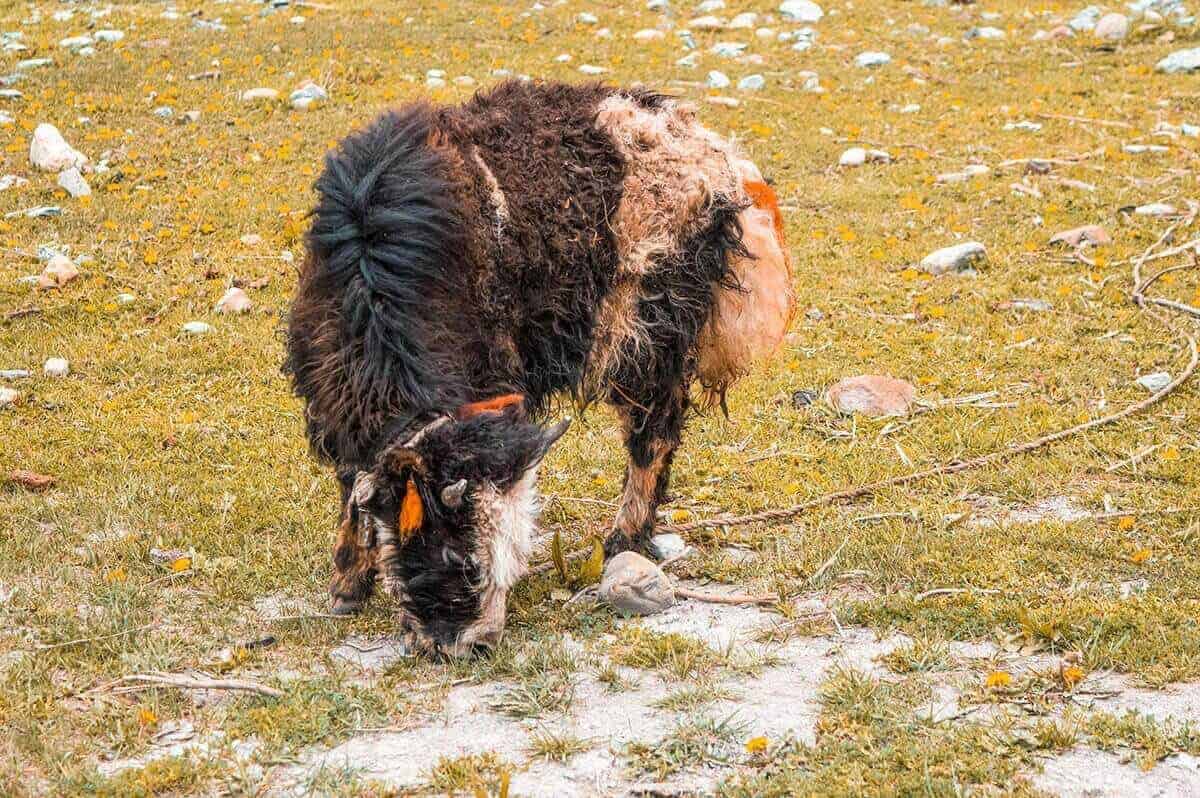
Day Eight: Manang Rest Day
You should spend your one day once you reach Manag in the Annapurna Circuit Itinerary as a rest day. You should spend a couple of nights here to adjust to the altitude, ultimately assisting your body to adjust to the higher altitudes to come.
If you have plenty of energy you can do the side trek to the Ice Lake which is a steep full-day trek.
Day Nine: Manang to Yak Kharka
Manang (3540m) to Gunsang (3900m): 3 km hike which takes 2 hours
Gunsang (3900m) to Yak Kharka (4050m): 7 km hike which takes 3 hours
It may only be a short 3-kilometer hike to Gunsang, but with an elevation increase of over 300 meters, it is not easy. The road ends and now we are on a small path. Prepare for traffic jams of horses and yaks.
Turning a corner the village of Gunsang can be seen in the distance. A large valley provides amazing panoramic views across on our left to the nearby mountain ranges.
Heading out of Gunsang the hike to Yak Kharka is a lot easier than the first portion of today. It may be longer, but it has a steady, barely noticeable incline of 150 meters over 7 kilometers.
There are plenty of swing bridges to cross over and the terrain has now turned completely barren. Just small shrubs cover the ground at this altitude.

Day Ten: Yak Kharka To Thorong Phedi Base Camp
Yak Kharka (4050m) to Churi Ledar (4200m): 1 km hike which takes half an hour Churi Ledar (4200m) to Thorong Phedi (4450m): 5 km hike which takes 3 and a half hours
This portion of the trail is an extremely easy gradual uphill. Though, thanks to the altitude it is still necessary to take a breather every 10 minutes or so. The 150-meter climb over half an hour into Churi Ledar is barely noticeable, maybe these amazing views are taking our mind off it all.
Out of Churi Ledar, there is a large suspension bridge taking us over the river to the other side of the valley then up a steep ascent. The climb is treacherous and the small rocks prevent getting a decent grip.
For each step forward it feels like taking two steps back as you begin to slide back down the mountain. The difficult trails carved into the side of a mountain are not the easiest to navigate, though it is just a quick 15-minute walk to the next portion of the path.
This is one of the most dangerous spots we will come across today and certainly one of the more dangerous parts of the trail.
This landslide zone has caused numerous injuries and at least one death throughout the years. You need to be careful that the path does not slip out below you, as well as watch out for falling rocks.
After about 20 minutes the landslide area finally ends and we arrive straight into the lodges at Thorong Phedi.
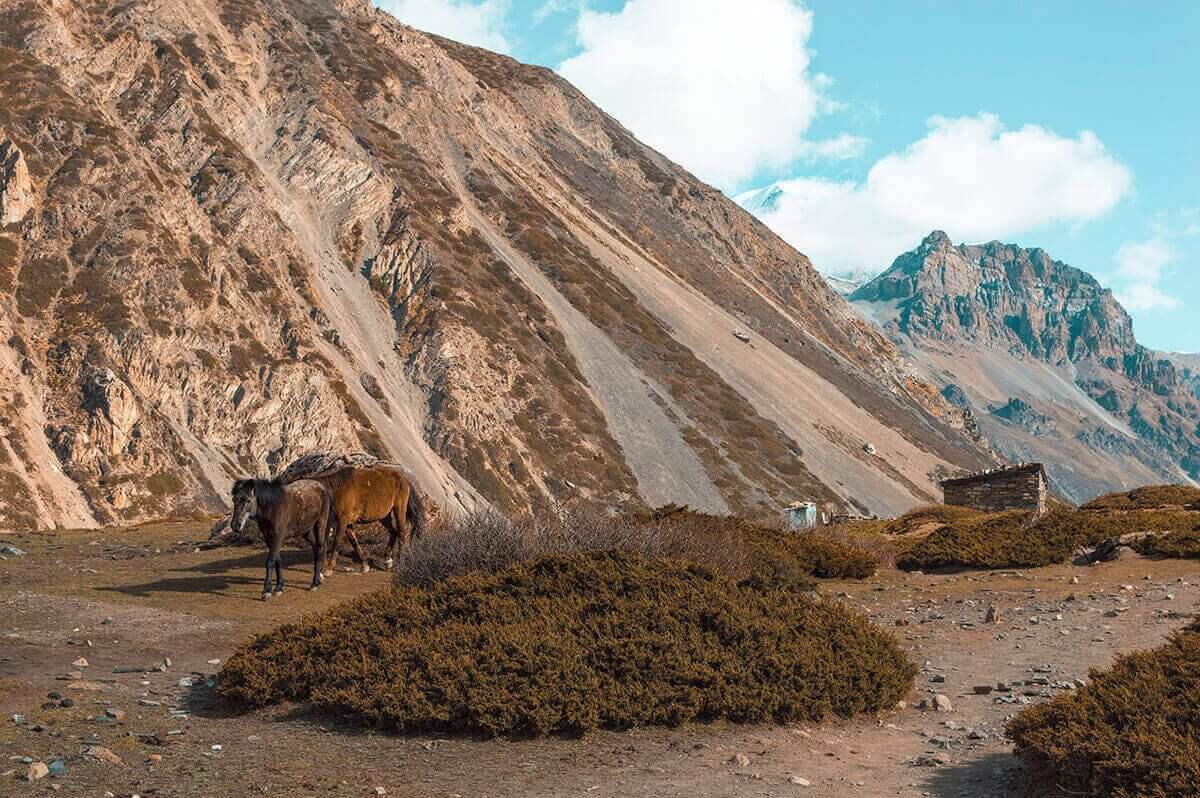
Day Eleven On The Annapurna Circuit Itinerary: Thorong Phedi Base Camp To Muktinath
Thorong Phedi (4450m) to High Camp (4850m): 1 km hike which takes 2 hours High Camp (4850m) to Thorong La Pass (5416m): 5 km hike which takes 4 hours Thorong La Pass (5416m) to Charabu (4230m): 6 km hike which takes 6 hours Charabu (4230m) to Muktinath (3800m): 4 km hike which takes 3 hours
Walking up out of Thorong Phedi to High Camp it is obvious to see how steep of a climb this is just going to be. Ascending about 400 meters in a kilometer is not going to make for an easy climb at all. The ascent is steep as we zig-zag back and forth on the extremely thin path covered in rocks.
Heading up away from High Camp I am feeling a lot better today than I was yesterday morning. The trail ascends gently behind our lodges until they are completely out of view, blocked by the endless rocky mountains.
We zigzag endlessly follow the trail while dealing with the overwhelming feeling of momentary excitement due to the numerous false passes. This goes on for what feels like hours while mountain sickness slowly starts to come over.
At 5416 meters the oxygen levels here are less than half of what they are at sea level.
From our descent from Thorong La Pass, the first hour and a half is a steady descent. The land is barren, just hundreds of rocks making up the ground. We zigzag slowly down the mountain. It is a difficult descent as you try to avoid slipping on the loose rocks.
We watch as the small village of Charabu gets closer and closer. The first portion of the trail is rather steep, but then it flattens out into fields. Coming across a herd of yak nearby a suspension bridge we spot the first signs of Muktinath.
It is a rather large, sprawling village, though, unfortunately for us, the lodges are quite far through it.
We follow the path up and down to the village of Muktinath. Walking through temple areas we watch those worshippings make their way past us on horseback. Muktinath has been an important place for pilgrims over the past 3000 years.

Day Twelve On The Annapurna Circuit Itinerary: Muktinath To Jomsom
Muktinath (3680m) to Jomsom (3330m): 23-kilometer bus ride which takes 1 hour
The bus is just packing on the crowds as we arrive at the bus station which is literally just a shed with a couple of buses waiting out front. James purchases us two tickets and I jump on board.
There are about 10 other trekkers already sitting in the seats. I guess we get charged premium prices to secure a seat. However, the locals and pilgrims must pay less on a first in first-in-first-serve basis.
The middle of the bus is packed with backpacks all stacked on top of each other as the driver tries to fit everyone in.
The seats in local buses here are extremely close together and the bags in the middle prevent them from being able to stretch out fully. Unfortunately, it is not the most comfortable ride. Luckily, the views are great as we pass by the villages of Kagbeni and Eklebhatti.
Thankfully we see the village of Jomsom in the distance. It stretches out quite far, full of flat-roofed two-story buildings. In the far end is where we stay and where you will find the majority of teahouses.

Day Thirteen: Flying from Jomsom To Pokhara
Jomsom (2720m) to Pokhara (1400m): 160 km flight which takes half an hour
In Jomsom, we decided flying back to Pokhara would be the best decision for us. Unfortunately, we were both unwell, and taking a bus down would have been horrific in the vomiting state we were in.
The plane tickets cost $100.00 each which was certainly the most expensive part of the Annapurna Circuit. However, being on one of the small planes, taking off from a crazy short runway, and experiencing the whole airport which is run by the military was certainly a highlight.
Also, you cannot beat the views from that plane.
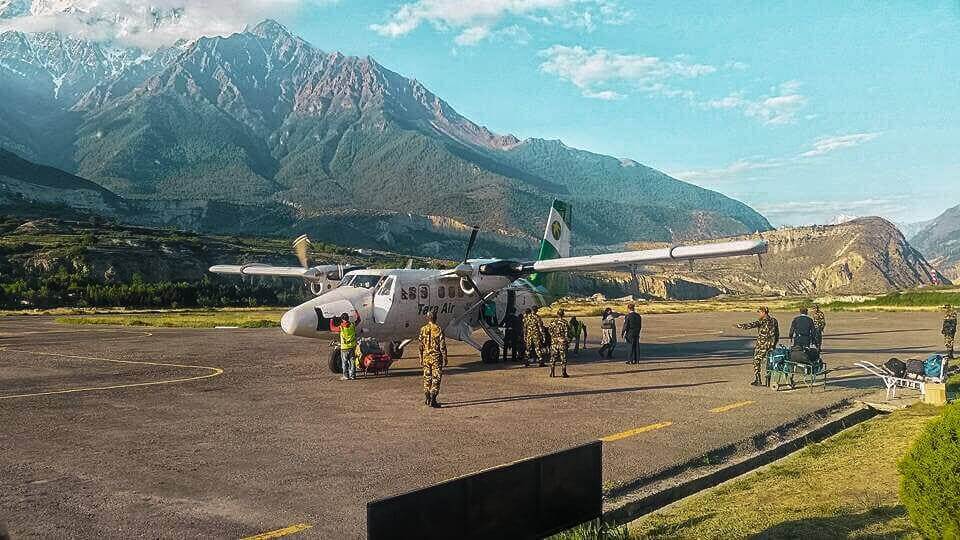
Continuing On The Annapurna Circuit
Perhaps you do not want to fly to Pokhara from Jomsom you can continue trekking the Annapurna Circuit via hiking and taking buses all the way back to Pokhara.
If you have plenty of free time you could perhaps even do the Annapurna Base Camp trek or Poon Hill Trek .
LIKE IT? PIN IT!

Want more Annapurna Circuit Inspiration? Check out….
- POKHARA TO BESISAHAR & BAHUNDANDA- STARTING THE ANNAPURNA CIRCUIT- DAY ONE
- BAHUNDANDA TO TAL ON THE ANNAPURNA CIRCUIT- DAY TWO
- TAL TO TIMANG ON THE ANNAPURNA CIRCUIT- DAY THREE
- TIMANG TO CHAME ON THE ANNAPURNA CIRCUIT- DAY FOUR
- CHAME TO UPPER PISANG ON THE ANNAPURNA CIRCUIT – DAY FIVE
- UPPER PISANG TO NGAWAL ON THE ANNAPURNA CIRCUIT- DAY SIX
- NGAWAL TO MANANG ON THE ANNAPURNA CIRCUIT- DAY SEVEN
- MANANG REST DAY ON THE ANNAPURNA CIRCUIT- DAY EIGHT
- MANANG TO YAK KHARKA ON THE ANNAPURNA CIRCUIT- DAY NINE
- YAK KHARKA TO THORONG PHEDI (BASE CAMP) ON THE ANNAPURNA CIRCUIT- DAY TEN
- THORONG PHEDI TO HIGH CAMP ON THE ANNAPURNA CIRCUIT- DAY ELEVEN
- HIGH CAMP TO MUKTINATH VIA THORONG LA PASS ON THE ANNAPURNA CIRCUIT – DAY TWELVE
- MUKTINATH TO JOMSOM ON THE ANNAPURNA CIRCUIT- DAY THIRTEEN
- FLYING JOMSOM TO POKHARA AND FINISHING THE ANNAPURNA CIRCUIT- DAY FOURTEEN
Disclaimer: This post contains affiliate links. So, if you click on it and purchase something, I get a small percentage at no extra cost to you. As always all opinions are my own and your support is much appreciated.
Tasha Amy is a true backpacker at heart and has been discovering the world on a budget since 2015. Based in Gisborne, New Zealand she will spend many months each year traveling overseas as a solo female traveler before coming home and sharing her adventures online with you.
17 thoughts on “ Annapurna Circuit Itinerary: All You Need To Know About The Best Trek In Nepal ”
Thank you so much for sharing the informative article as well as the beauty of Nepal. after reading this article people can easily travel to Nepal.
Great, thank you for your update its really useful .
Great post of Annapurna
Such an informative article.
Great blog post
Great article about the Annapurna circuit trek… love it…
such informative articles about Annapurna Circuit Trek love to see more articles in future
The pictures look surreal. And the itinerary you’ve shared is so detailed! I hope I get to do this sometime soon. Thanks for sharing.
Great article, and complete with all the information you need. I have done the ABC and I am planning to go back to Nepal do climb Mt. Mera in 2020.
Thanks for the detailed itinerary. We are hoping to do this in the next couple of years and this has made me more determined.
You have me extra excited for Nepal! Cannot wait for trekking!
We loved trekking to EBC and were really wishing we could stay in Nepal longer to do ABC. Your photos are seriously inspiring us to get back there!
I went to Nepal years ago but didn’t do any trekking as it wasn’t the right season. I love mountains and I really hope to do that some day. thank you for a very inspiring and comprehensive guide!
This looked amazing! Nepal is so high on my bucket list + I can’t wait to make it out there! (:
You certainly need to! Its an amazing place
Leave a Reply Cancel reply
Your email address will not be published. Required fields are marked *

Destinations
Trekking type, annapurna circuit trek: how to hike around the annapurnas, by jan bakker.
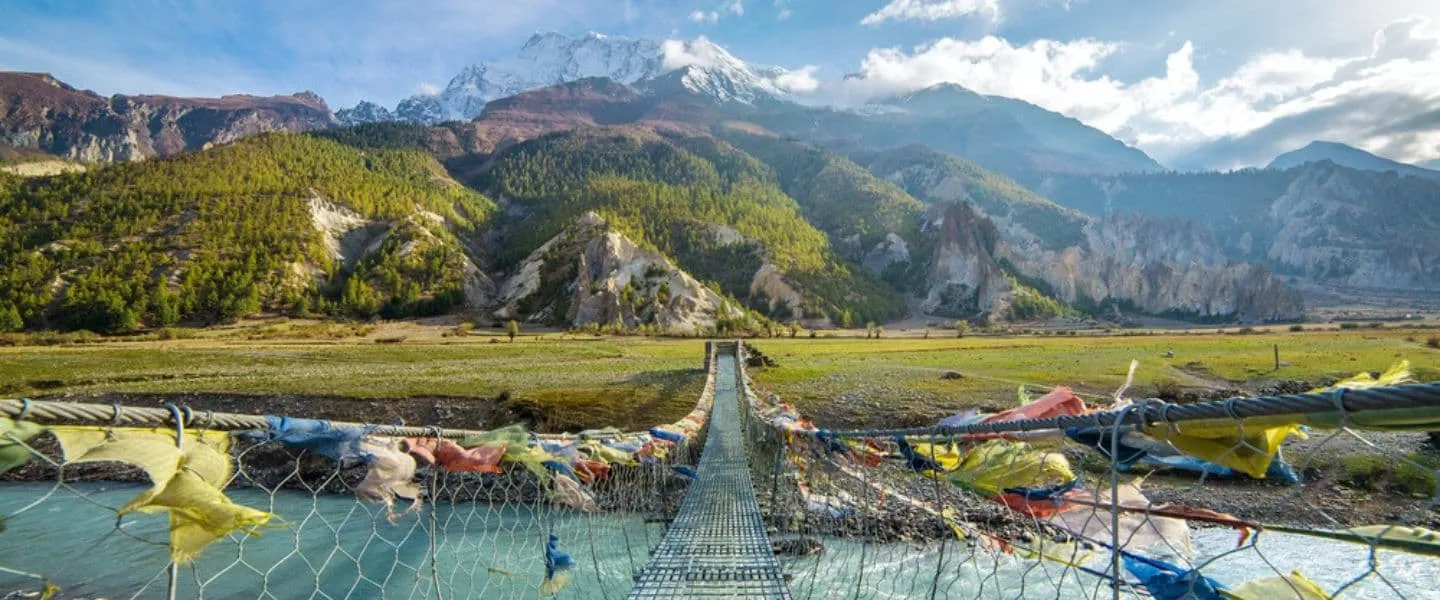
The Annapurna Circuit Trek is the most famous trekking circuit in Nepal. With some of the tallest mountains on Earth, tumbling glaciers and an incredible variety of landscapes, this trek represents everything what trekking in Nepal is about. It takes more than two weeks to circumnavigate the Annapurna Massif while staying in cozy tea houses. Over the last few years, we at Bookatrekking.com have helped hundreds of people to find their way in the Nepali Himalayas and now it's your turn.
Our team members have trekked all over the globe, but in terms of mountain landscapes the Annapurna Circuit remains high up there as one of our favorites. Why is this classic trek so special? Let us tell you why!
Annapurna Circuit Trekking: The Ultimate Trek in Nepal
How difficult is the annapurna circuit trek, the best time to hike annapurna circuit, the dynamics of the annapurna circuit route, annapurna circuit itinerary, how to cross the thorung la, annapurna circuit map, what permits do i need for the annapurna circuit trek, staying in tea houses on the annapurna circuit, how to identify and prevent ams on the annapurna circuit trek, packing list for the annapurna circuit trek, where can i book the annapurna circuit trek.
In the late 1970’s, when people started venturing into the Nepali Himalayas, the Annapurna Circuit was one of the first trekking routes to open for foreigners. In those days it took 23 days to hike around the Annapurna Massif. Fast forward to the present day, lots has changed. We’ll talk later about how trekking routes have changed in the past two decades, but one thing is for sure. The mountains of the Annapurna Massif are as stunning as they were 50 years ago.
The Annapurnas are close to Pokhara, about 6 hours west of Nepal’s capital Kathmandu. The small city, located on the shores of the stunning Phewa Lake, is the gateway to the Annapurna Massif. The Annapurna Circuit itself is a tea house trek, which means you stay in local guesthouses on the entire route. From the forested valleys at an elevation of 900 meters you’ll ascend to the Thorung La, the highest point of the trek at a whopping 5416 meter above sea level. The landscape gradually changes as you climb higher up the valley. Each day the giants of the Annapurna Massif reveal themselves a little bit more and your surroundings transform into a rugged alpine environment. The villages counter balance the mountains’ wild character. The tea houses are cozy and warm and you’ll be served endless cups of tea.
After scaling the Thorung La the route drops down into Lower Mustang, a high altitude desert with a completely different landscape. After the town of Jomsom the route continues to the hot springs of Tatopani, where you can soak and relax with fellow trekkers and locals alike. The final highlight of Annapurna Circuit is the climb up Poon Hill from Ghorepani. This is one of the most majestic viewpoints in Nepal, looking out over the entire Annapurna chain and spectacular mountains like Machapuchare and the 8167m high Dhaulagiri.
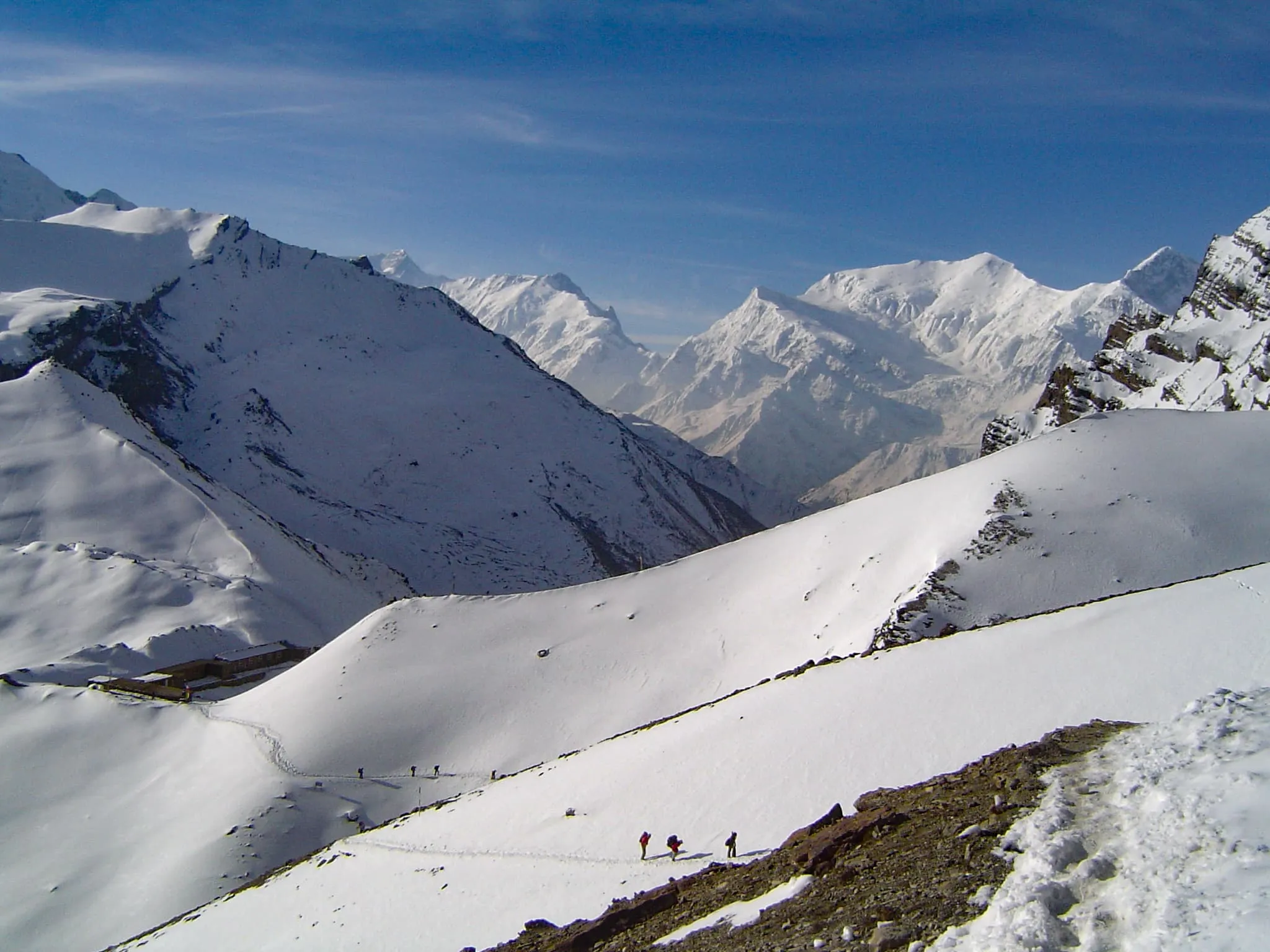
Annapurna Circuit Trek Accelerated
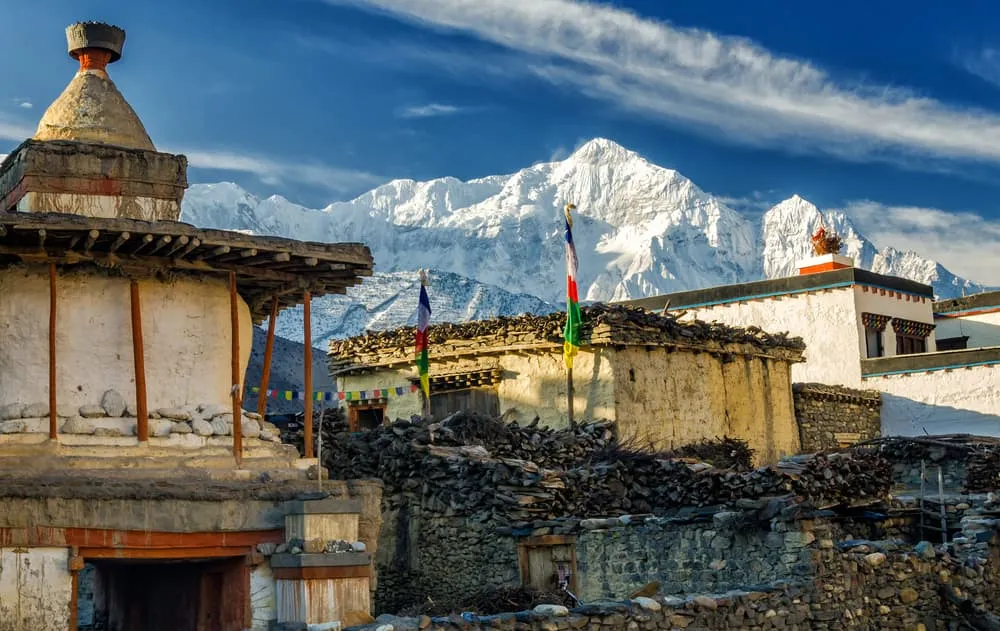
Annapurna Circuit Short
The Annapurna Circuit difficulty is quite low from a technical perspective. It's only walking and the path is in good condition in most places. It also helps that you stay in a guesthouse each night rather than a tent. You can get a proper rest without having to worry about logistics or getting cold. It really is the Annapurna Circuit altitude that makes the going tough sometimes. After all, it is a trek at high altitude, culminating to an elevation of 5416 meters on the Thorung La. In my experience, the Annapurna Circuit length also adds to the strenuous nature of the trek. The shortest version we offer involves 85 kilometers of trekking. On some days the distances are more than 20 kilometers. Those factors make the trek hard, whether you’re a novice or a seasoned hiker. You feel your body getting tired after a prolonged time on the trail. But maybe because of that, it feels like a true sense of achievement finishing the route from start to end. We are convinced when you do some training for the Annapurna Circuit and set off with the right mindset it is doable for most trekkers.
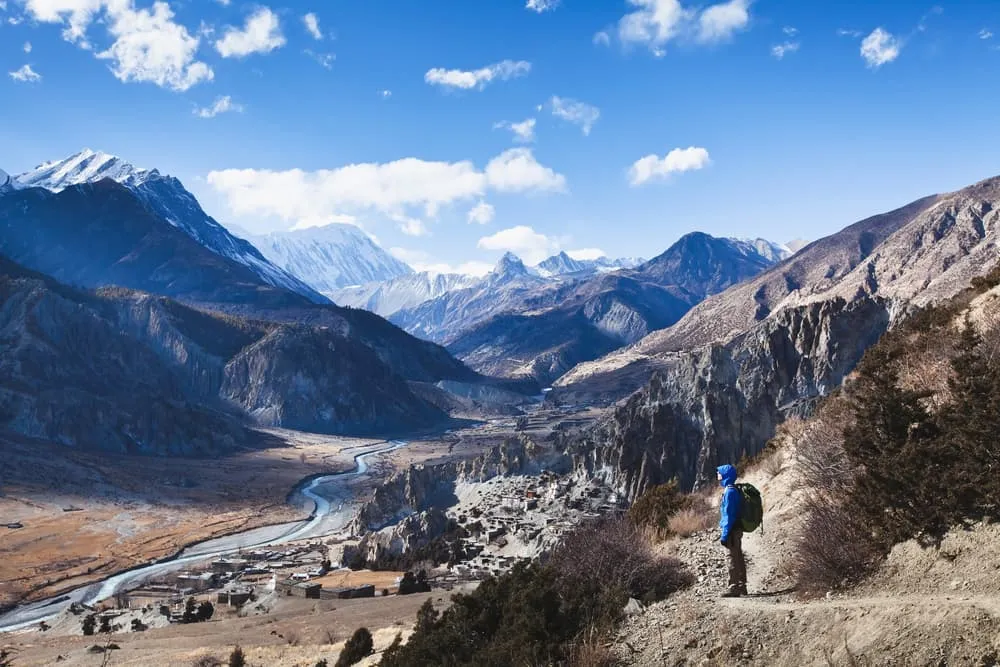
The Annapurna Region, along with most of the other trekking areas in Nepal, has four distinct seasons. Spring, summer, autumn and winter. The months from March to May, pre-monsoon, and from October to early December, post-monsoon, are the most popular for hiking the Annapurna Circuit. Every season offers its own excitement and atmosphere and in principle, you can go trekking year-round. There are good reasons why spring and autumn are considered the trekking season. Below we’ll give you a run-down of what each of the seasons are like.
Spring (March-May) is the high season and trekkers from around the globe come to the Annapurna Region in large numbers. In springtime, the temperature is pleasant, the precipitation is low and the hiking conditions are great. On the trail there’s a lot of excitement and anticipation to cross one of the highest mountain passes in the world for trekking, the Thorung La. It does get busy, but therefore it’s a great time to connect with like-minded adventurers. While temperatures in daytime along the trek are balmy, the temperature around the Thorung La can be very cold in the early morning, when you cross the pass. Check our complete Annapurna Circuit packing list further below in this blog post.
Summer season falls in the months of June, July and August. Summer is the month with higher temperatures and in that sense it is quite pleasant. However, this is also the monsoon season, and it rains a lot. The chance of seeing the mountains around you is smaller as it is cloudy most of the time. The trail will be wet and slippery and there is an increased risk of landslides. And leeches are very active during these months. On the flipside, it’s not very busy on the route and the traditional villages feel more serene.
Autumn in the Annapurna Region (September, October, November) is, like springtime, prime trekking season with similar trekking conditions. There is one difference. The air in spring is sometimes a little hazy due to the dust in the atmosphere. Post-monsoon the air is very clear, allowing for stunning views of the mountains.
Winter season runs from December to February. This period is the toughest time to trek on the Annapurna Circuit. With the Thorung La elevation exceeding the 5000 meters mark, it gets extremely cold. Night temperatures drop to -20 degrees Celsius. Add wind and snowfall and you’ve got yourself a proper winter expedition. Why do we still run the Annapurna Circuit trek in winter? We work with one of the best trekking companies in Nepal. Besides trekking trips they also organize climbing expeditions to some of the highest peaks in the Himalayas. Our local team keeps you safe and comfortable, even in these cold conditions. And you will probably have the entire trail to yourself!
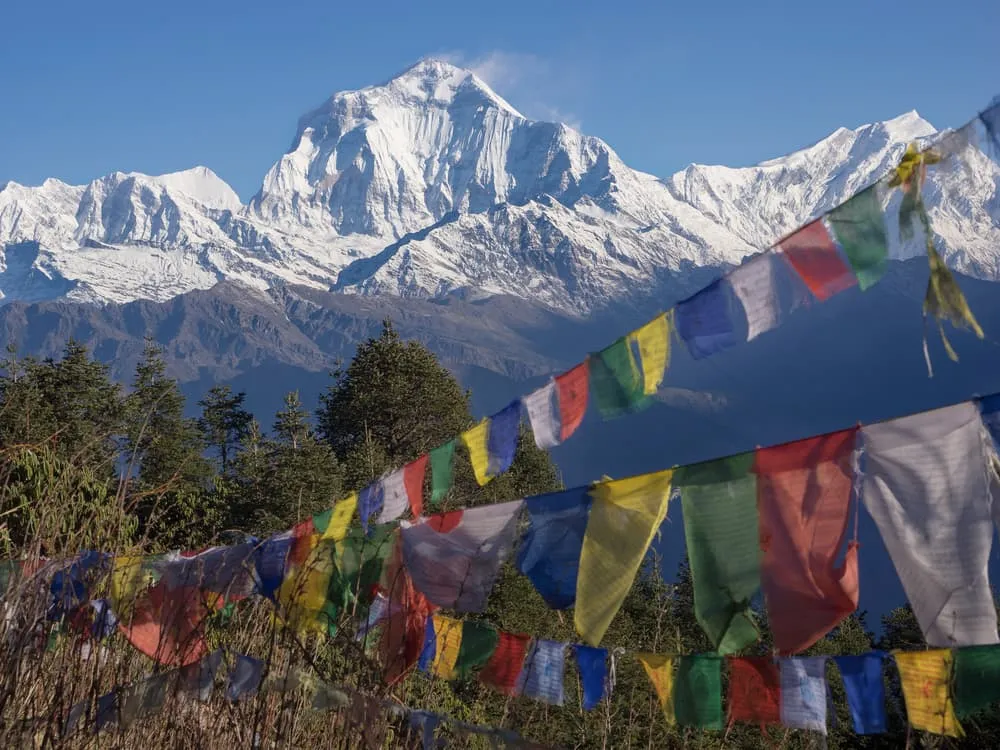
During the last 20 years a lot has changed in the Annapurna Region. In the name of progress, the lower parts of the Marshyangdi Valley have been made more accessible by building. Originally, the Annapurna Circuit route always started in Besisahar. Nowadays some tour operators opt for a start deeper into the valley as a dirt road has been built all the way to the mountain village of Manang. Bhulbhule is our choice to start the trek. From here you can avoid the road and hike on walking paths rather than the road. The biggest change however is the road development on the western side of the route. In recent years, a road has been constructed from Pokhara to Jomsom and extended even to the village of Muktinath. Some parts of the road are tarmac, some are gravel. Regardless, it has had a big impact on the original Annapurna Circuit itinerary. Especially between Jomsom and Tatopani most tour operators cover this section by car, as the alternative would be walking on a relatively busy road. From Tatopani trekkers can follow the original route again towards Ghorepani, Poon Hill and beyond. Having said all this, the Annapurna Circuit remains one of the most spectacular treks in Nepal, simply because the actual landscape and culture hasn’t changed much.
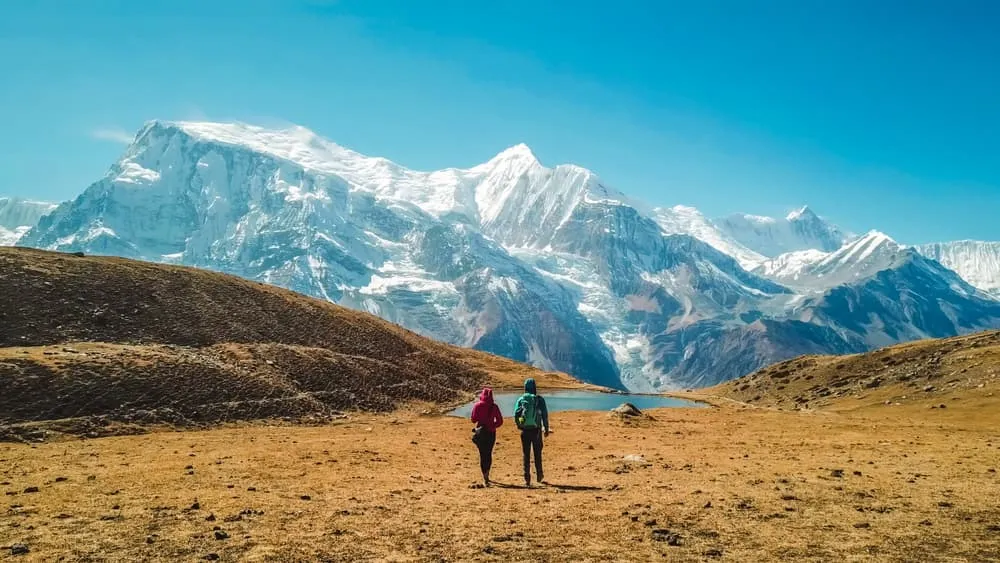
Not sure yet or want to discuss your plans for the Annapurna Circuit Trek with one of our trekking experts? Get in touch today and turn your dreams into memories!
It is best to do the circuit in 15 or 18 days. The 18-day version is old school and only follows the oldest trails. However, more and more people are choosing to do the 15-day version. If you choose the 15-day trek, you are sure to have a short break halfway and can enjoy all the attractions that the Annapurna Circuit has to offer.
Drive to Bhulbhule

Trek to Chamje
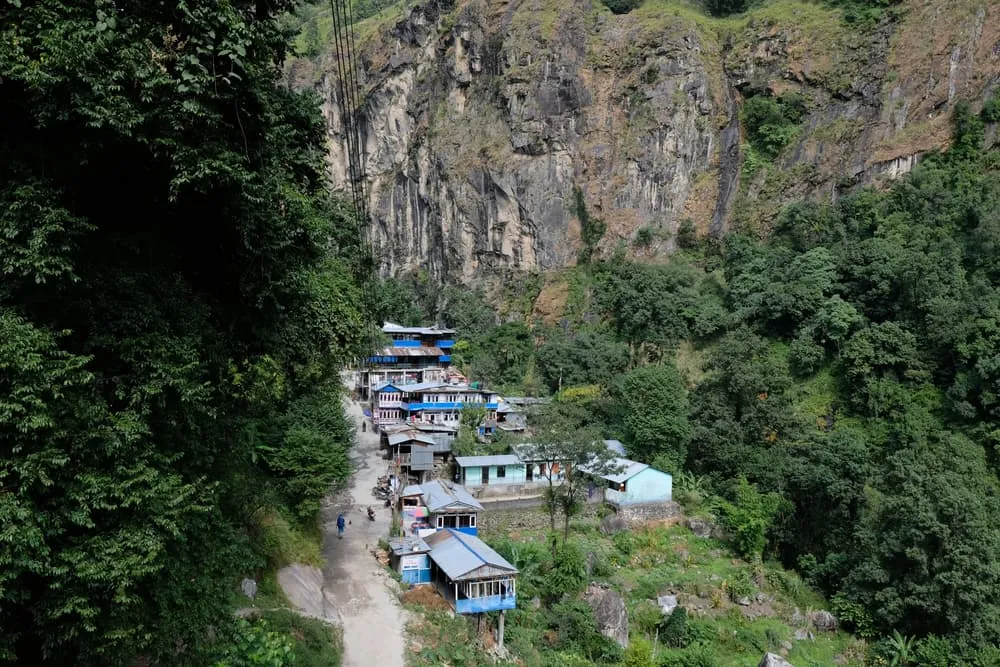
Trek to Bagarchhap
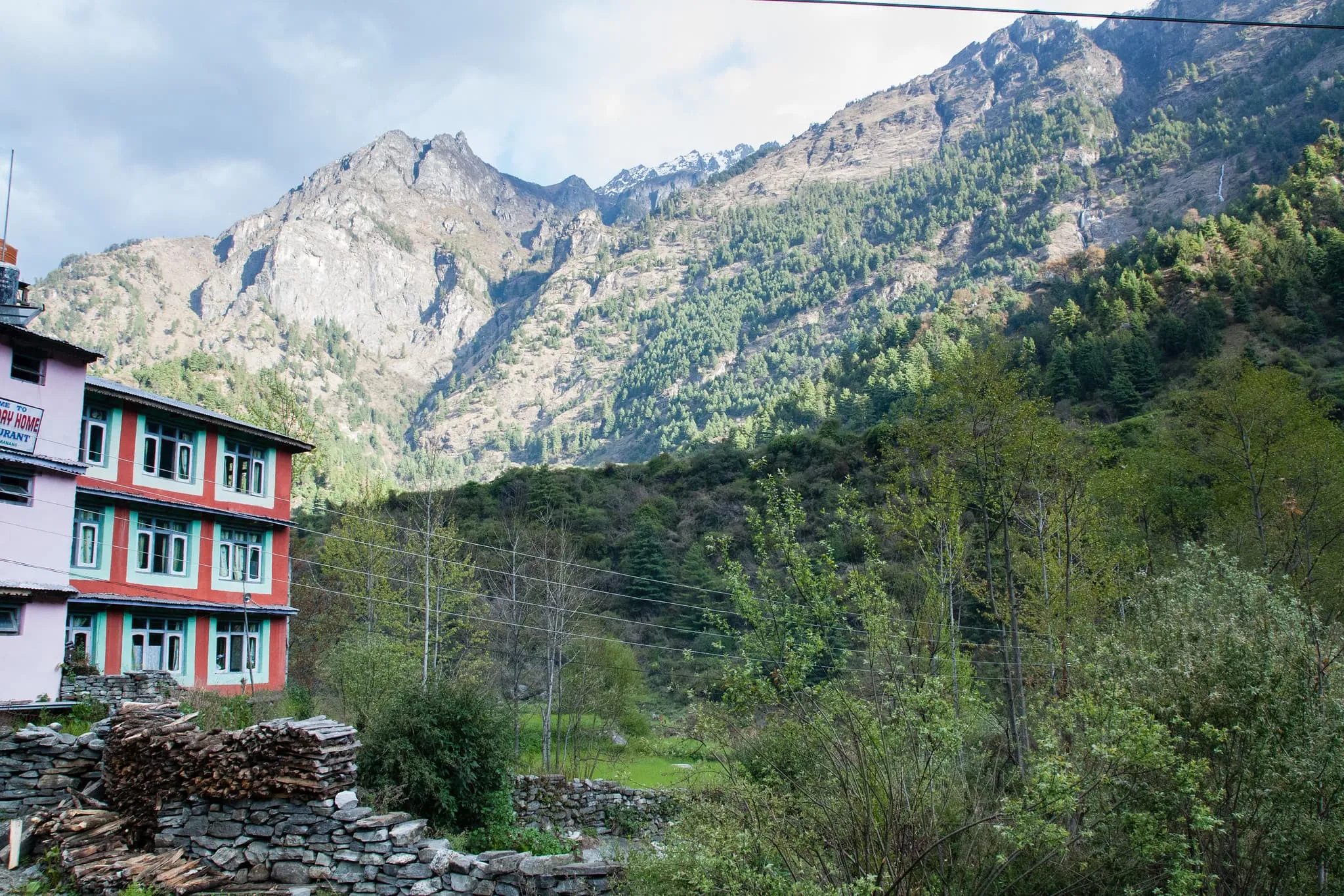
Trek to Chame
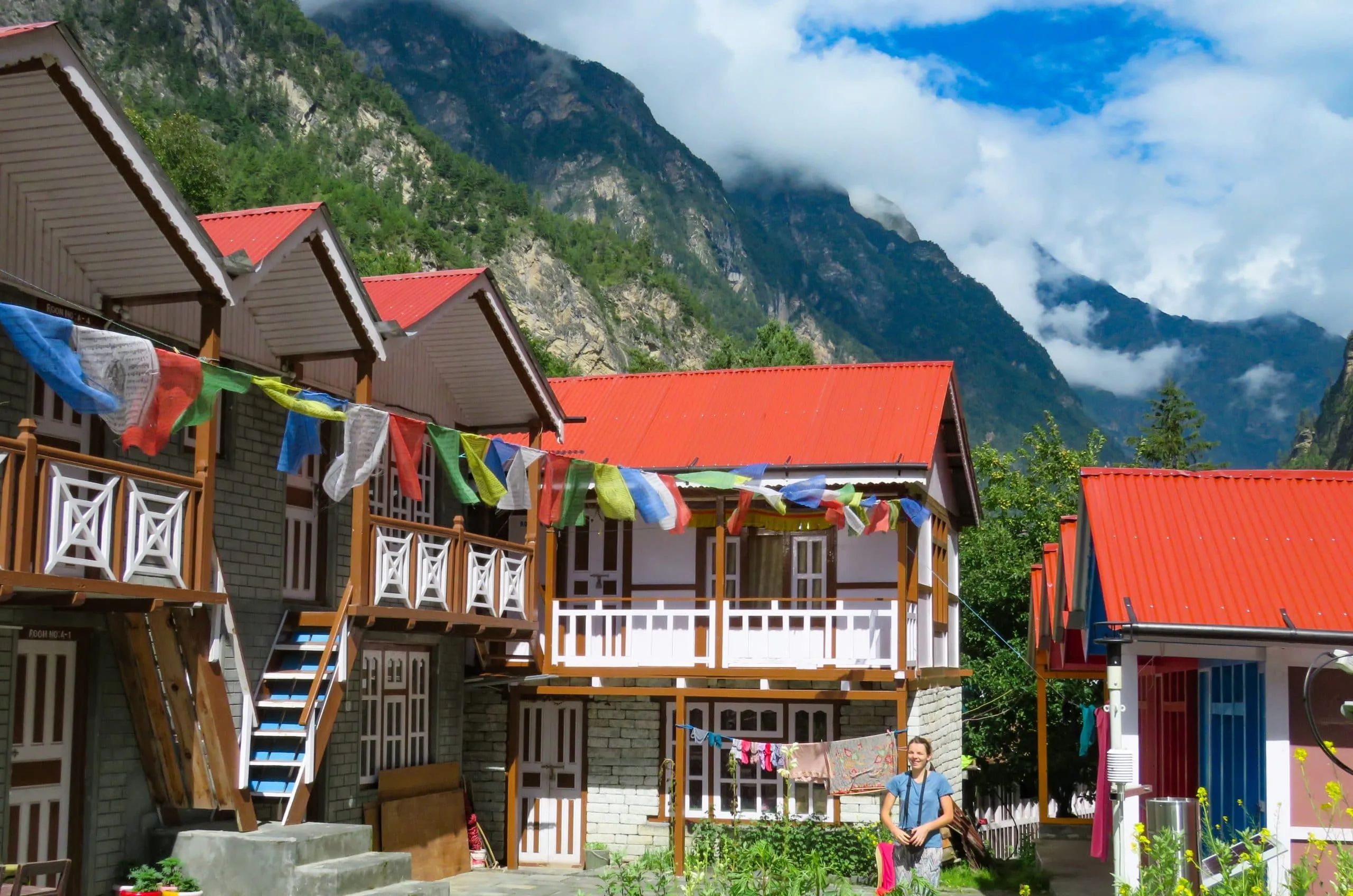
Trek to Pisang
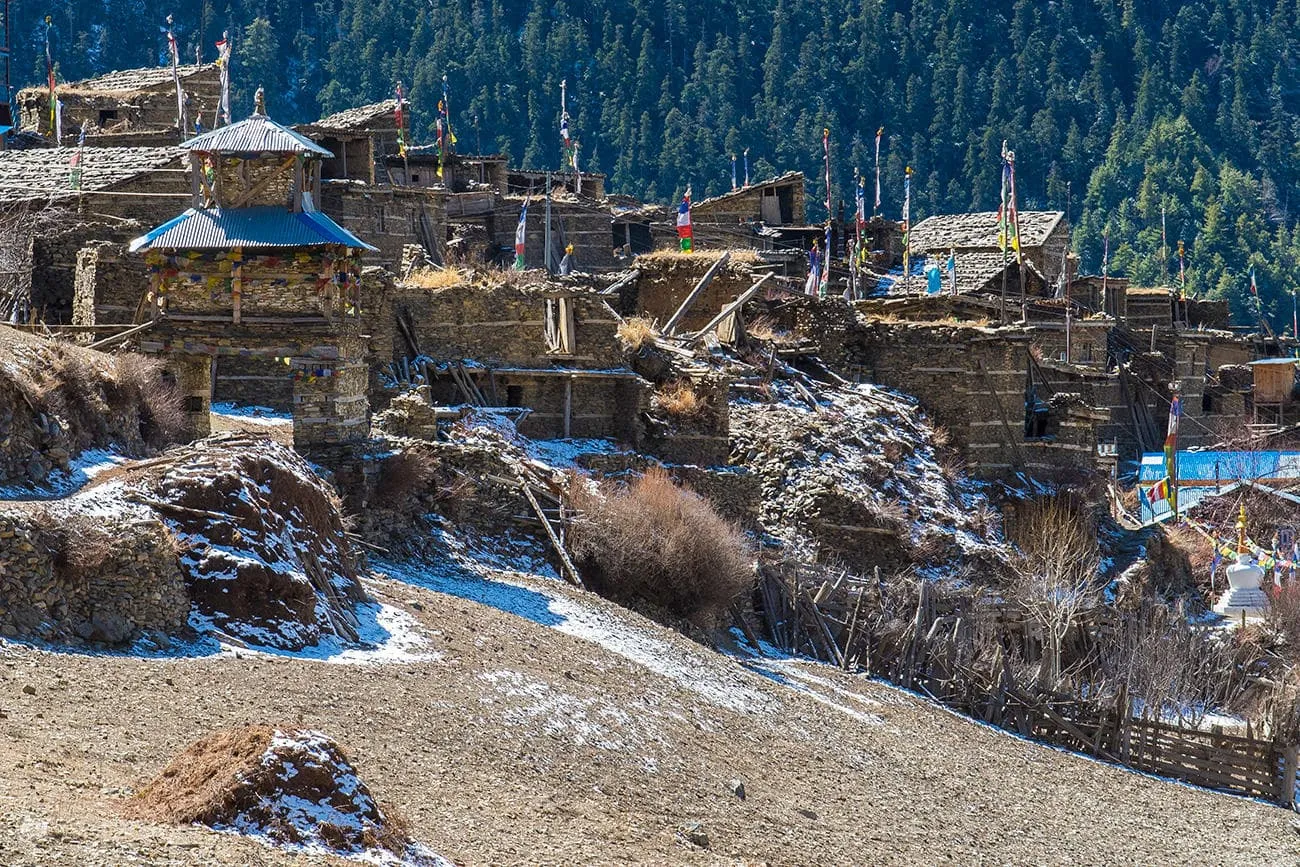
Trek to Manang
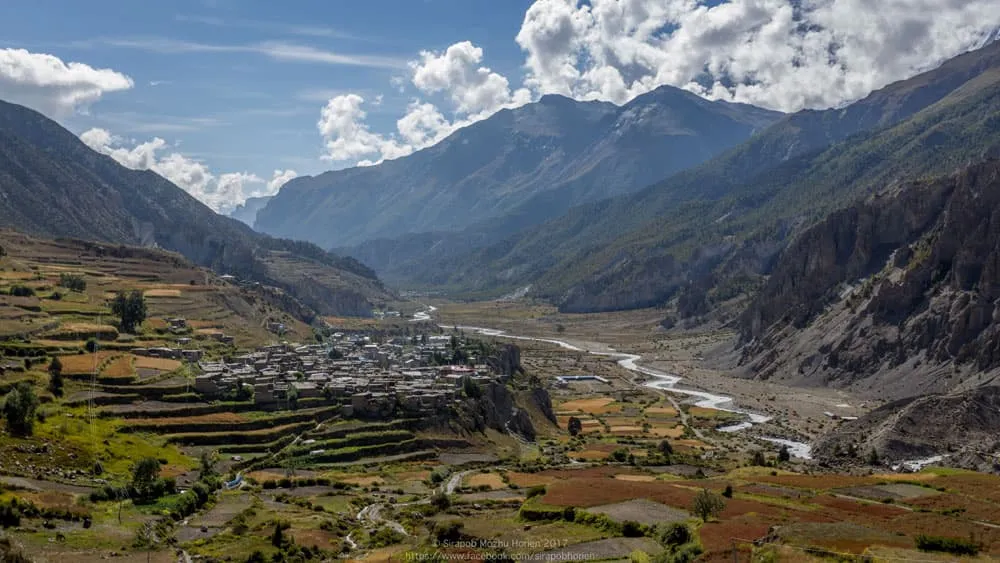
Acclimatisation in Manang
Trek to yak kharka.

Trek to Thorung Pedi
Thorung phedi.
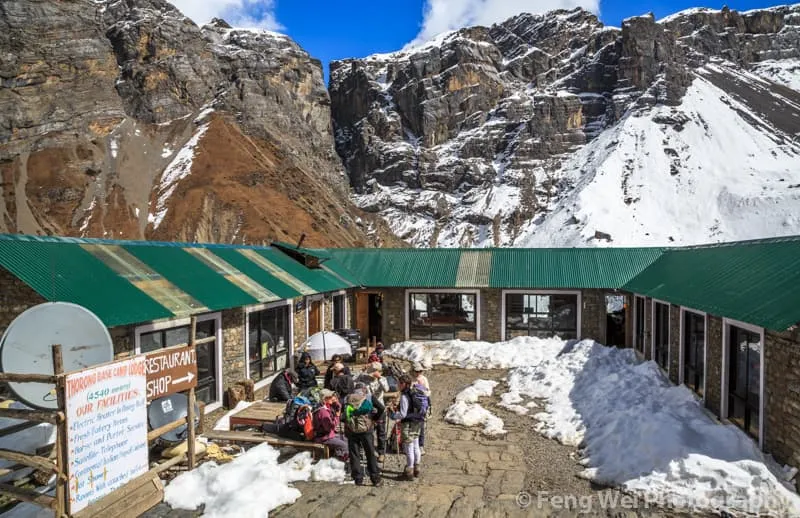
Trek to Muktinath via Thorung La Pass

Trek to Jomsom
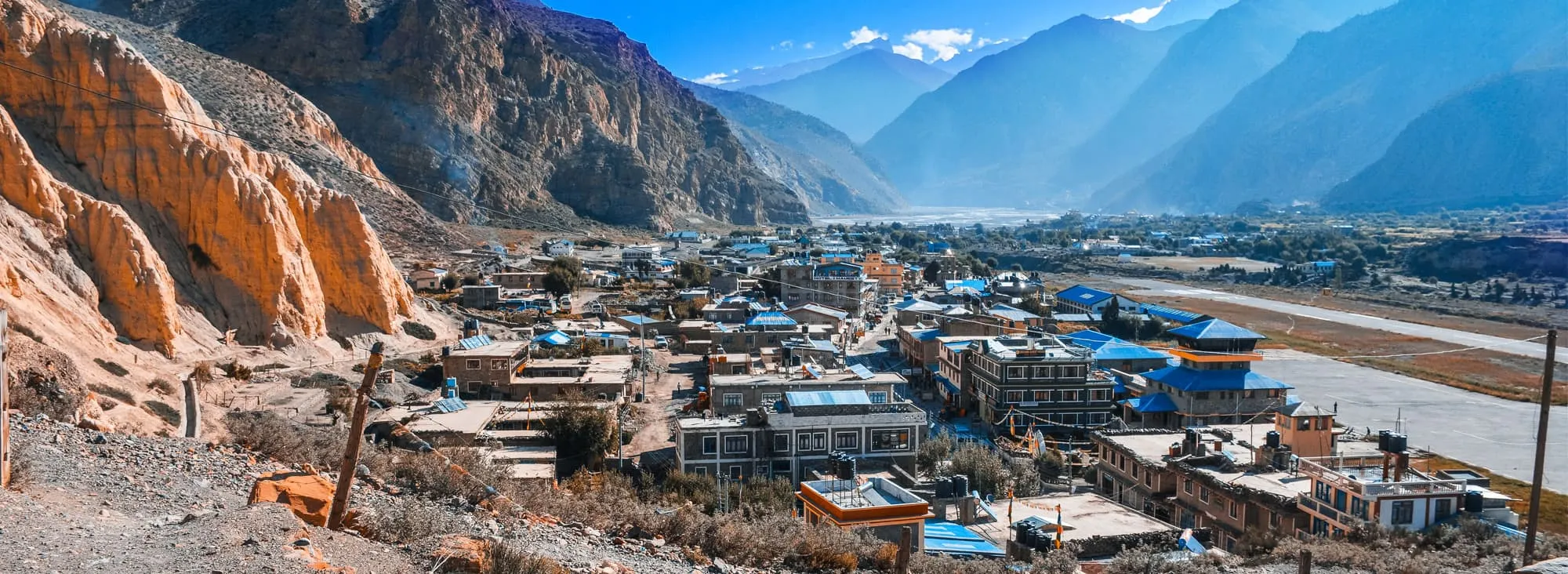
Drive to Tatopani
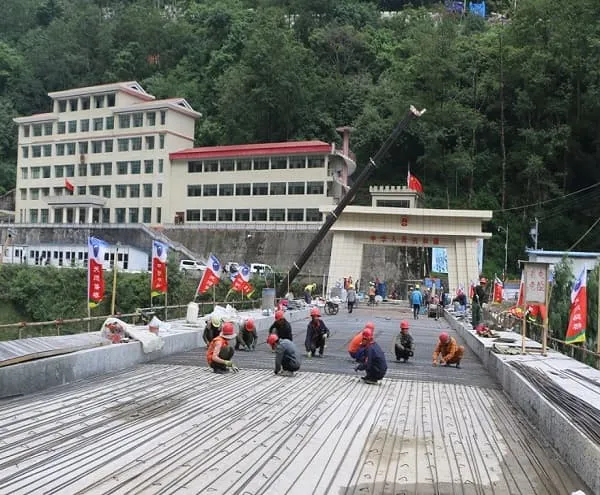
Trek to Ghorepani

Ghorepani – Poonhill – Nayapul
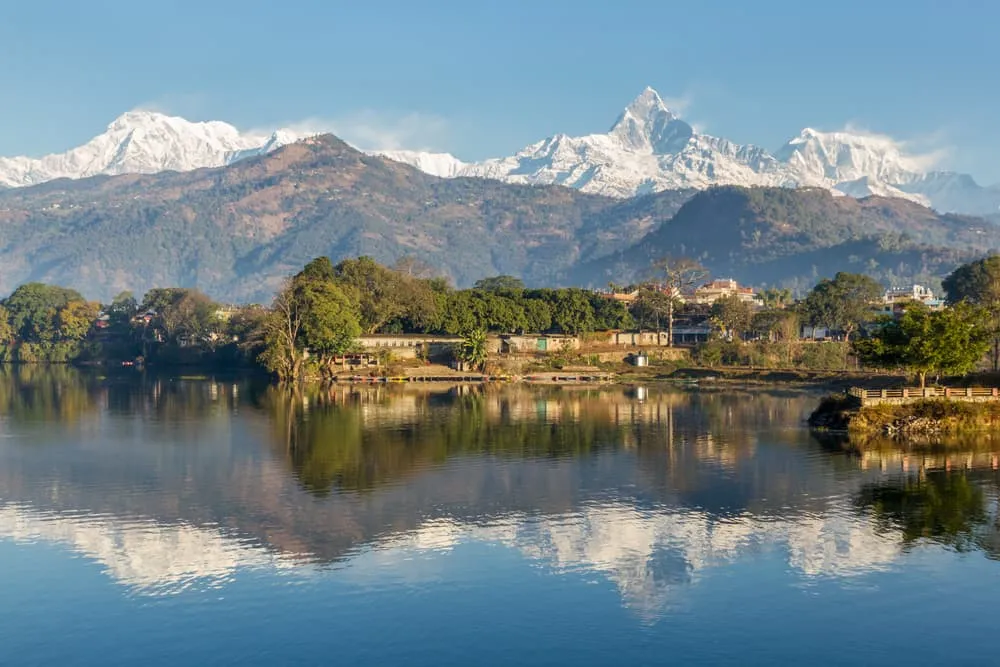
Drive from Pokhara to Kathmandu
The Thorung La is no doubt the crux of the trek. Here, the Annapurna Circuit elevation reaches its absolute max at 5416 meters above sea level. It is an old trading route and connects with Tibet. The altitude of this mountain pass is higher than any mountain in the European Alps including Mont Blanc. In height it is comparable to a big mountain like Mount Elbrus in the Russian Caucasus. Do you need to acclimatize to avoid altitude sickness ? For sure! Do you need special skills to cross the Thorung La? The answer is no. You just need to be fit!
It is a bit like scaling a mountain, but you are walking up rather than climbing. The day starts very early and you basically hit the trail before sunrise. The guides are doing the pacing to make sure you don’t head up too quickly. The path itself is not that steep, but you will feel the thin air at this altitude. From around 5000 meters we were walking on snow, with a good track carved out by the people who had gone before us. The snow really adds to the adventurous feeling of scaling a mountain pass this high. Looking back you can see all the big peaks of the Annapurnas as if you are at the same level with them and this is perhaps the most magical moment on the entire trek.
Reaching the Thorung La pass is an incredible, rewarding experience as it isn't easy. And from the top you still have a whopping 1600 vertical meters of descent to go to the village of Muktinath. Despite that, we believe that everybody with willpower, stamina and a sense of adventure can do it.

For trekking on the Annapurna Circuit, you need the following permits:
TIMS (Trekkers Information Management System):
Annapurna Conservation Area Project (ACAP) Permit
An ACAP Permit is obligatory for individuals who wish to explore the trekking routes within the Annapurna region. It is overseen by the National Trust for Nature with the primary goal of safeguarding and preserving the region's wildlife and natural environment. The funds gathered through this permit are dedicated to conservation efforts.
For each individual embarking on a single-entry trek, the cost of an ACAP Permit is Rs. 3000 (roughly USD25), regardless of the duration of the stay. These permits can be acquired in either Kathmandu or Pokhara, and there are designated checkpoints along the trail to maintain your trekking records.
Tea houses are small hotels known as Bhatti. These are small hotels and you can expect a certain level of comfort. However comfort in this high, remote region is relative. Tea houses are comfortable to the extent that you have a roof above your head and that you can enjoy warm, home-cooked meals. They are run by local families who have opened their houses to trekkers passing by.
Trekking in Nepal has become very popular in recent years, and more and more tea houses have popped up along Nepal’s trekking routes. The more popular your route, the better the quality of your tea house is. Hence, the tea houses on the Annapurna Circuit Trek are good value for money. You can expect flush toilets, hot showers and in some cases even wireless internet. The use of these amenities is usually at an additional charge.
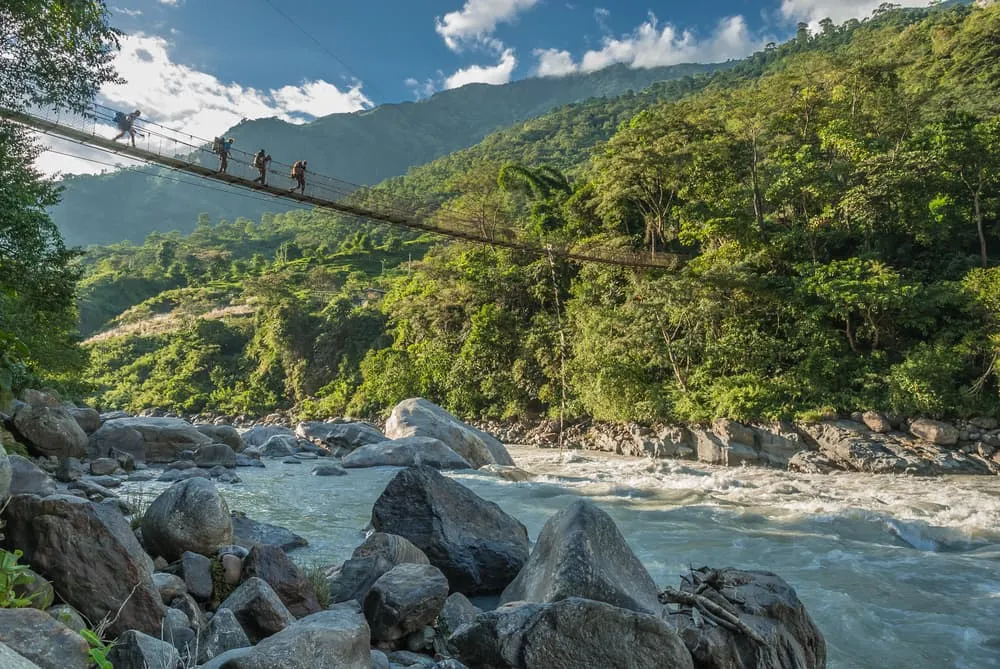
It's essential to understand that altitude sickness can affect anyone, regardless of age, fitness level, or previous high-altitude experience. These days there are several tools to monitor your health at altitude. A widely-used (analog) method is the Lake Louise score card. It ticks the altitude symptoms while keeping the severity in mind. It’s a common tool used by guides. Nowadays, most trekking and mountain guides bring a blood oxygen saturation meter, which also measures the heart rate. These are key indicators whether a person adapts to altitude well or not. AMS can occur when trekking the Annapurna Circuit Trek. Below you can find everything you need to know about altitude sickness.
Acute Mountain Sickness (AMS)
Altitude sickness, also known as Acute Mountain Sickness (AMS) is a health condition that occurs when someone is exposed to low levels of oxygen at higher altitudes. AMS is a serious condition and as the name suggests acute. It needs to be dealt with immediately, as it is potentially life-threatening. Most people will experience some mild symptoms of altitude sickness. It’s important to be aware of these symptoms and act before symptoms become more severe. Below we break down the different forms of AMS and how you can reduce the risk of getting it.
AMS symptoms
It is key to know how to identify altitude illness. You may experience the following symptoms due to the jump in altitude: headache, lack of appetite, breathing difficulties, insomnia, nausea and vomiting. The intensity and severity of these symptoms may increase with altitude and an overall feeling of fatigue will take all your joy away. This may further deteriorate to one of these life-threatening conditions.
High Altitude Pulmonary Edema (HAPE) : HAPE is a condition in which fluid accumulates in the lungs, making it difficult to breathe. Symptoms may include shortness of breath, a persistent cough, chest tightness, and an increased heart rate. It can be a life-threatening condition and requires immediate descent to lower altitudes and, in severe cases, medical treatment.
High Altitude Cerebral Edema (HACE) : HACE is a more serious condition in which fluid accumulates in the brain. Symptoms may include severe headaches, confusion, loss of coordination, and altered mental status. HACE is also a medical emergency and requires immediate descent and medical attention. Below 7 ways of minimizing the risk of AMS:
1. Gradual Ascent
One of the most effective ways to prevent AMS is to ascend gradually. When traveling to high altitudes, try to take several days to acclimatize before going higher. This allows your body to adapt to the reduced oxygen levels. All our treks in Nepal keep sufficient acclimatization into account.
2. Stay Hydrated
Dehydration can increase the risk of AMS, so drink plenty of fluids. Avoid excessive alcohol and caffeine consumption, as they can contribute to dehydration.
Consume a balanced diet with adequate carbohydrates and avoid heavy, fatty meals. Carbohydrates can help your body utilize oxygen more efficiently at high altitudes.
4. Medication
Some individuals may consider taking medication, such as acetazolamide (Diamox), to help prevent AMS. Consult with a healthcare professional before using any medication, and be aware of potential side effects.
Ensure you get enough sleep and rest during your ascent. Fatigue can increase the risk of AMS.
6. Avoid Overexertion
Pace yourself and avoid overexertion. Listen to your body, and if you experience symptoms of AMS, rest or descend to a lower altitude.
7. Descend if Symptoms Persist
If you experience symptoms of AMS, such as headache, nausea, dizziness, or difficulty breathing, it's crucial to descend to a lower altitude. Symptoms should not be ignored or dismissed.
Trekking in Nepal requires good quality and appropriate equipment. Especially the essentials like a good pair of hiking boots and breathable hardshell rain jacket. We highly recommend that you read our suggested packing list to hike the Annapurna Circuit Trek.
Technical Clothing
Accessories.
At Bookatrekking.com you can book this trek and many others. Our guided options come with experts on the ground, and offer you a convenient, stress-free, safe, and educational way to explore the outdoors. Find our offers here . Our easy-to-use platform allows you to browse and compare different trekking options and find the perfect fit for your interests, abilities, and budget.
If you have any questions about a specific trek or need help choosing the right one for you, our team of trekking experts is here to assist you. Simply reach out to us and we will be happy to provide you with personalized recommendations and advice to help you plan the trekking adventure of a lifetime.
Is this not your cup of tea and are you looking for other epic adventures? Check out one of our blog posts:
Summit climbs
- Climbing Kilimanjaro
- Climbing Triglav
- Climbing Island Peak in Nepal
- Climbing Mount Kenya
- Climbing Mount Elbrus
- Climbing Mount Kinabalu
- Climbing Toubkal
- Climbing Rinjani
- Everest Base Camp Trek
- Annapurna Circuit Trek
- Nepal Travel Guide
- Salkantay Trek
- Peru Travel Guide
Kilimanjaro
- Machame Route
- Lemosho Route
- Kili Travel Guide
Self-guided treks
- Tour du Mont Blanc
- West Highland Way
- Camino de Santiago

Also Interesting
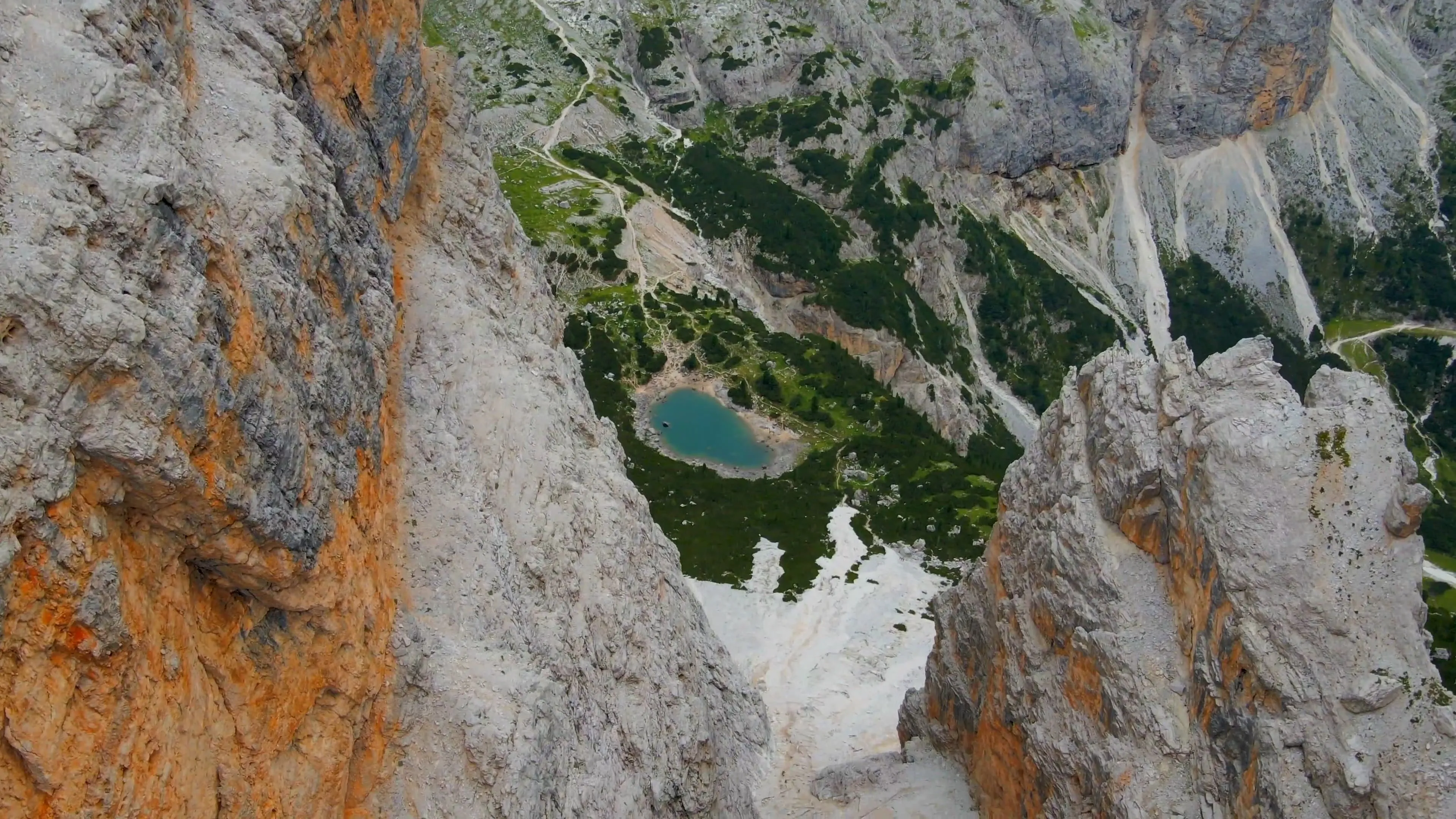
Alta Via 1: Map, Difficulty, and Route in the Italian Dolomites
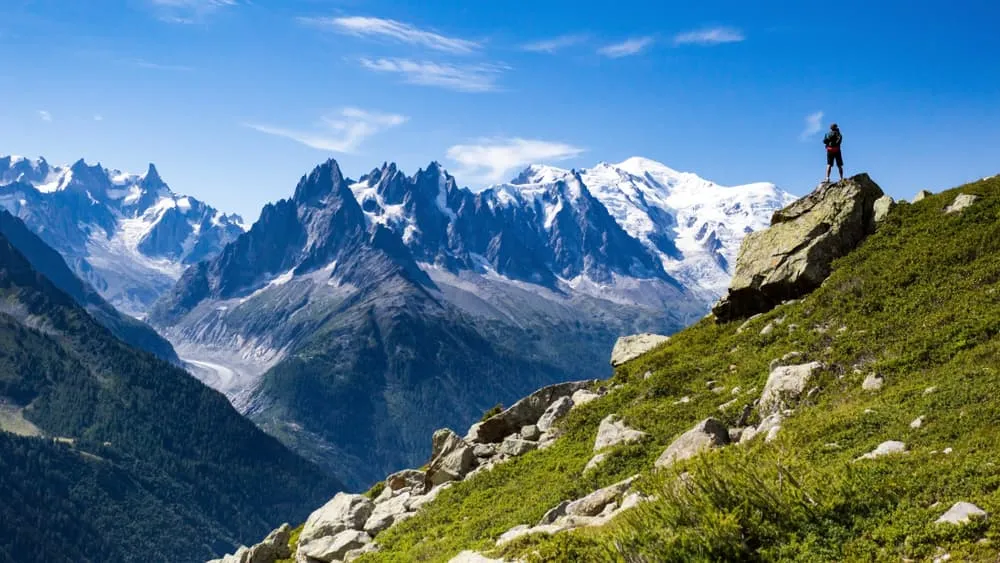
Tour du Mont Blanc Hike: All You Need To Know
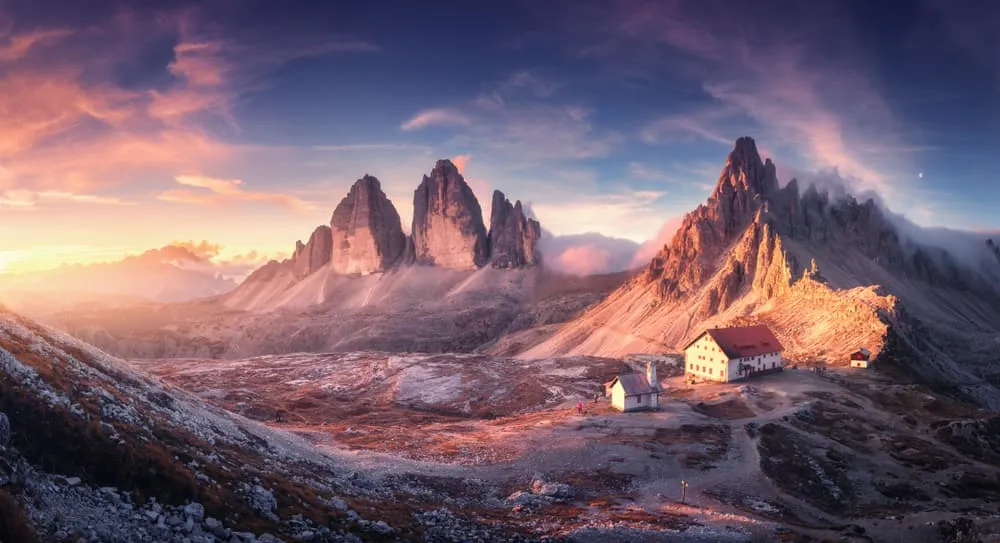
Dolomites Hiking: The 8 Best Options for Hiking Hut-to-Hut in Italy
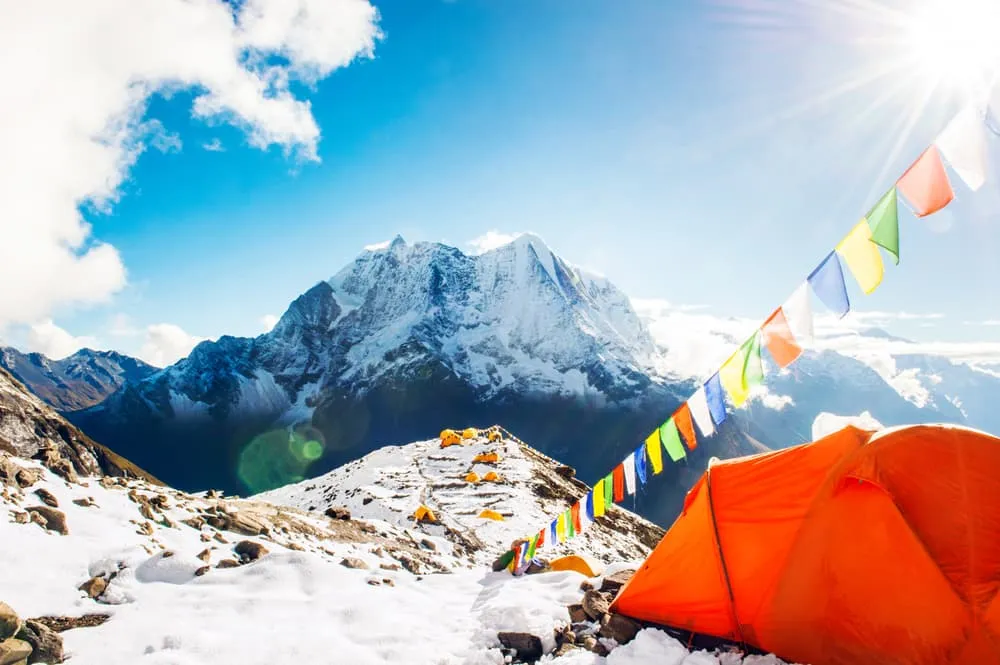
Everest Base Camp: A Trek to The Roof of The World
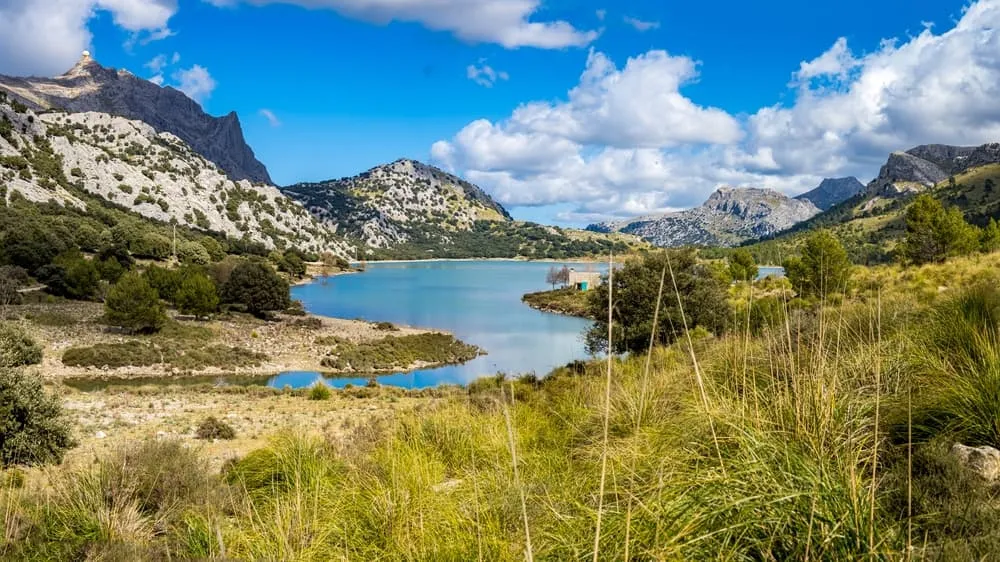
Hiking the GR221 in Mallorca: Everything You Need to Know

Hut-to-Hut Hiking in the Pyrenees: The 4 Best Walks
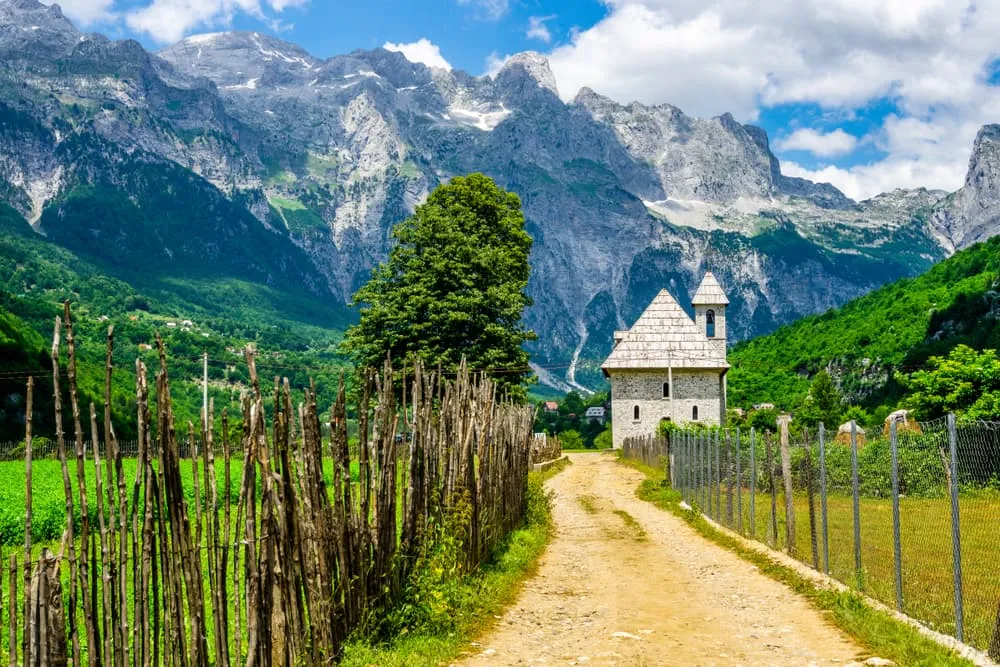
Peaks of the Balkans Trail: All You Need to Know

GR20 in Corsica: The Toughest Hut-to-Hut Trek
Get weekly inspiration with the best treks.

Best Price Guarantee – Book with Confidence!

Himalaya Discovery

Annapurna Circuit Trek 12 Days Itinerary
Since the Annapurna Circuit trek opened to travelers in 1949. This is still among the most captivating trails in the country. More than 40,000 trekkers travel to the Annapurna region each year.
The Himalayas, home to the planet’s highest peaks including Mount Everest and some of the remotest, and most rugged and tough trekking terrains in the world. This huge range of mountains covers 3 quarters of Nepal, creating it one of the best destinations for trekkers.
Numerous treks crisscross the Himalayas, however arguably the foremost popular routes are the Annapurna Circuit trek and the Mount Everest Base Camp trek both of that reach up to altitudes of over 5,000m and take an average of two weeks to complete.
16 peaks over 6,000m. Annapurna is a section of the Himalayas in north-central Nepal known for its splendid panoramas, rugged scenery and isolated mountain communities even if we will hardly reach the mid-section of Annapurna.
We’ll be weaving our trail through the rice paddies and pastures of the foothills, visiting isolated mountain communities and observing completely different ancestral customs and traditions — this guarantees to not only be a visually superb expedition but also a culturally made one.
Facts of Annapurna Circuit Trek
- Group Size: 2 – 14 People
- Trip Grade: Moderate to Demanding
- Max. Altitude (5,416m) Thorong-la pass
- Walking Duration: 4 – 6 hours
- Trip Starts: Kathmandu
- Trip Ends: Kathmandu
- Accommodation: Hotels, guesthouses
- Trip Type: Teahouses
- Trip Destinations: Kathmandu, Shange, Dharapani, Chame, Pisang, Manang Yak Kharka, Thorong Phedi, Muktinath, Jomsom, Pokhara
Outline Itinerary of 12-Day Annapurna Circuit Trek
Day 1: Arrive in Kathmandu (1400m)
- Day 2: Drive to Jagat (1300m) Approx. 8 hrs.
- Day 3: Trek to Dharapani (1,960m), Approx. 6 hrs.
- Day 4: Trek to Chame (2,710m) Approx. 5 hrs.
- Day 5: Trek to Pisang (3,300m), Approx. 5 hrs.
- Day 6: Trek to Manang (3540m), Approx. 6 hrs.
Day 7: Acclimatization day at Manang (3540m)
- Day 8: Trek to Letdar (4230m), Approx. 4 hrs.
- Day 9: Trek to Thorong Phedi (4,600m), Approx. 4 hrs.
- Day 10: Trek to Muktinath (3,800m) via Thorong La pass (5416m), Approx. 8 – 9 hrs.
- Day 11: Trek to Jomsom (2,670m), Approx. 4 hrs.
- Day 12: Drive to Kathmandu (900m) Approx. 10 – 12 hours
Detailed Itinerary of 12-Day Annapurna Circuit Trek
Your journey begins when you arrive in Kathmandu. Our representatives will welcome you at the airport and transferred to the hotel. Depending on your own will, you can rest or discover the Kathmandu. In the evening a briefing session and at the same time introduces your guide.
Day 2: Drive to Jagat (1300m) Drive duration: 7 – 8 hours
After breakfast, you will set off from Kathmandu to Jagat for a drive. Driving along the winding road through villages along the Trishuli River, you will enjoy the lovely view of hills and forests.
You will pass the popular village of Besisahar and further ahead until Jagat, your night destination.
Day 3: Trek to Dharapani (1,960m) Walking Duration: 5 – 6 hours.
This is the day our trek begins. After breakfast, you take a downhill path through lush green forests. On this day you pass villages such as Chyamje, Sattale, Tal and Karte.
Suspension bridges and route carved in the rocky cliffs add an exciting aspect to the walk. On the first day of the journey the mountains come to sight Overall it is an easy walk. You stop at Dharapani for the night.
Day 4: Trek to Chame (2,710m) Walking Duration: 5 hours.
On this day, on your way to Chame, you’ll trek through some forest ridges. The trail is mostly flat and easy.
You’ll be accompanied by a view of peaks like Lamjung Himal, Annapurna II and Annapurna IV. You’ll come across a hot spring on your way.
Your overnight night destination is Chame. Chame is district headquarters of Manang. You will see shops where you can prepare for the trek in the last minute. It’s also an administrative centre. At Chame overnight
Day 5: Trek to Pisang (3,300m) Walking Duration: 4 – 5 hours.
This is the day when trek landscapes drastically change. You continue by walking along the Marsyangdi River in the dense forests.
The forest becomes thinner as you continue trekking. After crossing the altitude mark of 3,000 meters, the landscapes turns into a trans-Himalayan desert, with only a few alpine shrubs.
You can either go trekking via Upper Pisang or Lower Pisang. The Upper Pisang trail is comparatively steeper but the scenery is surreal. Lower Pisang way is easier. Choose one that best fits you. At Pisang overnight.
Day 6: Trek to Manang (3540m) Walking Duration: 5 – 6 hours.
You can trek through the old village of Ngawal to Manang from Lower or Upper Pisang. Peaks like Annapurna, Gangapurna, and Tilicho are visible nearly all along the route. Unique rock formations with a thin forest of pine trees make up a magnificent scenery.
You will meet a monastery in Braga which is 400 years old. For the locals this monastery has historic symbolic importance. The architecture is amazing itself. You continue further ahead till you reach the beautiful Manang village. At Manang overnight.
Manang is without doubt one of the best acclimatization places. It offers spectacular views over the peaks of Annapurna and Gangapurna. Gangapurna Lake is another gem that is only a 10-minute walk from the village.
Visiting nearby monasteries gives you a glimpse of local culture and tradition. You have the option to go on side trips like Ice Lake and Milerapa Cave, perfect in Manang for a day-hike. No matter what you do, do not sleep in the daytime. That’s not good for acclimatization.
Here the hotels provide basic services and the untouched natural scenery in the backdrop makes Manang a great acclimatizing spot. At Manang Overnight
Day 8: Trek to Yak Kharka / Ledar (4230m) Walking Duration: 4 hours.
This day’s trek is mostly through the rocky landscape, with just a few pastures and juniper shrubs. The route continuously ascends and descends across Jharsang Khola streams.
You also cross the wooden and suspension bridges along the way, passing through villages such as Tenki and Ghunasa. At Yak Kharka / Ledar overnight.
Day 9: Trek to Thorong Phedi (4,600m) Walking Duration: 4 hours.
The Thorong Phedi trek is an uphill ascent. Giant rock formations give the landscape an incredible looks. Snow-capped Rocky mountains mixed with different-color textured drylands make for beautiful scenery.
Specific parts are landslide prone. Be careful walking along those trails. You’ll see one of the best views of Mt. Gundang, Mt. Syagang, Thorong Peak and Mt. Khatungkan upon reaching Thorong Phedi. Stop for day at Thorong Phedi and enjoy a night.
Day 10: Trek to Muktinath (3,800m) via Thorong La pass (5416m), Walking Duration: 8 – 9 hours.
This is the most challenging and exciting day of the trek. You begin your preparation for the final ascent of Thorong La Pass at around 3 in the night. It gets windy during the day so the right choice is to start the ascend early in the morning. It’s a steep 3-4 hour climb until you reach the breathtaking Thorong La Pass vantage point.
From this point the sunrise is something that you’ll remember for a lifetime. Thorong La is two hours of steep climb b Since after midday it gets windy, we start our trek at around 3 am. Walking on an uphill trail for 2 hours, we reach 4900 m to the High Camp.
A few more hours from here will finally take us to the stunning Thorong La Pass vantage point.
From this point, sunrise experience is a once-in – a-lifetime experience. Seeing the first sun’s rays hit the Annapurna and Gangapurna is a dreamlike, surreal experience. Reaching Thorong La Pass gives you a sense of success and happiness. Prayer flags and mani-stones mark Thorong La Pass highest point.
After enjoying the view, you descend straight down to the Temple of Muktinath, an important Hindus pilgrimage site. The temple also holds utmost importance among the community of Buddhists.
You finish your trek, by driving to Jomsom and spending the night in a comfortable guesthouse.
Day 11: Trek to Jomsom (2,670m) Walking Duration: 4 hours.
After Muktinath you head down to the Kaligandaki valley for a steep descent. From here you walk on to Jomsom. The trail is an easy one.
Jomsom is Mustang’s headquarter. Exploring the valley, you move to the picturesque Marpha village Well-decorated homes, narrow streets and the apple wine are what makes Marpha popular. At Jomsom overnight.
Day 12: Drive to Kathmandu via Pokhara (1400m) Drive Duration: 10 – 12 hours.
Even if you plan to fly, you may end up needing to go by road if flights are canceled. The road between Beni and Muktinath was only constructed a few years ago, and it’s mostly off-road track, and (halfway) from Beni to Pokhara is paved. The journey takes about 6 to 7 hours, and then another 6 from Pokhara to Kathmandu.
It might takes longer if there are accidents or landslides en route during monsoon season. We Himalaya Discovery suggest you to change Hiace bus from Pokhara to Kathmandu for more comfortable ride.
Today you can either stay back and enjoy a free day in Kathmandu or leave for your respective countries. Our representatives will drop you off at the airport according to your flight schedule.
Best Time to Trek Annapurna Circuit Trek
The best time to trek the Annapurna Circuit is between March and May, and from September to December. From March to May, the Annapurna Circuit routes are covered with colorful blooming rhododendrons, and a variety of beautiful bird species can be spotted.
March through May and September to November are the best time to do the Annapurna Circuit Trek.
Annapurna Circuit Map – New Route

Annapurna Circuit Trek 12 Days – Requirements and Permits
A permit (ACAP: Annapurna Conservation Area Project) and Trekkers’ Information Management System (TIMS) card are required to enter the Annapurna area and trek to Annapurna Circuit. If you’re on a guided trip, the guide company will take care of getting the permit and TIMS card for you.
You can get your TIMS card on your own at offices of the Nepal Tourism Board in Kathmandu or at the national park entrance that you will pass through during your trek. Bring a high-quality photocopy of your passport and 2 passport photos.
Preventing Altitude Sickness
It’s important for anyone planning on attempting the Annapurna Circuit trek , or other high-altitude treks like Everest Base Camp, to know how to reduce and cope with the symptoms of altitude sickness. Before you go, learn the best ways to beat altitude sickness and stay healthy overall at high elevation.
- Climb slowly, give yourself time to acclimate to the elevation.
- Avoid alcohol
- Take rest days.
- Symptoms: headaches, sleeplessness, and nausea usually decrease in a day or two.
- Drink plenty of water and avoid alcohol.
- Eat a lot. Trekking burns a lot of calories.
- Keep your pace slow.
- If your symptoms fail to improve or worsen, descend.
Accommodations and Facilities
Tea houses are a great option and are an industry gaining rapid popularity right now. These are houses that are facilitated according to the local culture. This is a popular option and are designed to make you feel right at home with the hint of the local culture. What a great way to experience comfort.
Accommodations Tips during the Annapurna Circuit Trek
- Choose a guesthouse before 3 p.m. to beat large guided groups to the nicest guesthouses.
- Choose a smaller one for better meal service.
- Take a shower immediately after arriving because most hot water is solar power heated).
- Order breakfast before going to bed to speed your morning departure.
How Much Does the Annapurna Circuit Trek Cost?
The Annapurna Circuit trek cost range per person from USD 800 up to USD 1200 for an average 10 – 14 day trek.
Cost Includes : Transportations from and to Kathmandu, trek permits, accommodations, meals, but costs do not include: insurance, visa, personal equipment, drinks.
The advantage of booking a package trip to the Annapurna Circuit is that everything is taken care of for you. Accommodation will be booked, meals will be paid for and arranged. You should get to meet your guide before the trip.

Getting There
The Annapurna Circuit starts at Besisahar but the trek starts from Jagat. If you are planning to take a public bus, then you can catch a bus at Gonggabu bus park. (busses are big tourist type to slightly more comfortable “micro” busses).
Annapurna Circuit Trek 12 days is considered to be one of the best treks in the world. Experiencing some of the most beautiful Himalayan mountain scenery of Nepal. And if you have questions or anything in mind please contact us .
Do you have any question about trip to Nepal?
- Solo Traveller
- Number of child (if you have child in your family/group) (Optional)
- When will you be traveling?* * Day 1 2 3 4 5 6 7 8 9 10 11 12 13 14 15 16 17 18 19 20 21 22 23 24 25 26 27 28 29 30 31 Month 1 2 3 4 5 6 7 8 9 10 11 12 Year 2025 2024 2023 2022 2021 2020 2019 2018 2017 2016 2015 2014 2013 2012 2011 2010 2009 2008 2007 2006 2005 2004 2003 2002 2001 2000 1999 1998 1997 1996 1995 1994 1993 1992 1991 1990 1989 1988 1987 1986 1985 1984 1983 1982 1981 1980 1979 1978 1977 1976 1975 1974 1973 1972 1971 1970 1969 1968 1967 1966 1965 1964 1963 1962 1961 1960 1959 1958 1957 1956 1955 1954 1953 1952 1951 1950 1949 1948 1947 1946 1945 1944 1943 1942 1941 1940 1939 1938 1937 1936 1935 1934 1933 1932 1931 1930 1929 1928 1927 1926 1925 1924 1923 1922 1921 1920
- How many days do you have?* *
- Give your trip a short title* *
- Private Trip
- Bellow 200$
- 200$ - 500$
- 500$ - 800$
- 800$ - 1200$
- 1200$- 2000$
- 2000$ and above
- Describe your trip* *
- Full Name* *
- Your Email* *
- Country* * Afghanistan Albania Algeria American Samoa Andorra Angola Anguilla Antarctica Antigua and Barbuda Argentina Armenia Aruba Australia Austria Azerbaijan Bahamas Bahrain Bangladesh Barbados Belarus Belgium Belize Benin Bermuda Bhutan Bolivia Bonaire, Sint Eustatius and Saba Bosnia and Herzegovina Botswana Bouvet Island Brazil British Indian Ocean Territory Brunei Darussalam Bulgaria Burkina Faso Burundi Cabo Verde Cambodia Cameroon Canada Cayman Islands Central African Republic Chad Chile China Christmas Island Cocos Islands Colombia Comoros Congo Congo, Democratic Republic of the Cook Islands Costa Rica Croatia Cuba Curaçao Cyprus Czechia Côte d'Ivoire Denmark Djibouti Dominica Dominican Republic Ecuador Egypt El Salvador Equatorial Guinea Eritrea Estonia Eswatini Ethiopia Falkland Islands Faroe Islands Fiji Finland France French Guiana French Polynesia French Southern Territories Gabon Gambia Georgia Germany Ghana Gibraltar Greece Greenland Grenada Guadeloupe Guam Guatemala Guernsey Guinea Guinea-Bissau Guyana Haiti Heard Island and McDonald Islands Holy See Honduras Hong Kong Hungary Iceland India Indonesia Iran Iraq Ireland Isle of Man Israel Italy Jamaica Japan Jersey Jordan Kazakhstan Kenya Kiribati Korea, Democratic People's Republic of Korea, Republic of Kuwait Kyrgyzstan Lao People's Democratic Republic Latvia Lebanon Lesotho Liberia Libya Liechtenstein Lithuania Luxembourg Macao Madagascar Malawi Malaysia Maldives Mali Malta Marshall Islands Martinique Mauritania Mauritius Mayotte Mexico Micronesia Moldova Monaco Mongolia Montenegro Montserrat Morocco Mozambique Myanmar Namibia Nauru Nepal Netherlands New Caledonia New Zealand Nicaragua Niger Nigeria Niue Norfolk Island North Macedonia Northern Mariana Islands Norway Oman Pakistan Palau Palestine, State of Panama Papua New Guinea Paraguay Peru Philippines Pitcairn Poland Portugal Puerto Rico Qatar Romania Russian Federation Rwanda Réunion Saint Barthélemy Saint Helena, Ascension and Tristan da Cunha Saint Kitts and Nevis Saint Lucia Saint Martin Saint Pierre and Miquelon Saint Vincent and the Grenadines Samoa San Marino Sao Tome and Principe Saudi Arabia Senegal Serbia Seychelles Sierra Leone Singapore Sint Maarten Slovakia Slovenia Solomon Islands Somalia South Africa South Georgia and the South Sandwich Islands South Sudan Spain Sri Lanka Sudan Suriname Svalbard and Jan Mayen Sweden Switzerland Syria Arab Republic Taiwan Tajikistan Tanzania, the United Republic of Thailand Timor-Leste Togo Tokelau Tonga Trinidad and Tobago Tunisia Turkmenistan Turks and Caicos Islands Tuvalu Türkiye US Minor Outlying Islands Uganda Ukraine United Arab Emirates United Kingdom United States Uruguay Uzbekistan Vanuatu Venezuela Viet Nam Virgin Islands, British Virgin Islands, U.S. Wallis and Futuna Western Sahara Yemen Zambia Zimbabwe Åland Islands Country
- Phone Number (Optional)
Recommended Articles

Upper Mustang Trek Cost

Best Time to Trek Annapurna Base Camp

A Guide to Annapurna Base Camp Elevation

Annapurna Base Camp Trek Packing List

“ I was born and raised in Nepal, nearby Everest region. I am proud to be a native Sherpa, and I have been a Mountain guide over a decade now. Following my passion, I decided to start helping travelers with their travel plans! I think life is a journey, a trip where you collect experiences when you share with other people and with nature. “

Trip Designer
→ PLAN YOUR TRIP – FREE

Privacy Overview

- Best Hikes In The World
- Appalachian Trail
- European Hikes
- Nepal Hikes
- Patagonia Hikes
- See All Hikes
- Mount Kenya
- Mount Kilimanjaro
- Mount Toubkal
- See All Mountains
- South Africa
- New Zealand
- Switzerland
- United Kingdom
- Packing Lists
Annapurna Circuit – Nepal’s Classic Circuit Trek
Asia , Hikes , Nepal
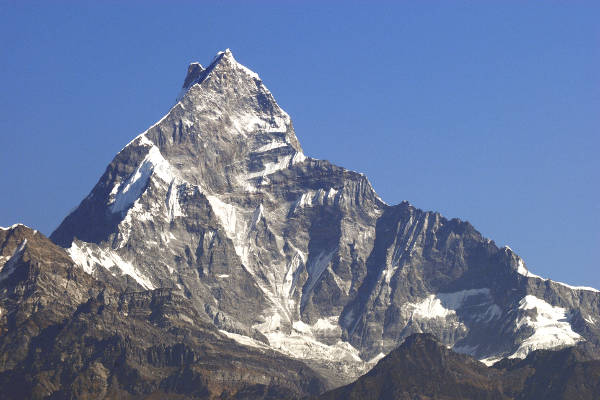
The Annapurna Circuit is one of the most popular and most epic treks in Nepal . This classic trek meanders through Himalayan foothills and over high passes, offering picturesque mountain views along the way.
Annapurna Circuit Trek
Route overview.
The Annapurna Circuit is one of the greatest treks in Nepal, if not the world.
Although road construction over the past two decades has severely impacted the trekking experience (more on this later).
Note: if you are a mountain biker, the road on the western side makes for one of the most exhilarating and scenic mountain biking experiences!
Where Does The Annapurna Circuit Start and End?
The trek begins at Besisahar (which is a 7-8 hour drive from Kathmandu) and concludes in the Kali Gandaki Gorge – the disputed highest gorge in the world that separates Dhaulagiri (8,176 meters) in the West and Annapurna (8,091 meters) in the East.
The circuit is traditionally followed on an anti-clockwise trail – for acclimatization reasons – that circumvents the Annapurna Massif. It takes trekkers through the Annapurna, Manang and Mustang region of central Nepal.
Route Details
At its pinnacle, the trek crosses the Thorung La Pass (5,416 meters) before descending down to the town of Muktinath. From here the road construction activities (2004 -2008/09) have had a measurable impact on the Annapurna Circuit trekking experience.
The Nepalese government have realized that the road on both the Western (Pokhara-Muktinath) and Eastern (Chame-Manang) side of the circuit has had a negative impact on trekking tourism. Thus, they have created a number of New Annapurna Trekking Trails (called NATT-trails).
These NATT-trails, marked blue and white or red and white, take trekkers away from the dusty and unpleasant roads. The alternative routes provide a much more pleasant trekking experience.
How Long Is The Annapurna Circuit?
The Annapurna circuit typically takes between 16-20 days to complete. This is depending if you decide to tack on a diversion to Annapurna Base Camp and the Annapurna Sanctuary ). It covers between 150-240 km depending on when you decide to end the tour or use transportation vehicles.
Scenery and Landscape
The scenery on the Annapurna Circuit is extraordinarily beautiful. Trekkers pass through rice terraced paddy fields, subtropical forests, and glacial environments.
You will see a number of major mountains including the Annapurna Massif (I-IV), three 8,000 metre peaks – Dhaulagiri (8,176 meters), Manaslu (8,156 meters) and Annapurna I (8,091 meters). There are numerous other peaks of 6,000 to 7,000 meters.
Please Note: The Annapurna Circuit is situated in the Annapurna and Mustang regions of central Nepal. It is home to the Annapurna Massif. The schematic below illustrates Nepal’s trekking regions (not to scale).
Annapurna Regional Map
The Annapurna Circuit is situated in the Annapurna and Mustang regions of central Nepal. It is home to the Annapurna Massif. The schematic illustrates Nepal’s trekking regions (not to scale)
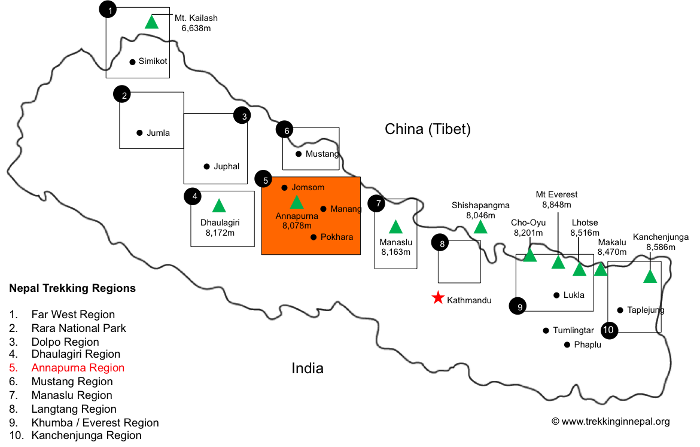
Annapurna Trek Altitude Profile
The schematic diagram below shows the route altitude profile for the Annapurna Circuit.

Annapurna Circuit Itinerary
Below is a detailed Annapurna Circuit itinerary. Where possible we have highlighted the NATT-Trails that can be used to avoid the road. Please note that this is a typical Annapurna Circuit itinerary. Some tour operators offer variations on this route.
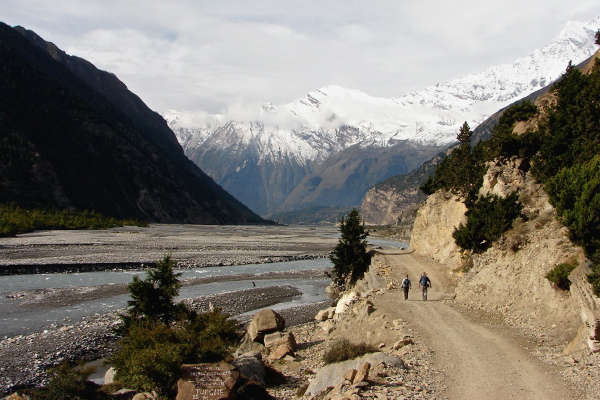
Day 1-2: Arrive Kathmandu (Drive to Besisahar / Fly to Pokhara)
Arrive in Kathmandu, usually spend a day sightseeing in the capital city.
See more in our guide on what to do in Kathmandu .
Drive from Kathmandu (1,300 meters) to Besisahar / Khudi (circa 800 meters) via bus. The trip takes between 7 and 8 hours, meandering through countryside villages.
The Annapurna Circuit typically starts at Besisahar, an hour’s trek from Khudi. Some operators may drive you to Khudi and commence the trek from there.
Day 3: Trek from Besisahar (820 meters) to Khudi and onto Bahundanda (1,310 meters)
Trek from Besisahar (820 meters) to Khudi and onto Bahundanda (1,310 meters). This traditional route has been impacted by the road construction so some operators have started using new trails that bypass the road. Instead, you go to the village of Sikrung (2,200 meters).
The latter is a fairly steep climb to a rather high altitude. But it does offer a more untainted Annapurna trekking experience. Expect to trek between 6-7 hours.
Day 4: Trek from Bahundanda (1,310 meters) / or Sirung (2,200 meters) to Jagat (1,300 meters) or potentially Chamje (1,410 meters)
Trek from Bahundanda (1,310 meters) / or Sirung (2,200 meters) to Jagat (1,300 meters) or potentially Chamje (1,410 meters). If on day 4 you followed the traditional route to Bahundanda, you will trek to Ghermu (1,130 meters) and onto Jagat. You might stay the night here or take a steep hour-long trek up to Chamje (1,410 meters).
We recommend staying the night at Chamje instead of Jagat, which is a dirty and crowded village. If on day 4 you stopped at Sikrung, you will likely follow a route via Syange (1,100 meters) to Jagat and up to Chamje.
Expect to see great rice terraced landscapes and views of the Manaslu Range during early stages of this day’s trekking.
Day 5: Trek from Jagat / Chamje (1,300 / 1,410 meters) to Dharapani (1,960 meters)
Trek from Jagat / Chamje (1,300 / 1,410 meters) to Dharapani (1,960 meters). Continuing north into the Manang region, you will trek through agricultural fields of corn and potatoes and then forests of rhododendrons.
Eventually reach the quaint village of Tal (1,700 meters). From Tal you will trek for another 6 kms (circa 3 hours) via Karte to the village of Dharapani (1,960 meters).
Day 6: Trek from Dharapani (1,960 meters) to Chame (2,710 meters) via Bagarchap and Danakyu, and then either along the lower trail or upper trail to Koto (2,640 meters)
Trek from Dharapani (1,960 meters) to Chame (2,710 meters) via Bagarchap and Danakyu, and then either along the lower trail or upper trail to Koto (2,640 meters).
From Koto you trek a further hour to the busy village of Chame. Some trekkers and operators prefer an overnight stay in the quieter village of Koto. On this rather steep trekking day you will get some great views of Annapurna II and IV, as well as Lamjung Himal.
Day 7: Trek from Chame (2,710 meters) to Pisang via Bhratang (2,850 meters) and Dhukur Pokhari (3,240 meters)
Trek from Chame (2,710 meters) to Pisang via Bhratang (2,850 meters) and Dhukur Pokhari (3,240 meters). From Dhukur Pokhari the trail splits and you may either trek to Upper Pisang (3,310 meters) or to Lower Pisang (3,250 meters) for an overnight stay.
If you take the latter to Lower Pisang we highly recommend re-joining the upper trail on day 8. This provides arguably the best views of the whole Annapurna Circuit.
Day 8: Trek using the upper trail from Pisang (3,310 meters) to Manang (3,450 meters) via Ghyaru (3,730 meters), Ngawal (3,680 meters), Humde (3,330 meters and Bhraga (3,450 meters)
Trek using the upper trail from Pisang (3,310 meters) to Manang (3,450 meters) via Ghyaru (3,730 meters), Ngawal (3,680 meters), Humde (3,330 meters and Bhraga (3,450 meters).
The mountain views on this portion of the Circuit are exceptional, as are the quaint villages along the trail. A visit to Barge monastery is worthwhile before the final stretch to Manang.
Day 9: Acclimatization day in Manang
Manang is one of the main towns on the Circuit. Many trekkers take this opportunity to spend a rest acclimatization day in the town.
Short excursions to the Gangapurna Lake and Bhojo Gompa (a Buddhist ecclesiastical fortification of learning) are common among trekkers. There are also day trips around the town. You might want to consider visiting the offices of the Himalayan Rescue Association for a talk on high altitude risks.
Day 10: Trek from Manang northwest out of the Marshyangdi Valley and up to the small village of Yak Kharka (4,110 meters)
Trek from Manang northwest out of the Marshyangdi Valley and up to the small village of Yak Kharka (4,110 meters). If you haven’t started feeling the effects of altitude yet, you might start doing so from today. Some trekkers continue onto the tiny village of Letdar (4,200 meters). Teahouse accommodation is limited in both these villages.
Day 11: Trek from Yak Kharka (4,110 meters) to High Camp (4,850 meters)
Trek from Yak Kharka (4,110 meters) to High Camp (4,850 meters). This is a fairly tough and steep day. Some tour operators will stop for the night at Thorang Phendi (4,450 meters). This is a good idea if trekkers are struggling with the altitude.
However, continuing on to High Camp is, in our opinion, preferable. This is because it makes the next day’s treks to Muktinath (3,800 meters) a lot shorter and easier. Accommodation facilities and amenities in Thorang Phendi and High Camp are both good. Please note: continuing onto High Camp means sleeping at high altitude, which is not advised if you are suffering from acute mountain sickness (AMS) symptoms .
Day 12: Trek from High Camp (4,850 meters) across the Thorung Pass (the highest point on the trek at 5,416 meters) and then back down to Muktinath (3,800 meters) via Charabu (4,230 meters)
Trek from High Camp (4,850 meters) across the Thorung Pass (the highest point on the trek at 5,416 meters). You then go back down to Muktinath (3,800 meters) via Charabu (4,230 meters). Prepare for a tough, icy-cold day of trekking. The descent from Thorung Pass is steep and trekking poles come in handy. Muktinath, although an important pilgrimage site for both Hindu’s (see the Vishnu Temple) and Buddhists (see the Monastery), is a rather characterless village. Depending on your operator, you will likely stay overnight in Muktinath. For independent trekkers, the Bob Marley Guesthouse in the center of town is a great shout!
Day 13: Trek from Muktinath (3,800 meters) to Marpha (2,665 meters) via the awesome village of Kagbeni (2,800 meters)
Trek from Muktinath (3,800 meters) to Marpha (2,665 meters) via the awesome village of Kagbeni (2,800 meters). From Kagbeni to Jomsom we recommend taking a jeep to avoid the unpleasant dusty roads.
Once you get to Jomsom you can join the ne NATT-trail (which is 2 hours longer than the road option) to Marpha. Marpha is famous for being the centre of the apple region in Nepal. Do try the apple brandy if you get a chance.
Day 14: Trek from Marpha (2,665 meters) to Kalopani (2,530 meters), via Chokhopani, and continue to Kokhethanti to avoid the road
Trek from Marpha (2,665 meters) to Kalopani (2,530 meters), via Chokhopani, and continue to Kokhethanti to avoid the road. Some trekkers grab a jeep from Marpha all the way to Tatapani (see day 15).
Day 15: Trek from Kolapani (2,530 meters) to Tatapani (1,200 meters)
Trek from Kolapani (2,530 meters) to Tatapani (1,200 meters). Using a new NATT-trail (marked in red and white), you can avoid the road and follow a trail that climbs steeply before joining a path that will take you through the towns of Kopochepani, Rupsechhahara, Dana and finally Tatapani.
Day 16: Trek up from Tatapani (1,200 meters) to Ghorepani (2,870 meters)
Trek up from Tatapani (1,200 meters) to Ghorepani (2,870 meters), via the towns of Ghara, Sikha and Chitre. You will most likely stay overnight in Ghorepani in preparation for an early start the next day.
Day 17: Trek from Ghorepani (2,870 meters) up Poon Hill (3,870 meters) and back down to Tadapani (2,710 meters)
Trek from Ghorepani (2,870 meters) up Poon Hill (3,870 meters) and back down to Tadapani (2,710 meters). You will start this days trekking early so as to get up Poon Hill for the impressive sunrise. First light illuminates surrounding rice terraces and Annapurna and Dhaulagiri massifs. The classic Annapurna Circuit trek then descends to Tadapani for an overnight stay.
Note: we have heard that instead of heading up Poon Hill, the hill opposite in the direction of Chomrong provides an equally impressive (if not better view) without any crowding issues.
Day 18: Trek from Tadapani (2,710 meters) to Naya Pul (1,070 meters) via Gandruk and then catch a short bus ride back to Pokhara
Trek from Tadapani (2,710 meters) to Naya Pul (1,070 meters) via Gandruk and then catch a short bus ride back to Pokhara. This is the end of the Annapurna Circuit and an extraordinary 18 days!
Note: It is possible to follow the old Annapurna Circuit from Ghorepani to Phedi via Landruk, although this takes an extra 2 days compared to the direct exit from Ghorepani to Naya Pul.
Please Note: From Muktinath onwards the classic Annapurna Circuit has been severely impacted by the road that joins Jomsom to Muktinath. If you choose to trek this route be prepared for an unpleasant and dusty experience, as jeeps wiz by you. Thankfully there are alternative options via the New Annapurna Trekking Trails (NATT-trails).
Suggested route options from Muktinath
If you are not on a set tour we suggest the following route:
- Trek to the charmingly wonderful town of Kagbeni (2,800 meters) for an overnight stay. We recommend taking the high trail out of Muktinath via Jhong, as this offers better mountain views
- From Kagbeni to Jomsom take a jeep as dust driven from the common winds in this region and the constant flow of vehicles on the road make for unpleasant trekking
- From Jomsom take the new NATT-trail (marked in red and white) to Marpha (2,665 meters) where you can stay overnight and then continue following the route set out from Day 13 below
Also Note: As the road starts in Muktinath, you can cheat and catch a truck all the way to Jomsom. Continue your trek or catch a flight to Kathmandu if you need to shorten your trek (we highly recommend not skipping Kagbeni though). You can also get a bus from Muktinath all the way back to Pokhara if you have run out of time. If you are a mountain biking fanatic you can rent a mountain bike to take one of the most amazing rides down and out of Muktinath – this area of Nepal is fast becoming mountain biking Mecca
Annapurna Route Variations
There are a number of route variations on the Annapurna Circuit. Here are three worth mentioning.
If you don’t have much time in the Annapurna Circuit you may want to consider the Poon Hill Trek , The Royal Trek or the Ghorepani Poon Hill Trek (also called the small Annapurna Circuit). Nepal is heaven for trekkers and has some of the best thru-hikes in the world .
- Annapurna base Camp Trek
- Naar-Pho Valley
- Tilicho Lake
It is possible to include a five day diversion to Annapurna Base Camp onto the Annapurna Circuit trek. This involves continuing north from Tadapani so as to join the old Annapurna Circuit at Landruk.
Read more about the Annapurna Base Camp Trek
A variation to the Annapurna Circuit that has been growing in popularity since opening to foreigners in 2002 is the Naar-Pho Valley.
The route begins near Koto (on day 5/6 of the classic Annapurna Circuit) and follows a trail via two distinctly Tibetan villages – Phugaon and Naar – which are both located at over 4,000 meters. After nine days trekking the route exits via the Kang La Pass (5,300 meters) to Ngawal, where you re-join the Annapurna Circuit on your way to Manang. The detour via the Naar-Pho Valley in effect adds seven days to the traditional Annapurna Circuit as you would have spent two days trekking from Koto to Ngawal and on to Manang had you stayed on the main track.
A special permit, which can only be organised through a trekking agency, is required to enter the Naar-Pho Valley. You will also need to take a guide as tourist infrastructure is poor. Most trekkers opt for the traditional camping style of trekking with porters, tents and cooks.
A 3-4 day trek to Tilicho Lake (4,920 meters), one of the highest lakes in the world, has become a relatively popular diversion on the Annapurna Circuit.
The trek starts in Manang, and follows a path on the northern side of the valley to Khangsar (note: there are maps that show a path on the southern side of the valley but we recommend avoiding this as it is in poor condition and prone to landslides).
From Khangsar there are two paths that leave the town – the lower and upper path. Take the upper path, as it is safer, until you reach Shree Kharka where you can overnight at one of the two teahouses there.
From Shree Kharka walk about 45 miuntes until you reach point where the path splits into a lower and upper trail. Make sure to take the lower trail (the upper trail is marked ‘Danger’). A further 3 hours trekking and you will arrive at Tilicho Base Camp where you can stay overnight at one of the teahouses.
Depart Tilicho Base Camp early the next morning to avoid the high winds and clouds that roll in by mid-morning. The trek up to the lake is steep and tough. It takes about 3 hours and can be very cold due to the altitude, so dress warmly. The descent follows the same path back to Base Camp (approx. an hour) or to Shree Kharka (4 hours from the lake). Overnight at Shree Kharka.
The next day take a trail (which is signposted) directly to Yak Kharka via Old Khangasar, where you re-join the Annapurna Circuit.
Recommended Guidebook

Need an up-to-date guide book with maps that include the NATT-Trails? We recommend either Andrées de Ruiter and Prem Rai’s guide, Trekking the Annapurna Circuit , or Sian Pritchard-Jones and Bob Gibbons guide, Annapurna: A Trekker’s Guide .
Annapurna Circuit FAQ
How much does it cost to hike the annapurna circuit.
The cost of an Annapurna Circuit varies depending on which route variation you take. It also depends when you trek (out of season tends to be a little cheaper) and whether to trek with a local or western trekking agency, or indeed independently.
We have provided a detailed Annapurna Circuit Cost article here but in summary you should budget for the following key expenses:
Visa, Vaccinations, Insurance etc: ~$300-$500
Equipment (buying and hiring): ~$500-$800
Flights to Kathmandu: ~$1,000
Tour Agency: ~$1000 for a cheap local agency to ~$3,000 for a pricey Western trekking agency. You could do an independent trek for ~$700 employing a local guide
check out our list of Nepal trekking companies recommendations .
Tips: ~$200-$300
Misc (additional food, unplanned travel / hotels ect): $200
Total Costs: $2,500 – $5,000
Do I need a permit for the Annapurna Circuit?
Yes. An Annapurna Conservation Area Project permit and Trekker Information Management System registration are required for the Annapurna Circuit trek.
If you are joining an organised tour, these will be arranged for you. If you are looking to go it alone you will have to bring four passport-sized photographs and go to the offices of the Nepal Tourism Board in Kathmandu to apply. We recommend bringing copies of your passport and insurance policy. The offices follow government working hours and days, and are not open on Sunday.
When is the best time to hike the Annapurna Circuit?
The best time to trek the Annapurna Circuit is either in the Spring (March to Mid May) or in the Autumn (mid / late September to December). Unfortunately these also happen to be the busiest times of the year as they are the best time for Nepal trekking ..
Towards December the weather starts getting particularly cold and the routes get distinctly quieter. If you are a hardened trekker a winter Annapurna Circuit (late December through February) can provide a very authentic Nepal trekking experience.
The main challenge of a winter trek, apart from the cold, is the snow and ice that often obstructs the higher trails and the Thorung Pass. During bad winter seasons these trails may be closed.
Unlike the Everest region that gets very wet during the rainy monsoon season, the Annapurna and Mustang regions stay relatively dry, making June through September, a relatively good time to trek as well.
Here’s a detailed article on weather on the Annapurna Circuit .
Is altitude sickness a risk on the Annapurna Circuit?
Yes, some trekkers do suffer from altitude sickness on the Annapurna Circuit as it is a high altitude trek. At its highest point, Thorung Pass, you will reach an altitude of 5,416 meters (17,769 feet).
Fortunately because of the circuits length the opportunities for appropriate acclimatisation are good. Hence, the prevalence of moderate or sever altitude sickness is low.
Nonetheless, it is important to have a detailed understanding of the risks associated with high altitude trekking and how the body acclimatises.
We recommend you read our detailed article on Altitude Sickness and Acclimatisation .
How difficult is the Annapurna Circuit hike?
The Annapurna Circuit trek is challenging. You will be trekking for 4-7 hours a day for over two weeks, so you will need to be peak physical condition. The best way to prepare is to get as many kilometres under foot on hikes in your home country.
What do I need to pack for the Annapurna Circuit trek?
Trekking in the Annapurna region requires a number of essential pieces of trekking clothing and equipment. AC is a long and tough trek. You will be exposed you to a range of altitudes where temperatures fluctuate dramatically between night and day.
Many pieces of equipment can be rented or bought in Kathmandu or Pokhara. Even so, we recommend bringing the most important pieces of gear with you.
We've written a detailed Annapurna hiking packing list .
Insurance Information
Trekking insurance is a must in Nepal. This is particularly the case in the Annapurna Region, which at stages is very remote. If an accident should occur that requires medical assistance and evacuation you will definitely want trekking insurance that can cover the costs of air ambulance and treatment.
Moreover, it is prudent to have insurance that covers you for any travel related risks. insurance should cover stolen, damaged or delayed baggage; flight delays and interruptions; and tour operators default.
This article on travel and trekking insurance in Nepal provides detailed information on what type of insurance you need.
About the author
Mark Whitman
Mark has trekked extensively in Asia, Europe, South America and Africa. He founded Mountain IQ in 2014 with the sole aim to be the best online information portal to some of the most popular mountain destinations around the world. When not writing for Mountain IQ, Mark is out exploring the outdoors with his wife!
Leave a Reply
Your email address will not be published. Required fields are marked
Thanks for the useful information. Really helpful!
Hi Mark, this is a really nice blog with very comprehensive information!!
I'd like to do the trekking on my own, as an independent trekker, but I've heard that there are some new regulations comming for this year (2023) and that a local guide or agency is mandatory to do the central part of the annapurna circuit. Also, that the TIMS can not be got by independent trekkers but only if you hire an agency. Would you have any up to day news about it?
Hi Daniel, thanks for checking in. I’m not aware of the new regulations, but it is definitely possible. Nepal authorities have been talking about this for years. Here’s the latest from the Guardian: https://www.theguardian.com/travel/2023/mar/30/nepal-imposes-ban-on-mountain-trekking-without-a-guide
I'm looking to do a trek around the 2 week period in january.
What would be your recommendation, preferebly in asia.
Hi Hugh, this is winter time in Asia so I would stick with a well trodden path like EBC: https://www.mountainiq.com/guides/trekking-in-nepal/routes/everest-base-camp-trek/
Hi Mark, Great information thanks. I am trekking the APC in October with a local company. I think I have all the bases covered but would you recommend anything of that is more important than anything.
Hi Tony, make sure you have some warm layers, gloves and beanie for the pass, and that you’re guide is clued up on the weather forecast for the days leading up and over the pass. Otherwise, enjoy, you’re in for a treat!
We work with local guides to offer great value adventures at unbeatable prices
Annapurna Circuit Trek
- Includes/Excludes
- Book the tour
- Annapurna Region
- Deals and Discounts
- Nepal - Land of Himalaya
- Trekking Holiday
Trek to the Annapurna Circuit is undoubtedly the world’s most well-known trek. Annapurna Circuit Trek involves beautiful landscapes, Thorong-La Pass, and Mukti Nath’s holiest pilgrimage site. Besides, Kali Gandaki Valley and Ghorepani Poon Hill provide a fantastic opportunity to combine different local insights. These are the main attractions of the Annapurna circuit trek, which starts from Bensi Shahar. The trail goes, however, towards Thorong-La Pass, which borders Manang and Mustang. You may use these GPS coordinates to navigate the Annapurna Circuit Trek Map , where you can find all your walking distance details.
In the meantime, Trek to Annapurna Circuit allows you to find charming villages and lush green vegetation along the Marsyandi Valley. The elevation of this trek ranges from 800 to 5416 meters, so there is a high possibility of diversifying. The Thorong La Pass is one of the tallest passes since it is 5416 meters high. It provides a 360 ° view of beautiful mountains such as Dhaulagiri, Annapurna, and Nilgiri.
A Trek to Annapurna Circuit is more disturbing than the previous one due to the new construction road. Now, some segments of the alternative path are being built to prevent emissions. On this road, however, there are limited lodging and food facilities. The trail stretches even further to visit the Annapurna base camp , whatever your chosen routes. But Around Annapurna Trek offers an unforgettable experience. The path takes you over 3500 meters, so proper acclimatization is necessary.
Annapurna Circuit Trek is worth trying out, especially if seeking the ultimate challenge combined with unforgettable memories!
Annapurna Circuit Trek: Highlights
Short itinerary.
Tailor your holiday with help from a local travel specialist that matches your requirements.
Permits and Regulation
The Around Annapurna Trek requires a Trekkers Information Management System (TIMS) and an Annapurna Conservation Area Permit (ACAP).
It prices NPR 600 (about USD 6) for SAARC nationalities and NPR 2000 (approximately USD 20) for ordinary travelers.
Similarly, an Annapurna Conservation Area Permit costs NPR 200 (about USD 2) for SAARC countries and NPR 2000 (approximately USD 20) for other nationals.
The Nepal Tourism Board sells TIMS and ACAP permits in Kathmandu and Pokhara. ACAP is also available in the Besisahar ACAP office. Regardless, they’ll deal with these permits if you go on this trip through a Nepal trekking agency.
Best time to go to Annapurna Circuit Trek
Autumn and spring are the best times for trekking in Nepal . The Autumn season generally starts from September to November in Nepal. The weather is warm during the day and cool at night, making it ideal for bridging this circuit.
Spring, which extends from March to May, is also a beautiful season to travel along these routes. It is the following most suitable opportunity for Travel. The days are getting warmer during this period. The Rhododendron begins to blossom, making the way bright and beautiful. Although it is the second most popular travel season, it is not as crowded as autumn. In addition, the clear weather makes it so pleasant for the trekkers.
Because of the pleasant weather, spring and autumn are the best time to visit Annapurna Circuit Trek. Nonetheless, the Around Annapurna trek is doable year-round.
Variant itineraries
No doubt, Annapurna Circuit Trek is the most popular trekking destination in Nepal. There are many itineraries within the Annapurna Conservation Area. You may choose the best possible itineraries that can expand from 7 to 21 days based on your interest, time frame, and fitness. If you are considering this trek, check out this comprehensive guide to Annapurna Circuit Trek , which helps you prepare and plan a hike. Please consult us for the best possible itinerary for Annapurna Circuit Trek.
One should think about it, but you should also get out and explore. This spectacular trip is a once-in-a-lifetime experience. The fascinating place, of course, possesses awe-inspiring vistas on this trip. We’ve compiled a list of the 15 top tips that will help you to make a successful Annapurna Circuit Trek. So, No one should put off tackling the Annapurna Circuit trek.
Day 1: Arrival in Kathmandu (1350 m).
Day 2: free day in kathmandu., day 3: kathmandu – bulbule(840m) 7h00., day 4: bhulbule – jagat (1314m), day 5: jagat – dharapani (1970m), day 6: dharapani – chame (2710m), day 7: chame – pisang (3300m), day 8: pisang – manang (3500m), day 9: acclimatization day in manang, day 10: manang – ledhar (4200m)., day 11: ledhar – thorong phedi (4400m). 4h00 walk., day 12: thorong phedi – muktinath (3800m), day 13: muktinath – marpha (2667m), day 14: marpha – lete (2438m), day 15: lete – tatopani (hot water) 1189m, day 16: tatopani – ghorepani (2855m), day 17: ghorepani – poon hill (3210m) – thikedunga (1400m), day 18: tikhedhunga – nayapul (1113m) – pokhara (915m), day 19: pokhara – kathmandu, day 20: free day in kathmandu, day 21: final departure..
Prices quoted and payable only in (US$ dollars). All prices published on our website set as low as possible. The prices may vary at any time due to currency fluctuation, fuel prices, and unforeseen economic circumstances. However, we guarantee our prices, which already signed up for your tour. Please consult us for a custom quote.
Is the water at Annapurna Circuit Trek safe to drink?
Am i going to be sick on my trek at altitude, how can i conquer the altitude sickness, what happens if an emergency evacuation is required while i am trekking, what about simple medication during the trek, do i need to buy travel insurance before coming to nepal, should i use crampons for this trek, will tents and mattresses use for the trek, what happens if i forget to bring something home with me, can i leave my stuff in kathmandu while i am on trek, who will be the guide, do i need a porter for my trek, how many kilograms can a porter carry, are your staff insured against accidents, tour reviews.
I had a wonderful time during the trip. The guide was informative, friendly and attentive to our entire group! I definitely plan to be a returning customer and recommend this to my friends and family!
Leave a Review
Cancel reply.
You must be logged in to post a comment.
You May Also Like
Langtang trek, phoksundo lake trek, saribung pass trek.

10 things I wish I knew before hiking the Annapurna Circuit
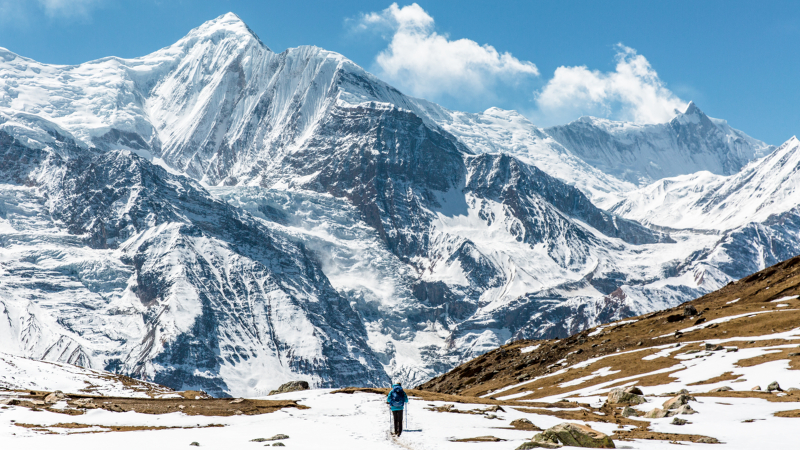
It’s one of the world’s classic long-distance hiking trails, and still one of Nepal’s most popular treks.
The Annapurna Circuit , a 12 to 21-day route that begins in the lush green villages of the Himalayan foothills. Taking trekkers over the 5,416m Thorong La Pass and down to the Tibetan-influenced temples and communities of the Mustang Valley.
If you want to experience a little bit of everything Nepal has to offer, this is perhaps the best trek to set off on, but it’s certainly no easy feat. The circuit is very tough at times, and the high altitude and unpredictable weather of the Annapurna mountain range can make crossing the Thorong La Pass a dangerous task – particularly if you’re not prepared.
Thankfully, I’ve got your back! So, here are ten things you should really know in order to complete the amazing Annapurna Circuit safely and with a smile on your face.
Check out Intrepid's Annapurna treks
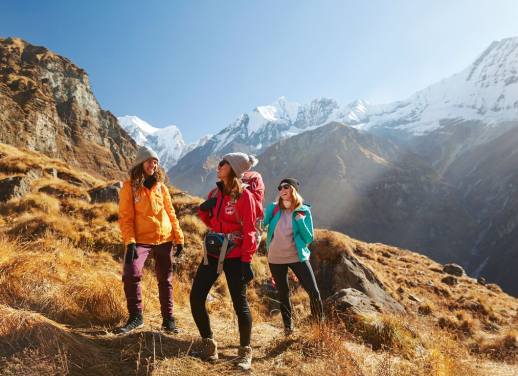
1. Plan the time of year right
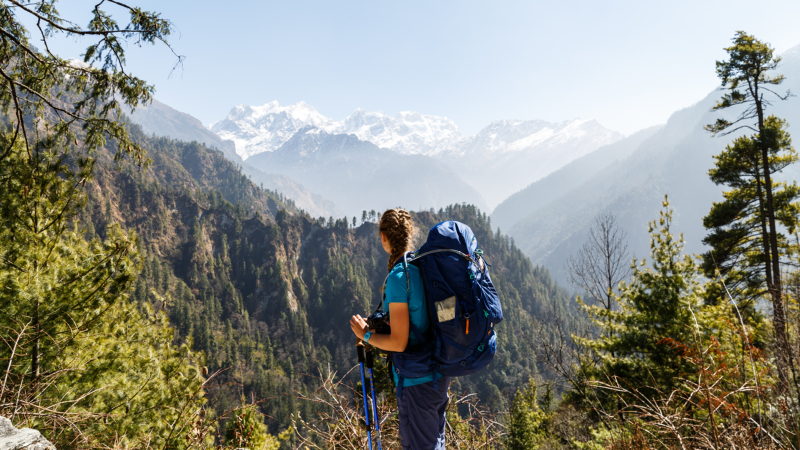
Photo captured by Annapurna Mellor
Like with many of the treks in Nepal, there are certain times of year when the weather conditions are ideal. For the Annapurna Circuit, October and November or April and May are widely considered to be the best times for trekking. The weather during these two seasons is generally clear and dry, and so it’s not too cold when heading into high altitudes. These two seasons are also the busiest times to be on the trail, with many other trekkers from across the world heading into the Himalayas.
You can also trek at other times of the year, but you will need to be a little more prepared for adverse weather conditions. The winter season, December to March, can also have clear skies and spectacular views. But it can be incredibly cold at higher altitudes, with thick snow on the ground that can often cause the Thorong La Pass to close at short notice. If you decide to trek during the winter season, make sure you have extra layers, a thick sleeping bag suited to temperatures of at least -20°C and crampons, which can be bought in Kathmandu and Pokhara.
GO NOW: EXPERIENCE THE BEAUTY OF THE ANNAPURNA CIRCUIT ON THIS 16-DAY ADVENTURE
2. Bring only what you need, leave the rest behind
When trekking on the Annapurna Circuit with Intrepid, Nepalese porters will carry 10kg of your gear. Anything extra will need to be carried on your own back, so packing as lightly as possible is essential. There are some things you need, such as a good quality sleeping bag, warm jackets, medicines, thermal layers and a head torch. But leave your jeans, laptop and makeup back in Kathmandu. You really don’t need them on the trail, and your back will thank you for it!
SUBSCRIBE TO OUR NEWSLETTER FOR THE LATEST TREKKING NEWS, OFFERS AND COMPETITIONS
3. The altitude should not be underestimated
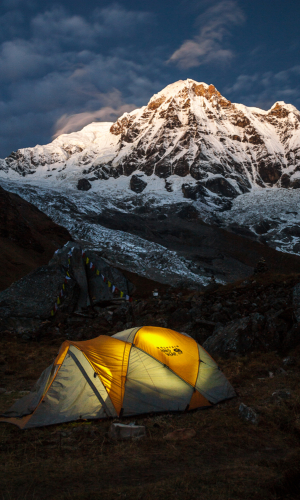
Altitude sickness can happen anytime above 2,500m. It doesn’t matter how fit you are, it can affect anyone and does so randomly. You can stay prepared by taking Diamox, an altitude medication, but aside from that just take it slow, drink lots of water and listen to your body. Before you set off on the trail, read up on the symptoms of altitude sickness so you’re aware of them if you start to feel the effects. Your guides will also be very knowledgeable about altitude and can be an essential source of help if you aren’t feeling well. The Annapurna Circuit reaches over 5,000m, that’s seriously high, and almost everyone will experience some mild symptoms like headaches or difficulty sleeping.
RELATED: ANNAPURNA OR EVEREST? YOUR DEFINITIVE TREKKING GUIDE
4. Be prepared for all weathers, whatever the time of year
While certain times of the year have much more suitable trekking weather (see point one), it is vital to be prepared for all possible conditions, no matter when you decide to go. High in the Himalayas, the weather is unpredictable, and snow, rain or storms can happen at any time. Climate change also means that weather patterns have become even more erratic over the last few years. Even if you’re trekking in October, be prepared for snow or storms on the trail. Pack enough warm clothing, make sure your boots are waterproof and don’t forget your sun cream or a sunhat.
GO NOW: DISCOVER THE HIGHLIGHTS OF THE ANNAPURNA CIRCUIT ON THIS 16-DAY ESCAPE
5. Eat well and look after your body
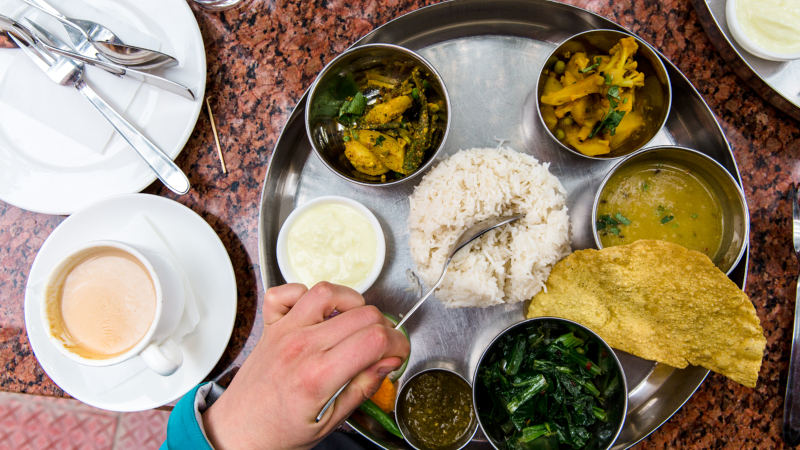
One of the best things about the Annapurna Circuit is the food and hospitality you will receive in the teahouses. Each evening, after a long day of trekking, you will be delighted to sit down in front of a roaring fire and tuck into a plate of dal bhat (a traditional Nepali meal of rice, lentils, vegetable curry and pickle). The food is delicious and very filling, and your body will be grateful for it the next day when you feel revived and ready to head out on the trail again. Other common offerings in guesthouses include garlic soup, a local remedy for altitude sickness and much better than it sounds. As well as, fried potatoes, spaghetti with local vegetables and of course apple pie – which is the Annapurna Circuit’s desert of choice due to the apple orchards growing in many of the villages along the trail. For snacking, I recommend stocking up in Kathmandu, as the cost of items like chocolate bars can get very high on the circuit.
RELATED: 8 NEPALI DISHES YOU HAVE TO TRY
6. It’s good to have a way to purify water
Plastic is a big problem on trekking routes across Nepal, as most of these small villages have no waste disposal system. This is leaving mountainsides cluttered with discarded plastic bottles, which is really not how we want to be treating these areas of striking natural beauty! You can’t drink the tap water in Nepal, and you really do need to be drinking a lot on the trail as you are walking long distances at high altitudes.
I recommend getting a steel reusable water bottle in Kathmandu. Along the trail, there are many villages with purified drinking water stations. Here you can refill your bottle and it actually works out much cheaper than buying bottled water. You can also use water purification tablets or buy a steripen. During the evenings, we would often order pots of hot water or tea and drink that, you can also fill up your bottle with any remaining in the pot and it’ll still be good to drink the next day.
TAKE ME THERE: EXPLORE OUR FULL RANGE OF ANNAPURNA CIRCUIT BREAKS
7. Learn some cultural respect
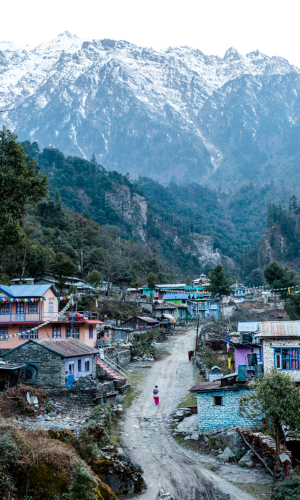
For many people, trekking in Nepal is about mountain views and hiking. But this is also a cultural trail, and it’s important to respect the people that call these villages their home. I recommend learning a little more about the cultures you are passing through. Speak to the families running the teahouses and go visit local gompas or temples. Opening your eyes to the cultures, religions and heritage of the trail will make it a much more enjoyable and meaningful experience, and it also means a lot to the local people when trekkers take an interest in their lives.
RELATED: MY INCREDIBLE MEETING WITH A HERMIT ON A NEPAL MOUNTAIN TREK
8. Don’t run out of cash
Once you leave Besisahar, there are no cash machines on the Annapurna Trail until you reach Jomsom after the Thorong La Pass. So, you need to be prepared and carry all the money you will need for the journey. While food and drinks in the teahouses can be cheap in the lowlands, they increase significantly as you increase in altitude and the road disappears. In Kathmandu, dal bhat is likely to cost you around 200 rupees, but this can grow to around 800 when you get above 3,500m. Western food such as burgers, pasta and burritos (yes, all food you can get on the trail), also tends to be very expensive as you get higher. I would recommend taking at least $20 per day for the trek, and if you’re a big eater or want to drink alcohol, $30-$40 per day is better.
GO NOW: TACKLE ANNAPURNA AND EVEREST ON THIS 31-DAY EPIC
9. Prepare yourself for the Thorong La Pass
Crossing the Thorong La Pass was probably the hardest day of my life! Waking up before sunrise and heading over narrow ridges in thick snow. Then climbing continuously for hours before finally reaching the prayer flags on the pass, breathless and completely relieved. Ok, maybe I’m not selling it so well. But it is essential to be prepared for this day, which will really push even the fittest hiker to the limits.
As long as you’re prepared, wearing enough warm clothes and have acclimatised enough to ensure your body comfortably makes the journey, then reaching the Thorong La Pass is going to be one of the most joyous moments of your trekking trip! Plus, once you’ve reached the top, you get to descend 1,600m to Muktinath, where the air is thick in oxygen and there are even hot showers to look forward to.
GO NOW: LIMITED ON TIME? OUR 5-DAY WALKING TOUR THROUGH THE ANNAPURNA RANGE
10. Be positive, take it slow and enjoy the journey!
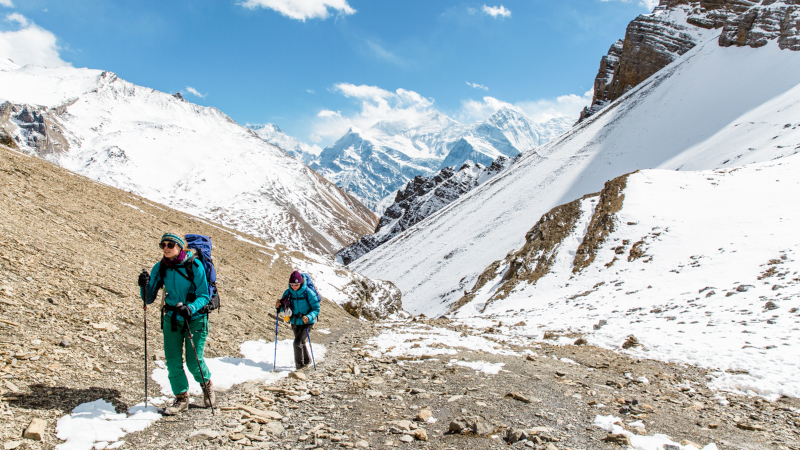
Travelling is meant to push you and challenge you in so many ways and trekking the Annapurna Circuit in Nepal will certainly do just that. While this is a difficult trek at times, it is also an incredibly enjoyable journey and one that can be completed by people of all ages and all fitness levels. The most important thing throughout the trek is to stay positive. Even when your body aches and you’re craving a hot shower, positivity will drive you on and it won’t be long before a breath-taking Himalayan panorama makes you remember why you’re here pushing yourself to the limit. It’s these incredible views, the wonderful hospitality of the local people and the company of your trekking buddies, which really make this a journey you will remember for the rest of your life!
RELATED: WHY CHALLENGING YOURSELF IS SUCH AN IMPORTANT PART OF TRAVELLING
Think you’re ready to take on the Annapurna Circuit? Take a look at our selection of trekking tours that’ll take you there . Already tackled it and looking for a new challenge? Check out our range of walking and trekking holidays from around the world.
Annapurna Mellor
Annapurna Mellor is a photographer, writer and storyteller. Her travels have taken her across Asia, Northern Africa, along the Trans-Siberian Railway and around Europe - always taking the road less travelled and always aiming to go a little deeper into the heart of local culture and people. Her photography work has been featured in National Geographic Traveller Magazine, Lonely Planet Guide Books and in campaigns for many travel brands around the world. Although she is usually dreaming about adventures afar, she is based, most of the time, in Manchester, England.
You might also like
Learn how to leave hack your 2025 canadian..., level up your australian public holidays in 2025, how to make the most of us federal..., make the most of nz’s public holidays in..., top us national parks, how to maximise your annual leave using uk..., 7 incredible hikes in denali national park, unique getaways for your next girls’ trip, how to visit europe in the off-season, best places to travel in march, best places to travel in may.
- +9779851276377
- 977 01 5348594
- [email protected]
- Follow us on:
Annapurna Circuit Trek
Manang village, on the way to yak kharka, thorong la pass, you can also, things to know before trip, trip introduction.
The Annapurna Circuit Trek in the western region of Nepal is one of the best trekking trails in the world. This provides an opportunity to immerse oneself in its unmatched natural beauty and gain insights into Buddhist and Hindu culture. During our Annapurna Circuit Trek, we encircle the whole Annapurna Himalaya passing through beautiful forests, picturesque landscapes, striking waterfalls, deep gorges, shining glaciers, diverse cultures, and pristine lakes with awesome views of the snow-capped Himalayas all the way.
A special Trekking Permit will be arranged to enter the Annapurna Conservation Area , where we discover unique flora and fauna. The route of the Annapurna Circuit Trek involves crossing Thorong La Pass at 5,416m/17,770ft which is a great challenge and will provide rewarding memories that will last forever.
Overview of Annapurna Circuit Trek
We embark on Annapurna Circuit Trek after you enjoy some sightseeing around the culturally rich Kathmandu valley . Initially, we take a drive from Kathmandu to Dharapani via Besisahar on a newly constructed road. Then the Annapurna circuit trekking starts as we ascend from Dharapani toward Chame. The trail passes through the Annapurna conservation area surrounded by picturesque mountains with a vast glacial plateau in the center. As we gain altitude, the vegetation around us slowly changes from dense forests to small shrubs; finally, we arrive at a point similar to a Tibetan plateau called Manang. There we can get insights into Tibetan-influenced culture and traditions and also acclimatize for a day.
Thorong La Pass – the highest point on the Annapurna Circuit
Depending on your fitness level and physical capabilities, our trek leader will decide whether to stop at Thorong Phedi or push onwards towards the high camp for an overnight stay. We will then cross Thorong La Pass at an altitude of 5,416 meters. Thorong La Pass blesses us with stunning views of Annapurna, Kali Gandaki Valley, Dhaulagiri, and other peaks as never been seen before. This is the highest pass in our Annapurna Circuit Trek itinerary.
Muktinath, Red Monastery Kagbeni and Tatopani Hotspring
The trail leads us to Muktinath, the pilgrimage site where we can see a perfect amalgamation of Hinduism and Buddhism. We then visit the Red Monastery at Kagbeni where we can view the golden book of the Dalai Lama . Then we descend towards Marpha, the apple kingdom famous for local apple products. We will then take a dip at Tatopani, a natural hot spring for relaxation.
Ghorepani Poon Hill and Ghandruk
Towards the end of our Annapurna Circuit Trek, we get the flashback of all Annapurna Himalayan ranges from Poon Hill Viewpoint which is famous for the best sunrise views. We trek down towards the Gurung -inhabited village of Ghandruk and get back into Pokhara. In this way, our trek ends and we drive or fly back to Kathmandu.
Who can join Annapurna Circuit Trek and How?
The Annapurna Circuit Trek is suitable for any travel enthusiast if you have a passion for walking, learning, and exploring the nature and culture of Nepal. Physical fitness plays a vital role in making this trip a success. Regarding the best seasons, we highly recommend the autumn and spring months.
Join Annapurna Circuit Trek on your next vacation with Nepal Mountain Trekkers for an unforgettable Annapurna experience. Simply fill out the Booking form and let us know about your interest. Or you can contact us directly by sending us an email to join this short and easy trek in the Annapurna Region .
If this itinerary doesn’t suit your requirement or if you want to customize it, please feel free to contact us. This trek could be customized as per your required time-frame and budget limits.
- Day 1 Arrival in Kathmandu [1,300m/4,264 ft]:
- Day 2 Kathmandu: Sightseeing and Trek Preparation:
- Day 3 Kathmandu to Dharapani[1,860 m/6,102 ft] via Besisahar [760 m/2,493 ft]: 9 - 10 hrs drive:
- Day 4 Dharapani to Chame [2,710 m/ 8,891 ft] : 5 - 6 hrs:
- Day 5 Chame to Pisang [3,300m/10,824ft]: 5 – 6 hrs:
- Day 6 Pisang to Manang [3,540m/11,614 ft]: 6 – 7 hrs:
- Day 7 Manang: Acclimatization Day:
- Day 8 Manang to Yak Kharka [4,110m/13,484ft]: 3 – 4 hrs:
- Day 9 Yak Kharka to Thorong Phedi [4,600m/15,092ft]: 3 – 4 hrs :
- Day 10 Thorong Phedi to Muktinath [3,800/12,467ft] via Thorong La Pass [5,416m/17,764ft] : 8 - 9 hrs:
- Day 11 Muktinath to Marpha [2,670m/8,760ft]: 4 – 5 hrs:
- Day 12 Marpha to Kalopani [2,530m/8,300 ft]: 5 – 6 hrs:
- Day 13 Kalopani to Tatopani [1,200m/3,937ft]: 6 – 7 hrs:
- Day 14 Tatopani to Ghorepani [2,850m/9,350ft]: 7 – 8 hrs:
- Day 15 Ghorepani to Tadapani [2,710m/8,891ft]: 6 – 7 hrs:
- Day 16 Tadapani to Pokhara [820m/2,690ft] via Ghandruk: 5 - 6 hrs trek, 1 hr drive:
- Day 17 Pokhara to Kathmandu: 5-6 hrs drive:
- Day 18 Departure Day:
Detail Itinerary
Day 1 : Arrival in Kathmandu [1,300m/4,264 ft]::
As soon as you arrive at the capital city, Kathmandu, you will be met by a representative from Nepal Mountain Trekkers at the International Airport terminals and he will take you to your respective hotel. After checking into the hotel, you can enjoy your free time relaxing in a cozy room or stroll around the tourist hub Thamel area until the end of the day.
Day 2 : Kathmandu: Sightseeing and Trek Preparation::
After having our early meal, we start our day with a visit to the Nepal Mountain Trekkers office at Thamel. After being introduced to our team including tour guide, trekking leader, and director of operations, we head for necessary trekking preparations, getting needed equipment with the initiation of Kathmandu sightseeing around world heritage sites. Kathmandu Durbar Square, Swayambhunath stupa, Pashupatinath temple, and Boudhanath stupa are UNESCO world heritage sites that we explore till sunset. Overnight stay at the hotel in Kathmandu. B included.
Day 3 : Kathmandu to Dharapani[1,860 m/6,102 ft] via Besisahar [760 m/2,493 ft]: 9 - 10 hrs drive::
Our real Annapurna Circuit Trekking Journey starts today as we drive through beautiful hilly roads along the banks of the Trishuli River towards Besisahar. And after having our brunch at Besisahar, we start our trekking when we reach Dharapani. Overnight stay at the tea house. B L D included.
Day 4 : Dharapani to Chame [2,710 m/ 8,891 ft] : 5 - 6 hrs::
This day we will start trekking with a moderate hike towards Chame, passing through several suspension bridges enjoying the blissful nature. We will walk through Pine and Rhododendron Forests and we can enjoy the mesmerizing view of Manasalu Mountain Ranges along the trail. Whereas, we can learn a lot about the Nepalese lifestyle while you pass through the typical villages with traditional houses. Overnight stay at the tea house. B L D included.
Day 5 : Chame to Pisang [3,300m/10,824ft]: 5 – 6 hrs::
Our day begins with walking through dense forests, narrow trails and soon this greenery starts to disappear as we gain altitude. Here, we will be crossing numerous suspension and wooden bridges that open up the trails to spectacular snow-capped mountains. In this way at the end of the day, we finally arrive at Pisang where we will be staying overnight. B L D included in meals.
Day 6 : Pisang to Manang [3,540m/11,614 ft]: 6 – 7 hrs::
Leaving behind Pisang, we head towards beautiful Manang valley where we have two routes to follow and we recommend you to take the higher route passing Garu that offers great landscape and Himalayan views. From this point, we find a difference in landscapes and alpine vegetation starts to appear. A quick visit to the local Barge monastery would give some cultural insights. And we conclude our day after staying overnight at one of the tea houses in Manang. B L D included in meals.
Day 7 : Manang: Acclimatization Day::
Proper acclimatization is very important to successfully complete this trek and today we take it as a rest day to make our body adapt to high altitude surroundings. Upcoming two days will be a bit more challenging and rigorous, therefore today we will not just rest but go for a few altitude hikes up and descend at the end of the day. So, there would not be any acute mountain sickness issues. During the daytime, we visit a few monasteries and viewpoints. We overall explore Manang village. Finally, we stay overnight at Manang including B L D in meals.
Day 8 : Manang to Yak Kharka [4,110m/13,484ft]: 3 – 4 hrs::
Today after having our early meal, we start our day by crossing several small river streams to arrive at the village called Tenki, and heading northward from the trails, we follow the beautiful pasture lands and meadows where horses and yaks graze. Therefore the name of the place is also ‘Yak Kharka’ implying Yak pasture land. We walk slow and steady in a gradual way as we don’t want to mess up with altitude sickness while gaining altitude. We stay overnight at Yak Kharka including B L D.
Day 9 : Yak Kharka to Thorong Phedi [4,600m/15,092ft]: 3 – 4 hrs ::
Today we will be leaving behind Yak Kharka and heading towards the foot of high altitude Thorong la pass (4650m). It is a small place to get ourselves relaxed and ready for the next day. If you are super fit, you can also go to stay overnight at high camp, but taking a safety-first, we recommend you to stay overnight at Thorong Phedi. B L D included in a day’s meal.
Day 10 : Thorong Phedi to Muktinath [3,800/12,467ft] via Thorong La Pass [5,416m/17,764ft] : 8 - 9 hrs::
Finally, the most important day of our Annapurna Circuit Trek has arrived as today we will cross Thorong La pass, immerse in the magical views and experience at 5420 meters above sea level. Almost you feel like you are touching a horizon. Plenty of pics will be clicked and a great experience will be accumulated. And finally, we head towards the popular pilgrimage site of Muktinath at the end of the day where we can get insights into both Buddhists and Hindu religious and cultural highlights. We stay overnight at Muktinath with B L D included.
Day 11 : Muktinath to Marpha [2,670m/8,760ft]: 4 – 5 hrs::
We wake up early in the morning, get a blessing from the holy temple, visit the nearby monastery, and slowly descend through Ranipauwa village to arrive at Kagbeni, Jomsom, and Marpha. We get to experience huge diversity in landscapes and topography as we will be losing almost 3000m altitudes in a day. From alpine to deserted and forested lands, we walk through all. Also, Marpha is popular for its apple products and known as the apple kingdom. We will also enjoy the special apple brandy and stay overnight at Marpha in a party mood. Meals include B L D.
Day 12 : Marpha to Kalopani [2,530m/8,300 ft]: 5 – 6 hrs::
Leaving behind Marpha, we will be trekking through cultural Thakali villages where there are plenty of apple farms and spectacular sceneries of Annapurna, Dhaulagiri, and other neighboring Himalayan peaks. In this way, we finally arrive at Kalopani at the end of the day where we stay overnight. Meals include B L D.
Day 13 : Kalopani to Tatopani [1,200m/3,937ft]: 6 – 7 hrs::
Today we mostly walk downhill descending from Kalopani to Tatopani. After crossing Ghasa, we can see beautiful forested lands, striking waterfalls, and even enjoy natural hot springs at Tatopani. It will be a beautiful cultural exploring opportunity day with the chance to view natural highlights around the sites too. Overnight stay at Tatopani including B L D.
Day 14 : Tatopani to Ghorepani [2,850m/9,350ft]: 7 – 8 hrs::
Today we mostly explore the local lifestyle of mid villages in Nepal where we enjoy beautiful terraced fields, landscapes; rhododendron forests that blossom in a magical way during spring with other faunas along the way. We sleep early today to wake up early tomorrow for the Poon hill hike. Overnight stay at Ghorepani including B L D.
Day 15 : Ghorepani to Tadapani [2,710m/8,891ft]: 6 – 7 hrs::
Waking up early in the morning before sunrise, we walk towards the top of the Poonhill in the dark. You will see plenty of other travelers waiting to experience the best ever sunrise views over Annapurna and Dhaulagiri Himalayas. After capturing the best shots in the camera, we descend through forested trails towards Tadapani. We stay overnight at Tadapani with B L D included.
Day 16 : Tadapani to Pokhara [820m/2,690ft] via Ghandruk: 5 - 6 hrs trek, 1 hr drive::
Following the beautiful jungle trails from Tadapani, today we arrive at equally beautiful and culturally rich Gurung, Magar village of Ghandruk. Ghandruk is popular for awesome Himalayan, landscape views with warm hospitality from local inhabitants. After having our lunch we take a short about an hour drive to main Pokhara city. Overnight at hotel in Pokhara. Meals include: B L
Day 17 : Pokhara to Kathmandu: 5-6 hrs drive::
In this way, finally, our amazing Annapurna Circuit Trek comes to the conclusion and we either take a drive or you have an option to fly to Kathmandu. Upon arrival at Kathmandu, you will be met by our director of operations, Mr. Dhakal , and offer you a farewell dinner as a complimentary token of love from Nepal Mountain Trekkers Company.
Day 18 : Departure Day::
Today will be your final day in Nepal, as we drop you at International Airport for your scheduled international flight towards your onward destination.
Price Includes
- Airport Pick-up and drop service(Private Vehicle depending upon the Group Size)
- 3 nights Hotel in Kathmandu(with Breakfast)
- 1-night Hotel in Pokhara(with Breakfast)
- Sanitation: The accommodation we provide will be neat and clean with warm-hospitality and quality services.
- Single/Twin-sharing Accommodation (as per budget): Your group won’t have to share your accommodation with anyone else so your privacy is protected.
- We provide hygienic and safe meals to re-energize you.
- We request you not to waste your meals for it is difficult to transport food in the rural area.
- You are not allowed to share your meals with anyone else from another group.
- Transportation costs: Public Bus (Kathmandu – Besisahar), Private Jeep(Besisahar – Dharapani), Private Vehicle(Nayapul-Pokhara), and Tourist Bus(Pokhara-Kathmandu)
- Local Staffs: Our guides are locals of the region which ensures that you will surely get to explore a bit more during the trek than with any other guides.
- Experienced: With an experience of more than a decade of working in this field, our trekking guides possess excellent knowledge on briefing during the trek as well as they are experts in handling all kinds of critical situations which might occur during the trek.
- Insurance: Nepal Mountain Trekkers have an insurance policy for all our trekking staff.
- Local Staffs: The porters we hire belong to the same region where we trek in order to provide employment opportunities to the locals as well as to make you explore every prospect of the region.
- Trekking Permits: Trekkers’ Information Management System(TIMS) Card and Annapurna Conservation Area(ACAP) fees
- Trekking gears like sleeping bags and down jackets made available on rent
- T-shirt, Duffel Bag, and Trekking Map with Company Logo
- Rescue Arrangement Service
- First aid medical box
- 13% VAT and 10% service charge
- Farewell Dinner
Price Excludes
- Visa fee to enter Nepal ( Visa Information )
- International flight tickets
- Foods in Pokhara and Kathmandu
- Extra night accommodation and meal costs in Kathmandu and Pokhara due to any change in the scheduled itinerary
- Travel insurance/ Rescue operation costs
- All personal expenses(internet, laundry, battery charge, donation, etc)
- All soft drinks and alcoholic beverages
- Tips for guide and porters
Trip Gallery
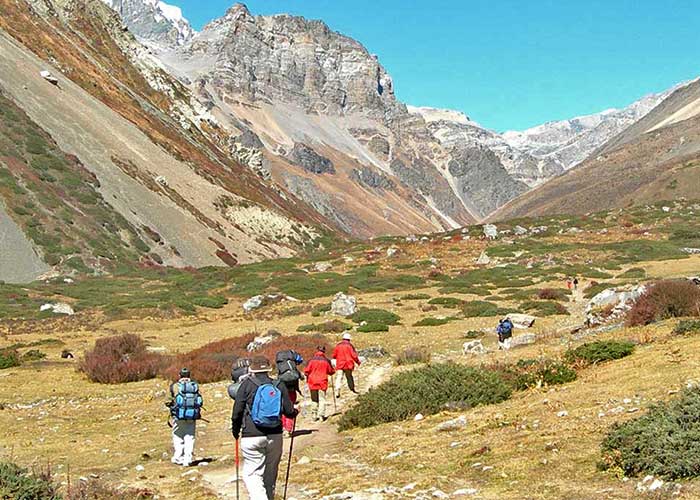
- Sun hat or scarf
- Light balaclava or warm fleece hat
- Cotton t-shirts or thermals
- Fleece jacket
- Waterproof jacket
- Down jacket
- Lightweight cotton pants (long)
- Waterproof pants
- Thin inner socks
- Thick, warm wool hiking socks
- Comfortable hiking boots
Accessories
- Sleeping bag rated to -10°C +
- Trekking bag (Rucksack)
- Large plastic bags (for keeping items dry inside trek bag)
- Trekking poles (optional, recommended)
- Water bottle or camel bag
Miscellaneous
- Medicines: We recommend you bring your regular medicines; we will provide a first aid kit from our side.
- Light-weighted Towel
- Swiss Knife
- Passport and extra passport photos
- Water Purifying Iodine Tablets, Drop or Sterilizer
Fixed Departures
- 31/08/2024 2-10 Yes $1700 $1445 Book
- 03/09/2024 2-10 Yes $1700 $1445 Book
- 27/09/2024 2-10 Yes $1700 $1445 Book
Related Trips
You will also like …
- View Details
- Enquire Now
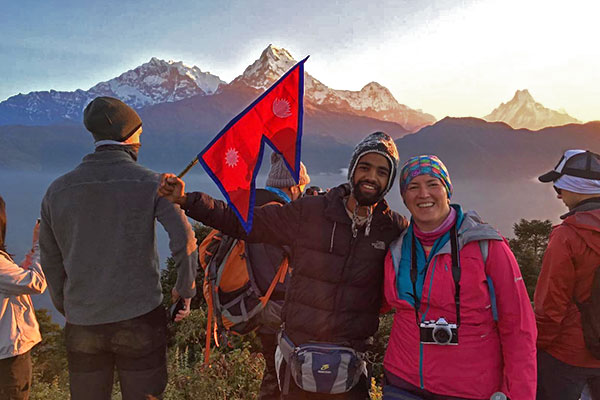
Ghorepani Poon Hill Trek
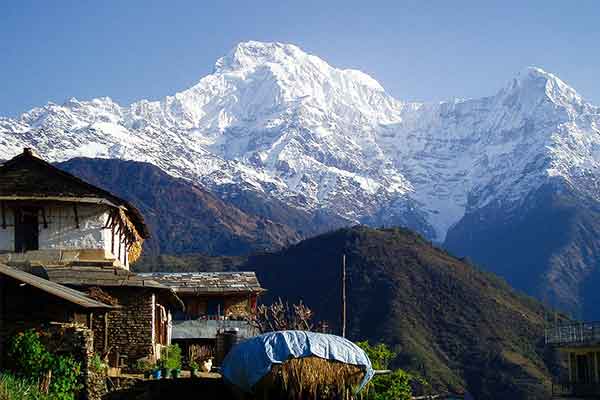
Ghandruk Trek
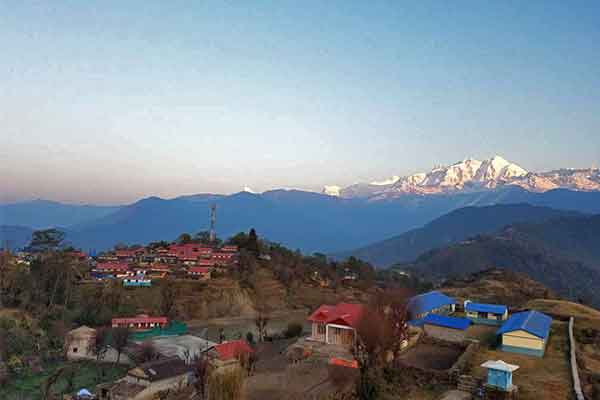
Ghale Gaun Homestay
- Leisurely Plus
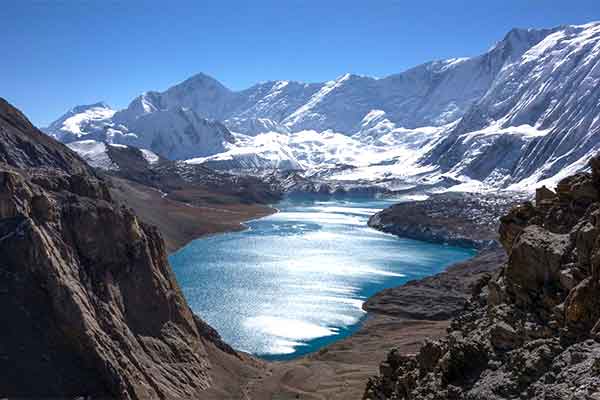
Annapurna Round Tilicho Lake plus Poon Hill Trek
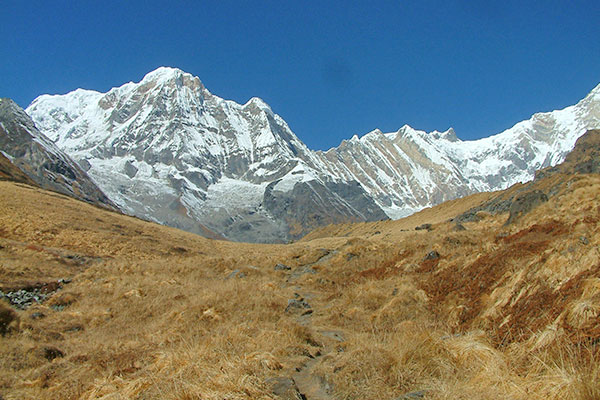
Annapurna Base Camp Trek
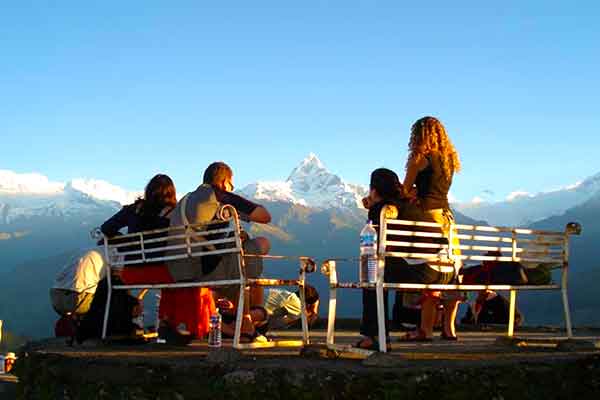
Around Pokhara Day Hiking
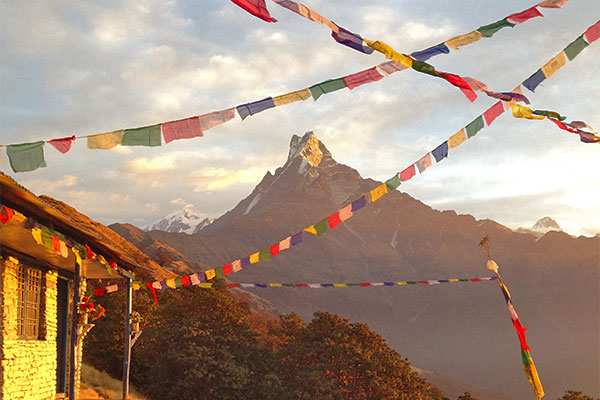
Mardi Himal Base Camp Trek
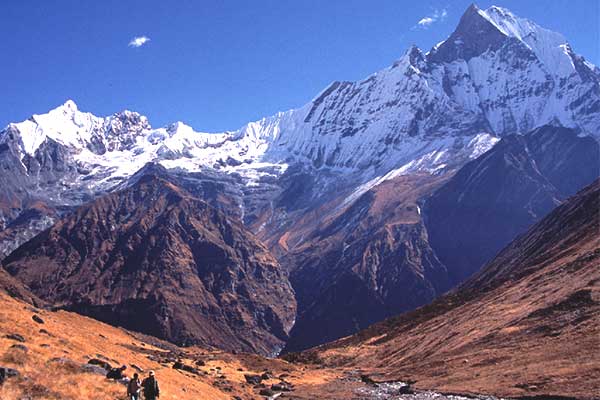
Machhapuchhre Model Trek
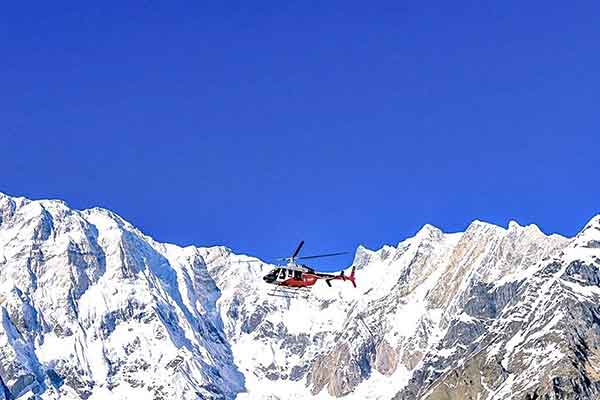
Nepal Helicopter Tour in Pokhara
Clients review.
What our customers say about us
Annapurna Circuit Trek – just amazing!!
It was our first experience with the Himalayas and certainly not the last one! Everything was professionally organized, from picking us up from the airport, through all transport during our stay, accommodation, meals, trekking organization and much more. Our guide, Shiva, made sure that everything was perfect, he had amazing experience which he shared with us during the expedition and thanks to our porter, Durba, we didn’t have to worry about our equipment, he was reliable and we could count on him everyday. We definitely recommend taking advantage of an organized trip, thanks to which we could enjoy the beauty of nature, focus on the trip itself and not worry about organizing every little thing (and believe me, there is a lot of that during such a trip). We felt taken care of but at the same time we had a lot of privacy, which made us feel a bit like we were on an independent trip. We highly recommend it!!
Nepal Mountain Trekkers – bespoke trek Muktinath to Pokhara
Truly amazing trek based on my previous experience to many little visited areas & with minimal use of roads . Our guide TB was clearly very experienced, & very accommodating of our bespoke itinerary & slower pace for two mature ladies. He was very tolerant & seemed to enjoy aspects of our trek which took us to many areas with spectacular scenery & few or no tourists. TB was so versatile that he “borrowed” kitchens & supplies in villages to whip up lunch when we found ourselves in places with no lodges. He also understood that we were keen to stay in lodges with optimum views. Our 2 porters Sunil & Sudip were a real bonus – both spoke English & were unfailingly helpful & good natured. I have done many Nepali treks & it is unusual to find such a good crew. Ramesh was always prompt in answering my questions whilst planning the trek from London.
Not too Cold.nice scenery through Mountain villages.delicious food Dhal bat
Nice trek for Nepal newcomers 8days Not too Hard.guide Krishna Was very helpful and we hat good time.luckily no rain at that time
Full recommendation
We had an excellent trip with Nepal Mountain Trekkers. They were really helpful and took plenty of time to discuss the perfectly individual trek with us in advance. Even during the trip we were always able to make adjustments depending on how we felt. Our guide TB was always friendly, entertaining and knew the area very well. Even after the trek in the afternoon he showed us the monasteries and explained the religions to us. When we did not feel well, he bought medication for us. He always took care of us, asked whether we needed additional blankets during the night, whether we wanted some tea in the afternoon and was flexible when to start the trek in the morning etc. His motto was: “Everything is possible.” Thank you very much for everything again!
Friendly company to deal with and very attentive to details.
Suman has lots of experience and can organise trips anywhere in Nepal for beginners right through to high altitude treks. Chirring (the guide on my trek in Manaslu) was fantastic..very supportive and patient with me – it was a pleasure trekking with him. I definitely recommend using this company. I also recommend the hotel next door (Hotel Green Horizon), which is good value and has friendly staff.
Annapurna Circuit + Tilichio Lake
We had a really good trekking trip (Annapurna Circuit + Tilichio Lake + Poon Hill) with Nepal Mountain Trekkers. Accommodation, organization and support was always good and fast. The trek is beautiful.
Unfortunately my boyfriend got sick on the way but with the help of our guide Pralad we could still manage to do Tilichio Lake and Thorong La Pass (but had sadly to skip Poon Hill). Thus, Nepal Mountain Trekkers reorganized our final days in Pokhara. Thank you for that! We had lovely holidays in this wonderful country and would book again with Nepal Mountain Trekkers!
Utterly fantastic
Highly, highly recommend NMT! I’m delighted to say that Suman started as a guide and after a month of treks and trips in Nepal, ended as a friend. My wife and I landed in Kathmandu having done research but not booked anything and Suman took us through all the options and routes for various regions before joining us on two treks – one in Kathmandu valley and one on the Annapurna Circuit. Suman was amazing to trek with, taught us some Nepali and even invited us to spend Christmas in his home with his family which was lovely. I’ll be returning to Nepal and will be delighted to see Suman and the team again!
Highly, highly recommend NMT! I’m delighted to say that Suman started as a guide and after a month of treks and trips in Nepal, ended as a friend. My wife and I landed in Kathmandu having done research but not booked anything and Suman took us through all the options and routes for various regions before joining us on two treks – one in Kathmandu valley and one on the Annapurna Circuit.
Suman was amazing to trek with, taught us some Nepali and even invited us to spend Christmas in his home with his family which was lovely.
I’ll be returning to Nepal and will be delighted to see Suman and the team again!
Unforgettable – Annapurna Circuit Trek
I had the pleasure to spend 4 weeks in Nepal and this fantastic trip left me with so much colorful and inspiring memories which was clearly the merit of Ramesh and his amazing team. It is therefore not difficult to recommend Nepal Mountain Trekkers – from the first contact over a customized and detailed planning to an individual and heartfelt care onsite, everything was professional and 100% customer-oriented. I enjoyed every moment of my stay and had a wonderful time with my guide Sansib (Min) and my porter Radjendra. They all bring in so much heart, passion and willingness to make your stay unforgettable and get prepared, they will become a part in your heart pretty soon. I miss their positive energy and relaxed manner to handle things! Keep on your fantastic work and I am looking forward to seeing you any time soon.
Annapurna region 8 Day Trek
TB at Nepal Mountain Trekkers was fantastic, nothing was too much trouble, when we decided to change our trek at the last minute he had it organized in no time. He is very knowledgeable and professional and knows all the Treks in Nepal, so if you are thinking of a trek in Nepal TB at Nepal Mountain Trekkers is your man. He was always looking out for our wellbeing, making sure we weren’t ill and we were eating enough. A fantastic experience all round.
Annapurna trek (Poon Hill, Ghandruk and Dhampus)
I had an adventure of a life time in Nepal with Nepal Mountain Trekkers. The company was very professional and their staff were amazing especially Suman Gurung our guide. Suman was outstanding. I highly recommend this company to you
Hervorragende Agentur, die alles möglich macht
Im November 2017 wollte ich mit einer Freundin wieder einmal nach Manang im Annapurna Gebiet trekken, um dort eine von uns unterstützte Boarding School zu besuchen. Ramesh hatte schon den dafür notwendigen Plan ausgearbeitet. Aber die Knieprobleme meiner Begleiterin machten es unmöglich. Kurzer Hand plante Ramesh um, besorgte uns den umsichtigen Fahrer Heris und den Guide Daljit und organisierte uns einen Homestay-Aufenthalt, der für uns ein Erlebnis wurde. Ich habe mit Ramesh einen Menschen kennnengelernt, der zuverlässing und verbindlich alles möglich macht. Wie er verfügen auch seine “Jungs” über großes Wissen, was Kultur und Natur des Landes angeht. Er ist ein überaus verantwortungsvoller und engagierter Mensch, der sich um seine Crew und die Menschen in seinem Heimatdorf kümmert. Im März 2019 besuchte ich schließlich wieder einmal Nepal, wurde wie immer von der Trekkingagentur abgeholt und zum Hotel Horizon gebracht, ein familiär geführtes Hotel, welches ich empfehlen kann. Wie immer stand uns Ramesh mit Rat und Tat zur Seite. Ich habe in jeder Hinsicht mit ihm und seinen Leuten die besten Erfahrungen gemacht und plane bereits meine nächste Trekkingtour mit ihm. Seine raschen Antworten mit maßgeschneiderten Vorschlägen erleichtern die Vorstellung und Planung von dem, was möglich ist. In den Händen seiner Agentur ist man bestens aufgehoben.
Amazing Annapurna Trekking Experience!
I did the Annapurna Circuit in October/November 2018 and had an amazing time! Nepal is by far the most beautiful country I’ve traveled so far and Nepal Mountain Trekkers made this trip an even better experience! Krishna has been a perfect guide who did not only ensure my safety in the mountains but also taught me a lot about flora and fauna as well as country and culture! I highly recommend him as a guide as well as the company, who puts great emphasis on travelers’ wellbeing and an authentic travel experience. A special thank you to Ramesh for his kindness and for organising the trip as well as to Krishna – I look forward to coming back to Nepal!
Amazing trip
Did a excursion at the Annapurna area with a friend.The agency was really great, helpful and i didnt have to worry about anything..they arranged all. Highly recommended!!! Ramesh was great..thank u for the experience!!
Perfekte Agentur für perfektes Trekking
Nachdem ich mit dem Trekking Agentur „Nepal Mountain Trekkers“ bereits die Touren Langtang – Helambu sowie Annapurna Basecamp (Bewertung s. 2016) gemacht habe, war im Spätherbst 2017 der Annapurna Circuit dran, den ich mit zwei Freunden aus Amerika gegangen bin. Natürlich habe ich auch diesen Trek von Ramesh Dhakal, dem Inhaber der Agentur , vorbereiten lassen und gleich auch meinen vertrauten Guide Krishna für diese Zeit reserviert. Warum eine so relativ einfache Trekkingtour über ein Agentur buchen, wird sich so mancher fragen. Aus meiner Sicht ist es absolut vorteilhaft jedes Trekkingunternehmen in Nepal über eine Agentur zu organisieren und die „ Nepal Mountain Trekkers“ kann ich nur wärmstens empfehen. Man wird in jeglicher Hinsicht fachkundig und als Freund betreut, sämtliche organisatorischen Dinge werden im Vorfeld zuverlässig erledigt und dadurch spart man sich viel Zeit für persönliche Interessen. Des weiteren ist ein Guide wie Krishna unterwegs eine unschätzbare Hilfe. Er konnte uns sehr viel Interessantes über die verschiedenen Gegenden auf der Strecke, über die Menschen und über die Natur erzählen das man sonst einfach nicht mitbekommt oder erfährt. Er kennt auch Wegstrecken die nicht allgemein bekannt sind und sollte es Probleme geben, so hilft er mit Rat und Tat. Einer meiner Freunde hatte zum Beispiel im Thorong Base Camp ein gesundheitliches Problem, das wir aber dank seiner Hilfe in den Griff bekommen haben. Ganz herzlichen Dank nochmals an Ramesh und vor allem an Krishna. Mit seiner ruhigen und umsichtigen Art hat er uns ein unvergessliches Trekkingerlebnis in einer wunderschönen Landschaft ermöglicht.
Josef Maurus
Trek annapurna circuit, 11 days..
Recently completed a trek in the annapurnas, Besisham, Manang, Muktinah, Jomson. Took 11 days. I organised it while in Kathmandu through Nepal Mountain trekkers ( easy to find, office in front of horizon hotel). Ramesh was great giving me a competitive and detailed quote,a lot cheaper than organising back in Australia. All organised on the spot and we left next morning. He even organised my luggage to be transfered to Pokhra. Everything promised was delivered and my porter-guide Krishna was fantastic. I would highly recommend this company.
En dehors des sentiers battus
J’ai découvert cette agence de Trekking par hasard et je n’ai vraiment pas été déçu. Je voulais faire un trek pour découvrir la culture local en dehors des habituels treks très (trop) fréquentés et ils m’ont proposé un trek sur mesure correspondant vraiment à ma demande. Je suis parti seul avec un guide vraiment très sympathique et professionnel qui est devenu un ami. Ce trek ma fait découvrir la culture du Népal. Nous dormions chez l’habitant et j’ai pu ainsi découvrir le mode de vie et les coutumes des Népalais. Je n’ai pas vu un seul touriste pendant les 6 jours de mon trek et les personnes rencontrées étaient vraiment accueillantes et intriguées par ma présence. Rien à voir avec le contact ressentie lors des treks sur les sentiers classiques des Annapurna par exemple. Je recommande vivement cette agence sérieuse qui propose des treks à la découverte du Népal authentique.
Alexandre P
Great trekking company and hotel.
Mr. Ramesh Dhakal is very helpful and friendly professional. Even though we were not his clients he gave us plenty of great advices and tips for our Annapurna Circuit Trek. We met him in Kathmandu where we stayed in his hotel Horizon, which is such a lovely place to stay. Although the hotel is in the centre of Thamel, it is very quiet and clean with amazing garden for breakfasts and hangouts. Since we decided that our next Nepal trip will be using their services again, we can highly recommend both Nepal Mountain Trekkers and hotel Horizon.
Annapurna Circuit 12 days
I met Mr. Suman Gurung last time I was in Nepal in 2014. At that time he organized a tour around the country for me and my girlfriend but we didn’t do any trekking. We agreed to plan it for the next visit and it happened this year. I addressed Mr. Suman Gurung in prior to book my trekking. Trekking was a bit hard physically but fulfilled with a lots of fun, good lessons and gorgeous views of the nature. My guide Mr. Gurung proved to be an expert and proficient in his job. I highly recommend you to do trekking with him.
Annapurna Circuit
The trek was just perfect. Mr. Ramesh Dhakal is a very friendly and helpful guide with perfect english. His hotel Horizon is berfect base for all kind of treks.
Nepal Mountain Trekkers
We met Mr. Ramesh Dhakal during our Annapurna Circuit Trek. He was very helpful and very kind, even though we were not his clients. He gave us a lot of helpful advices and we met him also in Kathmandu at hotel Horizon, which is such a nice place to stay. Although the hotel is in the centre of Thamel, it is very quiet and very nice and clean. We highly recommend Nepal Mountain Trekkers and hotel Horizon.
WE ARE ASSOCIATED WITH
SEND US A MESSAGE

ANNAPURNA CIRCUIT TREKKING GUIDE

Pin 544 Tweet Share WhatsApp 544 Shares
ANNAPURNA CIRCUIT TREK
The Essential Guide
In this guide to the Annapurna Circuit we’ll cover everything you need to know to plan the perfect trek, including a suggested itinerary, budget breakdown, practical details, and more. We’ll also outline the best Annapurna Circuit side trips and add-on treks for those looking to extend their Himalaya adventure.
The Annapurna Circuit is a classic Nepal trek. It traverses wonderfully varied landscapes, from lush lowlands to the high-altitude Thorong Pass, with the majestic Annapurna Massif a near constant companion. A string of trekking lodges and clearly marked trails make this an easily accessible trek for both independent hikers and guided treks. It’s also a great option for experienced trekkers looking to tackle an epic Nepal trek on a budget, as the permit fees are low and a guide is not compulsory.
Spectacular scenery abounds, but alas, the Annapurna Circuit is not without flaws. Extensive road building over the last few years has changed the nature of this trek dramatically. Few days are now spent solely on trekking trails. But, armed with the right advice and useful tips for getting ‘off-road’, this is still a standout Nepal trek.

Want to know more about the Annapurna Circuit Trek itself? Check out our day by day account . You can also watch our complete Annapurna Circuit Instagram Stories , plus our video below!
WATCH THE VIDEO
Read through the guide or jump ahead to a particular section by clicking on the links below.
ANNAPURNA CIRCUIT ITINERARY | ANNAPURNA CIRCUIT TREK MAP | WHERE TO START AND END | HOW LONG THE TREK TAKES | WHEN TO GO | ANNAPURNA CIRCUIT TREK DIFFICULTY | TREKKING INDEPENDENTLY | TREK WITH GUIDE/PORTER | CHOOSING A GUIDE/TREKKING AGENCY | TREK ON A GUIDED TOUR | ANNAPURNA CIRCUIT PERMITS | ANNAPURNA CIRCUIT BUDGET | MONEY ON ANNAPURNA CIRCUIT | ACCOMMODATION | FOOD AND DRINK | DRINKING WATER | INTERNET AND CHARGING | WHAT TO PACK | ALTITUDE AWARENESS | TRAVEL INSURANCE | ANNAPURNA CIRCUIT SIDE TRIPS | ANNAPURNA CIRCUIT ADD-ONS | HIGHLIGHTS/LOWLIGHTS | WHAT WE WOULD DO DIFFERENTLY | GETTING TO/FROM THE TRAIL | GETTING TO NEPAL | TOURIST VISAS | EXTRA RESOURCES
ANNAPURNA CIRCUIT ITINERARY ANNAPURNA CIRCUIT TREK MAP WHERE TO START AND END HOW LONG THE TREK TAKES WHEN TO TREK THE CIRCUIT TREK DIFFICULTY TREKKING INDEPENDENTLY TREK WITH GUIDE/PORTER CHOOSING A GUIDE/AGENCY TREK ON A GUIDED TOUR ANNAPURNA CIRCUIT PERMITS ANNAPURNA CIRCUIT BUDGET MONEY ON THE TRAIL ACCOMMODATION FOOD AND DRINK DRINKING WATER INTERNET AND CHARGING WHAT TO PACK ALTITUDE AWARENESS TRAVEL INSURANCE ANNAPURNA CIRCUIT SIDE TRIPS ANNAPURNA CIRCUIT ADD-ONS HIGHLIGHTS/LOWLIGHTS WHAT WE’D DO DIFFERENTLY GETTING TO/FROM THE TRAIL GETTING TO NEPAL TOURIST VISAS EXTRA RESOURCES
*Some of the links in this post are affiliate links – if you purchase a product or service via these links, we may earn a small commission at no extra cost to you . This helps offset the cost of running this blog and keeps us travelling so that we can continue to produce great content for you. We greatly appreciate your support!*
ANNAPURNA CIRCUIT TREK ITINERARY
Below is a possible Annapurna Circuit trek itinerary for a full 21 day trek. This is not set in stone, just a suggested route. Some people stay in alternative villages along the way or cut days off the start or end. We feel this route takes in the best scenery and highlights along the way and ensures ample acclimatisation opportunity on the approach to Thorong La (5416 m).
Distances and trekking times are approximate.
*Days 3-5 could be done over 2 days instead of 3 if you prefer to cover more distance in a day. Overnight at Timang, Thanchowk, Koto or Chame between Tal and Upper Pisang.
**Add 3 days here for a Tilicho Lake side trip.
ANNAPURNA CIRCUIT TREKKING MAP
Below you’ll find our Annapurna Circuit Trek map with key points marked, possible side trips, and trek practicalities. You can also download this map for offline use with Maps.me. Be sure to download the Maps.Me app first ( iOS / Android ). Tap the menu button at the top left for more details, to toggle layers on and off, and to switch between satellite and terrain view. You can save this Google map by tapping the star. This is a useful online version of a popular paper trekking map of the region, with the NATT trails shown in red.
WHERE TO START & END THE ANNAPURNA CIRCUIT
Following the construction of dirt roads at the traditional start and end points of the Annapurna Circuit, there is no definitive answer to this question. Fifteen years ago most trekkers would have started at Besisahar and ended at Beni around 3 weeks later. These days, the road extends from Besisahar to Manang and from Muktinath to Beni. That leaves a 30 km, 3 day trekking trail between Manang and Muktinath. Hardly the Annapurna Circuit Trek of yore.
But it’s not all bad news. While the roads were literally built over the original trekking trails, many New Annapurna Trekking Trail (NATT) sections were created, offering alternative ‘off-road’ routes. Combining these new trails with what’s left of the original ones makes for a different, but still largely enjoyable experience. However, it makes the simple question of where to start and end much less clear cut.

Reaching Ghyaru (3700 m) on one of the NATT trails. The old trail (now road) lies far below, and Annapurna II marks the skyline behind

One thing most people agree on is that it’s best to tackle the Annapurna Circuit in an anti-clockwise direction , as the ascent towards Thorong La is more gradual and this aids acclimatisation.
You can access the various trailheads at the start of the trek from Kathmandu or Pokhara, with Pokhara being closer. Pokhara is also much closer to the various end points of the trek and it is advisable to travel to Pokhara first before returning all the way to Kathmandu. Note that if you plan to leave excess baggage in a hotel, it may be best to start/end in the same city. For this, Pokhara is the ideal choice.
WHERE TO START THE ANNAPURNA CIRCUIT
Technically, you can start the Annapurna Circuit Trek anywhere between Besisahar and Manang. However, we wouldn’t recommend starting anywhere beyond Chame (2670m) for acclimatisation reasons.
Purists and those with no time limit will want to start at Besisahar or Bhulbhule, 7km up the busy road and accessible by public bus. If you are short on time, you could skip the first one to two days walking and start at Jagat (1300m) or Chamje/Chyamche (1430m), or skip four days walking and start at Chame (2670m). You can reach all of these points by shared jeep from Besisahar (Jagat/Chamje approx 1000 Rs/4-5 hours, Chame approx 2000 Rs/7-8 hours).
As we were linking the Annapurna Circuit Trek with Manaslu Circuit , we joined the trail at Dharapani (1860m), approx half way between Chamje and Chame.
WHERE TO END THE ANNAPURNA CIRCUIT
Technically, you can end your Annapurna Circuit Trek anywhere between Muktinath and Beni, with Jomsom and Tatopani being quite common endpoints. Nayapul, Kande and Phedi are also popular endpoints, and trekking this far is certainly more of an actual ‘circuit of the Annapurnas’.
If you have time, our suggested route is to carry on all the way to Kande or Phedi via Ghorepani (plus Poon Hill), Ghandruk and Tolka. In our opinion Kagbeni (between Muktinath and Jomsom) is an absolute must visit place, so we would suggest ending your trek no earlier than at Jomsom. Marpha (just south of Jomsom) is also very nice. Ghandruk is a beautiful Gurung village with wonderful views and distinct architecture, so if you have time we certainly recommend extending your trek as far as here.
SEE WHAT THE ANNAPURNA CIRCUIT TREK IS ALL ABOUT

READ OUR DAY BY DAY ACCOUNT
HOW MANY DAYS IS THE ANNAPURNA CIRCUIT TREK?
As you may have gathered already, the length of your Annapurna Circuit Trek will depend entirely on where you decide to start and end your journey. As a bare minimum it would take 6 days to trek from Chame to Muktinath, including 2 nights in or around Manang for acclimatisation purposes. A more standard schedule is about 16 days from Bhulbhule to Tatopani, or 18 days finishing at Nayapul. Ending at Kande would take about 20 days. Add 3 days if you want to include a side trip to Tilicho Lake. See our full trek itinerary outline above to plan your ideal route.
MINIMUM NUMBER OF DAYS FOR THE ANNAPURNA CIRCUIT TREK
6 Days : Chame to Muktinath
12 Days : Bhulbhule to Jomsom
15 Days : Bhulbhule to Tatopani
19 Days : Bhulbhule to Kande
WHEN TO TREK THE ANNAPURNA CIRCUIT?
Ultimately it depends on what you are looking for. With the best weather comes the biggest crowds, and with fewer crowds come freezing conditions or a complete lack of mountain views. Shoulder season can be a good compromise.
If it’s dry weather, clear mountain views, and little chance of snow at high altitude you want, then October it is. The downside is that the trail is at its busiest. October is considered peak trekking season on the Annapurna Circuit, but September and November can be good alternatives .

Dry weather and clear mountain views on a sunny October morning

March and April are considered to be the next best season to trek the Annapurna Circuit. The weather is generally clear although a little colder, particularly at higher altitudes. Mornings are sunny and flowers are in bloom. There is however a higher chance of rain, or snow at higher altitude, and melting ice increases the chances of landslides or avalanches – something we experienced trekking to Annapurna Base Camp in April.
In winter, from December to February , temperatures at higher altitudes can plunge to -20℃ or colder at night. Daytime temperatures are more tolerable, but you will certainly need extra warm gear, crampons for trekking in snow and ice, and extra UV protection as the sun is at its harshest. The trails are much quieter at this time of year, with December the busiest of the three months. The skies are generally clear, making for fantastic views, but deep snow could make crossing the Thorong La difficult or impossible.
May to August is to be avoided . The monsoon is responsible for warm and wet weather, with cloud and mist making visibility extremely poor. We can testify to this. Our very first trek in Nepal (Annapurna Base Camp) was in June – we got soaked through on a number of days and hardly saw a mountain. Additionally, leeches are a big problem at lower elevation and there is increased risk of landslides.
OUR RECOMMENDED TREKKING AGENCY
We partnered with Himalayan Masters for our Langtang Valley, Gosainkunda, and Everest Three Passes treks, and found them to be professional and committed to a high level of service
To enquire about booking your own trek, get in touch via email at [email protected] and mention the code HOGG5 to get a 5% discount off the cost of your trip
TREK DIFFICULTY
The Annapurna Circuit is a moderately difficult trek and is challenging for two main reasons. First, it’s a relatively long trek. Most people cover up to 230km over 14-18 days or more. Second, it’s a high altitude trek. There are a number of days spent at 3500m or higher, including a 5416m pass crossing. Trekking at altitude is more demanding than trekking at lower elevations, requiring extra time and care to ensure your body acclimatises properly.
The trails are generally in good condition and straightforward to navigate. However, some sections are trickier underfoot due to landslides or loose scree. You’ll trek for an average of 6-7 hours a day, with plenty of up and down along the way. Weather conditions can affect the difficulty of the trek, with mud, snow or ice making it more challenging.

Most trails on the Annapurna Circuit are easily manageable, although some like this landslide crossing before Thorong Phedi require extra care

Most trails on the Annapurna Circuit are easily manageable, although some like this landslide crossing before Thorong Phedi need extra care
HOW MUCH WEIGHT WILL YOU CARRY?
The difficulty of the trek will also depend on how much weight you are carrying. If you are trekking without a porter, you will need to carry all your gear. A 15 kg backpack will feel much heavier at altitude, tiring you out and slowing you down. You don’t need to carry camping or cooking gear as trekking lodges (also called teahouses) are found regularly along the way, providing food and rooms. These are generally very comfortable and the meals filling.
YOUR EXPERIENCE
For trekking newbies, the Annapurna Circuit may prove challenging due to its length and the effort required to trek at altitude. If you have experience trekking for multiple days and are moderately fit then you will likely find the trek very manageable.
For any trekker, experienced or not, altitude sickness is one of the biggest concerns on the Annapurna Circuit. Be prepared in advance with a well stocked medical kit, do your research so you know how to prevent altitude sickness, what symptoms to look out for, how best to treat them and what to do if you or someone else develops HAPE or HACE. The Himalayan Rescue Association Aid-Post in Manang holds a free talk on altitude awareness at 3pm every day and it is very informative and worthwhile attending.
SEE MORE OF NEPAL ON THE LANGTANG VALLEY TREK

PLAN YOUR LANGTANG VALLEY TREK WITH OUR COMPLETE GUIDE

DETAILED TRAIL NOTES AND OTHER INFO FOR THE LANGTANG TREK
TREKKING THE ANNAPURNA CIRCUIT INDEPENDENTLY
UPDATE – The Nepal Tourism Board announced in March 2023 that as of April 1 2023 all international trekkers in Nepal are required to hire a licenced trekking guide and obtain the TIMS card through an authorised trekking agency registered with the government of Nepal. In reality, this change doesn’t seem to be getting enforced on the ground, with independent trekkers being issued ACAP permits and passing through permit and police checkpoints along the route without a TIMS card. We suggest checking the Annapurna Circuit Trek Facebook Group for on-the-trail updates as the situation evolves.
With the correct permits in hand, you can set off on the Annapurna Circuit independently. You may be trekking solo, with a partner or friend, or group of people you already know. Trekking independently means carrying all your own gear, navigating, and route planning. You will need to sort out all the logistics like permits, transport, and accommodation by yourself. But it doesn’t mean you’ll be alone. There are many independent trekkers on the Annapurna Circuit so you’re practically guaranteed to meet people and make friends along the way, unless you’re trekking in the quieter off-season.

Resting at the end of a suspension bridge on the trail between Manang and Yak Kharka, the jagged peak of Chulu West rising behind

Resting at the end of a suspension bridge on the trail between Manang and Yak Kharka, with the jagged, icy peak of Chulu West rising behind
Below are some of the pros and cons of trekking independently, to help give you a sense of what to expect. And if you plan to organise your own trek, just keep reading this guide. We cover everything you need to know, including permits, packing lists, trail maps, money matters, transport to/from the trailheads, and more.
PROS AND CONS OF INDEPENDENT TREKKING
This is the cheapest way to trek the Annapurna Circuit. You won’t have anything extra to pay for above and beyond your daily food and accommodation costs, permit fees, and transport to/from the trailhead.
You have complete freedom and flexibility. You can choose how long to trek for each day, what route to take and where to stay. If you like somewhere, you can choose to stay an extra day without having to consult anyone else or consider their needs.
It is easier to enjoy a bit of ‘alone time’ on the trail. If you are trekking with a guide or group it can be harder or more awkward to branch out and enjoy walking alone with your thoughts.
Engage more with fellow trekkers along the way. You tend to interact more with others when not in an already established group. This can mean making more friends, having a wider variety of conversations, or exchanging a broader spectrum of thoughts and opinions.
You’ll likely have more interaction with locals. If you are trekking with a guide it is common practice for them to deal with everything at the lodge and act as a go-between. It’s normal for your guide to take your order, bring out your food, and settle up the bill on your behalf, which means you may have little interaction with the owner or staff yourself. But you’ll be doing all of that if you trek independently.
With freedom and flexibility comes the need to do more research, preparation and daily planning. You will need to spend time organising things both on and off the trail.
You are more vulnerable in an emergency situation or if you get sick. This is especially true if you are trekking solo. You should prepare as best you can with a comprehensive medical kit, emergency contact numbers at the ready and ideally an emergency communication device like the InReach Explorer .
In peak trekking season you may find it harder to get a room. Trekking lodges prefer bigger groups with organised companies and will give preference to them over solo trekkers or those in small groups. If you find this is a problem you can adjust your itinerary to stay in less busy villages or lodges along the way. Another workaround is to group together with other independent trekkers and approach lodges as a group of say 8 or more.
Carrying 15kg day in, day out for two weeks or more can take its toll. And that weight will feel even heavier at altitude. It will certainly make the trek more challenging.
You miss out on all the insights a knowledgeable, English speaking guide can offer. Your understanding of the region, and Nepal in general, may be much broader after spending 2-3 weeks in the company of a Nepali guide rather than going it alone.
TREKKING THE ANNAPURNA CIRCUIT WITH A GUIDE AND/OR PORTER
While trekking Annapurna Circuit with a guide and/or porter isn’t mandatory, many people still choose to do so, and there are plenty of good reasons to consider it. If you’re an inexperienced trekker it’s a sensible choice – an experienced guide can be invaluable when it comes to your safety. Hiring a guide can also enrich your experience on the trail, giving you the opportunity to learn much more about the history, culture, and geography of the land. Hiring a porter to carry your bag will put less strain on your body, making your trek much easier. Finally, hiring a guide and/or porter also provides jobs and supports the trekking tourism economy.

Trekking the Annapurna Circuit with a guide and/or porter can provide you and the local economy with a variety of benefits

If you want to trek the Annapurna Circuit with a guide there are a couple of approaches you can take.
Firstly, arrange a guide (and/or porter) but organise everything else yourself (transport, trekking permits, pay-as-you-go for food and lodges, etc). This allows for greater choice and flexibility along the way, but you still have the benefit of trekking with a knowledgeable and experienced guide.
Secondly, book an inclusive package with a trekking agency or tour operator. This will cost one lump sum, with local transport, trekking permits, accommodation, meals and your guide and/or porter all included. This is ideal if you want to just turn up and have everything taken care of. You won’t have to worry about any of the logistics or decision making along the way.
Next is a rundown of the various options, followed by an outline of how best to choose a guide/trekking agency.
TREKKING WITH A GUIDE
If you’re relatively fit and can keep the weight of your bag to a sensible level (around 15 kg), then you may want to trek with just a guide. You can expect them to have a good level of English, know the trail and places on it well, and be knowledgeable about the history, culture and geography of the area. Professional guides are licensed in Nepal, so be sure to check this before settling on a guide. A guide costs around $20-30 USD per day , although some individuals or trekking agencies may charge more.
TREKKING WITH A PORTER-GUIDE OR PORTER
If you don’t want to carry all your own gear then it’s possible to hire a porter-guide or porter. Generally speaking, a porter is hired as part of a trekking crew alongside a guide. If you are an experienced trekker who needs nothing more than someone to carry your bag, then hiring a porter only is possible, but can lead to complications along the way. A porter-guide rolls two jobs into one, with that person carrying less than a porter normally would, and being less experienced than a guide.
Porter-Guide
Porter-guides tend to be trainee guides who will also carry your gear, usually up to 13 or 15kg. You can expect them to have better English than a porter, although not as good as a guide (although this may vary with experience). They are likely to have poorer communication skills than a guide and limited first-aid knowledge. A porter-guide costs around $25-$30 a day .
You can expect very little from a porter other than that they carry your bag. Porters can carry up to 30 kg (maximum, but less is better), so you generally only need one porter for every two trekkers. Porters usually have very basic English skills and will often go ahead rather than trek alongside you. Porters generally cost $18-25 a day .
TREKKING WITH A GUIDE AND PORTER
If you want a knowledgeable guide with good communication skills and experience, as well as someone to carry your bag, then hiring a separate guide and porter is the best option.
This setup is most cost effective when you have a group with an even number of trekkers, as you generally only need one porter for every two trekkers. Most agencies allow up to five people per guide with the total cost shared by the group.

Porters on the trail to Yak Kharka, dwarfed by the surrounding mountains

CHOOSING A GUIDE/TREKKING AGENCY
The trekking industry in Nepal is huge and there are no shortage of registered trekking agencies and accredited guides competing for business. As such, it can seem a bit of a minefield when it comes to finding and choosing a guide, especially when looking online.
Finding a guide in Kathmandu or Pokhara
If you have a few days in Kathmandu or Pokhara and are comfortable not having anything pre-booked, it is definitely advantageous to shop around in person. It is much easier to get a sense of a trekking company and a guide when you meet them face to face. There are many trekking agencies in the Thamel area of Kathmandu, and along the main Lakeside drag in Pokhara.
Organise a guide before travelling to Nepal
If you want to organise a guide before you go, a recommendation from someone you know and trust goes a long way. Just make sure you get a guarantee of who your guide will be. We’re aware of people arranging with a particular company for a certain guide, only to arrive and discover that they have a different guide. As the guide is the person you’ll be spending all your time with, they (not the company) are the most important factor.
Guide Only (Pay-As-You-Go)
If you don’t have a recommendation but still want to organise a guide before you go, you can browse guide profiles here and here . Both sites outline the guides’ daily rate, experience and contact details so you can get in touch directly and discuss options with them.
Inclusive Package
An internet search will throw up numerous Nepal-based trekking agencies who tend to offer inclusive packages as opposed to guide only options. Do your research, compare different options, check independent reviews and ask lots of questions before finalising an agreement with one company. Be wary of any trekking agency requiring full payment up front. It should be possible to make a deposit and finalise payment when you get to Kathmandu/Pokhara.
Our Recommended Trekking Agency
Our recommended local trekking agency is Himalayan Masters , who w e’ve partnered with on two major treks in Nepal, Langtang Valley/Gosainkunda and Everest Three Passes. They can arrange a guide only service, or inclusive packages for an Annapurna Circuit trek from $1200 USD.
The company is professional, committed to a high level of service, and competitively priced. They are the third agency we’ve trekked with in Nepal, and we can honestly say that Himalayan Masters provided us with the best guided experience we’ve had. What’s more, having met numerous other Himalayan Masters guides on the trail, and getting feedback from the trekkers with them, we’re confident that our positive experience with the company is one shared by others.
To enquire about a trek with Himalayan Masters just contact them via email at [email protected] to discuss your plans, and quote our referral code ‘HOGG5’ for a 5% discount off your trip cost.
You can also browse and book inclusive package tours via Tourradar , many of which are with Nepal based operators. Some of these are group tours, some are not. You can check exactly what is and isn’t included in the tour details for each, or ask Tourradar for more info.

Trekking high above the Manang Valley on the way to Ngawal (3660 m)

Trekking above the Manang Valley on the way to Ngawal (3660 m)
Finding Trekking Partners
If you’re a solo trekker and want to hook up with others to share the costs of a guide, then take a look at this page . You can post a trip yourself, or look at existing trips and join one.
Female Guides
If you would like to hire a female guide, there are a few companies out there who can help with this. 3Sisters Adventure Trekking is an agency based out of Pokhara and comes very highly regarded.
THINGS TO CONSIDER WHEN CHOOSING A GUIDE
Whether getting organised ahead of time or finding someone in Kathmandu/Pokhara, here are the main things to keep in mind when choosing a guide or deciding on a trekking agency.
Talk to as many guides/agencies as possible to compare prices and services
Ask about the guide’s experience with the trek
Have a conversation to gauge their level of English
Ask if they have had any safety training and ask to see the certificates if they say yes. Ask how they would handle an emergency situation
Ask whether they will drink alcohol on the trek (not necessarily a deal breaker, just use your judgement)
After you’ve found someone you’re happy with, here are a few things to remember when finalising your arrangement.
Check that they are properly licensed and insured (ask to see proof)
Agree on the daily rate and number of days, or total price if booking an inclusive package (check exactly what is included/excluded)
Agree on who pays for your accommodation and food – you’ll likely pay-as-you-go yourself if hiring a guide only, whereas this will likely be included if you’re booking a full package
Confirm that the guide and/or porter covers their own food and accommodation along the way (this is usual regardless of whether you are hiring a guide only or booking a package)
Confirm whether you can choose which lodge to stay in, or if the guide will choose – if you are organising a guide only then we recommend that you agree beforehand that you make the final decision. If you are booking an inclusive package, your guide will likely choose
If you’re booking an inclusive package, check the exact inclusions and exclusions carefully. Ask about the following:
Transport : How will you be getting to and from the trail (private jeep or public bus?)
Groups : Is it a group tour with others, or only for you/the people you are booking with?
Accommodation : Will you be sharing a room, and if so with how many people? Will you have an attached bathroom where possible?
Food : Can you order what you like or are your choices limited?
Drinks : What drinks are included and how many a day?
Permits : Are all permits included in the cost and will these be organised for you?
Transport How will you be getting to and from the trail (private jeep or public bus?)
Groups Is it a group tour with others, or only for you/the people you are booking with?
Accommodation Will you be sharing a room, and if so with how many people? Will you have an attached bathroom where possible?
Food Can you order what you like or are your choices limited?
Drinks What drinks are included and how many a day?
Permits Are all permits included in the cost and will these be organised for you?
MAKE SURE YOUR GUIDE/PORTER IS WELL EQUIPPED
Make sure your guide (and porter) have everything they need prior to setting off on your trek. If you’re hiring an experienced guide through a long established agency, then chances are they will be well prepared for conditions on the trail. However, this isn’t always the case. And younger, more inexperienced guides often don’t have the equipment they need. Porters too can sometimes lack what we would consider to be basic trekking necessities. We’ve seen some young porters with trainers on their feet that were practically falling off.
Check that your guide and porters have the following:
Warm clothing for higher altitudes (down jacket, gloves, hat, etc.)
Proper boots in good condition
Suitable waterproofs
MORE TREKKING & HIKING ADVENTURES

Manaslu Circuit Trek: The Essential Guide

Hiking, Bothy Stays and Wild Camping on Skye

Everest Base Camp Trek: The Essential Guide

Everest Three Passes Trekking Route Guide

Everest Three Passes Trek: The Essential Guide

Gosainkunda Helambu Trekking Route Guide

Gosainkunda Trek: The Essential Guide

Langtang Valley Trekking Route Guide

Langtang Valley Trek: The Essential Guide

What To Pack For Trekking In Nepal

Our Complete Hiking Gear: What We Use and Why

Our Backpacking Camping Gear: What We Use and Why

A Guide To The Moray Coast Trail

9 Things To Know About Trekking In Georgia

West Highland Way Route Sections: A Stage-By-Stage Guide

A Guide To Trekking In The Geghama Mountains, Armenia

West Highland Way: The Ultimate Guide

Udziro Lake Hiking Guide

A Guide to Borjomi-Kharagauli National Park

Borjomi-Kharagauli NP: Panorama Trail Hiking Guide

Hiking From Ushguli To Chvelpi Via Latpari Pass

Mestia to Ushguli: Svaneti Transcaucasian Trail Hiking Guide

Chuberi to Mestia: Svaneti Transcaucasian Trail Hiking Guide


A Guide To The Kelitsadi Lake Trek

Black Rock Lake Trek in Lagodekhi National Park

Trekking from Tusheti to Pankisi Valley

Trekking from Shatili to Omalo via Atsunta Pass

Hiking from Juta to Roshka via Chaukhi Pass

Truso Valley Hiking Guide

Hiking To Gergeti Glacier And Gergeti Trinity Church From Kazbegi

Kojori To Tbilisi Day Hike

Upper Mustang Trek: The Essential Guide

Upper Mustang Trek Itinerary: A Day By Day Account

Annapurna Circuit Trek: The Essential Guide

Annapurna Circuit Trek Itinerary: A Day By Day Account

Manaslu Circuit Trek Itinerary: A Day By Day Account

Jeju Olle Trail: Routes 13 to 18-1

Jeju Olle Trail: Routes 7 to 12

Jeju Olle Trail: Routes 2 to 7-1

Jeju Olle Trail: Routes 18 to 1

Camping The Jeju Olle Trail: Everything You Need To Know

Wat Pha Lat: Hiking To Chiang Mai’s Hidden Temple

Fann Mountains Trekking Routes & Travel Guide

The Scottish Bothy: An Introduction

Trekking in Tajikistan’s Fann Mountains: Haft Kul (7 Lakes) to Alauddin Lake

Hiking Hallasan: South Korea’s Highest Peak

Saryangdo: The Best Day Hike in Korea
Trekking the annapurna circuit on a guided group tour.
Trekking the Annapurna Circuit as part of a guided group tour is also an option. There are a number of international companies who run fully inclusive small group tours with set departure dates. These are often guaranteed to depart as soon as one person books, which is ideal if you are limited on time or have fixed dates that you can travel.
These tours tend to include everything from your arrival in Kathmandu to your departure, meaning all of the logistics are taken care of and all you really need to do is organise your travel insurance, international flights and packing. International tour companies work with the very best local trek operators, so you can expect professional service and highly experienced guides. It certainly takes the hassle and uncertainty out of finding reliable and experienced guides or trekking agencies yourself.
You can book onto the tour as a solo traveller or with others, knowing that you’re guaranteed a group of trekking buddies to share the journey with. Naturally, all of this expertise, organisation and ease of booking comes at a price, with this option being the most expensive way to trek the Annapurna Circuit.

Porters carrying bags for an Intrepid group tour take a roadside rest near Dharapani

RECOMMENDED ANNAPURNA CIRCUIT GROUP TOURS
Two of our recommended international small group tour operators are Intrepid Travel and Exodus . Generally speaking, Exodus appeals to a slightly older market than Intrepid, with a few extra inclusions and the option to add on international flights from London.
Intrepid ’s 15 day Annapurna Circuit Trek itinerary starts in Kathmandu and ends in Pokhara, which includes about 11 days trekking between Besisahar and Jomson. It’s a good value tour, departing regularly between September and May.
Alternatively, Exodus has a 22 day Annapurna Circuit itinerary which takes the high route to Upper Pisang and Ngawal, and visits Kagbeni and Marpha, which is a definite bonus in our opinion. Departures are a few times a year, operating during the best weather windows in March – April, and October – December.
ANNAPURNA CIRCUIT PERMITS
In order to trek the Annapurna Circuit, there are two separate permits required per person. Here we’ll outline what they are, how much they cost, what you need to get them, and where to get them. If you’re booking an inclusive package or group tour, your trekking agency/tour company will likely sort these for you. If you are trekking independently, each trekker needs to go to the office in person to apply (you cannot have one trekker apply on behalf of others).
ANNAPURNA CONSERVATION AREA PROJECT PERMIT (ACAP)
This permit covers the entire Annapurna Conservation Area and is valid for one entry and one exit. It covers everywhere on the Annapurna Circuit Trek, and if you plan to carry on to Poon Hill, Annapurna Base Camp or Upper Mustang, it will also cover you for these treks (as long as you don’t exit the area in between). There is no time limit on the permit.
ACAP PERMIT COST
3000 NPR per person (payable by cash in local currency)

An example of the Annapurna Conservation Area Project Permit (ACAP)

Annapurna Conservation Area Project Permit (ACAP)
TREKKERS’ INFORMATION MANAGEMENT SYSTEM CARD (TIMS)
You’ll need to show this, along with your ACAP permit, at multiple checkpoints along the way. It is for your own safety.
TIMS PERMIT COST
2000 NPR (independent trekkers) 1000 NPR (trekking with a guide) (payable by cash in local currency)

An example of the Trekkers’ Information Management System Card (TIMS)

WHAT YOU NEED TO GET YOUR TREKKING PERMITS
Copy Of Your Passport
Passport Photos x 4
5000 NPR in cash
Completed Form x 2 (available at the office, come prepared with the following info):
Estimated Entry/Exit Dates Entry/Exit Points Trekking Route Outline Travel Insurance Policy Details Emergency Contact Details Address in Nepal
WHERE TO GET THE ACAP PERMIT AND TIMS CARD
You can apply for both at the Nepal Tourism Board in Kathmandu or Pokhara. The permits are issued on the spot. You might get your photo taken for free at the office, but take passport photos just in case.
Nepal Tourism Board Kathmandu
Pradarshani Marg, Kathmandu 44617
GPS: 27.7020, 85.3169
Open 10am – 5pm Daily
(arrive at least 1 hour before closing)
Nepal Tourism Board Pokhara
Lakeside Rd, Pokhara 33700
GPS: 28.1988, 83.9690
CHALLENGE YOURSELF ON THE EVEREST THREE PASSES TREK

PLAN YOUR TREK WITH OUR GUIDE

TRAIL NOTES AND OTHER USEFUL INFO
ANNAPURNA CIRCUIT BUDGET
The total cost of trekking the Annapurna Circuit will largely depend on how you choose to do it. The cheapest option is to trek independently, carrying all of your own gear. The most expensive option is to book a group tour with an international company. Trekking with a guide and paying-as-you-go, or booking an inclusive package with a local trekking agency will fall somewhere in between. In this section, we’ll give a ballpark figure for each approach, plus a detailed breakdown of all the costs involved so you can compare the various options.
APPROXIMATE ANNAPURNA CIRCUIT COSTS
Independent Trekker 18 Days $470-600 (solo trekker, approx. $30-35 less if sharing a room)
Trekking With A Guide 18 Days $830-$1140 (solo trekker) $650-$870 (two trekkers sharing guide)
Trekking With A Guide and Porter 18 Days $1154 – $1590 (solo trekker) $812 – $1095 (two trekkers sharing guide/porter)
Inclusive Package 14-18 Days $900 – $1400 (solo trekker)
International Group Tour 15-22 Days $1400 – $2300 (solo trekker)
PERMIT COSTS
The combined cost of the ACAP and TIMS permits are 5000 NPR (4000 NPR if trekking with a guide), approx $41 USD .
ACCOMMODATION BUDGET
The average price for a twin room is 400-500 NPR, approx $3-4 USD per night . The price is generally the same regardless of whether the room is used by one or two people.
Some lodges along the Annapurna Circuit are quite up front about offering free rooms as long as you buy 2-3 meals a day. If somewhere is freely offering this, then by all means take them up on the offer. BUT, please don’t expect this, or ask lodge owners to give you a room for free if they are not openly advertising this. Perpetuating the cycle is bad news for local lodge owners and trekkers alike, as it lowers income and results in little incentive to provide good service. On other treks in Nepal, such as the Manaslu Circuit, lodge owners have agreed a standard price for rooms and food in each community, but unfortunately this practice doesn’t seem to have taken hold along the Annapurna Circuit yet.
We spent a total of 3800 NPR (approx $31 USD) on accommodation. That was for two people sharing a room for 10 nights between Dharapani and Kagbeni.
The cheapest we paid for a room was 400 NPR (in Ngawal and Thorong High Camp), and the most expensive was 900 NPR (in Muktinath).
We got 3 free nights’ accommodation, two in Manang and one in Yak Kharka. In Manang the lodge openly had a policy of not charging for the room as long as 3 meals a day were eaten in the restaurant. In Yak Kharka we didn’t even realise until we were handed the bill that the room was free of charge.

This large room in Manang was free of charge when staying 2 nights and eating 3 meals a day

FOOD AND DRINK BUDGET
Food and drink costs can vary widely from person to person. This depends on how much you consume and how often you treat yourself to real coffee, a slice of apple pie, and so on.
We spent an average of 2700 NPR per person per day (approx $22 USD) on food and drinks, including treats like apple pie, coffee, and a couple of beers along the way. Without these treats we spent an average of 2350 NPR per person per day (approx $19 USD) .
We usually ate porridge or an omelette with Tibetan bread for breakfast, dal bhat for lunch and dinner, and had the odd shared snack in the afternoon (momos, veg pakora or such like). We splashed out on a hummus platter in Muktinath, indulged in coffee and cake in Manang, had the odd desert, and Del drank copious amounts of tea on a daily basis.

A thermos (small pot) of tea at the Windhorse Restaurant in Thorong Phedi (4525 m)

Compared to the Manaslu Circuit, we spent approx. 700 NPR/$6 USD more per person per day on food and drink. This was mostly because the option for treats like fresh coffee, cinnamon buns or apple pie were more prevalent and too good an opportunity to pass up! We also had shorter trekking days in general, so the temptation to order an extra pot of hot chocolate or an afternoon snack was greater.
We suggest a food budget of 2400 – 2700 NPR (approx $20 – 22 USD) per person per day .
MISCELLANEOUS COSTS
Most lodges, especially higher up, charge around $2-3 for a hot shower (gas or solar heated). If you want to use electricity to charge your phone, camera batteries, etc., this is usually $1-2 per item or hour .
TRANSPORT BUDGET
Transport costs vary widely depending on whether you travel by local bus or private jeep, and whether you fly from Jomsom to Pokhara or go by land from your end point. The absolute cheapest option is starting at Besisahar/Bhulbhule and ending at Nayapul/Kande/Phedi, using local transport to and from these points.
Taking a local bus to and from the main trailheads should cost no more than a total of $10 – $20 per person , depending on whether you are travelling to/from Kathmandu or Pokhara.
A local shared jeep from Besisahar to Chamje at the start of the trek should cost no more than a maximum of $30 per person , with tourists often being charged more than locals (who might pay around 1000 NPR).
This would bring total transport costs to around $50 or less per person if you are taking local buses and shared jeeps.
Private Transport Costs
A private car between Kathmandu and Besisahar would cost anywhere from $110-180 .
A private jeep all the way to Chamje could be around $300 .
A private jeep from Besisahar to Chamje is likely to be around $180 . These costs are per vehicle, not per passenger, so the cost can be shared amongst a group.
A private jeep between Jomsom and Pokhara could be $300 – $450 for the vehicle.
A flight between Jomsom and Pokhara is approx $125 per person.
A taxi from Kande/Phedi to Pokhara is around $15-20 .
GUIDE & PORTER COSTS
You can expect to pay around the following:
$20-30 per day for a guide
$18-25 per day for a porter
$25-30 per day for a porter-guide
The cost of a guide can be split between a group, usually up to 5 trekkers. A porter can carry around 20-25kg (absolutely no more than 30kg) so the cost can be divided between two. A porter-guide will carry around 13-15kg, so the cost can be shared between two trekkers if you are both travelling light or carry some of your own gear.
Tipping Guides & Porters
Tipping your trekking guides and porters isn’t compulsory, but it is recommended and is a good thing to do. You’ll need to factor the cost into your overall budget and be sure to have enough money with you to give the tip at the end of your trek. The following figures are generally accepted guidelines:
INDIVIDUAL TREKKERS
Guides – 5 USD per day
Porters – 3 USD per day
Guides – 10 USD per day
Porters – 5 USD per day
The costs are covered by everyone in the group, hence they tend to be higher when there are more people.
Additionally, if you are trekking as part of a large group tour with a head guide (and maybe an assistant guide), they are usually given 10-15% of their daily rate from the group as a whole. In these situations, it’s worth finding out the total number of guides and porters in your group beforehand, as well as the number of fellow trekkers, so you can budget accordingly. You won’t necessarily know their daily rate, but someone experienced enough to be working for an international company will likely be at the higher end of the scale. You can ask the company or head guide for advice.

Trekkers and their guide following the trail to Ngawal on the Annapurna Circuit

Trekkers, guides and porters on the trail from Manang to Yak Kharka
How good was the service?
While it is good practice and expected to tip, if you’re unhappy with the level of service then it’s entirely up to you whether you tip less, or maybe even not at all. This could be anything from poor communication to bad advice, or perhaps even drunkenness. On the other hand, if your guide or porter has gone above and beyond, then by all means tip more.
MONEY ON THE ANNAPURNA CIRCUIT
The amount of money you need to take on the Annapurna Circuit Trek will depend on whether you’re paying as you go, or on an inclusive prepaid package. If you are on an inclusive tour then you’ll just need money for any food or drinks over and above what’s included in your package. If you are paying as you go, then you’ll need to have enough cash to cover all costs: accommodation, food, drink, etc. ( see budget section ).
On the trail, everything is payable in the local currency, Nepalese Rupees (NPR) . Take plenty of small denomination notes as change isn’t always readily available, particularly at higher altitudes. If you have a few days in Kathmandu or Pokhara beforehand, pay for things in big notes to build up your supply of small ones. Also beware that ATMs have max withdrawal amounts, and your bank may have a max daily withdrawal limit, so you may not be able to withdraw the total amount that you need all in one day. Plan ahead.
There are ATMs in Besisahar, Jomsom and Nayapul, however it is best to withdraw your cash in Kathmandu/Pokhara instead of relying on these local ATMs. A few of the more expensive places to stay do accept card payments, but there is often a hefty fee. Generally speaking, you must pay in cash for everything.
ACCOMMODATION & FACILITIES ON THE ANNAPURNA CIRCUIT
Accommodation on the Annapurna Circuit is in lodges/guesthouses, sometimes called teahouses. These lodges are often clustered together in local villages, or settlements that have sprung up specifically to cater for trekkers. They are basic but comfortable, and provide all your meals. Accommodation is similar to what you find on other teahouse treks, although the standard is generally a bit higher than on something like the Manaslu Circuit, for example. Places do vary in size, decor and state of repair, but most things are pretty standard.

Guesthouses clustered around the trekking trail in Yak Kharka (4050 m)

Rooms usually have two single beds and a small window. Sometimes there’s a table, too. Some places will have rooms with extra beds which can be handy if you’re travelling as a trio or quad. Pillows and blankets are always provided but a sleeping bag is recommended (don’t expect the blankets to be particularly fresh or clean). Think of the blanket as supplementary to your sleeping bag when it gets cold.
It’s best to assume that you will have shared bathroom facilities, although many lodges do have some rooms with attached bathrooms. These usually cost around 200-300 NPR more than a standard room.
Shared bathrooms may be inside the main building or in an outhouse. They can have a western style flushing toilet or a squat. They usually have a sink for washing your hands, cleaning your teeth, etc. Things tend to become more basic in places at higher altitude. You’ll need to have your own toilet paper and soap isn’t always provided so make sure you have hand sanitiser too. Generally speaking, used toilet paper goes in a bin (battered old metal can or such like) next to the toilet. You flush the squat toilet by scooping water out of the nearby bucket with whatever receptacle is provided.
Showers, if available, are usually in a separate room to the shared toilet. If you have an attached bathroom it will likely have a shower head, too. The shower head may or may not actually attach to the wall. While many places advertise ‘hot showers’, the chances of it actually being hot depend on whether it is gas or solar heated. Gas showers are more reliably hot, but of course that gas bottle has to be brought from somewhere and it is often more important for cooking or heating. For a hot solar heated shower you need to time it just right in the late morning/early afternoon, and of course it needs to be a sunny day.
Either way, there is often a shower charge of $2-3, and chances for a hot shower dwindle the higher you go. Water pressure isn’t always great and you might need to hold the shower head low to the ground for the best results. Between Manang and Muktinath it can be so cold that the thought of getting undressed in a freezing cold room to stand under a lukewarm piddle of water isn’t too appealing anyway. Best to be prepared to keep yourself clean with wet wipes.
DINING ROOM
There’s always a dining room where meals are served, and it’s a good place to hang out and get to know your fellow trekkers. The higher you go, there will usually be a fire in the central stove around dinner time, although this is by no means guaranteed. Take advantage of it when you can.

Getting the fire started early on a cold afternoon at the Kamala Hotel in Dhukur Pokhari (3200 m)

COURTYARD/GARDEN
Many guesthouses have a courtyard or garden. These can be big or small, full of static wooden benches and tables or moveable plastic ones. These usually make for a nice place to eat lunch in the sun.

Sunny gardens like this one at Thanchowk (2700 m) are popular places for lunch

Gardens like this one at Thanchowk (2700 m) are popular places for an outdoor lunch
BUSY TREKKING SEASON
In the busy trekking season you may find it harder to get a room if you are trekking solo or in a small group. Lodge owners tend to prefer large groups trekking with guides as this means lots of business and less hassle dealing with individual trekkers (guides often act as go-betweens and sort out all the bills, food orders, etc). If you find this to be an issue, opt for less popular overnight stops along the way, or group together with other independent trekkers and approach lodges as one large group.
During the busiest of trekking periods it is also possible that lodges (especially in smaller settlements) may be full and it isn’t unheard of for trekkers to have to sleep in the dining room. Saying that, this isn’t a problem we encountered while trekking in October.
‘FREE ROOMS’ ON THE ANNAPURNA CIRCUIT
As previously mentioned in the budget section, there is a practice of offering free rooms in return for eating all your meals at certain lodges on the Annapurna Circuit. It is normal (and an expectation) for trekkers to eat their meals at their chosen guesthouse anyway, so there really isn’t a need for lodge owners to offer this. But, some do. By all means, take them up on the offer if they are freely advertising this. But please don’t use this as an excuse to demand free rooms everywhere you stay. It does little to encourage good service and denies locals much needed income.
On other popular treks in Nepal, lodge owners have made a stand against this and introduced standardised pricings across all lodges in each village. Unfortunately, this is yet to happen on the Annapurna Circuit.
FOOD & DRINK ON THE ANNAPURNA CIRCUIT
Food and drink on the Annapurna Circuit is similar to what you find on Nepal’s other popular treks, however options are definitely more varied compared to treks like the Manaslu Circuit or Upper Mustang. ‘World cuisine’ like pizza, pasta, fried rice, noodles, burritos, tacos, pakora or burgers are commonly on offer alongside Nepali staples like dal bhat, soups and momos. That’s not to say the standard of said ‘world cuisine’ is up to much, but if you are fed up with eating the same thing day in, day out, there are choices to be had. Prices rise and fall depending on the altitude and ease of supply, and food is always more expensive than in Pokhara or Kathmandu.
POINTS TO NOTE
You’re expected to eat dinner and breakfast at your guesthouse. Lunch will generally be at a different place somewhere along the trail unless it’s a short day and you arrive at your destination earlier
Try to order the same as the people you’re trekking with. Your food will usually arrive more quickly and less fuel will be needed to cook it
Think carefully before ordering meat. Refrigeration, storage and kitchen standards mean that eating veggie is the safest option. Yak meat is likely the freshest
Dal Bhat is the classic trekking dish. A combination of dal (lentils), rice, veg curry, pickle and vegetables, this staple of the Nepali diet is a great option. It comes with a guaranteed refill of rice and curry, and usually some extra dal too. The fresh vegetable component varies, and pretty much disappears at high altitude until after the Thorong La.
It’s usually ready pretty quickly – great if you’re stopping for lunch and don’t want to wait an hour. Dal Bhat is what all guides and porters eat so it’s constantly being prepared, unlike more western style dishes which always have to be made to order. And as the whole cooking process requires less energy, this means that it’s better for the environment too.

Although it sometimes seems a more expensive choice, the option for free refills makes it worth it, and this meal will give you all the energy you need. Dal Bhat ranges from about 450 – 800 NPR on the Annapurna Circuit. We eat it twice a day every day when trekking in Nepal, and love it.
Note that while free refills are totally normal and acceptable, it’s not OK to order one dal bhat to share between two people. The thought had never even occurred to us until we saw some lodges with signs up stating this, so clearly some trekkers had attempted to save money by doing this…
Breakfast options range in price from about 300 – 500 NPR and include porridge, muesli, pancakes, omelettes, boiled/fried eggs, and various breads (fried Tibetan bread, buckwheat bread, chapatis, and so on). Often you can get them with jam or honey, sometimes with apples. You can order these dishes any time of day, and it’s common to place your breakfast order the night before.
LUNCH & DINNER
Besides the ubiquitous dal bhat, lunch and dinner dishes include soups, pasta, fried rice, momos (a kind of dumpling), pizzas, spring rolls, and plenty more. The variations usually revolve around veg, cheese, tuna, tomato, or ‘mixed’, with most of these ingredients coming out of a can. Pasta dishes usually come fried rather than boiled.

A bowl of vegetable noodle soup, not too heavy but filling enough for a light meal

Bigger settlements like Manang or Muktinath have greater variety, including yak burgers and steaks, Tex-Mex or Israeli dishes. The quality and interpretation of meals can vary greatly when it comes to non-Nepali dishes. Have a subtle nosey around the dining room to see what looks good before ordering to avoid any nasty surprises!
Prices range from 350 – 800 NPR for a main meal, depending on what you get and the altitude you’re at.
Sweet treats on offer include the likes of pancakes, rice pudding, custard pudding, apple pie, apple fritters and Mars or Snickers Spring Rolls (deep fried chocolate bars). Thought you could only get that in Scotland, didn’t you? Prices range from around 250 – 500 NPR.
Hot drinks are on the menu at every guesthouse, with an often huge range of options stretching from regular black tea and instant coffee to masala tea, lemon ginger honey tea, and hot chocolate. Prices range from 50 – 150 NPR per cup, depending on altitude and the drink ordered. ‘Pots’ (thermal flasks) of various sizes are also always available, which is sometimes good value and sometimes not – one guesthouse’s medium pot is another one’s small. Take a look at the size of the pots before ordering if you want to make sure! You can also order just hot water.
Chocolate bars, packets of biscuits and other snacks are usually available to buy from lodges, and shops in bigger places like Chame, Manang, Muktinath and Jomsom are well stocked. If you want things like granola bars, trail mix or such like, it’s better to stock up in Kathmandu or Pokhara.
DRINKING WATER ON THE ANNAPURNA CIRCUIT
The Annapurna Circuit is physically demanding and drinking plenty of water is a must. The first few days at lower altitudes can be hot, so expect to need a lot of water. At colder, higher altitudes you might feel less thirsty, but drinking lots of water helps you acclimatise. Planning to have at least 3-4 litres of water a day is a good place to start.
WHERE TO GET WATER
Filling up water is easy. Taps in, at or outside guesthouses mean there are plenty of places to fill up your bottles and/or water bladders. This can be at the place you’re staying, a lunch stop, or a communal tap used by locals. If you find yourself empty on the trail, there are often streams of cold, clear water that do the job nicely.
It’s a good idea to fill up water bladders and bottles before bed. This is handy for two reasons: one, it will save you time in the morning; and two, water sources can sometimes be frozen first thing in the morning, especially at higher altitudes.

Probably the fanciest water taps on the trail, right next to the apple farm and equally fancy coffee shop at Bhratang

STERILISATION
Use an effective sterilisation method to make sure your water is safe to drink. Our preferred method is the Steripen Ultra . It uses ultraviolet light to kill bacteria and treats one litre of water in 90 seconds. The bulb has a lifetime of around 8,000 treatments, making the initial cost (about $100 USD) seem cheap when you realise how many litres of water that is. If you happen to use up the bulb, the company will replace it for free. We use our Steripen in conjunction with a filter to keep any weird floaty bits out. It’s quick and hassle free, especially when compared to using purification tablets, and the Ultra model is rechargeable via USB.
Other popular means of sterilisation are Lifestraw , Grayl , Water-To Go , a squeeze filter system , and of course water purification tablets (we always have a few strips of these as a backup). Personally, we like the versatility of the Steripen . It allows us to sterilise water in 1L Nalgene bottles before filling up our water bladders for use with our backpacks.
BOTTLE OR WATER BLADDER?
A combination of both works well for us, but it’s totally down to personal preference.
We’ve used water bladders/reservoirs for many years. Having 2-3 litres in your backpack at the start of the day makes drinking water on the go easy. No stopping to get your bottle out, just drink from the handy tube. These days we use the excellent Hydrapak Shape-Shift Reservoir .
We always have our Nalgene Tritan Wide Mouth 1L bottles with us too. They’re great for using at the guesthouses or when wandering around the villages, and for sterilising 1L of water at a time for the bladders. They work well in conjunction with Steripen’s wide mouth bottle filter , perfect for getting rid of any particulates in the water.
BOTTLED WATER
Bottled water is not as widely available to buy along the Annapurna Circuit as it once was, a positive step in the right direction. Where it is available, we encourage you not to buy it for a number of reasons:
First | With the sterilisation methods outlined above, there is absolutely no need to buy bottled water, in the mountains of Nepal or virtually anywhere
Second | All plastic waste is supposed to be carried out of the mountains, but in reality, this doesn’t always happen. Instead, the environment is polluted either by burning plastic or unsustainable waste disposal
Third | As if those reasons aren’t enough, think about your wallet. As well as creating a huge amount of unnecessary waste, you’ll also spend a fortune if you buy bottled water each day (one bottle can cost over 300 rupees at altitude)
First With the sterilisation methods outlined above, there is absolutely no need to buy bottled water, in the mountains of Nepal or virtually anywhere
Second All plastic waste is supposed to be carried out of the mountains, but in reality, this doesn’t always happen. Instead, the environment is polluted either by burning plastic or unsustainable waste disposal
Third As if those reasons aren’t enough, think about your wallet. As well as creating a huge amount of unnecessary waste, you’ll also spend a fortune if you buy bottled water each day (one bottle can cost over 300 rupees at altitude)
WIFI, SIM CARDS AND STAYING CHARGED
The Annapurna Circuit is fairly well connected, especially when compared to neighbouring Manaslu Circuit, but don’t rely on speedy WiFi or 3G throughout.
WiFi is available at the majority of guesthouses. There is normally a charge once you reach higher altitude lodges – around 200 NPR or more. It can be pretty slow though, especially if it’s peak season and loads of people are trying to connect. If you need to check a couple of things it usually does the job, but don’t expect to be sitting on your phone browsing freely. Besides, you’re surrounded by epic mountain scenery, why would you want to?!
NEPAL SIM CARDS
4G sim cards and packages can be bought at the airport, or from numerous vendors in the Thamel area of Kathmandu, or from shops in Pokhara. Data connection works very well in the city but as soon as you leave the coverage is patchy.
Some recommend Nepal Telecom for 3G/4G coverage, while others recommend Ncell. It’s safe to say that in the mountains, neither are really any good. We had Ncell sim cards during our Annapurna Circuit Trek and managed to connect to 3G or E occasionally, particularly in Manang, but again it was so slow that we didn’t bother using it.
Heads up – we bought a 60 day SIM card package from a tourist shop in Kathmandu to cover our 40 day trek. We paid what we later realised was a ridiculously inflated price. After 30 days, our data allowance ran out. We later discovered that Ncell don’t sell packages for longer than 30 days and we had been conned. Returning to the shop in Kathmandu, we got our money back after threatening to involve the police. Something to bear in mind if you’re going to be in Nepal for longer than a month.

You’ll probably have some kind of wifi connection at your guesthouse in Manang but there’s also plenty to see out and about

STAYING CHARGED
Access to electrical sockets for charging phones, camera batteries, etc. is pretty widely available and usually free of charge until you reach Thorong Phedi/High Camp. You’ll likely have sockets in your room, otherwise you can charge stuff in the dining room.
For cameras in particular, it’s always advisable to have a spare battery or two. And if like us you’re toting around multiple cameras, video cameras, and other electrical items, then a power bank never goes amiss. Keep your phone on flight mode to conserve battery, and beware that freezing temperatures and high altitude can really affect the longevity of your batteries. They will drain super fast, so try to keep them warm with your body heat. Rubbing your dead camera batteries might bring them back to life for a bit.
Another option is to pack a lightweight solar panel . We’ve been using one for a few years now, and in sunny conditions, it really is amazing how quickly it can charge things.
WHAT TO PACK FOR THE ANNAPURNA CIRCUIT
There are two things to keep in mind when packing for your trek: one, only take what you really need, and two, make your bag as light as possible.
Beyond that the season will also play a part. You can expect to need extra warm clothes in the colder months. Also, crampons may be needed if there’s ice and snow at higher altitude and on the Thorong La. You can likely buy these in Manang if you don’t want to carry them all the way or get caught out with unexpected snowfall, but there are no guarantees.
Note that it’s very common to leave excess baggage for free at hotels and guesthouses in Kathmandu or Pokhara.

Try to keep your bag as small and light as possible (more like the 50 litre one on the right). Your body will thank you for it on the trail!

Attempt to keep your bag as small and light as possible (more like the 50 litre one on the right). Your body will be thankful for it on the trail!
PACKING LISTS
Below you’ll find our packing lists for the Annapurna Circuit Trek. The first outlines the clothing you should take and the second is a list of equipment we recommend for the trek. Not everything is essential but all of it is useful.
You need to be prepared for all weather conditions and eventualities. Quality gear and the right materials will make a big difference to your enjoyment and how much/little you need to pack.
Layers are important – you need a baselayer (like this ), a mid-layer (like this ), an insulating layer (like this ), plus a top shell (like this ).
Merino Wool
Avoid cotton clothing as it will quickly become smelly and be very difficult to dry when wet – particularly at higher altitudes. Opt for merino wool instead. It keeps you cool when it’s hot and warm when it’s cool, and amazingly won’t stink even after days of wearing it. It will dry relatively fast too. When trekking we wear merino wool underwear, socks, t-shirts, thermals, buffs, everything! Icebreaker do a great range.
Separate Evening Clothes
Make sure you have a separate change of clothes for the evening/sleeping in and get out of those sweaty clothes as soon as you arrive at your guesthouse. Changing your clothes, including your socks, will keep you much warmer.
Hiking Boots
Break in your hiking boots before you trek! Blisters and hot spots can ruin your hike. Pack Compeed just in case. And yes, you do need proper hiking footwear for this trek. No trainers/sneakers. Waterproof Gore-Tex boots with a decent amount of ankle support are ideal. We both wear Salomon Quest 4D 3 GTX boots ( his / hers ) these days and love them.
Getting an insole specific to your foot shape is also a worthwhile investment. It will help keep your foot in place, in turn reducing the chance of blisters or hot spots developing.They also reduce foot fatigue, improve shock absorption and will stop you pronating, which can lead to knee or hip ache over the course of a multi-day hike. We really love our superfeet insoles and wish we’d started using them earlier.
CLOTHING LIST
Merino T-Shirts x 3 His / Hers
Merino Thermal Baselayer His / Hers
Merino Thermal Leggings His / Hers
Merino Underwear x 3 His/ Hers
Sports Bra x 2
Fleece His / Hers
Down Jacket His / Hers
Rain Jacket/Shell His / Hers
Waterproof Trousers His / Hers
Quick Drying Hiking Trousers (preferably with zip-off shorts) His / Hers
Trousers to wear in the evening (Lightweight, similar to above)
Trekking Socks x 3 His / Hers
Warm Socks to wear at night x 1
Gloves Liner & Waterproof Outer
Sunglasses (plus a spare pair)
Hiking Boots His / Hers
Waterproof sandals / Crocs (for evening)
Belt You might lose weight on the trek!
EQUIPMENT, GEAR & MISCELLANEOUS ITEMS
As the Annapurna Circuit is a ‘teahouse trek’, you don’t need much in the way of specialist gear or equipment. There are however a few items which are essential.
Most obviously you’ll need a good backpack. Osprey backpacks with their Anti-Gravity (AG) back system are the most comfortable and easy to carry we’ve ever used. We highly recommend them. Look for a backpack capacity between 40-70L, depending on how much you plan to carry and how long you’ll trek for. If you’re joining an inclusive tour or trekking with a porter, you’ll need a comfortable day pack for your water, snacks, camera, warm layers, etc.
Sleeping Bag
There are always blankets but we recommend taking your own sleeping bag. We used these 3 season Rab down sleeping bags on our Nepal treks along with these silk liners . Down sleeping bags offer the best warmth to weight ratio, and can really pack down small. Using a compression sack will save even more space in your backpack.
Hiking Poles
Hiking poles are a huge help on the Annapurna Circuit, particularly if you’re carrying your own bag. There is a fair bit of ascending and descending over gravelly landslide areas, where hiking poles make a big difference. Cork handles are by far the best when it comes to hot sweaty palms and carbon fibre will help you keep the weight down. These poles have done us proud on countless treks.
Everything Else
For a comprehensive list of everything else you might need or want for the trek, click on the drop down menu below.
EQUIPMENT, GEAR & MISCELLANEOUS LIST
Backpack His / Hers
Day Pack (if you have a porter)
Eye Mask & Earplugs
Travel Towel
Water Bottle / Bladder
Scrubba & Suds (portable washing machine)
Washing Line
Travel Adapter
Solar Panel
First Aid Kit
Sunscreen (lips)
Lightweight Padlock (just in case your room has no lock)
Hand Sanitiser
Toilet Paper
Toiletries (soap, toothpaste, etc.)

WHAT TO PACK FOR TREKKING IN NEPAL
ALTITUDE AWARENESS
The Annapurna Circuit is a high altitude trek, taking you to a max height of 5416 m at the Thorong La. Trekking at this kind of elevation is no easy feat and you must allow your body time to fully acclimatise before attempting the crossing.
ALTITUDE SICKNESS
Altitude sickness becomes a concern at altitudes of around 2500 m and above. It can affect anyone and everyone, regardless of age, sex or physical fitness. Just because you’ve been unaffected at altitude in the past, does not mean you’ll be unaffected every time. On the other hand, if you have a history of suffering from altitude sickness, chances are you’ll be affected again. The higher you go, the higher the risk. Ignored, or left untreated, Acute Mountain Sickness (AMS) can progress into HAPE or HACE, both life threatening conditions.
ASCEND SLOWLY
The best approach when trekking at altitude is to ascend slowly. The general rule of thumb at higher altitudes is not to sleep more than 300 – 500 metres higher than the previous night. It’s a good idea to ‘climb high, sleep low’ to help your body acclimatise better. This means you should ascend to higher altitude, but return to sleep at an altitude that is no more than 300 – 500 metres higher than where you slept the previous night. Doing a day hike to the Ice Lake (4600 m) from Braka or Manang (3540 m) and back is a good example of ‘climb high, sleep low’.

Beginning the descent from Thorong La, the highest point of the trek at 5416 m

RESEARCH AND PREPARATION
You will encounter many opinions in Nepal about how best to deal with altitude acclimatisation, or what the best cures are for symptoms of altitude sickness. The best approach? Do your own research beforehand. Consult your doctor if you’re considering taking preventative medication like Diamox, and have a clear understanding of the correct way to take it. Don’t rely on guides or porters to know the facts, no matter how confident they sound. And don’t believe any nonsense about garlic soup or other supposed remedies. Stock your medical kit with plenty of paracetamol and ibuprofen in advance.
The Himalayan Rescue Association Aid-Post in Manang holds a free talk on altitude awareness at 3pm every day and it is very informative and worthwhile attending. You can also speak to a doctor and buy medication here should you need to.
As we said, the best way to be confident at altitude is to know the score before getting there. There’s a lot of misinformation and contradictory advice flying around the trail, so knowing the facts will ensure you react smartly to any symptoms instead of potentially endangering yourself.
TRAVEL INSURANCE
Getting the right travel insurance cover is essential preparation for your Annapurna Circuit Trek. It’s important to check exactly what is and isn’t covered under the policy.
TREKKING AT ALTITUDE
Not all policies will cover trekking at altitude. You will need cover for trekking above 4500m. This isn’t usually covered as standard, but many travel insurance policy providers will have activity pack add-ons that you can pay extra for to be covered for trekking at this height. It’s also wise to ensure you have Search and Rescue and Medical Evacuation cover included. Always check the exclusions of your policy carefully.
TREKKING IN NEPAL
Some travel insurance companies have specific exclusions or conditions when it comes to trekking in Nepal. The excess for helicopter evacuation, for example, may be considerably higher for Nepal than elsewhere. This is due in part to a scam in recent years whereby trekkers who become ill are pressured or encouraged into flying out of the mountains by helicopter for medical attention. Unscrupulous guides, doctors and even some trekkers have profited from this. The result has been more expensive insurance policies, with some insurers threatening to no longer provide cover unless the government takes action.
TRAVEL INSURANCE PROVIDERS
Whether you are already travelling or not, two travel insurance policy providers that you can get cover with for trekking in Nepal are World Nomads and True Traveller (UK/EEA residents only). Both have activity pack add-ons to cover you for trekking up to the required altitude, and can cover you for search and rescue. Get a quote and see what suits you best. Having used World Nomads for a while, we opted for True Traveller for our last Nepal trip as they were significantly cheaper when factoring in the adventure activities we needed cover for.
For the full lowdown on choosing a travel insurance policy check out this post .
GET A QUOTE
ANNAPURNA CIRCUIT SIDE TRIPS
The best Annapurna Circuit side trip is to Tilicho Lake , a brilliant blue lake sitting at 4920 m (one of the highest in the world). You’ll need to factor in an extra 3 days to your overall itinerary to make the side trip safely and without rushing. Not only is it a stunning side trip to take, but great for acclimatisation before heading over the Thorong La. Another great acclimatisation side trip is to the Ice Lake (Kicho Tal) at 4600 m, a day hike from Braka or Manang.
SIDE TRIP TO TILICHO LAKE
A side trip to Tilicho lake starts from Manang and you can walk straight to Yak Kharka on the final day, there’s no need to return to Manang. You retrace your steps between Shree Kharka, Tilicho Base Camp and Tilicho Lake.
TILICHO LAKE ROUTE
Manang (3540 m) → Lower Khangsar (3734 m) → Shree Kharka (3900 m) → Tilicho Base Camp (4150 m) → Tilicho Lake (4920 m) → Tilicho BC (4150 m) → Shree Kharka (3900 m) → Upper Khangsar (4130 m) → Yak Kharka (4050m)
Manang (3540 m) → Lower Khangsar (3734 m) → Shree Kharka (3900 m) → Tilicho BC (4150 m) → Tilicho Lake (4920 m) → Tilicho BC (4150 m) → Shree Kharka (3900 m) → Upper Khangsar (4130 m) → Yak Kharka (4050m)
There is a section between Shree Kharka and Tilicho Base Camp that involves walking across a landslide area for around 45 minutes. This section can be dangerous. The trail cuts across a sloping rock face, with loose rocks falling from above, and a drop down to the river below. It is strongly advisable to cross this section early in the morning . As the day goes on, the wind picks up and the sun heats the rocks, increasing the chances of falling rocks. Walk across this section with a significant gap between people (it is easier to move out of the way of falling rocks if you have space in front/behind) and keep a careful eye on rocks falling from above.
From Tilicho Base Camp you make a return trip to Tilicho Lake and back (approx 4 hours 30 minutes). The weather is much more likely to be better in the early morning than the afternoon.
TILICHO LAKE SIDE TRIP ITINERARY
For the above reasons, the safest and most rewarding approach is to follow this itinerary:
Day 1 : Manang – Khangsar (6 km / 2 hours) – Shree Kharka (3 km / 1 hour)
Day 2 : Shree Kharka – Tilicho BC (6 km / 2.5 hours)
Day 3 : Tilicho BC – Tilicho Lake – Tilicho BC (11 km / 4.5 hours return)
Day 4 : Tilicho BC – Shree Kharka (6 km / 2.5 hours) – Yak Kharka (10 km / 2.5 hours)
This way, you will cross the landslide section early in the morning on the way to/from Tilicho BC, and you can visit Tilicho Lake in the morning also
If you have less time but are still keen to make the trip, you can follow this itinerary:
Day 1 : Manang – Khangsar (6 km / 2 hours) – Shree Kharka (3 km / 1 hour)
Day 2 : Shree Kharka – Tilicho BC (6 km / 2.5 hours) – Tilicho Lake – Tilicho BC (11 km / 4.5 hours return)
Day 3 : Tilicho BC – Shree Kharka (6 km / 2.5 hours) – Yak Kharka (10 km / 2.5 hours)
This shortened side trip itinerary still allows you to cross the landslide section early in the morning, however you will visit Tilicho Lake in the afternoon, when the weather may not be good
This shortened side trip itinerary still lets you cross the landslide section early in the morning, however you will visit Tilicho Lake in the afternoon, when the weather may not be good
Outside of the peak trekking season it is advisable to ask around in Manang or Khangsar to check that the lodges at Shree Kharka/Tilicho BC are open. Tilicho Lake itself is likely to be frozen over December – January, and icy until April/May. It’s not advisable to attempt this side trip in poor weather or snowy/icy conditions.
SIDE TRIP TO ICE LAKE
This is a popular day hike from Braka or Manang that is great for acclimatisation before crossing the Thorong La. The lake (not usually icy outside of winter!) sits at 4600 m, meaning it’s a 1100 m climb from the Manang valley. It takes around 4-6 hours return (approx 16km from Manang/12 km from Braka) so make sure you have plenty of water and a packed lunch. You’ll reach a smaller lake first but be sure to carry on another 10-15 minutes to the actual Ice Lake. If you’re staying in Manang, retrace your steps back to Braka to start the climb.

Looking down on the Marsyangdi River from above Manang

Looking down on the Marsyangdi River from the trail above Manang
OTHER SIDE TRIPS FROM MANANG/BRAKA
There are a number of shorter hikes you can do around Manang, all of which are good for acclimatising. Praken Gompa is perched above Manang at 3945 m, a 2 hour return hike. You can get a blessing for 100 rupees from the daughter of former monk Tashi Lama. Gangapurna Lake is a short 1 hour return hike from Manang, or climb higher to Chongkor Viewpoint , a steep 1 hour climb above the lake. Milarepa’s Cave is around 4 hours return hike from Braka and sits at 4000 m. It is said to have been home to a 11th Century Buddhist monk, who meditated here and survived on stinging nettles which supposedly turned him green. You can visit the cave and there is a small gompa, too.
ANNAPURNA CIRCUIT ADD-ON TREKS
If you are looking to extend the Annapurna Circuit into a longer trek, there are numerous add-on treks that will have you traversing the Himalaya for a month or more. Some you can do independently, others require restricted area permits and a compulsory guide.
ANNAPURNA CIRCUIT EXTENSIONS FOR INDEPENDENT OR GUIDED TREKS
Extensions for independent or guided treks, annapurna circuit + poon hill.
This is a popular addition to the Annapurna Circuit trek for those already carrying on to Tatopani. It adds an extra 2-3 days onto your itinerary. Doing a sunrise hike from Ghorepani to Poon Hill is a classic experience, offering wonderful views over the Annapurna Massif.
POON HILL SUGGESTED ROUTE
Tatopani → Ghorepani → Poon Hill (sunrise ascent) → Nayapul
POON HILL ROUTE
Tatopani → Ghorepani → Poon Hill → Nayapul
Annapurna Circuit + Annapurna Base Camp (ABC)
This is a great option for extending your Annapurna Circuit trek by an extra 8 days or so. After circling the Annapurna range, you’ll ascend into what feels like the very heart of the mountains, with 360 degree mountain views from within the Annapurna Sanctuary (Annapurna Base Camp).
ANNAPURNA BASE CAMP (ABC) SUGGESTED ROUTE
Tatopani → Ghorepani → Poon Hill (sunrise ascent) → Tadapani → Sinuwa → Deurali → Annapurna Base Camp → Dovan/Bamboo → Ghandruk → Pitam Deurali → Kande
Tatopani → Ghorepani → Poon Hill → Tadapani → Sinuwa → Deurali → Base Camp → Dovan/Bamboo → Ghandruk → Pitam Deurali → Kande
Annapurna Circuit + Mardi Himal
This short ridge trek runs roughly parallel to the ABC trek. It offers wonderful views over Machhapuchhre (Fishtail) Peak and Base Camp, Annapurna Base Camp and the entire Annapurna Range. It adds on an extra 4 days from Landruk to Mardi Himal Base Camp, back to Landruk, ideal for those planning to finish the AC at Nayapul, Kande or Phedi.
MARDI HIMAL SUGGESTED ROUTE
Tatopani → Ghorepani → Poon Hill (sunrise ascent) → Tadapani → Ghandruk → Forest Camp → High Camp → Mardi Himal BC → High Camp → Landruk → Pitam Deurali → Kande
MARDI HIMAL ROUTE
Tatopani → Ghorepani → Poon Hill → Tadapani → Ghandruk → Forest Camp → High Camp → Mardi Himal BC → High Camp → Landruk → Pitam Deurali → Kande
ANNAPURNA CIRCUIT EXTENSIONS FOR GUIDED TREKS ONLY (RESTRICTED AREAS)
Extensions for guided treks only (restricted areas), annapurna circuit + nar phu valley.
The Nar Phu valley is a remote area northeast of Pisang/Ngawal, home to medieval Tibetan villages, monasteries and the 5320 m Kang Pass. It sees relatively few trekkers and offers a completely different trekking experience to the Annapurna Circuit (AC) alone. You leave the AC at Koto (2 km before Chame), trekking for 6-8 days before rejoining the AC at Ngawal. As this is a restricted area, special permits are required ($90) and you must trek with a guide.
NAR PHU VALLEY SUGGESTED ROUTE
(leaves AC) Koto → Meta → Phu → Nar Phedi → Nar → Ngawal (rejoins AC)
NAR PHU SUGGESTED ROUTE
Koto → Meta → Phu → Nar Phedi → Nar → Ngawal (AC)
Manaslu Circuit + Annapurna Circuit
Combining the Manaslu Circuit and the Annapurna Circuit creates a trek of 25 – 30 days. The Manaslu Circuit trek starts at Soti Khola, best accessed from Kathmandu, and joins the AC at Dharapani around 12 days later. The scenery is fantastic and extremely varied.

Trekkers beginning the descent from Larke La; the pass is the highest point on the Manaslu Circuit Trek

Trekkers beginning the descent from Larke La; the pass is the highest point on the Manaslu Circuit
It follows a steep sided valley along the mighty Budhi Gandaki river, climbing to high altitude Tibetan influenced villages before eventually crossing the stunning Larke Pass (5106 m). It’s one of our favourite treks in Nepal and an excellent addition to an AC trek. The restricted area permit costs up to $100 and you must trek with a guide.
MANASLU CIRCUIT SUGGESTED ROUTE
Soti Khola → Machhakhola → Jagat → Dyang → Namrung → Lho → Samagaun → Samdo → Dharamsala → Bimthang → Dharapani (joins AC here)
MANASLU CIRCUIT ROUTE
Soti Khola → Machhakhola → Jagat → Dyang → Namrung → Lho → Samagaun → Samdo → Dharamsala → Bimthang → Dharapani (joins AC here)
FIND OUT MORE

DAY BY DAY ACCOUNT

THE ESSENTIAL GUIDE
Annapurna Circuit + Upper Mustang
Dropping down to Muktinath after crossing the Thorong La, you’ll notice a distinct change in landscape. The Mustang region is dry, dusty and utterly beautiful. Bizarrely shaped mountains shot through with red, orange and grey form a unique backdrop to this once ‘hidden kingdom’.

The otherworldly mountainous landscape of Upper Mustang

The otherworldly landscape of Upper Mustang
From Kagbeni it’s possible to add on a 10 – 11 day trek north to Lo Manthang and back , visiting historic villages, caves and monasteries. You’ll stay in traditional Mustang homes, far more characterful than the trekking lodges of the AC. The restricted area permit for Upper Mustang is $500(!) and you must trek with a guide.
UPPER MUSTANG SUGGESTED ROUTE
Muktinath → Kagbeni via Jhong → Chele → Syangboche → Ghemi → Tsarang → Lo Manthang → Yara → Tangge → Chuksang → Muktinath via Gyu Pass → Jomsom via Lupra
UPPER MUSTANG ROUTE
Muktinath via Jhong → Kagbeni → Chele → Syangboche → Ghemi → Tsarang → Lo Manthang → Yara → Tangge → Chuksang via Gyu Pass → Muktinath via Lupra → Jomsom
ANNAPURNA CIRCUIT TREK HIGHLIGHTS & LOWLIGHTS
Highlights of the annapurna circuit.
A couple of last minute route changes (after speaking to fellow trekkers) happily resulted in two of our favourite days on the Annapurna Circuit. We also really liked the small-town community vibe of Manang, and the atmospheric medieval town of Kagbeni. In addition to the below, we should also mention that the entire walk from Manang to Muktinath is very impressive, and the Thakali village of Marpha is also a must-see if continuing beyond Jomsom.
The High Route To Manang
The first of our favourite days was trekking the high route trail from Dhukur Pokhari to Manang via Upper Pisang, Ghyaru, Ngawal and Julu . Actually, we trekked this over two days, staying in Ngawal in between. The whole journey was almost entirely on trail (not road!), which genuinely restored our faith in the AC after a couple of road-heavy days. The scenery along this route is spectacular and the villages are full of attractive stone houses complete with countless colourful flags fluttering in the wind. Be sure to take the scenic high route between Ngawal and Manang, via the Lhopelling Monastery and Julu village, instead of descending directly to the road on the valley floor.

Amazing sunrise views of Annapurna III (left) and Gangapurna (right) from Ngawal (3660 m)

Muktinath to Kagbeni via Jhong
The second of our favourite days was walking from Muktinath to Kagbeni via the villages of Chongur, Jhong and Puthak . These villages were completely different to any others we had encountered on the Annapurna Circuit (although very similar to those awaiting us in Upper Mustang!). Walls are painted with white, grey and red/orange stripes, a common sight in the Sakya Buddhist villages of Upper Mustang. There is an old fortress in Jhong and wonderful open views up the Kali Gandaki gorge as you make your way to magical Kagbeni. Our guide had planned on taking us down the busy road to Kagbeni. Thank goodness some fellow trekkers advised us otherwise!

The village of Puthak clinging to the hillside among autumn leaves, while far above, Thorong La is still seen through the haze

While some trekkers will consider Manang to be far too ‘touristy’ and opt to stay in quieter Braka or Khangsar, we really enjoyed our two days here. After trekking for nearly 3 weeks (we started on the Manaslu Circuit), we really appreciated having a rest day where we could hang out in coffee shops selling REAL coffee and homemade cakes, catch up with friends we’d made along the trail, and watch a film at one of the quirky projector halls.

Wandering the backstreets of Manang early in the morning

Wandering the backstreets of Manang
The town has a real community feel, with trekking lodges sitting alongside local homes, plus shops, cafes and the HRA Aid-Post. We enjoyed wandering the streets and simply people watching. Manang feels a bit like a frontier town, and we could get a sense of what trekking the Annapurna Circuit 20 years ago would have been like, with some of the original lodges still standing and old signs dotted around.
It’s easy to assume that all the villages, towns and settlements along the Annapurna Circuit will be much the same. And for the large part, they kind of are. Which is why entering the streets of Kagbeni is such a surprise and delight.

A traditional courtyard among mud brick houses in the heart of Kagbeni

This medieval village, picturesquely situated at the confluence of the Jhong and Kali Gandaki rivers, once sat at the crossroads of four vital trade routes coming from Tibet, Manang, Dolpo and India. Dark, narrow lanes wind their way past ancient mud and stone houses, some still with barns for animals on the ground floor and living quarters at the top of rickety wooden stairs. Cows, goats and sheep parade through the streets on their way to and from pasture, residents fetch water from shared courtyard taps, and a striking 15th Century Tibetan-style monastery rises high above the Kali Gandaki.

The rich colours and textures of the Kag Chode Thupten Samphel Ling Gompa in Kagbeni

Rich colours and textures of the Kag Chode Thupten Samphel Ling Gompa in Kagbeni
Ghost Eaters (quite obviously male and female statues) guard the original entry and exit gates of the town. The whole place is utterly beguiling and your one night stay may easily turn into two or three.
LOWLIGHTS OF THE ANNAPURNA CIRCUIT
There’s no denying that the road sections of the Annapurna Circuit are the lowlight of the trek. It possibly hit us extra hard having come from 10 days trekking purely on trail on the Manaslu Circuit. Plus, we certainly had an outdated vision of what the AC trek was like (we had done zero up-to-date research and all our knowledge was based on pre-2010 experiences). If you are mentally prepared and fully aware of what to expect (which you will be as you are clearly doing research) then you will likely deal with the road situation better than we did.
The (Anti-Climatic) Big Day
Crossing the Thorong La is THE big day everyone is working up to on the Annapurna Circuit. But in all honesty, we found it pretty anti-climatic. The trek up to the pass was not as scenic as what we experienced crossing the Larke La (Manaslu Circuit), and it was so bitterly cold that we struggled to enjoy it. But mostly, the main buzz-kill was descending to Muktinath and finding ourselves in the middle of a bustling metropolis (as far as remote Himalayan mountain towns go).

We found the scenery to be a bit colourless compared to the lichen covered orange and white rocks of the Larke Pass

We found the scenery to be a little bit colourless compared to the lichen covered orange and white rocks of the Larke Pass
Muktinath is tourist central. Not just trekking tourists but a large number of pilgrims who come by road to descend on the sacred temple of Muktinath (actually, the town isn’t even officially called Muktinath, but Ranipauwa). Having spent a week building up to crossing one of the highest mountain passes in the world, being spat out in a town buzzing with motorbikes, horses, and street vendors was quite jarring. The multiple construction sites featuring concrete highrise hotels didn’t help either. The jarring effect was compounded when we compared it to our tranquil two day descent from the Larke La to Dharapani, a journey and destination of a different kind.
I believe we arrived during a busy holiday period, but even so the big hotels and road access are there to stay and it seems a terribly disjointed end to what should be a memorable day. If you feel the same about Muktinath, you may prefer to carry on to a guesthouse in Jharkot or across the river in Jhong.
THINGS WE WOULD DO DIFFERENTLY
Tilicho lake side trip.
First and foremost, we would have made absolutely sure that we had enough time to include the side trip to Tilicho Lake. In the end, we couldn’t go because we didn’t have enough time to comfortably and safely make the trip, while still making it to Kagbeni in time for our fixed entry date into Upper Mustang. We’d been under the impression that we did have time when setting the overall itinerary with our guide/agency, but when the specific details came to be sorted, it became clear that we didn’t. So, make sure you factor in 3-4 days for Tilicho Lake if you want to make the side trip.
Day Hikes From Manang
We really enjoyed Manang and if we did the trek again we would spend an extra day there and hike to the Ice Lake.
Leave Thorong High Camp Later
It seems like it’s a bit of a thing, like an unwritten rule, to leave at 4-5am (in the dark) to trek up and over the Thorong La. It was the same when we crossed the Larke La on the Manaslu Circuit. The reasons are somewhat sensible – the weather is usually best in the early morning so you want to ensure you reach the pass and start the descent as early as possible. You also want to allow plenty of time in case of complications or delays given that you are trekking at such high altitude. This absolutely paid off for us when I got sick on the Larke La and it took us 12 hours instead of 8-10 hours like expected.

Leaving so early meant we had to wait quite a while for those mountain views to reveal themselves

Leaving so early meant we had to wait a while for those mountain views to reveal themselves
However, it is also bitterly cold at this time of the morning, usually well below freezing, and this in itself can be dangerous. It is also dark, meaning you have to trek with a head torch and completely miss the views until daybreak. If you have an accurate weather forecast, are well acclimatised and confident in your own capabilities and speed, you likely don’t need to leave this early. We certainly could have left Thorong High Camp 1-2 hours later (being well acclimatised already) and perhaps would have enjoyed the whole experience more.
TRANSPORT TO/FROM & ON THE ANNAPURNA CIRCUIT
Most people start their journey in Kathmandu or Pokhara and end in Pokhara, returning to Kathmandu after a few days of well deserved feasting and rest.
BUS TO/FROM KATHMANDU
Local buses for Besisahar leave from Kathmandu Gongabu Bus Park (27.7330, 85.3083 ). You’ll probably want to take a taxi from your accommodation in Thamel to get here (10 – 15 mins / 400 – 500 Rs). Tourist buses between Kathmandu and Pokhara arrive/depart from Sorhakhutte Bus Stop , just outside Thamel (27.7190, 85.3095) .
BUS TO/FROM POKHARA
Local buses from Pokhara to Besisahar leave from the Old Bus Park (28.2078, 83.9864) . Buses between Pokhara and Phedi/Kande/Nayapul/Beni run to/from the Pokhara Baglung Bus Park (28.2319, 83.9830) . Tourist buses between Kathmandu and Pokhara arrive/depart from the Tourist Bus Park (28.2010, 83.9725) . You can take a taxi from your accommodation at Lakeside in Pokhara to/from any of the bus parks.
ANNAPURNA CIRCUIT TRANSPORT
The below transport options are all based on taking local buses, unless stated otherwise. Prices and journey times given are approximations. Tourists are often charged more than locals so these prices can vary, and road conditions on any given day can affect journey times significantly.
Kathmandu – Besisahar 500 Rs / 8+ hours Pokhara – Besisahar 270 Rs / 4+ hours
Besisahar – Bhulbhule 200 Rs / 30+ minutes Besisahar – Chamje (jeep only) 1000 Rs / 3+ hours
Muktinath – Jomsom 350 Rs / 2+ hours Muktinath – Tatopani 1200 Rs / 7+ hours Muktinath – Pokhara 1500 Rs / 12+ hours
Jomsom – Tatopani 900 Rs / 4+ hours Jomsom – Pokhara 1300 Rs / 10+ hours Jomsom – Pokhara (flight) $142 / 20-30 minutes Jomsom – Kathmandu 1700 Rs / 18+ hours
Tatopani – Beni 350 Rs / 2+ hours Beni – Pokhara 400 Rs / 5+ hours
Nayapul – Pokhara 300 Rs / 2+ hours Kande – Pokhara 200 Rs / 1.5+ hours Phedi – Pokhara 100 Rs / 1+ hours
Taxi from Phedi/Kande/Nayapul to Pokhara $15-25 / 30 mins – 1.5 hours
Kathmandu – Pokhara (Tourist Bus) 800 Rs / 7+ hours Kathmandu – Pokhara (flight) $125 / 1 hour
THINGS TO KNOW ABOUT ANNAPURNA CIRCUIT TRANSPORT
Buses, shared jeeps & taxis.
Public buses and shared jeeps usually depart when full, rather than sticking to a schedule, so you may need to wait a while before you leave.
For long distance buses, it’s best to leave early in the morning (7-8am) as departures tend to dwindle as the day goes on. It is not advisable to travel in the dark and overnight buses are not common.
At the start of the Annapurna Circuit trek you can reach as far as Ngadi by local bus. You must take a shared or private jeep beyond here (possible as far as Manang). The road is rough.
The road between Muktinath/Jomsom/Tatopani and Beni is also rough. Journey times can be delayed significantly if the road is muddy or damaged by landslides. Travelling by jeep is more comfortable than bus, and somewhat safer. Beni is a common transfer point on route to/from Pokhara.
Beni, Nayapul, Kande and Phedi are all on the same main road route running west from Pokhara. Local buses are regular on this route, and run throughout the day until mid-late afternoon. There are also taxi stands at each of these trailheads.
Private Transport
Hiring a private car or jeep to travel to/from the trailheads is significantly more expensive, but is quicker and offers more flexibility to travel when you like. The total cost can be shared amongst a group. For current prices and bookings, ask at your accommodation or at travel agencies in Thamel (Kathmandu) or Lakeside (Pokhara). We’ve added some approx costs for various routes in the budget section.
Flights between Pokhara and Jomsom are subject to weather conditions and only ever operate in the morning. All scheduled flights stop around 11am as it gets too windy. Cancellations are common. Baggage is limited to 15 kg. You can check fares and book flights through Skyscanner , or through a local travel agency. You usually get a full refund if the flight is cancelled.
GETTING TO NEPAL
The easiest way to get to Nepal is by flying and this is how the vast majority of people arrive. A number of different airlines operate flights out of the country’s only international airport, Tribhuvan International Airport on the outskirts of Kathmandu. However, there are very few long distance flights so you can expect to stop and transfer somewhere in Asia or the Middle East, depending on your direction of travel.
Get your flights organised at the earliest possible opportunity. During busy times, such as the peak trekking season from September – November, flights are often fully booked.
CHECK OUT FLIGHT OPTIONS HERE AND NOW
The other option is to arrive overland from India, crossing the border at Sunauli. Take a look at this post on Seat 61 to learn how to go about it.
NEPAL VISAS
Tourist visas are available on arrival at Tribhuvan International Airport and at all land border crossings that are open to foreign travellers.
In order to get a visa on arrival you’ll need four things:
- A passport valid for at least six months
- At least one blank page in your passport
- The visa fee in cash (US Dollars is best)
There are three different visa options and prices:
- 15 Days – 30 USD
- 30 Days – 50 USD
- 90 Days – 125 USD
While this is available for most foreigners, citizens of some countries are required to get a visa prior to arrival, while those from SAARC countries can get their visa free of charge. See this for more details.
MAPS & GUIDEBOOKS
There are plenty of shops in Kathmandu and Pokhara selling detailed trekking maps of the Annapurna Circuit. You can easily buy one on arrival.
For planning in advance, this online version of the Himalayan Map House map is a great resource. And if you want to dive a little deeper, Cicerone’s Trekking Annapurna and this Annapurna Circuit NATT Trails guidebook are ideal. For a more general guide book check out Lonely Planet’s Nepal Guide .
Using a mapping app on the trail is a great way to get an appreciation of where you are, distances travelled, elevation gained, etc.
Maps.me ( iOS / Android ) is particularly good for this. You can download maps for the area beforehand and use it offline with the GPS on your phone. It also has lots of useful information marked and includes the hiking trails too.
You can download our bookmarks for the Annapurna Circuit Trek here , with the main villages, sights, permit offices, etc., marked along the way. Just be sure to download the app first.
Save any online resources you find useful (like this guide!) for offline reading so that you can reference them any time, even without the internet. You can also take screenshots.
THANKS FOR READING!
If you’ve found this guide helpful, please consider leaving us a small tip. Your support is greatly appreciated and helps cover the costs of running this blog.
Kim and Del Hogg
If you’ve found this guide helpful, please consider leaving us a small tip.
Your support is greatly appreciated and helps cover the costs of running this blog.
That’s it for our essential guide to the Annnapurna Circuit Trek. We hope you found it useful.
Don’t forget to check out our Annapurna Circuit itinerary and day by day account .
Have you trekked in Nepal before? If not does this sound like something you’d love to do? Share your thoughts in the comments below.
ORGANISE YOUR TRIP
Liked This Guide? Pin It For Later!
See more from asia.

The Essential Ayutthaya Guide

Images Of Tajikistan

The Curious Case of the Soviet Bus Stop

What To See & Do In Tainan

Finding Frunze: Soviet-era Art & Architecture In Bishkek

Where To Eat & Drink In Tainan

The Essential Pamir Highway Guide

Pamir Highway Road Trip: An Alternative 15 Day Itinerary

The Best Beaches On Jeju Island

A Quick Guide To Dadaocheng: Taipei’s Oldest District

A Taste Of Northern Thailand: The Best Lanna Cuisine in Chiang Mai

3 Great Local Markets Around Chiang Mai

Songkran Festival In Chiang Mai

Veniks and Hot Pots: A Morning at Almaty’s Arasan Baths

Hidden Alma-Ata: Soviet-era Art and Architecture in Almaty

World Nomad Games 2018

Our Favourite Places To Eat And Drink In Bishkek

7 Days In The Gobi

A Guide to Hahoe: Korea’s Most Charming Folk Village

How To Visit The Tsaatan Reindeer Herders, Mongolia

A Guide to Kurokawa: A Japanese Onsen Town

True Gobi Welcome

The Essential Guide to a Budget Gobi Desert Tour

The Essential Tongyeong Guide

Diving Jeju Island South Korea

The Essential Seoul City Guide

A Week On The Olle: A Video From Jeju’s Island Walking Trail

Longshan: Impressions of Taipei’s Oldest Temple

Teaching English in Korea: Work, Travel & Save

Korean Food: Kimchi Jjigae

7 Best Things To Do In Taipei

Yokjido: A Korean Island Guide

Taipei Night Market Culture: A Quick Guide

A Day Trip From Taipei: Jiufen, Shifen & Pingxi

The Essential Busan City Guide

Bijindo: A Guide to Korea’s Sleepy Island Getaway

Wow, great article.
A complete information on the amazing trekking routes of Nepal. Honestly a helpful blog for travel planners. Thanks
Great!!! what a deep and detail information about Annapurna circuit Nepal.Thank you for sharing such great information and Articles about Nepal. I enjoyed to read so much.
Amazing information with including most popular trekking trails in Nepal. Thank you very much for promoting Nepal.
thank you for the informative post, will definitely comeback for more.
You’re very welcome. Glad you found it useful.
A comprehensive and detailed guide to Annapurna circuit trek guide. Thank you for promoting Nepal
Thanks for reading and appreciating our work. Cheers! Kim
Thanks for informative guide. I believe that you have spent a lot of time to write this post. However, I think it will be better to break this post to many shorter posts.
Thanks for your feedback!

WORK WITH US
We use cookies to ensure we give you the best possible user experience on Going the Whole Hogg. By continuing to browse this site, we assume you're happy with this.
Cookie and Privacy Settings
We may request cookies to be set on your device. We use cookies to let us know when you visit our websites, how you interact with us, to enrich your user experience, and to customize your relationship with our website.
Click on the different category headings to find out more. You can also change some of your preferences. Note that blocking some types of cookies may impact your experience on our websites and the services we are able to offer.
These cookies are strictly necessary to provide you with services available through our website and to use some of its features.
Because these cookies are strictly necessary to deliver the website, refusing them will have impact how our site functions. You always can block or delete cookies by changing your browser settings and force blocking all cookies on this website. But this will always prompt you to accept/refuse cookies when revisiting our site.
We fully respect if you want to refuse cookies but to avoid asking you again and again kindly allow us to store a cookie for that. You are free to opt out any time or opt in for other cookies to get a better experience. If you refuse cookies we will remove all set cookies in our domain.
We provide you with a list of stored cookies on your computer in our domain so you can check what we stored. Due to security reasons we are not able to show or modify cookies from other domains. You can check these in your browser security settings.
We also use different external services like Google Webfonts, Google Maps, and external Video providers. Since these providers may collect personal data like your IP address we allow you to block them here. Please be aware that this might heavily reduce the functionality and appearance of our site. Changes will take effect once you reload the page.
Google Webfont Settings:
Google Map Settings:
Google reCaptcha Settings:
Vimeo and Youtube video embeds:
You can read about our cookies and privacy settings in detail on our Privacy Policy Page.

Everest Base Camp Trek
- Everest View Trek
- Jiri to Everest Trek
- Everest Base Camp Luxury Trek
Annapurna Circuit Trek
Annapurna base camp trek.
- Ghorepani Poon Hill Trek
- Muldai View Trek
- Langtang Valley Trek
- Langtang Helambu Trek
- Langtang Gosaikunda Trek
- Tamang Heritage Trekking
- Manaslu Circuit Trek
- Upper Mustang Trek
- Nar Phu Valley Trek
- Lower Dolpo Trekking
- Everest Base Camp Heli Return
- Everest Helicopter Tour
- Nepal Tibet Bhutan Tour
- Gokyo Lakes Helicopter Tour
- Everest Base Camp Yoga Trek
- Mt Everest by Helicopter Tour
- Sharing Everest Helicopter Tour
- Annapurna Helicopter Tour
- Langtang Helicopter Tour
- 2 Nights 3 Days Chitwan Package
- 1 Night 2 Days Chitwan Tour
- Bardia National Park Tour
- Koshi Tappu Jungle Safari
- Trishuli River Rafting
- Kali Gandaki Rafting
- Bhote Koshi River Rafting
- Kathmandu Day Tour
- Pokhara Paragliding
- Bhotekoshi Bungee Jumping
- Kusma Bungee Jump
- Everest Base Camp on Motorcycle
- Luxury Nepal Bhutan Tour
- Luxury Bhutan Tour
- 8 Days Bhutan Tour
- Tibet Bhutan Tour
- Luxury Nepal Tibet Tour
- Lhasa Tibet Tour
- Kathmandu to Lhasa Tour
- Mount Kailash Tour
- Kailash Overland Tour
- Kailash Charan Sparsh Tour
- Kailash Door Darshan Tour
- Tibet Motor Bike Tour
- Lhasa Ali Kailash Tour
- Legal Documents
- Responsible Tourism
- Payment Options
- Nepal Visa Guide
- Acute Mountain Sickness
- Trekking Equipment

Overview of Annapurna Circuit Trek
The Himalayas whisper your name. Jagged peaks pierce the azure sky, beckoning you to embrace an unforgettable adventure. The Annapurna Circuit Trek isn’t just a hike; it’s a full-blown expedition, a conquest of nature’s most majestic landscapes.
Imagine yourself traversing verdant valleys, breathing in crisp mountain air as you navigate alpine forests. Challenge yourself as you ascend the mighty Thorong La Pass, the world at your feet as you conquer dizzying heights. Let the ancient spirit of Muktinath Temple resonate within you, a sacred stop on your Annapurna Circuit Trek journey.
This trek isn’t just about physical prowess; it’s a sensory exploration. Capture the world’s deepest gorge, the Kali Gandaki, through your lens. Witness the first rays of dawn paint the Himalayas gold from the iconic Poon Hill.
Are you ready to trade the ordinary for the extraordinary? The Annapurna Circuit Trek awaits.
Itinerary of Annapurna Circuit Trek
Kathmandu, Nepal’s vibrant heart, pulsates with life as you arrive. Breathe in the crisp mountain air, tinged with the aroma of incense, as our team whisks you to your comfortable hotel. Rest and recharge, for the legendary Annapurna Circuit beckons!
Begin your Annapurna Circuit trek adventure with a picturesque bus journey from Kathmandu to Bulbule. En route, catch glimpses of terraced fields, charming villages, and the ever-present Himalayan backdrop. Spend the night in Bulbule, surrounded by the tranquillity of nature at an elevation of 840 meters.
Step onto the trail and immerse yourself in the diverse landscapes as you trek from Bulbule to Jagat during your Annapurna Circuit adventure . Crossing suspension bridges and passing through quaint villages, you’ll feel the pulse of the mountains.
The trail continues, leading you through lush forests and along rocky paths as part of your Annapurna Circuit trekking journey—Trek from Jagat to Dharapani, where the towering peaks create a breathtaking backdrop. As you ascend, the air becomes crisper, and the anticipation grows.
Today’s journey takes you deeper into the heart of the Himalayas during your Annapurna Circuit adventure —Trek from Dharapani to Chame, where the diverse landscapes showcase the region’s allure. As you ascend, the majestic peaks of the Annapurna range draw closer.
Feel the elevation as you trek from Chame to Pisang, where the Himalayas seem to embrace you during your Annapurna Circuit trek . The crisp mountain air and the dramatic views testify to the region’s magnificence.
During your Annapurna Circuit adventure, embark on a remarkable journey from Pisang to Manang via Upper Pisang. The trail offers stunning landscapes and insights into the local culture. Arrive in Manang at 3540 meters and explore the charming village and its unique way of life.
Take a day to acclimatize and explore the captivating surroundings of Manang during your Annapurna Circuit trekking experience. The turquoise waters of Gangapurna Lake and the panoramic views of the Himalayas create a tranquil backdrop for your rest day.
Resume your trek with renewed energy as you make your way from Manang to Ledar during your Annapurna Circuit adventure . With every step, you’ll feel the anticipation of reaching higher altitudes. Arrive in Ledar at 4200 meters, surrounded by the rugged beauty of the mountains.
The journey to Thorang Phedi takes you closer to the renowned Thorang La Pass, a pivotal point of your Annapurna Circuit trek . The trail is both thrilling and awe-inspiring as you ascend to 4420 meters. The excitement of the upcoming pass is palpable in the air.
Today’s trek tests your determination and perseverance during your Annapurna Circuit trekking —Trek from High Camp to Muktinath via the legendary Thorang La Pass at an astonishing 5416 meters. As you conquer the past, the sense of achievement and the panoramic views will leave you in awe.
Descend from the heights of Muktinath to the tranquil town of Jomsom during your Annapurna Circuit trekking journey. The lower altitude offers a refreshing change of scenery, and the warmth of the local community will greet you. Arrive in Jomsom at 2720 meters and soak in the peaceful atmosphere.
Experience the diversity of landscapes as you trek from Jomsom to Kalopani during your Annapurna Circuit trip . The trail showcases Nepal’s remarkable contrasts, from the arid Mustang region to the lush forests. Reach Kalopani at 2530 meters and witness the unique beauty of the area.
Today’s trek takes you to Tatopani, known for its natural hot springs, a perfect reward for your Annapurna Circuit trek . After days of trekking, indulge in the warmth of the springs and let your tired muscles relax.
Continue trek through picturesque landscapes from Tatopani to Shikha, enhancing your Annapurna Circuit hike . The trail weaves through terraced fields, charming villages, and lush forests, offering glimpses of local life.
As you trek from Shikha to Ghorepani, you’ll be captivated by the gradual change in scenery during your Annapurna Circuit trekking experience. The trail leads you to the famed vantage point of Poon Hill, where you’ll witness the sunrise painting the Himalayas with hues of gold.
Begin your day with an early morning hike to Poon Hill for a sunrise view that paints the mountains with hues of gold. After soaking in the beauty, descend to Ghorepani, have breakfast, and continue your trek to Hile at 1475 meters.
Conclude your trek with a final stretch from Hile to Nayapul. From Nayapul, private transport will take you to Pokhara, where the serene lakeside city welcomes you.
As you travel back to Kathmandu by tourist bus, take the time to reflect on the incredible journey you’ve undertaken. The memories, the friendships, and the landscapes will stay with you forever.
Bid farewell to Nepal and depart from the international airport. Alternatively, if you have a few extra days, immerse yourself in the charm of Kathmandu, indulge in shopping, explore historical sites, or relish the vibrant atmosphere.
Includes/Excludes
What's included.
- Immerse yourself in local culture: Travel by local bus from Kathmandu to Besisahar.
- Relax in Pokhara: Recharge at a comfortable 3-star hotel with breakfast included.
- Private Transfers: Enjoy a hassle-free private transfer from Pokhara to Nayapul, your trek starting point.
- Permits & Paperwork: All necessary permits and documents for the trek are handled for you.
- Expert Guidance: Trek with a highly experienced, English-speaking guide for superior navigation and cultural insights. (Guide’s expenses and insurance included)
- Porters for Comfort: Travel light with a personal porter (1 per 2 trekkers, 15kg-20kg max). (Porter expenses and insurance included)
- Delicious Meals: Savor three meals a day (breakfast, lunch, and dinner) prepared fresh at teahouses.
- Teahouse Accommodations: Experience the unique charm of traditional teahouse stays along the trek route.
- Essential Gear: Stay warm during high-altitude nights with provided sleeping bags and down jackets (returned after the trek).
- Walking Poles for Stability: Enhance your comfort and balance on the trails with included walking poles.
- Stay Connected: A Nepali SIM card keeps you connected with loved ones back home (check phone compatibility).
- Prepared for Emergencies: A comprehensive first-aid kit provides peace of mind for minor injuries.
What's Excluded?
- Nepalese Visa Fee: Research visa fees for your nationality. You can typically obtain a visa upon arrival in Kathmandu.
- International Airfare: Airfare to and from Kathmandu will be a significant expense. Consider booking flights well in advance for the best deals.
- Travel Insurance: Travel insurance is crucial for peace of mind. Factor in this cost to protect yourself against unexpected situations.
- Excess Baggage Charges: Airlines may impose charges for exceeding baggage weight limits. Pack efficiently to avoid these fees.
- Lunch & Dinner in Pokhara: The package includes breakfast in Pokhara, but you’ll need to budget for lunch and dinner during your stay.
- Extra Accommodation in Pokhara: Consider the possibility of needing an extra night in Pokhara due to early arrival, late departure, or needing an acclimatization day upon return from the trek. Factor in potential hotel costs.
- Personal Expenses: This includes phone calls, laundry services, drinks at bars, battery charging, hiring extra porters, purchasing bottled or boiled water, hot showers, and other miscellaneous spending.
- Tipping Guides & Porters: While not mandatory, tipping your guides and porters is a common way to express appreciation for their service and expertise.
Annapurna Circuit Trek: Your Ultimate Guide
Unforgettable highlights of the annapurna circuit trek:.
Conquer Thorong La Pass (5,416 meters): This, one of the world’s highest trekking passes, offers a challenging yet rewarding climb with unparalleled summit views.
Diverse Landscapes: Trek Through a Tapestry of Nature: Immerse yourself in the ever-changing panorama, from lush forests and terraced fields to the arid terrains of Lower Mustang.
Spiritual Oasis: Visit Muktinath Temple: A sacred pilgrimage site for Hindus and Buddhists, Muktinath adds a unique cultural and spiritual dimension to your trek.
Taste the Himalayas: Explore the Apple Orchards of Marpha Village: Indulge in delicious apples, ciders, and brandies in the charming village of Marpha, known as the “Apple Village.”
Natural Rejuvenation at Beni Hot Springs: Soothe your muscles and unwind after a day’s trek in the natural thermal baths of Beni.
Witness a Photographer’s Dream: Sunrise at Poon Hill: Capture the breathtaking sunrise hues painting the Annapurna and Dhaulagiri mountain ranges from the iconic Poon Hill viewpoint.
Kali Gandaki Gorge: Hike Through the World’s Deepest Gorge: Experience the awe-inspiring scale of this geographical marvel, adding another layer of excitement to your Annapurna Circuit adventure.
Best Seasons for the Annapurna Circuit Trek
The Annapurna Circuit Trek isn’t just a hike; it’s a legendary conquest through the heart of the Himalayas. But with breathtaking landscapes spanning diverse elevations, choosing the perfect time for your trek is crucial. Here’s your month-by-month guide to unlocking the ideal Annapurna Circuit Trek adventure:
Spring (March to May):
The Season of Blossoms: Witness an explosion of vibrant colour as rhododendrons and wildflowers transform the trails into a breathtaking spectacle.
Ideal Trekking Weather: Embrace stable conditions with comfortable temperatures ranging from 10°C to 20°C, perfect for long days on the trail.
Potential Crowds: Spring’s pleasant weather attracts more fellow trekkers, so be prepared for company on the route.
Summer (June to August):
Monsoon Adventures (For Experienced Trekkers Only): Challenge yourself with the Annapurna Circuit Trek during the monsoon season. Expect lush greenery and potentially fewer crowds, but also heavy rain and possible landslides. Temperatures range from 15°C to 25°C.
Autumn (September to November):
Clear Skies and Crisp Air: Autumn paints the Himalayas with stunning clarity, offering postcard-perfect views of the majestic Annapurna and Dhaulagiri ranges.
Comfortable Temperatures: Enjoy moderate temperatures between 10°C and 20°C for a comfortable and rewarding trek.
Peak Season: With favourable conditions, autumn is a popular time for trekking, so expect more trekkers on the trails.
Winter (December to February):
For the Brave Hearts: Winter offers a unique challenge for seasoned adventurers. Embrace frigid temperatures ranging from -5°C to 10°C and occasional snowfall.
Solitary Experience: The trails are significantly less crowded during winter, ideal for those seeking a more isolated adventure.
Prepare for the Cold: Ensure you have proper winter trekking gear to handle the harsher conditions.
Planning Your Perfect Annapurna Circuit Trek Adventure:
So, when is the right time to begin your Annapurna Circuit Trek ? Consider your preference for weather, crowds, and the specific challenges you’re ready to embrace. Spring and autumn offer the most comfortable trekking conditions, while summer and winter present unique adventures for experienced trekkers.
No matter the season you choose, the Annapurna Circuit Trek promises an unforgettable journey through the heart of the Himalayas. Let this guide help you select the perfect time to conquer this legendary expedition!
Permits needed for Annapurna Circuit Trek
The mighty Annapurna Circuit beckons! But before you set off on this legendary trek, don’t forget the essential permits: the Annapurna Conservation Area Permit (ACAP) and the Trekkers’ Information Management System (TIMS) permit.
Stress-Free Trekking with Included Permits
Don’t let paperwork slow you down! When you book your Annapurna Circuit Trek with us, both the ACAP and TIMS permits are conveniently included in your package. This allows you to focus on the adventure ahead, leaving the permit process to us.
Annapurna Conservation Area Permit (ACAP): Your Gateway to Annapurna’s Wonders
The ACAP permit is mandatory for all trekkers exploring the Annapurna Circuit . This fee supports vital conservation efforts, protecting the region’s breathtaking landscapes and diverse wildlife. With your trek package, you won’t have to worry about obtaining this permit – it’s included!
Trekkers’ Information Management System (TIMS): Safety First on the Annapurna Circuit
The TIMS permit is another crucial document. It allows local authorities to track trekkers on the trail, ensuring your safety and well-being throughout your adventure. This permit is also included in your trek package, so you can focus on the experience.
Teahouse Accommodations on the Annapurna Circuit Trek
The majestic Annapurna Circuit beckons, promising breathtaking landscapes and an unforgettable adventure. But after a challenging day on the trail, what awaits you? Enter the warm embrace of the teahouse , your haven amidst the Himalayas.
Your Home Away from Home:
Teahouses are the lifeblood of trekking in Nepal. These family-run lodges offer a unique blend of local charm and basic amenities, providing weary trekkers with a place to rest, recharge, and connect with fellow adventurers.
Essential Amenities:
Warm Beds: After a day of conquering mountain passes, relax and rejuvenate in a clean and comfortable bed.
Hearty Meals: Teahouses offer a variety of Nepali dishes, keeping you fueled for your trek.
Hot Showers (at select locations): Some teahouses provide hot showers, a welcome relief after a long day on the trail (be prepared for limited hot water availability in some areas).
Social Atmosphere: The communal dining areas offer a chance to mingle with other trekkers, share stories, and swap experiences.
Comfort Amidst Adventure:
While teahouse accommodations may not offer the same level of luxury as a hotel, they provide everything you need for a comfortable and memorable trek. Booking your Annapurna Circuit Trek with a reputable company ensures you stay in quality teahouses with good amenities, allowing you to focus on the adventure at hand.
Annapurna Circuit Trek : Food & Dining
The Annapurna Circuit Trek isn’t just about breathtaking landscapes and challenging climbs; it’s a journey for your taste buds too! Nestled along the trail, teahouses transform into culinary havens, offering a delightful mix of local flavours and international favourites. Whether you crave a taste of Nepal or a familiar comfort dish, the Annapurna Circuit Trek has something to satisfy every appetite.
A Taste of the Himalayas: Dal Bhat & Local Delights
Immerse yourself in Nepali culture with the Dal Bhat , a trekking staple . This hearty dish combines lentil soup, fluffy rice, and a variety of fresh vegetables, providing a flavorful and filling meal to fuel your adventures. Be sure to try other local specialties like momos (steamed dumplings) and thukpa (noodle soup) for a truly immersive culinary experience.
International Options for Familiar Favorites
Missing a taste of home? Don’t worry! Many teahouses cater to international tastes with a surprising variety of dishes. Craving a comforting plate of pasta or a cheesy pizza ? Perhaps you’d prefer fluffy pancakes for breakfast? The Annapurna Circuit Trek offers a surprising selection of familiar favorites alongside local delicacies.
Vegetarian & Vegan Trekkers Welcome!
There’s no skimping on variety for plant-based trekkers! Teahouses on the Annapurna Circuit boast a surprising selection of vegetarian and vegan options. From flavorful vegetable curries to protein-rich tofu stir-fries , you’ll find plenty of delicious and nutritious meals to keep you energized throughout your trek.
Stay Fueled on the Trail: Snacks & Beverages
Besides meals, teahouses offer a variety of on-the-go snacks to keep you fueled throughout the day. Grab a granola bar for a quick energy boost, munch on some fresh fruit , or enjoy a classic biscuit . Additionally, you’ll find a wide selection of hot and cold beverages to keep you hydrated and energized as you conquer the Annapurna Circuit . Herbal teas offer a soothing warmth, while a strong cup of coffee can provide that extra morning pick-me-up.
Ready to embrace a delicious adventure?
The Annapurna Circuit Trek awaits! Plan your trek today and discover the unique flavours that await you amidst the majestic Himalayas
Drinking Water Options for the Annapurna Circuit Trek
Staying hydrated is crucial on the Annapurna Circuit Trek . Thankfully, you have several options to ensure safe and refreshing drinking water throughout your adventure. Here’s a breakdown of the most common choices:
Classic Choice: Boiled Water
Teahouses along the trek offer boiled water as a standard option. Boiling remains an effective and reliable method to purify water, eliminating harmful bacteria and parasites. For added taste, consider a squeeze of lemon or a tea bag.
Convenience on the Go: Bottled Water
Bottled water offers on-the-trail convenience. However, it’s less eco-friendly due to plastic waste. If you choose bottled water, use it sparingly and recycle whenever possible. Remember, responsible trekking is essential!
Lightweight Protection: Water Purification Tablets
For added peace of mind, consider using water purification tablets. These lightweight and compact tablets are easy to carry and treat tap or natural water sources. Purification tablets provide an extra layer of protection against waterborne illnesses.
Choosing the Right Option:
The best option for you depends on personal preference and budget.
Boiled water is the most eco-friendly choice but requires access to boiling facilities.
Bottled water offers convenience but comes with environmental concerns.
Water purification tablets provide flexibility and portability but require carrying additional supplies.
No matter which option you choose, staying hydrated is vital for a successful and enjoyable Annapurna Circuit Trek experience!
Hot Shower Options on the Annapurna Circuit Trek
Conquering the Annapurna Circuit Trek is an exhilarating adventure, but it can also be physically demanding. Thankfully, many teahouses along the route offer a delightful reward after a long day on the trail: hot showers!
Warmth After the Wilderness:
Most teahouses boast hot shower facilities, fueled by either solar power or gas . This ensures a steady supply of hot water, allowing you to melt away the day’s fatigue and muscle soreness.
A Comforting Rejuvenation:
Indulging in a hot shower after a challenging trek is pure bliss. The warm water helps you relax your tired muscles, soothe aches , and prepare your body for the next day’s adventures. It’s a refreshing experience that rejuvenates your senses and boosts your spirits.
Sustainable Practices:
The Annapurna Circuit prioritizes sustainable tourism . Many teahouses utilize eco-friendly methods , like solar heaters, to provide hot water. This ensures a comfortable experience for trekkers while minimizing the environmental impact.
A Well-Deserved Treat:
Whether you crave a refreshing rinse or a deeply relaxing soak, hot showers on the Annapurna Circuit Trek offer a welcome comfort. Soak away the day’s exertions, embrace the warmth, and get ready to conquer the next leg of your unforgettable Himalayan adventure!
Annapurna Circuit Trek: A Guide to Toilet Facilities
The majestic Annapurna Circuit Trek offers breathtaking scenery and an unforgettable adventure. But amidst the planning, one essential question often arises: what about toilet facilities? Here’s a breakdown of what to expect on the trek:
Teahouse Conveniences: Indian & Western Toilets
Thankfully, most teahouses along the Annapurna Circuit Trek route cater to trekkers’ needs by offering both Indian (squat) and Western toilets . These facilities are generally well-maintained and kept clean, ensuring a comfortable experience throughout your trek.
Nature’s Call in Remote Areas: Open-Air Options
As you venture into more remote sections of the trek, particularly through jungles, teahouses might be less frequent. In these areas, open-air toilets become the norm. While not as convenient as established facilities, they offer a solution when you’re away from designated rest stops.
Prioritizing Hygiene and Convenience
The availability of different types of toilets allows you to choose the option you’re most comfortable with. This promotes better hygiene and reduces stress on the trek, allowing you to focus on enjoying the stunning scenery and the adventure itself.
Leave No Trace: When using open-air facilities, always practice responsible waste disposal techniques to minimize environmental impact.
Bring Toilet Paper: While some teahouses may provide toilet paper, it’s always wise to pack your own for added convenience.
Hand Sanitizer is Key: Pack a good hand sanitiser to maintain hygiene throughout the trek.
By following these simple tips, you can ensure a comfortable and stress-free experience when it comes to using toilet facilities on the Annapurna Circuit Trek. Now you can focus on conquering the mighty Annapurna and creating unforgettable memories!
Annapurna Circuit Trek: Electricity, Wi-Fi & Mobile Coverage
The Annapurna Circuit Trek offers a chance to disconnect from the everyday hustle and reconnect with nature. But let’s face it, staying connected with loved ones and sharing your adventure can be a big part of the experience. Here’s what you can expect regarding electricity, Wi-Fi, and mobile network coverage on the trek:
Power Up for Your Adventures: Electricity at Teahouses
Throughout the Annapurna Circuit Trek , you’ll find electricity readily available at all teahouses. This means you can recharge your camera batteries, headlamps, and other electronic devices, ensuring you can capture and document your incredible journey. Evenings are illuminated with electric lights, providing a comfortable atmosphere after a long day on the trail.
Share Your Story: Wi-Fi Connectivity
Staying connected with the outside world is often a welcome option on the trek. Thankfully, Wi-Fi is widely available at teahouses along the Annapurna Circuit Trek . This allows you to share photos and updates with friends and family in real-time, check emails if needed, or catch up on some light reading online during rest stops. Keep in mind that Wi-Fi speeds can vary depending on location, but it generally allows you to stay connected throughout the trek.
Stay in Touch with the World: Mobile Network Coverage
Mobile network coverage is generally good throughout the Annapurna Circuit Trek . While there might be some sections with weaker signals, particularly in more remote areas, you can usually make calls and use data services without much hassle. This allows you to stay in touch with loved ones back home or use navigation apps on your phone if needed. Remember to check with your mobile service provider about international roaming charges before you depart.
A Few Things to Remember:
Power outages can occur , especially in more remote locations. It’s wise to bring a portable charger as a backup for your essential devices.
Wi-Fi speeds can be slow , especially with many users connected at a single teahouse. Be patient and manage your expectations for internet browsing.
Mobile network coverage can be patchy , particularly in high mountain passes. Don’t rely solely on your phone for navigation; bring a physical map and compass as well.
By planning ahead and understanding the availability of electricity, Wi-Fi, and mobile coverage, you can ensure a comfortable and connected experience on the Annapurna Circuit Trek . Now you’re all set to capture memories, share your adventure, and stay in touch with the outside world while conquering this majestic Himalayan trek!
Why Travel Insurance is Essential for the Annapurna Circuit Trek
The mighty Annapurna Circuit beckons with breathtaking landscapes and an unforgettable adventure. But before you embark on this legendary trek, prioritizing your safety is crucial. Here’s why travel insurance is an essential companion for your Annapurna Circuit Trek :
Peace of Mind at High Altitudes:
Trekking in the Himalayas comes with inherent risks. Altitude sickness, injuries on uneven terrain, and unpredictable weather are all possibilities. Travel insurance acts as a safety net, providing financial protection in case of medical emergencies, trip cancellations, or unexpected setbacks.
Medical Coverage: Your Health Comes First
Ensure your travel insurance policy offers comprehensive medical coverage . This should ideally cover emergency medical evacuation by helicopter (a crucial factor in high-altitude regions), hospital stays, and any necessary medical treatments you might require during the trek.
Plan for the Unexpected: Trip Cancellations & Delays
Life throws curveballs sometimes. An unexpected illness, flight cancellations, or personal emergencies might force you to change your travel plans. A good travel insurance policy will reimburse you for the non-refundable trip costs associated with such unforeseen circumstances, minimizing financial losses.
Protect Your Gear: Lost or Stolen Belongings
The Annapurna Circuit Trek is generally safe, but even the most seasoned trekkers can experience lost or stolen belongings. Travel insurance that covers lost or stolen luggage, backpacks, and trekking equipment provides peace of mind, allowing you to focus on enjoying the trek without worry.
Invest in a Safe and Worry-Free Adventure
Travel insurance is not an optional expense; it’s an investment in a safe and secure Annapurna Circuit Trek experience. By prioritizing your well-being and protecting yourself financially, you can conquer the mighty Annapurna with confidence, knowing you’re prepared for any challenges that might arise.
Money Management Tips for the Annapurna Circuit Trek
Conquering the Annapurna Circuit Trek promises breathtaking scenery and an unforgettable adventure. But before you set off, ensuring you have the right funds readily available is crucial. Here’s a breakdown of money management for your trek:
Nepali Rupees: Your Currency on the Circuit
Nepal operates on the Nepalese Rupee (NPR). To avoid any last-minute hassles, it’s wise to exchange your currency for Nepali Rupees in Kathmandu before starting your trek. Numerous money exchange services are available throughout the capital city, offering competitive rates.
Why Pre-Trek Exchange is Important:
Limited Currency Exchange on the Trek: Currency exchange services are scarce along the Annapurna Circuit route. Exchanging beforehand ensures you have enough Rupees for the entire trek.
Peace of Mind: Having your Rupees ready eliminates the stress of searching for reliable exchange options in remote locations. You can focus on enjoying the trek!
ATMs: A Backup Option in Kathmandu
While not as reliable as exchanging currency beforehand, ATMs are widely available in Kathmandu. This allows you to withdraw cash as needed during your pre-trek preparations or upon arrival.
Important Note: ATMs are scarce or nonexistent in the remote areas you’ll encounter on the Annapurna Circuit Trek . Always carry enough cash to cover your expenses throughout the trek , including teahouse stays, meals, and any miscellaneous costs.
Additional Money-Saving Tips:
Research Costs: Get a rough estimate of typical expenses on the trek, including teahouse stays, meals, and entrance fees. This helps you determine how much cash to carry.
Bargain Respectfully: Light bargaining is acceptable in some local shops in Kathmandu. However, be mindful of cultural norms and avoid aggressive bargaining.
Consider Using Traveler’s Checks: While less common nowadays, traveller’s checks can offer an extra layer of security for carrying larger amounts.
By following these tips and planning your money management effectively, you can ensure a financially smooth and stress-free experience on the Annapurna Circuit Trek. Now you’re all set to focus on conquering the mighty Annapurna with confidence!
Budgeting for the Trek
Plan Wisely : While most expenses like accommodations and permits are often included in trekking packages, carrying extra money for personal expenses like snacks, souvenirs, and tips is wise. Sorting out your finances in Kathmandu before the trek ensures you’re well-prepared for your trekking in Nepal adventure.
FAQs about Annapurna Circuit Trek
Discover the renowned Annapurna Circuit Trek, celebrated for its diverse landscapes, breathtaking mountains, and cultural experiences.
Explore the Annapurna Circuit Trek during spring (March to May) and autumn (September to November) for ideal weather and stunning views.
To trek the Annapurna Circuit, you need the Annapurna Conservation Area Permit (ACAP) and the Trekkers’ Information Management System (TIMS) permit, both included in our packages.
When you book with Trek Nepal Himalayas Pvt Ltd, we handle all permit arrangements for you, ensuring a hassle-free trekking experience.
Experience quality teahouse accommodations along the route, offering comfort and essential amenities to rejuvenate after a day of trekking.
Savour traditional Nepali dishes like Dal Bhat and international favourites at teahouses. Vegetarian and vegan options are also available.
Teahouses offer boiled water, bottled water, and water purification tablets to ensure safe and clean drinking water throughout your journey.
Most teahouses provide hot shower facilities, allowing you to refresh and relax after trekking.
Teahouses offer both Indian and Western toilet options, ensuring comfort and hygiene. Open-space options are available en route for convenience.
Stay connected with Wi-Fi and mobile network coverage available at teahouses. Electricity ensures you can charge devices and use amenities.
Reviews on Annapurna Circuit Trek
Be first to post a review in this trip.

You May Like
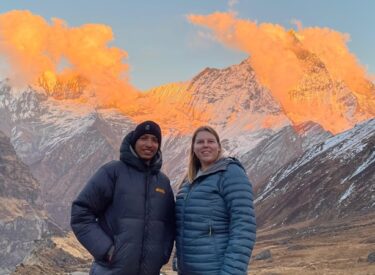
Ghorepani Poon Hill 4 Days

September Sale Book now for up to 60% off!
Annapurna Circuit Trek: Best Trails of the Region
Best price guarantee Learn More
Earn travel credits Learn More
- Hiking & Trekking
- Mountain Hikes
- Fully Guided
- Personalized
- Christmas & New Year

- Learn about the culture and lifestyle of the minimal life-living locals.
- Do a hike to Poon Hill for the vast mountain panorama and breathtaking sunrise view.
- Run into monasteries, gompas, mani walls, prayer flags, and temples.
- Be able to do one of the prestigious circuit treks in the world.
- Climb the daring Thorung La Pass, one of the most popular passes.
- Travel across the natural richness of the Annapurna Conservation Area.
- Explore the distant and rural villages of the Annapurna Region.
- Trek along the bold trail sided by forested areas, several rivers, streams, and waterfalls.
- Start with a scenic bus drive on a winding highway to Besisahar.
- Experience the fabulous views of Annapurna I, Dhaulagiri, Manaslu, Machhapuchhre, and other mountains.
- Introduction
- Day 1 Arrival in Kathmandu and Transfer to the Hotel (1400m- 4657ft)
- Day 2 City Sightseeing and Trek Preparation
- Day 3 Drive from Kathmandu to Besisahar (760m- 7hours)
- Day 4 Trek from Besisahar to Bahundanda (1,310m- 6hours)
- Day 5 Trek from Bahundanda to Jagat (1290m- 6hours)
- Day 6 Trek from Jagat to Dharapani (1920m- 5hours)
- Day 7 Trek from Dharapani to Chame (2630m- 6 hours)
- Day 8 Trek from Chame to Pisang (3,115m- 5hours)
- Day 9 Trek from Pisang to Manang (3,540m- 6hours)
- Day 10 Acclimatization Day at Manang
- Day 11 Trek from Manang to Yak Kharka (4050m- 5hours)
- Day 12 Trek from Yak Kharka to Thorong Phedi (4525m- 5hours)
- Day 13 Trek from Thorong Phedi to Muktinath via Thorong La Pass (5416m- 9hours)
- Day 14 Trek from Muktinath to Marpha (2665m- 6hours)
- Day 15 Trek from Marpha to Ghasa (2000m- 6hours)
- Day 16 Trek from Ghasa to Tatopani (1160m- 6hours)
- Day 17 Trek from Tatopani to Ghorepani (2775m- 8hours)
- Day 18 Trek from Ghorepani to Tikhe Dhunga via Poon Hill (1480m- 7hours)
- Day 19 Trek from Tikhedhunga to Nayapul and Drive to Pokhara (822m- 5hours)
- Day 20 Drive (7hours) or Flight (45 minutes) back to Kathmandu from Pokhara in your choice
- Day 21 Departure from Kathmandu
Want to read it later?
Download this tour’s PDF brochure and start tour planning offline
What's Included
- Accommodation
- Additional Services
- Optional Extras

Operated by
Sabbatical Explore Nepal
Number of tours
5 to 80 years old
Response time
less than 1 hour
Response rate
We offer meaningful and memorable trip experience in Nepal, Bhutan and Tibet. Trekking, climbing, spiritual and culture sightseeing, community hikes, safari and village tours are our popular package. We are happy to customize itineraries as per your plans and specification.
Your Peace of Mind Options
Cancellation policy.
A transparent overview of applicable fees.
Dates & Availability
Why book with tourradar.
- Flexible payment options
- Trusted and vetted operators
- Rated excellent on
- Best price guarantee
- 24/7 customer support
- Earn €50 in travel credits
To protect your payment and ensure your booking will be processed in Austria, never transfer or communicate outside of the TourRadar website or app.
- Upcoming departures
- September 2024
- October 2024
- November 2024
- December 2024
- January 2025
- February 2025
- August 2025
- September 2025
- October 2025
- November 2025
- December 2025
- Wednesday 18 Sep, 2024 Tuesday 8 Oct, 2024 English , German, Italian, French, Spanish, Chinese, Russian +6 more Filling Fast Multiple Room Types €1,401 Confirm Dates
- Get Instant Confirmation Thursday 19 Sep, 2024 Wednesday 9 Oct, 2024 English , German, Italian, French, Spanish, Chinese, Russian +6 more Filling Fast Multiple Room Types €1,401 Confirm Dates
- Get Instant Confirmation Friday 20 Sep, 2024 Thursday 10 Oct, 2024 English , German, Italian, French, Spanish, Chinese, Russian +6 more Filling Fast Multiple Room Types €1,401 Confirm Dates
- Get Instant Confirmation Saturday 21 Sep, 2024 Friday 11 Oct, 2024 English , German, Italian, French, Spanish, Chinese, Russian +6 more Filling Fast Multiple Room Types €1,401 Confirm Dates
- Get Instant Confirmation Sunday 22 Sep, 2024 Saturday 12 Oct, 2024 English , German, Italian, French, Spanish, Chinese, Russian +6 more Filling Fast Multiple Room Types €1,401 Confirm Dates
- Get Instant Confirmation Monday 23 Sep, 2024 Sunday 13 Oct, 2024 English , German, Italian, French, Spanish, Chinese, Russian +6 more Filling Fast Multiple Room Types €1,401 Confirm Dates
- Get Instant Confirmation Tuesday 24 Sep, 2024 Monday 14 Oct, 2024 English , German, Italian, French, Spanish, Chinese, Russian +6 more Filling Fast Multiple Room Types €1,401 Confirm Dates
- Get Instant Confirmation Wednesday 25 Sep, 2024 Tuesday 15 Oct, 2024 English , German, Italian, French, Spanish, Chinese, Russian +6 more Filling Fast Multiple Room Types €1,401 Confirm Dates
- Get Instant Confirmation Thursday 26 Sep, 2024 Wednesday 16 Oct, 2024 English , German, Italian, French, Spanish, Chinese, Russian +6 more Filling Fast Multiple Room Types €1,401 Confirm Dates
- Get Instant Confirmation Friday 27 Sep, 2024 Thursday 17 Oct, 2024 English , German, Italian, French, Spanish, Chinese, Russian +6 more Filling Fast Multiple Room Types €1,401 Confirm Dates
Good to Know
- Currency रू Nepalese Rupee Nepal
As a traveller from USA, Canada, England, Australia, New Zealand you will need an adaptor for types C, E, F, D, M. As a traveller from South Africa you will need an adaptor for types C, E, F.
- These are only indications, so please visit your doctor before you travel to be 100% sure.
- Typhoid - Recommended for Nepal. Ideally 2 weeks before travel.
- Hepatitis A - Recommended for Nepal. Ideally 2 weeks before travel.
- Cholera - Recommended for Nepal. Ideally 2 weeks before travel.
- Tuberculosis - Recommended for Nepal. Ideally 3 months before travel.
- Hepatitis B - Recommended for Nepal. Ideally 2 months before travel.
- Meningococcal meningitis - Recommended for Nepal. Ideally 1 week before travel.
- Yellow fever - Certificate of vaccination required if arriving from an area with a risk of yellow fever transmission for Nepal. Ideally 10 days before travel.
- Japanese B encephalitis - Recommended for Nepal. Ideally 1 month before travel.
- Unfortunately we cannot offer you a visa application service. Whether you need a visa or not depends on your nationality and where you wish to travel. Assuming your home country does not have a visa agreement with the country you're planning to visit, you will need to apply for a visa in advance of your scheduled departure.
- Here is an indication for which countries you might need a visa. Please contact the local embassy for help applying for visas to these places.
- For any tour departing before 14th November 2024 a full payment is necessary. For tours departing after 14th November 2024, a minimum payment of 25% is required to confirm your booking with Sabbatical Explore Nepal. The final payment will be automatically charged to your credit card on the designated due date. The final payment of the remaining balance is required at least 60 days prior to the departure date of your tour. TourRadar never charges you a booking fee and will charge you in the stated currency.
- Some departure dates and prices may vary and Sabbatical Explore Nepal will contact you with any discrepancies before your booking is confirmed.
- The following cards are accepted for "Sabbatical Explore Nepal" tours: Visa, Maestro, Mastercard, American Express or PayPal. TourRadar does NOT charge you an extra fee for using any of these payment methods.
- Your money is safe with TourRadar, as we only pay the tour operator after your tour has departed.
- TourRadar is an authorised Agent of Sabbatical Explore Nepal. Please familiarise yourself with the Sabbatical Explore Nepal payment, cancellation and refund conditions .
- Insurance Unless otherwise mentioned, TourRadar does not provide travel insurance. We do however recommend purchasing it through our tried and trusted partner, World Travel Nomads .
- Accessibility Some tours are not suitable for mobility-restricted traveller, however, some operators may be able to accommodate special requests. For any enquiries, you can contact our customer support team , who are ready and waiting to help you.
- Israel Tours
- 3 day Cultural Photography tours
- Asia December 2024 tours
- Ranthambore National Park tours
- South West England October 2024 tours
- Honshu October 2024 tours
- 5 Best Guided Backpacking Trips & Tours
Similar Tours
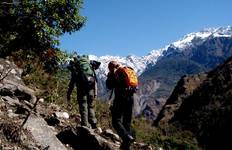
Keep Exploring Nepal
- 10 Best Nepal Trekking Companies & Tour Operators (with 31,613 Reviews)
- Things to carry while trekking in Himalayas
- 10 Best Hiking & Trekking Companies
- Your Guide to Planning a Private Hike 2024/2025
- Nepalese Himalayas - Best Mountains to Climb
- Best Hiking Tours in The World 2024/2025
- Nepal from Kathmandu
- Nepal Hiking & Trekking
- 21 days Nepal
- Operators in Asia
- Mount Annapurna
- Himalaya Mountains
- Annapurna Circuit Trek: Best Trails of the Region Tours in Nepal
- Hiking & Trekking Tours
- Himalaya Mountains Tours
- Mountain Hikes Tours
- Private Tours
- Fully Guided Tours
- Personalized Tours
- Christmas & New Year Tours
- Annapurna Circuit
- Nepal tours
Annapurna Circuit - 17 Days

Prices & Availability
Pay monthly & spread the cost of your next trip. learn more.
Monthly payments are only available for tours departing beyond 3 months.
- Fri 7 Feb 2025 > Sun 23 Feb 2025 Who's going? Available Best offer £1,011 Hold Space Book Tour
- Fri 14 Feb 2025 > Sun 2 Mar 2025 Who's going? Available Best offer £1,011 Hold Space Book Tour
- Fri 21 Feb 2025 > Sun 9 Mar 2025 Who's going? Available Best offer £1,011 Hold Space Book Tour
- Fri 28 Feb 2025 > Sun 16 Mar 2025 Who's going? Available Best offer £1,011 Hold Space Book Tour
Free Brochure Download
Uncover insider tips, hidden gems, and a detailed itinerary to enhance your solo adventure. Explore safely, meet new people, and make the most of every moment
Get in touch with a travel expert today!
Our experts are ready to perfect your trip with personalised advice on itineraries, transfers, and local tips.

Who is this trip for?
- Small Group
- Teenage Family
- Visit religious, cultural, natural, and historical monuments like Upper Pisang Monastery, Braga Monastery, Muktinath Temple, Pokhara valley (Phewa Lake, Mahendra Cave, Gupteswar Cave, Bat’s Cave, World Peace Pagoda, Sarangkot, David’s Fall, Mahendra Bridge, Bindawasini Temple), Durbar squares in Kathmandu valley, Swyambhunath, Pashupatinath, and Boudhanath
- Walk through the classic trekking route of Annapurna circuit, passing the sub-tropical to alpine vegetation, small ethnic settlements, rocky ridges, wide and deep yak pastures, green valleys, river valleys (Marshyangdi and Kali Gandaki), and numerous rickety suspension bridges
- Explore Semi Tibetan cultures, Himalayan way of living, traditional values of Manangi and Thakali people
- Pass: Thorong La (5416m/17769ft), the world’s widest pass which sits between Thorung Peak and Yakawa Kang
- Sightsee: Two major apple orchards (Bhratang in Manang and Marpha in Mustang), lustrous rhododendron backwoods, diverse flora, and fauna in Annapurna Conservation Area, Kali Gandaki River gorge (world’s deepest gorge), numerous waterfalls including Rupse (Myagdi) and Chyamje (Lamjung)
- Relax at the natural hot spring at Tatopani
Enjoy this 17 day private guided trekking adventure on one of the most famous routes in the world. The Annapurna circuit is challenging but also epic and really a once in a lifetime experience. You'll stay in hotels but mainly local tea houses on the trekking route. If there is no other traveller booked on your departure date than we can run the trip but it will involve a small additional charge if this is still the case at the time of departure. Please note food is not included in this trek.
If you are interested in a private tour then this operator offers a very competitive price - get in touch with our team to get a quote for your group.
What's Included
Please download the tour brochure for full details
Accommodation
Twin-share Hotel (3 Nights) Guesthouse (13 Nights)
Vegetarian options are available on all meals throughout the adventure.
Local Guide
This adventure is led by a local guide throughout. The main language of this adventure is English. Please contact us for other languages available.
Airport Transfers
Wifi is available during the adventure. In some areas and / or accommodation / transport Wifi may be free.
What's not included
International flights.
International flights to the starting point are not included.
Please ensure you are insured before you travel.
Please ensure you obtain the correct visa documentation before you travel.
Arrive at Tribhuwan International Airport Kathmandu
You will be picked up and welcomed by our airport representative and transferred to your hotel for check in. You will then be given further details about the program. There are no planned activities for the day so you can enjoy your stay at the hotel and take in its surroundings.
Drive from Kathmandu to Synge/Jagat (1100m) Duration: 8 hours
We will drive to Beshisahar. We then take a local jeep from Beshisahar to Syange. This drive gives you some insight of the rural people – their lifestyle and their culture. From Syange, we begin our trek. We’ll walk to Jagat. Overnight at Guesthouse.
Jagat to Dharapani (1960m) Duration: 6 hours
We will leave Jagat on foot. Our trail winds up to Chyamje. After crossing a suspension bridge, the trail takes us uphill through the Oak forest. We’ll continue walking for a while until it emerges into a valley. We pass the village of Kodo and ascend to the village of Dharapani. Overnight at Guesthouse.
Dharapani to Chame (2630m) Duration: 5 hours
The trail climbs along the mule track into a fir forest and then follows the river alongside the higher oak and maple trees. On the way you will be awe- struck by spectacular views of major Himalayan peaks. Overnight at Guesthouse.
Chame to Pisang (3300m) Duration: 5 hours
Our trial now follows a steep and narrow river valley winding through deep woodland. The view of Pisang peak and Annapurna II on our way is truly amazing. Overnight at Guesthouse.
Pisang to Manang (3570m) Duration: 4 hours
Today we will take the upper route to Manang via Ghyaru – Ngawal – Mungji. We will experience more breathtaking scenery as the towering, majestic peaks overwhelm our senses with panoramic views of Annapurna, Pisang peak, and several others. We will notice a change in the landscape and vegetation from today. The cold dry climate creates a much harsher environment. Our short visit to Barge monastery, the largest in the entire district of Manang will be memorable. Overnight at Guesthouse,
Manang - Acclimatization day
This day is set aside for acclimatization to the higher altitude. We’ll spend our time visiting the monastery with a side trip to Gangapurna Lake. We can also look around the local villages and visit the Himalayan Rescue Association Clinic. Overnight at Guesthouse.
Manang to Yak Kharka (4,110m) Duration: 3 - 4 hours
From Manang village, the trail crosses a stream, ascends to the village of Tenki above Manang, and then continues to climb out of the Marshyangdi Valley turning northwest up the valley of Jarsang Khola. We’ll then follow the valley northward, passing pastures and a scrub of juniper trees, as it steadily gains elevation. Further on we pass the small village of Ghunsa – a cluster of flat mud roofs just below the trailhead. Now the trail goes through meadows where horses and yaks contentedly graze. We cross the river on a wooden bridge and passan ancient Mani wall in a pleasant meadow before arriving at another small village – Yak Kharka. Gentle but gradual ascent is the key to avoiding altitude problems. Overnight at Guesthouse.
Yak kharka to Thorong Phedi (4,600m) Duration: 3 - 4 hours
We will make our way to the foot of the pass to Throng Phedi. This is a small yet busy settlement catering to the needs of tired trekkers and climbers. Groups such as ours use this point as a base camp. Some members of the group might want to hike to the High Camp today to make next day easier for them –although the Nepal Hiking Team have reservations about this. There is a tough day planned for tomorrow and we stop at Thorong Phedi in order to sleep soundly (rather than risk a less peaceful night in the higher altitude at High Camp). Overnight at Guesthouse.
Thorong Phedi to Muktinath (3800m) crossing over Thorong La Pass (5416m) Duration: 7/8 hours
We will make an early start on our climb to the pass. We need to be fresh for the initial stage of ascent is very steep. As we approach the peak the trail becomes slushy from melting snow. After making our way through rocky ridges, we arrive at the top of the pass (5416m). The top offers an indescribably magnificent 360 degree panorama of snow capped peaks extending northwards into Tibet. Looking back, we can see several peaks of Annapurna and in front of us is the beautiful gorge of Kali Gandaki. Our trail then descends steeply down to Muktinath (3800m) – an important pilgrimage sight for Hindus. It is a special place and home to many ethnic Tibetans and devout Buddhists. Overnight at Guesthouse.
Muktinath to Marpha (2670m) Duration: 6 hours
Our descent continues through the Kali Gandaki Valley to Marpha. Marpha is home to many apple orchids as well as all the various food products made from the fruit. Apple Brandy is a local specialty that you may be lucky enough to taste en route. Overnight at Guesthouse.
Marpha to Ghasa (2010m) Duration: 6 hours
We descend through the valley following the Kali Gandaki River to Ghasa. We walk along the bank of Kali Gandaki River. Overnight at Guesthouse.
Ghasa to Tatopani (1190m) Duration: 5 hours
Today, we will walk through the world’s deepest gorge in the Earth at Kopchepani; we then continue descending through the Kali Gandaki River valley to Tatopani. This place is famous for its hot springs. This is the best place to relax your body after a long days trek; we will have one more extra day here tomorrow to relax. Overnight at Guesthouse.
Tatopani to Ghorepani (2810m) Duration: 7 hours
Today is another big day. It will take about 7 hours to walk from Tatopani to Ghorepani. We climb about 1,620 meters up. From Ghorepani, we will be able to see Annapurna South, Himchuli and Tukuche Himal. We will pass a couple of Magar and Gurung villages on the trail. Overnight at Guesthouse.
Ghorepani to Pokhara Duration: 7-8 hours
Hike to Poon Hill (3210m) and trek to Nayapul then Pokhara, 7 hours hike and an hour drive This morning, we will get up early and hike to Poon Hill. From here you will see a superb view of the sunrise and a panoramic view of the Himalaya, including Mt. Dhaulagiri, Annapurna South, Fishtail, and others. After visiting Poonhill, we will come back to Ghorepani, have a hot breakfast, and trek down to Nayapul then short drive to Pokhara. Overnight at Hotel.
Pokhara to Kathmandu
Today you are heading to Kathmandu on a private vehicle/tourist bus that takes about 6-7 hours depending upon traffic conditions via Prithvi Highway. As you proceed further, you get to see the beautiful countryside along with the culture and lifestyle of the people outwardly. Once at Kathmandu; you’ll be transferred to your hotel. You can spend rest of the day relaxing and enjoying hotel facilities or just wander around the city making the overview of your whole adventure or clicking pictures as a way to preserve the memories of your visit to this small but majestic country.
If you are interested in extending the trip, there are many options such as Chitwan jungle safari, river rafting adventure, Kathmandu shopping tour, mountain biking and other activities. Breakfast Included. Overnight at Hotel
Kathmandu - Farewell
Approximately 3 hours before the scheduled flight a representative from Nepal tour operator will take you to the airport. Breakfast included.
Customer reviews & ratings
We did the Annapurna circuit. The whole experience was fantastic. Everything was arranged from the hotel at the start to the tea houses along the way. An unforgettable experience. The guide and porter were superb. Indira takes care of everything.
Hiking the Annapurna Circuit with Icicles was an incredible experience. I have done multiple big trips with other companies and never had the truly great service Icicles provided us. I wouldn't hike with anyone else in Nepal now! The hotels and meals provided before and after the trek were very luxurious but also all teahouses on route were very comfortable - the guides and porters were amazing and could not have done more to ensure our safety and comfort. After a not so positive experience doing Kilimanjaro the year prior - this experience was totally different. The focus on safety the guides had was very comforting and their experience spoke for itself ! From looking after us when we became unwell to ensuring we kept our spirts up on long hike days. My guide 'Miss Lok' was probably the most patient man I have ever met and we will miss him so much - I hope he thinks of me whenever he sees a cinnamon roll ! Sangil also was great and went above and beyond taking group members to the dentist even! The company being female ran by Indra from Kathmandu is amazing and you can tell the attention to detail from her is behind why the trip was so great. We got duffel bags, hats and even tshirts and maps all included! If your thinking about trekking in Nepal please book with Icicles you won't regret it! Thank you Icicles
Essential trip information
Our Important Notes and Packing List cover all essentials, from necessary equipment to inclusions, ensuring you're fully equipped and informed for this extraordinary adventure and more.
Frequently asked questions
What should i pack.

Still have questions?
Can't find the answer you're looking for? Please chat to our friendly team.
Why book with us
Help change the world.
We collaborate with local businesses and communities.
Best Price Guaranteed
We won't be beaten on price. If you find this adventure at a lower price please get in touch!
You're In Good Hands
We work with trusted tour operators around the world.
You're spoilt for choice
We have the best choice of adventures on the market.
What Our Customers Say
Trust the adventure people.
Communication was excellent both by email and over the phone, everyone I had contacted followed and actioned my request or answered my question politely and efficiently.
Would definitely recommend this company.
The staff are super helpful and friendly and always answer e-mails as soon as they can.
Trip achieved all my expectations!
The tour that I booked with The Adventure People met all my expectations. The local agent in Vietnam kept in regular contact with me during my trip. All of the connections worked perfectly. The hotels were all of a good standard and comfortable as well as being in a good location. Would definitely use them again
Similar adventures

Everest Base Camp & Gokyo Lakes Trek - 19 Days

Everest Base Camp Trek - 15 Days

Annapurna Sanctuary - 15 Days

Annapurna Circuit Trek - 18 Days
Was this page helpful .
If you need information about a tour or a booking, please contact us instead.
Sign up for our deals
Stay up to date with our new latest deals & special offers.
The Adventure People has been rated excellent by its customers
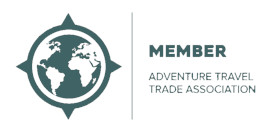

Annapurna Circuit
Activity level, kathmandu, nepal.

Embark on the Annapurna Circuit in Nepal
Join The Explorer’s Passage (TEP) for one of the most extraordinary treks on the planet: the Annapurna Circuit. Stay at local tea houses as you follow this ancient Himalayan trade route, climbing through jungle-like terrain and rice fields, past canyons and waterfalls, and trekking among snowy peaks at Thorung La pass (17,768 feet / 5,415 meters in elevation). From the bustling streets of Kathmandu to the serene mountain villages of the Gurung people, this adventure offers diversity in culture and landscape, and the opportunity to meet other adventurers from across the globe. The Annapurna Circuit is truly a must for any serious trekker.
Trip Highlights
Explore the busy streets of Kathmandu, a city that blends ancient traditions with bustling modern life. Dive into the rich tapestry of Nepalese culture, including a guided tour of UNESCO World Heritage Sites, the Pashupatinath and Boudhanath stupas.
Follow an ancient trade route on one of the oldest treks in the Himalayas. The trails you’ll traverse have been traveled for centuries by traders exchanging goods between Nepal, Tibet, and India, adding a sense of timeless adventure to your trekking experience.
Trek over the challenging Thorong La pass (17,768 feet / 5,415 meters), the highest point on the Circuit, and be rewarded with views of stunning, snow-capped peaks. This iconic pass is the highest point on the Annapurna Circuit trek, offering a test of endurance and a reward of unparalleled panoramic views.
Visit the scared temples of Muktinath, a holy place for Hindus and Buddhists. Revered by both Hindus and Buddhists, Muktinath holds deep spiritual significance and offers a profound cultural experience amidst the Himalayan splendor.

Let’s Plan Your Trip Today:
Click below to download our Sample Annapurna Itinerary
From $4,295 USD per person
Single Supplement for Hotel: from $795 USD
More questions? Read more about pricing here
Start dates
Custom Dates Available
To inquire about a custom date, please contact us !
18 Days / 17 Nights
Trekking duration is up to 11 days. For more information about itinerary options, please review the section about trip customization on this webpage.
Accommodations
Relax in comfort & luxury
In Kathmandu, Besisahar, and Pokhara, choose between 3.5-Star or 5-Star hotels. While hiking the Annapurna Circuit, guests stay in tea houses, which are comparable to many other mountain lodges/huts in other parts of the world.
*Read more about your accommodations on the trek
max. group size
Fixed Group Departures: 12 Guests
Private Group Departures: 20 Guests
ACTIVITY LEVEL
Activities: multi-day hiking on the Annapurna Circuit.
Elevation: Start: 2,493 feet / 760 meters; End: 17,768 feet / 5,415 meters
Daily trekking distance: ~4 to 12.4 miles / ~ 6.4 to 20 kilometers per day
Total trekking distance: ~79 miles / 127 kilometers
*Please refer to our Trip Activity Level Guide for more information
Sample Trip Itinerary
Want more information download a detailed itinerary..
Itineraries include detailed descriptions of each day, tips on travel arrangements, regional highlights, and more. It’s the perfect resource to help you choose!

Day 1: Arrival in Kathmandu, Nepal
Namaste, and welcome to Nepal! Upon arrival in Kathmandu, transfer to your hotel. In the evening, enjoy a welcome dinner where you will meet your guide and your fellow travelers.
Accommodations: Hotel Marshyangdi
Day 2: Drive to Besisahar
Start your first full day in Nepal with a long, winding drive. As you leave Kathmandu, the route curves through the hills, following rivers and climbing higher and higher through rural Nepal until you reach Besisahar, the gateway to the Annapurna Circuit.
Accommodations: Gateway Himalaya Resort
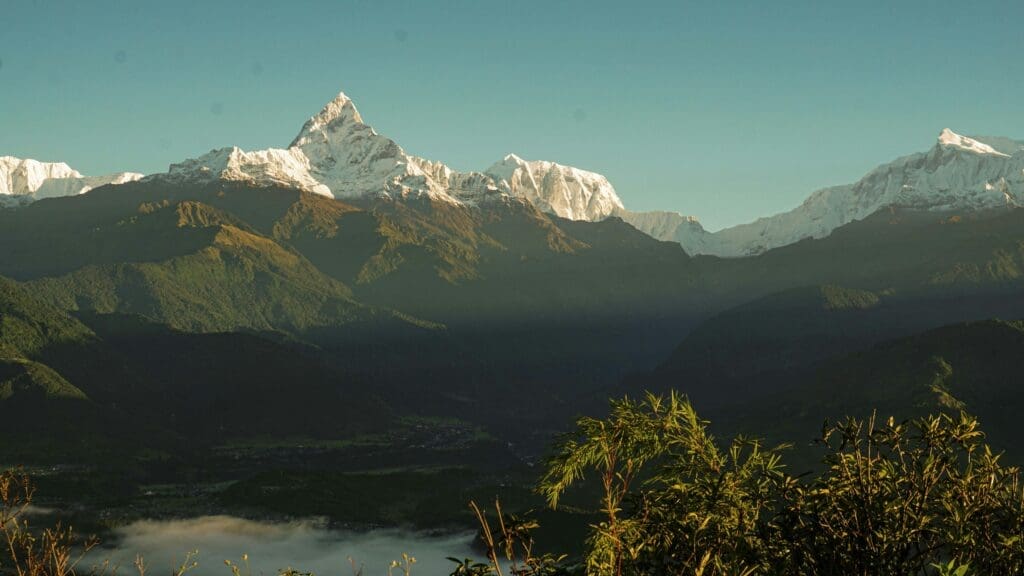
Day 3: Drive to Manang
Buckle up – today you will board a 4-wheel drive vehicle and travel the bumpy road to Manang on a nine hour tour through mountain villages, taking in stunning views of waterfalls and jagged, snowy peaks. Stop at the large village of Chame to explore the shops and teahouses before continuing up to the plateau, where you will stay at your first guest house.
Accommodations: Tea House
Day 4: Day in Manang; Optional Hike to Gangapurna Glacier Lake
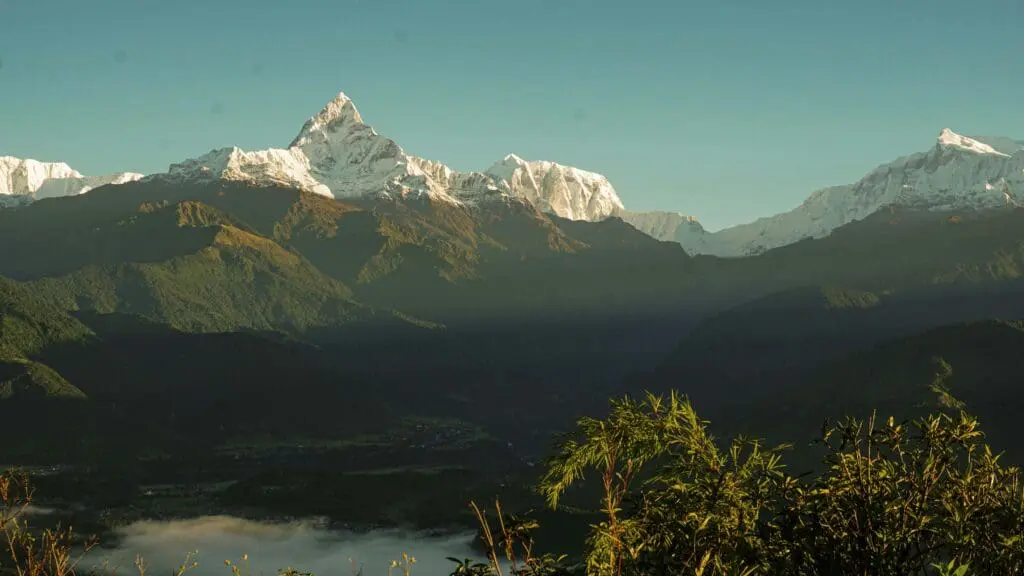
Day 5: Acclimatization Hike to Ice Lake
Day 6: start the annapurna circuit; trek to tilicho base camp.
Accommodations: Tea house
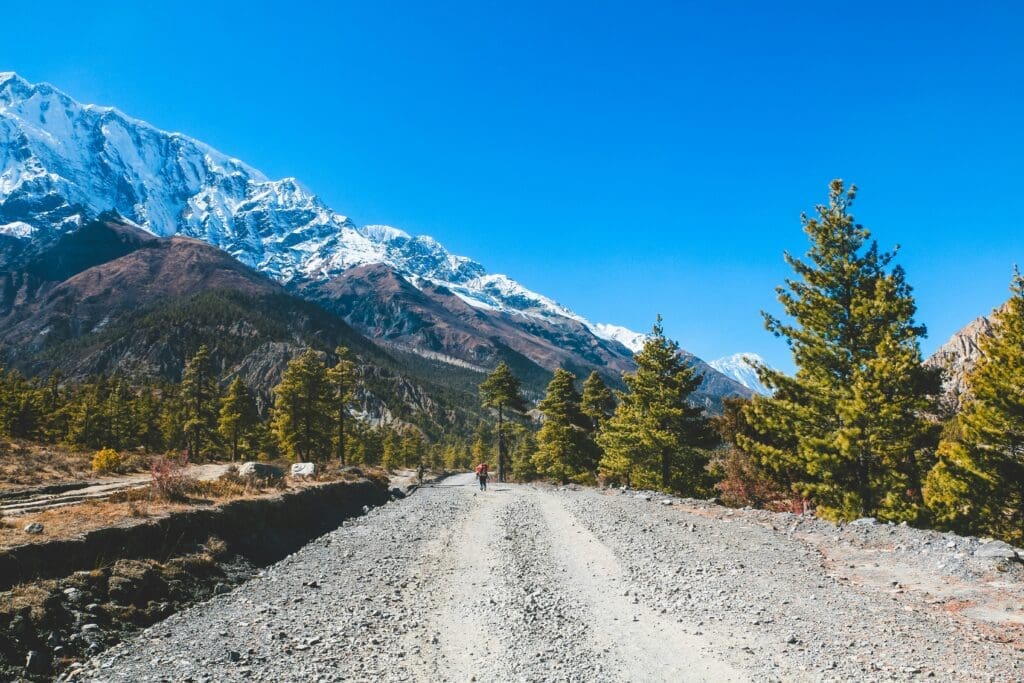
Day 7: Trek to Tilicho Lake
Day 8: trek to leder.
Day-hike distance: approximately 11.5 miles/18.5 kilometers (5-6 hours).
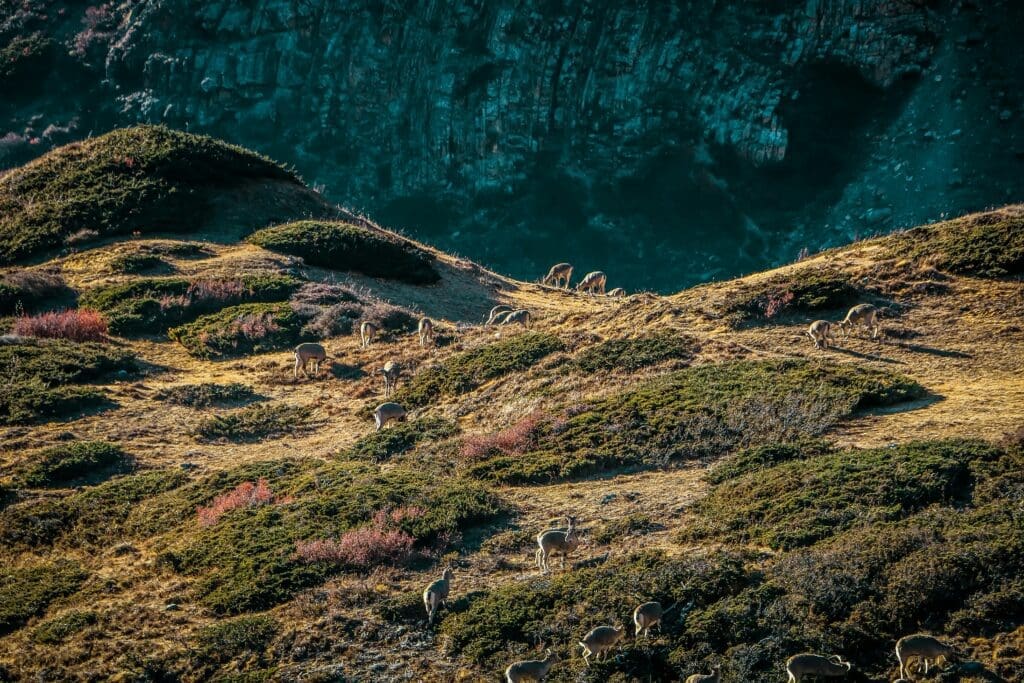
Day 9: Trek to Thorong Phedi
Day 10: trek through thorong la pass to muktinath.
Daily trekking distance: approximately 10 miles/16.4 kilometers (5-6 hours).

Day 11: Muktinath Temple and Tatopani
Day 12: trek to ghorepani.
Daily trekking distance: approximately 10 miles/16 kilometers (5-6 hours).
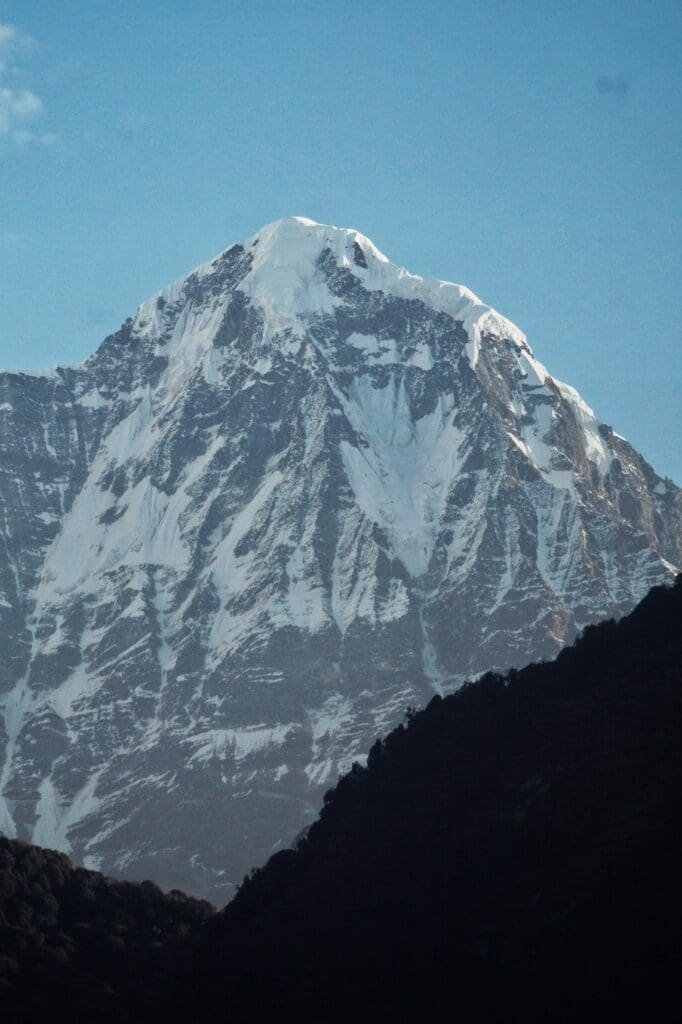
Day 13: Trek to Poon Hill and Tadapani
Daily trekking distance: approximately 6.9 miles/11.2 kilometers (5-6 hours).
Day 14: Trek to Ghandruk
Daily trekking distance: approximately 6 miles/9.7 kilometers (6-7 hours).
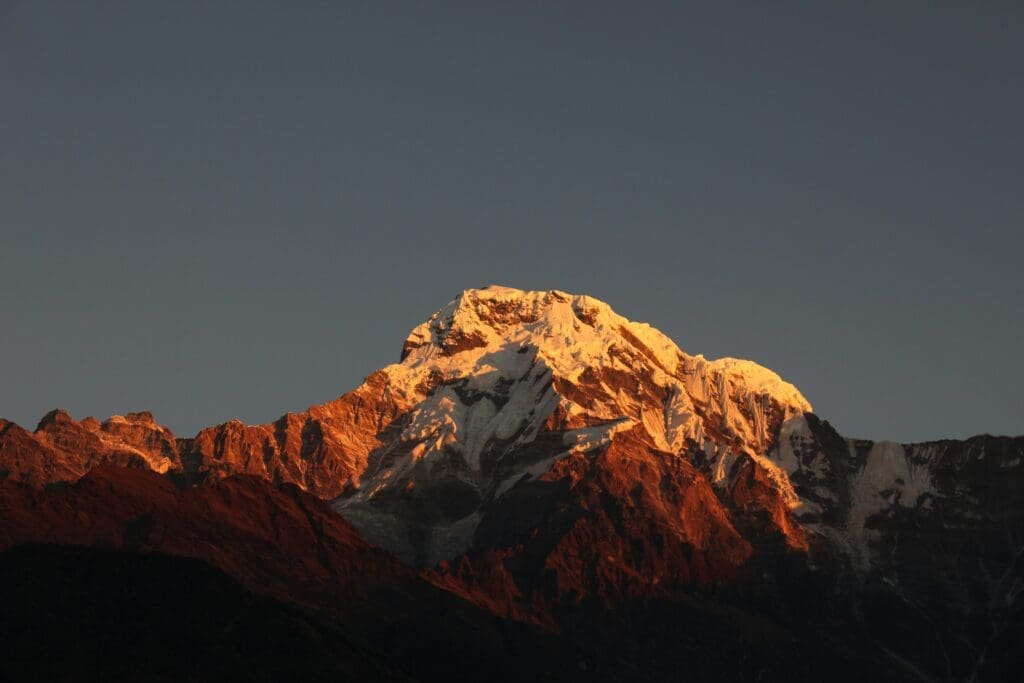
Day 15: Drive to Pokhara
Accommodations: Hotel Barahi
Day 16: Return to Kathmandu, Nepal
Say goodbye to the beautiful lake city of Pokhara and start the eight hour drive to Kathmandu. Upon arrival in Kathmandu the rest of your day is free.
For dinner you could seek out an authentic thali. With variations common to much of South Asia, it is a warm curry dish of rice, lentils, meat, and vegetables. You’ve certainly earned a hearty meal after so many days of trekking!
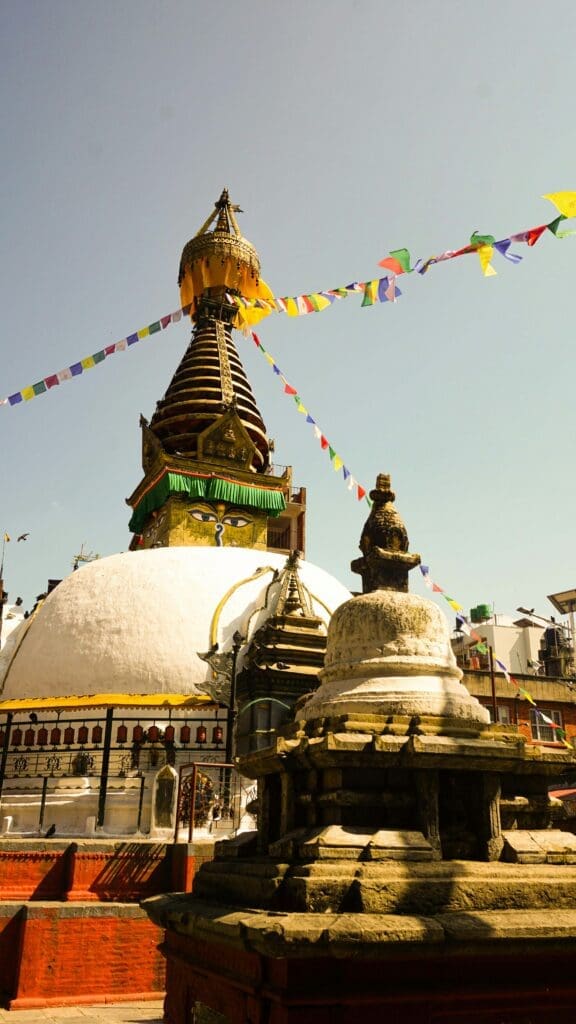
Day 17: Explore Kathmandu
Day 18: final day in nepal.
Congratulations on an awe-inspiring journey! It’s time to say farewell to Nepal and its amazing people, mountains, and nature. On your way home you will have plenty of time to plan your next adventure in this wonderful country. Until next time!
Accommodations: N/A
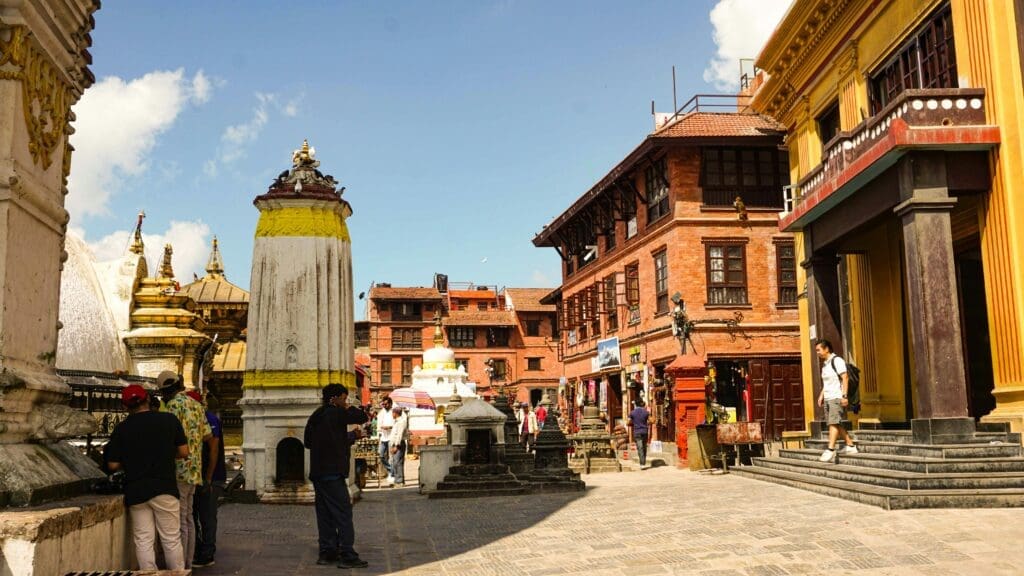
Customizing Your Annapurna Trek
Are you interested in another activity or destination in Nepal that isn’t listed above? Planning to spend extra time in the region, or interested in specific travel dates? No problem. As experts in tailored trip planning, we can weave your interests and your timeframe into our customizable itineraries so that every detail of your extraordinary trip unfolds just the way you want it to. Click the options below to learn more:
With The Explorer’s Passage, you can choose between a variety of additional activity options in Kathmandu:
- Day hikes to Shivapuri Nagarjun National Park or Nagarjun Forest Reserve.
- Short treks to places like Nagarkot or Kakani for panoramic views of the Himalayas.
- Mountain Biking through the Kathmandu Valley countryside or on trails near Shivapuri Nagarjun National Park.
- Cooking Classes: Learn to cook Nepali cuisine with a local chef.
- Thangka Painting Workshops: Take a workshop to learn the traditional art of Thangka painting.
- Yoga and Meditation Retreats: Join a retreat in Kathmandu or nearby areas like Kopan Monastery.
- Bhaktapur: Explore this ancient city known for its well-preserved heritage and architecture.
- Changu Narayan: Visit the oldest Hindu temple in the Kathmandu Valley.
While in/around Nepal, you can choose to add on one or several of the following:
- Everest Base Camp Trek: A classic trek offering stunning views of Everest and the Khumbu region.
- Lumbini: Birthplace of Lord Buddha, featuring ancient temples, monasteries, and a peaceful atmosphere.
- White Water Rafting: Experience thrilling rapids on rivers like the Trishuli, Seti, and Bhote Koshi.
- Chitwan National Park: Explore the jungle on elephant-back safaris, jeep tours, or canoe rides to spot rhinos, tigers, and exotic bird species.
- Bardia National Park: A remote and less-visited park offering excellent wildlife viewing opportunities.
- Everest Experience Flight: Take a scenic flight from Kathmandu for close-up views of Mount Everest and other Himalayan peaks.
In addition to their time in Asia, many travelers choose to add in other destinations to their trips, including (but not limited to) some of the following:
Contact us today to get started customizing your dream trip to Nepal!
Hear what travelers are saying:

Trip Accommodations
5 star accommodations, 3.5 star accommodations.
- Accommodations on the Annapurna Circuit
Gateway Himalaya Resort | Besisahar, Nepal
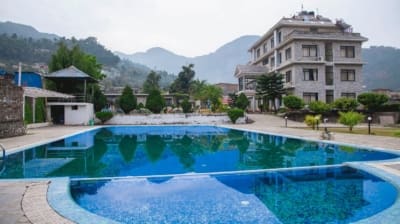
Gateway Himalaya Resort in Ghanpokhara offers a luxurious retreat with its 4-star accommodation, designed to provide an exceptional stay amidst the breathtaking landscapes of the Himalayas. Each room in this elegantly appointed resort features modern amenities, including air conditioning, free WiFi, and a private bathroom, ensuring both comfort and convenience. Guests can unwind on the spacious terrace, where panoramic views of the majestic Himalayan peaks create a stunning backdrop for relaxation. For a more social experience, the resort’s bar provides a cozy and stylish setting to savor a variety of beverages and unwind after a day of exploration.
Gateway Himalaya Resort website
Hotel Barahi | Pokhara, Nepal
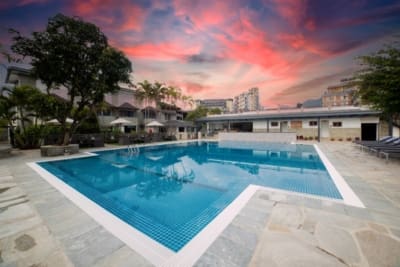
Named for the island temple of Barahi the hotel offers fine Nepali hospitality and luxury. Four room types (Deluxe, Super Deluxe, Executive Deluxe, and Suites), each include a buffet breakfast, air conditioning, wifi, and some offer a private balcony with mountain or city views. Visit the onsite dining room, courtyard cafe, or bar for local and international cuisine. After your long trek, relax in the outdoor pool or spa.
Hotel Bahari website
Hotel Marshyangdi | Kathmandu, Nepal

Located in the attractive Thamel District and close to many city attractions, Hotel Marshyangdi is owned and operated by a family from Manang. Manang is a mountainous region of Nepal, and Marshyangdi means ‘raging river’ in the local Manangi dialect.
All rooms are air conditioned with en-suite bathrooms and internet available. The property also features a relaxing courtyard restaurant, a bar, and a café. Finally, breakfasts at the hotel are included during your stay.
Hotel Marshyangdi website
During the trekking portion of the adventure, the accommodations will be in tea houses that offer dormitory-style rooms with single and double bunk beds, comparable to many other mountain lodges/huts in other parts of the world.
The tea houses are typically equipped with running cold water and shared bathrooms in a separate section. At most of them, there are propane-fueled hot showers available to use for a small fee. It is usually possible to charge personal electronic devices in the common/dining areas, however they also charge a small fee for this.
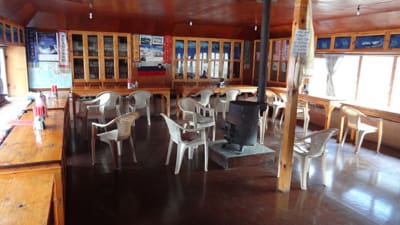
Frequently Asked Questions
Looking for something.
Check here for our Frequently Asked Questions for the Annapurna Trek, and if you can’t find the answer you are looking for then send us a message . Click the button below to access our general FAQ section!
The standard duration is around 15-20 days, depending on the route taken and individual hiking pace.
The best times are generally during the spring (March to May) and autumn (September to November) seasons when the weather is mild and clear, offering the best mountain views.
It is considered moderately challenging. The trek involves high altitudes, with Thorong La Pass (5,416 meters / 17,769 feet) being the highest point. Proper acclimatization and physical fitness are essential.
Yes, trekkers need to obtain two permits: the Annapurna Conservation Area Permit (ACAP) and the Trekkers’ Information Management System (TIMS) card. These can be obtained through registered trekking agencies or directly from the Nepal Tourism Board in Kathmandu.
Accommodation ranges from basic teahouses to more comfortable lodges in popular trekking villages. Rooms are typically twin-sharing with basic amenities such as beds, blankets, and sometimes hot showers (for an extra charge).
Essential items include sturdy hiking boots, warm clothing layers, a good quality sleeping bag, trekking poles, waterproof jacket and pants, sunscreen, sunglasses, and a first aid kit. Pack light but ensure you have all necessary gear for varying weather conditions.
It’s recommended to drink purified or boiled water, which is available at teahouses along the trail. Avoid drinking untreated water from streams or taps to prevent waterborne illnesses.
Image Gallery
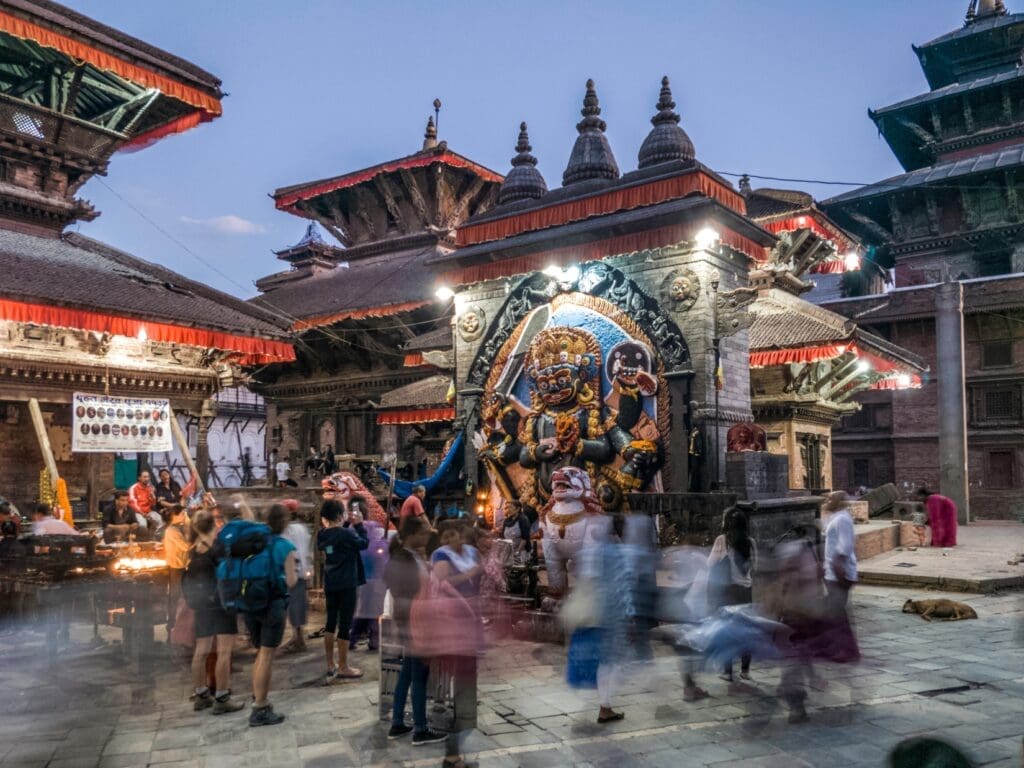
Trip Support
There is no other operator in the travel industry that will provide the same level of personal attention to your travel experience., personal attention & preparation before every trip.
There is no other operator in the travel industry that will provide the same level of personal attention before your adventure in Nepal. We get very involved with our travelers before each trip, by offering a series of pre-planning calls in the months and weeks before departure. This provides you with an opportunity to hear directly from us on preparation, trip experience, as well as training. It also gives you the platform to ask questions about any aspect of the trip.
Staff Support & Logistics
Our knowledgeable support staff take care of the details of your in-country transportation, lodging, meals, cultural tours, and activities. We’ve even scheduled in a bit of free time for you to explore, relax, shop, or eat on your own. When you travel with The Explorer’s Passage, we ensure that every detail is handled.
Sustainability and Responsible Travel
Check out our detailed educational content on the Top Three Treks in the Himalayas , written by our adventure team. The article provides a complete overview of everything that you need to know about this amazing journey in Nepal.
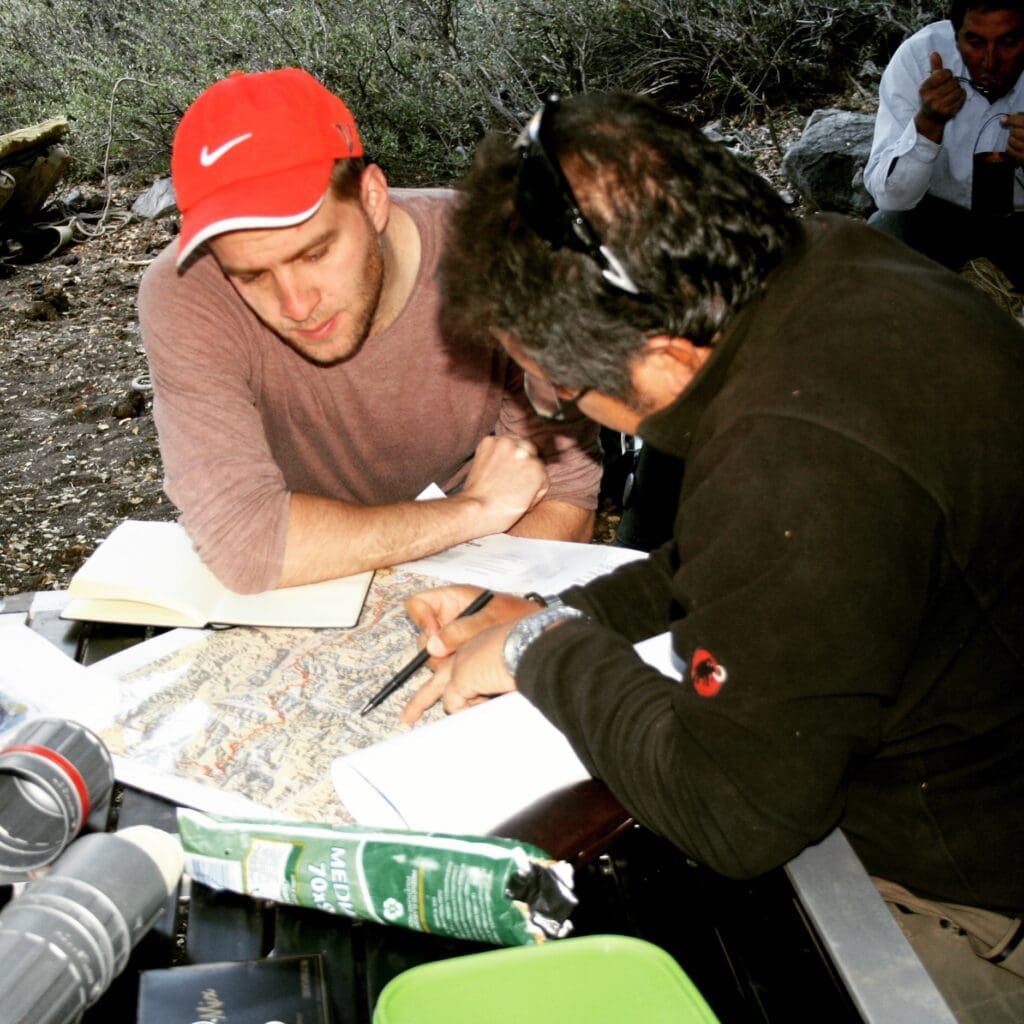
More Trip Inspiration:

The Lost City Trek
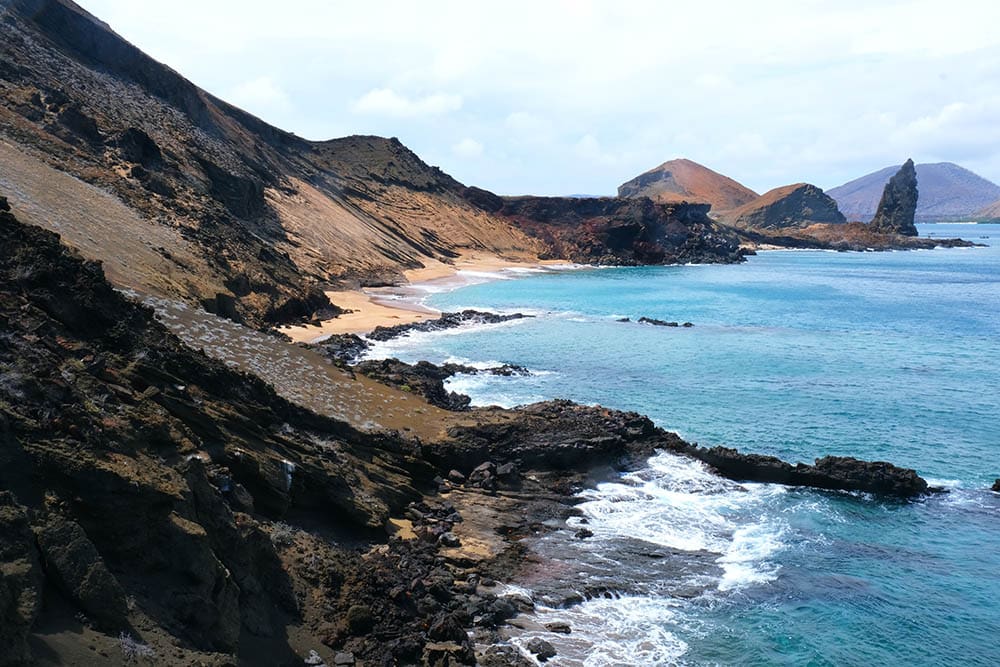
Galapagos Islands Cruise
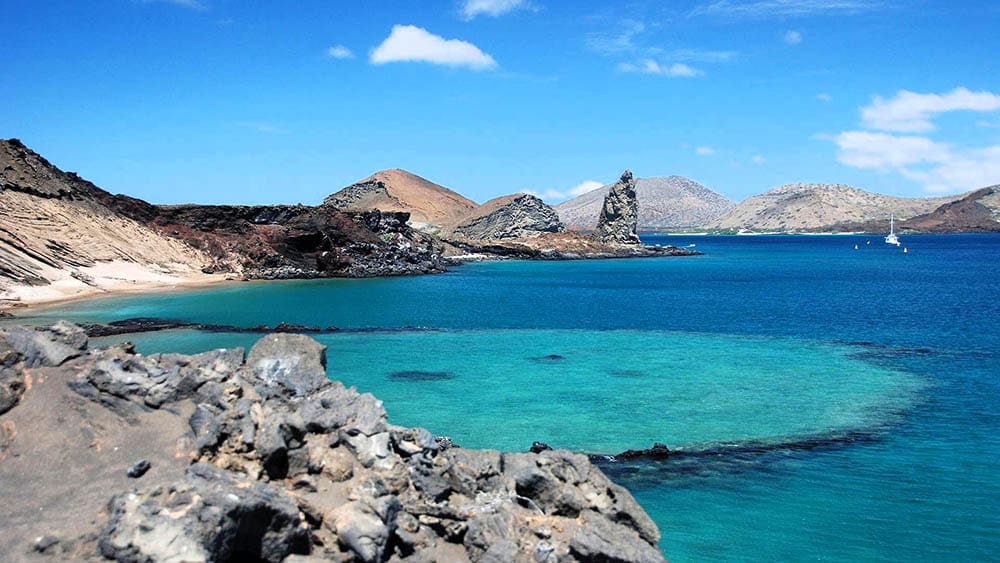
Galapagos Safari Camp
We look forward to helping you plan your next big adventure, (855) 208-6800, [email protected].
Newsletter Sign-Up

From Kathmandu: Annapurna Circuit Trek With Accommodation
Set out on a breathtaking 16-day journey through the heart of the Himalayas with the Annapurna Circuit Trek from Kathmandu. This captivating adventure immerses travelers in the rich cultural tapestry of Nepal, offering opportunities to engage with local communities and witness the region’s stunning natural beauty. From the serene Manang Valley to the challenging Thorong-La Pass , the trek promises an unforgettable experience that combines comfortable accommodations, carefully curated meals, and the guidance of an experienced English-speaking guide . Whether you’re a seasoned trekker or a first-time adventurer, this comprehensive package is designed to ensure your safety and satisfaction throughout the journey.

- A 16-day adventure through diverse landscapes in Nepal, from Kathmandu (1,400m) to the challenging Thorong-La Pass (5,416m).
- Priced at $1,317 per person, with a limited group of 15 travelers and a live English-speaking guide included.
- Accommodation options include a mix of standard hotels in cities and cozy teahouses during the trek, with twin-sharing rooms and some meals included.
- Opportunities to explore traditional Thakali villages, interact with the Manangis ethnic group, and engage with local Buddhist cultures and practices.
- Stunning mountain vistas of the Annapurna, Dhaulagiri, and Manaslu ranges, as well as picturesque alpine lakes and dramatic landscapes along the way.
Trek Overview and Pricing

The Annapurna Circuit Trek is a renowned 16-day adventure that takes participants on a captivating journey through the diverse landscapes of Nepal.
Priced at $1,317 per person, this small group experience, limited to 15 travelers, offers a live English-speaking guide to lead the way.
Booking can be done with a reserve-now-pay-later option and free cancellation up to 24 hours in advance.
The trek covers an impressive range of altitudes, from Kathmandu at 1,400 meters to the Thorong-La Pass at 5,416 meters, showcasing Nepal’s natural beauty and cultural heritage along the way.
Itinerary Highlights
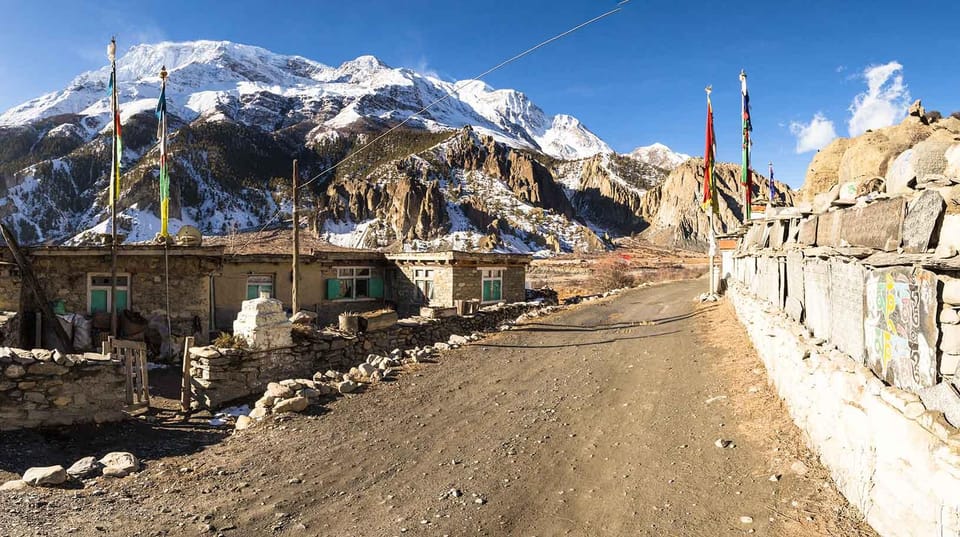
The Annapurna Circuit Trek ‘s itinerary highlights a remarkable 16-day journey , commencing with participants’ arrival in Kathmandu at 1,400 meters.
The next day, the trek begins with a drive to Besi Shahar and onward to Syange or Jagat at 1,300 meters.
Over the following 13 days, trekkers will traverse diverse landscapes, including Dharapani, Chame, Pisang, Manang Valley, Thorung Phedi, and the iconic Muktinath.
The highlight is the challenging but rewarding crossing of the Thorong-La Pass at 5,416 meters on Day 10.
Plus, a sunrise trek to Poon Hill at 3,193 meters offers stunning panoramic views on Day 13 before the trek concludes with a departure from Kathmandu on Day 16.
Cultural Engagement

Along the Annapurna Circuit Trek , participants have the opportunity to enjoy the rich cultural tapestry of the region.
They’ll explore traditional Thakali villages , where they can experience local customs and interact with the Manangis , a distinct ethnic group.
Visitors can observe ancient monasteries , witness spiritual practices, and learn about the importance of Buddhism in the daily lives of the people.
This cultural engagement allows trekkers to gain a deeper appreciation for the resilience and adaptability of the mountain communities they encounter.
It’s a chance to bridge cultural divides and forge meaningful connections with the local population.
Scenic Views

Towering peaks and serene landscapes captivate trekkers as they navigate the Annapurna Circuit . Hikers are treated to awe-inspiring vistas of the Annapurna, Dhaulagiri, and Manaslu mountain ranges.
The trek offers a diverse array of scenic delights:
- Panoramic views of the snow-capped Himalayan giants
- Picturesque Manang Valley, nestled in the heart of the Annapurnas
- Tranquil alpine lakes , such as the turquoise-hued Braga Lake
- Dramatic landscapes, including steep canyons and rugged rock formations
- Serene monasteries and ancient Buddhist sites, blending culture and nature
These breathtaking sights make the Annapurna Circuit an unforgettable experience for adventure seekers and nature enthusiasts alike.
Included Amenities
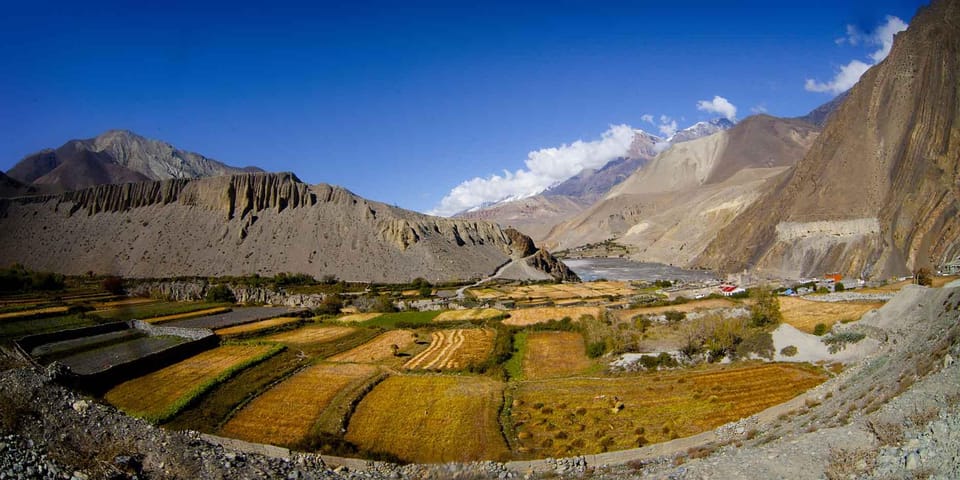
Comprehensive transportation arrangements, from airport pickups to scenic bus journeys and shared local rides, provide seamless logistics for the Annapurna Circuit trek.
Accommodation during the trek is in standard hotels in Kathmandu and Pokhara, and cozy lodge/mountain teahouses along the way, all on a twin-sharing basis.
Meals are included, with breakfast provided in the cities and some meals during the trek.
The trek also includes the services of a certified English-speaking local guide , all required permits, and a first aid kit for safety and support.
With these comprehensive inclusions, trekkers can focus on seeing the stunning natural beauty and cultural experiences of the Annapurna region.
Accommodation Options

Accommodation options along the Annapurna Circuit trek encompass a variety of comfortable lodgings to suit the needs of trekkers.
Enjoy a mix of standard hotels in Kathmandu and Pokhara, as well as cozy lodge and mountain teahouses during the trek itself. Expect twin-sharing rooms and some included meals, ensuring a balance of convenience and culture .
Key highlights of the accommodation experience include:
- Scenic mountain backdrops
- Opportunities to interact with local communities
- Comfortable beds and basic amenities
- Hearty, locally-sourced cuisine
- Shared facilities that foster camaraderie among fellow trekkers
Trekking Recommendations

Experienced trekkers recommend preparing thoroughly for the Annapurna Circuit trek , as the high-altitude journey requires physical fitness and proper acclimatization .
It’s crucial to pack warm clothing, sturdy trekking gear, and essential supplies like water, snacks, and sunscreen.
Respect local customs by avoiding smoking, alcohol, and plastic bottles. Ensure you have adequate travel insurance in case of emergencies.
Carrying cash for personal expenses is advised, as are rest days for acclimatization.
While the trek isn’t suitable for children, pregnant women, or those with mobility issues, the diverse landscapes, cultural engagement, and stunning views make it a rewarding experience for fit and adventurous travelers.
Trek Suitability

The Annapurna Circuit trek isn’t suitable for everyone. While the stunning landscapes and culture make it an alluring adventure, it’s essential to consider your physical abilities and health conditions before embarking on this challenge.
This trek isn’t recommended for:
- Children under 12
- Pregnant women
- Individuals with mobility impairments
- Those with heart problems
- Anyone over 254 lbs (115 kg)
Proper preparation, including acclimatization, appropriate gear, and respecting local customs, is crucial.
Travelers should also ensure they’ve adequate travel insurance and carry sufficient cash for personal expenses during the trek.
Frequently Asked Questions

What Is the Average Temperature During the Trek?
The average temperature during the Annapurna Circuit Trek varies greatly depending on the season and altitude. Daytime temperatures typically range from around 10°C (50°F) at higher elevations to 20°C (68°F) in the valleys.
Are There Any Medical Facilities Along the Trekking Route?
There are basic medical facilities and teahouses along the Annapurna Circuit route, but trekkers should bring essential medications and prepare for emergencies, as medical care may be limited in remote areas. It’s crucial to have comprehensive travel insurance.
Can I Customize the Itinerary to Suit My Preferences?
Yes, the itinerary for the Annapurna Circuit Trek can be customized to suit individual preferences. The tour operator allows flexibility in the trek schedule and activities to accommodate guests’ specific interests and fitness levels.
Is Travel Insurance Mandatory for This Trek?
While travel insurance isn’t mandatory, it’s highly recommended for the Annapurna Circuit Trek. It provides essential coverage in case of medical emergencies, trip cancellations, or other unforeseen circumstances that could arise during the high-altitude trekking adventure.
How Can I Prepare for the High-Altitude Sections of the Trek?
To prepare for the high-altitude sections, gradually acclimatize by taking rest days, drink plenty of fluids, avoid alcohol, and walk at a slow pace. Proper training and packing the right gear can also help manage the challenges of high-altitude trekking.
Not for you? Here's more of our most recent tour reviews happening neaby
- Nepal: Nar Phu and Tilicho Lake Trek
- Kathmandu: 18-DAY Annapurna Circuit Trek With Tilicho Lake
- Annapurna Circuit Trek
- From Kathmandu : 5- Days Short Tilicho Lake Trek
- From Kathmandu: 12 Day Tilicho Lake Trek
- From Kathmandu Budget: 5 Day Short Tilicho Lake Trek
- From Kathmandu: 5 Day Short Tilicho Lake Trek
- Manaslu Circuit Trek
- Nar Phu Valley With Thorong La Pass Trek
- Nar Phu Valley Trek – 12 Days
The Annapurna Circuit Trek from Kathmandu offers an unforgettable 16-day adventure through Nepal’s breathtaking landscapes. Priced at $1,317 per person, the trek includes accommodation, local meals, and comprehensive transportation, ensuring a comfortable and safe journey. Travelers can enjoy the region’s rich culture, explore stunning sites, and experience the challenge of the Thorong-La Pass , making this trek a must-do for outdoor enthusiasts.
Similar Posts

Half Day Private Wine Tasting Tour in Malibu

Chania: Sailing Cruise With Snorkeling & Meal

Private 4 Hours North Lagoon: Traditional Venetian Boat Tour

Tanah Lot Private Tour
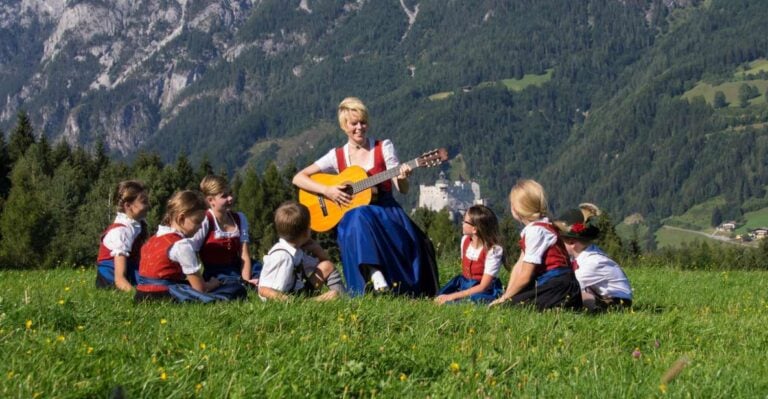
Salzburg: Private Eagles Nest and the Sound of Music Tour

Agadir : City Sightseeing Tour

IMAGES
VIDEO
COMMENTS
Annapurna Circuit Tours & Trips 4.5 stars on (6,739 reviews) View Tours Choose from 50+ Annapurna Circuit tours ; 450+ verified reviews from TourRadar travelers ; 24/7 customer support ; 10 best Annapurna Circuit tour packages ...
Call us: +977 9841 392186 (Arjun Pandey), +977 98510 31090 (Rajendra Lamichhane) We have redesigned the Annapurna Full Circuit Trek Itinerary for 2024 and 2025. Booking of this package is available at the lowest cost. Grab the best deals today.
1 Tour in Annapurna Circuit. Tour length. Price per day. 10 days. From $87. Choose from the best tour companies in Annapurna Circuit. Find the right tour operator for your trip to Annapurna Circuit, and read 56945 reviews from our customers.
Trek through the incredible Annapurna region and be awed by the Nepalese Himalayas. These snow-capped peaks, mist-shrouded valleys, isolated communities and remote monasteries will inspire those with a bold spirit and a yearning for a definitive nature experience. Reach altitudes of more than 5000 metres, discover the ancestral traditions of ...
The Annapurna Circuit Trek presents a remarkable and incomparable experience for all trekkers seeking a professional adventure. Spanning across four districts, namely Lamjung, Myagdi, Manang, and Mustang, and covering a vast distance of 160-230 kilometers, this trek provides the opportunity to explore the diverse natural vegetation, cultural beliefs, landscapes, altitude, trail, pristine ...
Day Six On The Annapurna Circuit Itinerary: Upper Pisang to Ngawal. Upper Pisang (3310m) to Ghyaru (3730m): 5 km hike which takes 3 hoursGhyaru (3730m) to Ngawal (3680 m): 5 km hike which takes 3 hours. It is an easy walk from Upper Pisang until you reach the bottom of the hill where Ghyaru is situated upon.
The Annapurna Circuit Trek is the most famous trekking circuit in Nepal. With some of the tallest mountains on Earth, tumbling glaciers and an incredible variety of landscapes, this trek represents everything what trekking in Nepal is about. It takes more than two weeks to circumnavigate the Annapurna Massif while staying in cozy tea houses.
The Annapurna Circuit trek cost range per person from USD 800 up to USD 1200 for an average 10 - 14 day trek. Cost Includes: Transportations from and to Kathmandu, trek permits, accommodations, meals, but costs do not include: insurance, visa, personal equipment, drinks.
Annapurna Circuit Trekking, a 14 days tour from Kathmandu to Besisahar, Jagat and 10 destinations. Best Selection - Best Price - Trusted Payments. Shop 2,500 operators. 4.5 stars on (6,721 reviews) 24/7 customer support. September Sale Book now for up to 60% off! Deals end: 17 Sep, 2024.
The Annapurna Circuit Trek is a renowned multi-day hike that takes adventurers through the breathtaking Himalayan landscape of Nepal. Starting in the vibrant capital of Kathmandu, trekkers embark on a 15-day journey that promises awe-inspiring vistas, culture in charming mountain villages, and the exhilarating challenge of crossing the Thorong La Pass.
The Annapurna circuit typically takes between 16-20 days to complete. This is depending if you decide to tack on a diversion to Annapurna Base Camp and the Annapurna Sanctuary). It covers between 150-240 km depending on when you decide to end the tour or use transportation vehicles.
In the meantime, Trek to Annapurna Circuit allows you to find charming villages and lush green vegetation along the Marsyandi Valley. The elevation of this trek ranges from 800 to 5416 meters, so there is a high possibility of diversifying. The Thorong La Pass is one of the tallest passes since it is 5416 meters high.
It's one of the world's classic long-distance hiking trails, and still one of Nepal's most popular treks. The Annapurna Circuit, a 12 to 21-day route that begins in the lush green villages of the Himalayan foothills. Taking trekkers over the 5,416m Thorong La Pass and down to the Tibetan-influenced temples and communities of the Mustang ...
To trek Annapurna Circuit, you must obtain two permits: ACAP (Annapurna Conservation Area Permit) and TIMS (Trekkers Information Management System). You can get both in Kathmandu or Pokhara, and it cost 5000 NPR total. If you travel independently, visit the office of the Nepal Tourism Board in Kathmandu.
The route of the Annapurna Circuit Trek involves crossing Thorong La Pass at 5,416m/17,770ft which is a great challenge and will provide rewarding memories that will last forever. Overview of Annapurna Circuit Trek. We embark on Annapurna Circuit Trek after you enjoy some sightseeing around the culturally rich Kathmandu valley. Initially, we ...
The Annapurna Circuit is a moderately difficult trek and is challenging for two main reasons. First, it's a relatively long trek. Most people cover up to 230km over 14-18 days or more. Second, it's a high altitude trek. There are a number of days spent at 3500m or higher, including a 5416m pass crossing.
Annapurna Circuit Elevation. The Annapurna Circuit trek passes through a huge elevation range from 600m to 5,416m at Thorong La High Pass. So, you will have a chance to observe ever-changing climatic variations and diverse flora and fauna. Annapurna Circuit Trek terrain and difficulty Level.
Itinerary of Annapurna Circuit Trek. Day 1: Arrival in Kathmandu - A Glimpse of Nepal's Bustling Capital. Day 2: Kathmandu to Bulbule - A Journey of Scenic Wonders. Day 3: Trek from Bulbule to Jagat - Enter the Annapurna Realm. Day 4: Trek from Jagat to Dharapani - Nature's Symphony Unfolds.
Annapurna Circuit Trek Highlights. Visit two different regions of Nepal - Manang and Mustang. Cross the high Thorong La Pass. Experience Buddhist culture and monasteries. Witness Hindu pilgrims at Muktinath Temple. See the fabulous mountains, including Mt Manaslu, the 8 th highest mountain in the world.
With the Hiking & Trekking tour Annapurna Circuit Trek: Best Trails of the Region, you have a 21 days tour package taking you through Kathmandu, Nepal and 17 other destinations in Nepal. Annapurna Circuit Trek: Best Trails of the Region includes accommodation in a hotel as well as flights, an expert guide, insurance, meals, transport and more.
Summary. Enjoy this 17 day private guided trekking adventure on one of the most famous routes in the world. The Annapurna circuit is challenging but also epic and really a once in a lifetime experience. You'll stay in hotels but mainly local tea houses on the trekking route. If there is no other traveller booked on your departure date than we ...
The 15-day Annapurna Circuit Trek Itinerary starts from a 9 to 10-hour drive from Kathmandu to Chamje, the starting point of the trek. From Chamje, we will be passing through Dharapani to reach Chame. We continue our walk to Pisang and move towards Manang. In Manang, we will have a one-day rest for acclimatization.
Here is the basic outline of our Annapurna Circuit Trek Itinerary: Day 1: Bus from Pokhara to Besisahar - 5 hours. Besisahar to Bhulbhule - 9km/5.6 miles. Day 2: Bhulbhule to Jagat - 19km/11.8 miles. Day 3: Jagat to Dharapani - 17km/10.5 miles. Day 4: Dharapani to Chame - 17km/10.5 miles.
The Annapurna Circuit is truly a must for any serious trekker. Trek the Annapurna Circuit with TEP. Trip Highlights. ... In the morning you'll take a guided tour of Pashupatinath and Boudhanath stupa. Afterward you might consider seeing some live music in Lazimpat, or visiting the Newa Chen house in northern Lalitpur to experience a 350 year ...
Trek Overview and Pricing. The Annapurna Circuit Trek is a renowned 16-day adventure that takes participants on a captivating journey through the diverse landscapes of Nepal.. Priced at $1,317 per person, this small group experience, limited to 15 travelers, offers a live English-speaking guide to lead the way.. Booking can be done with a reserve-now-pay-later option and free cancellation up ...
For over 30 years we've been taking travellers around the globe. That's over 30 years of adventures, of visiting new places and old friends, of countless unforgettable moments. More than 30 years of changing the way people see the world, on small group tours with like-minded Intrepid people. As a responsible business, we've always been committed to being there for our travellers and the ...